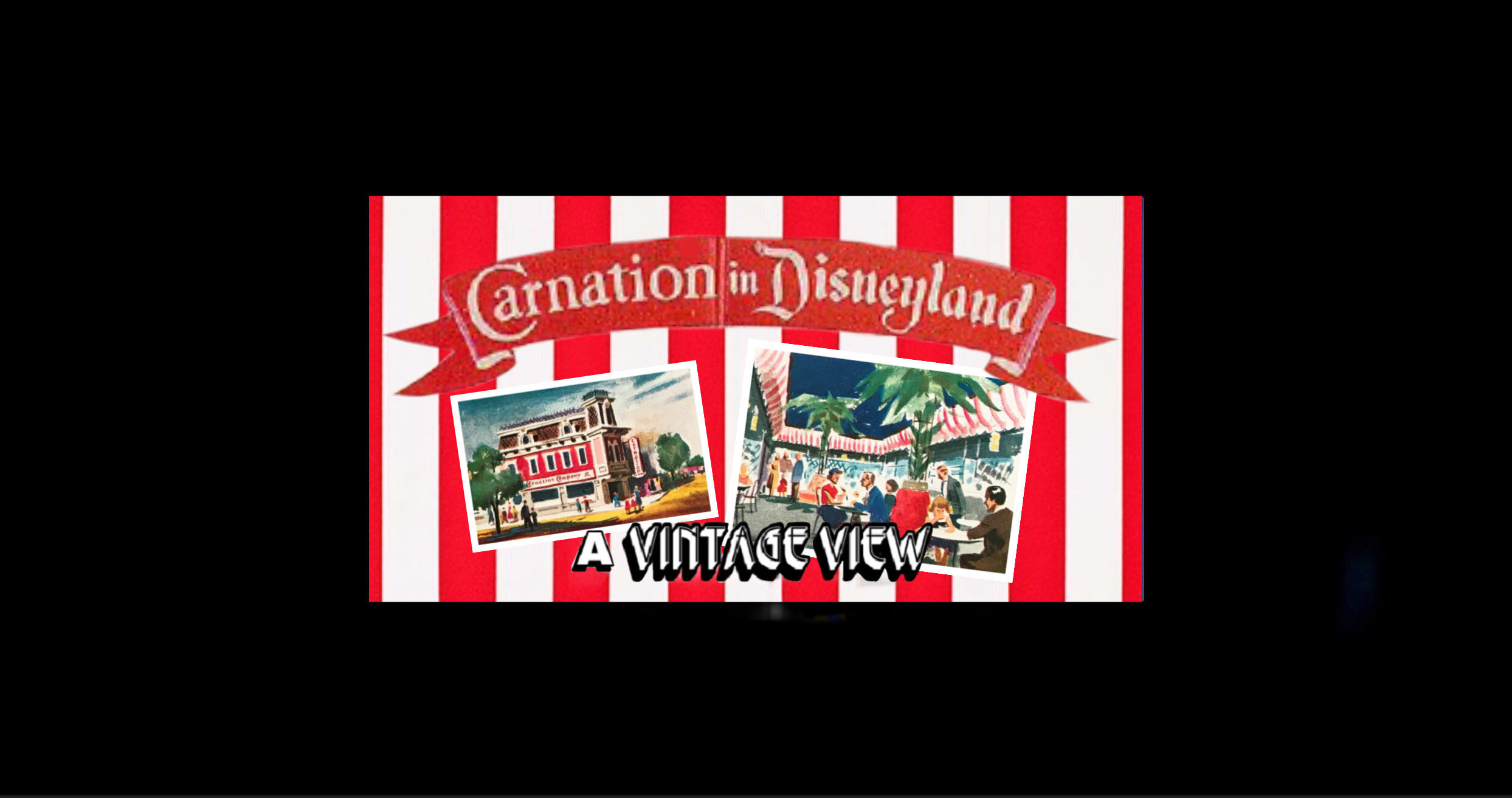CARNATION ICE CREAM PARLOR
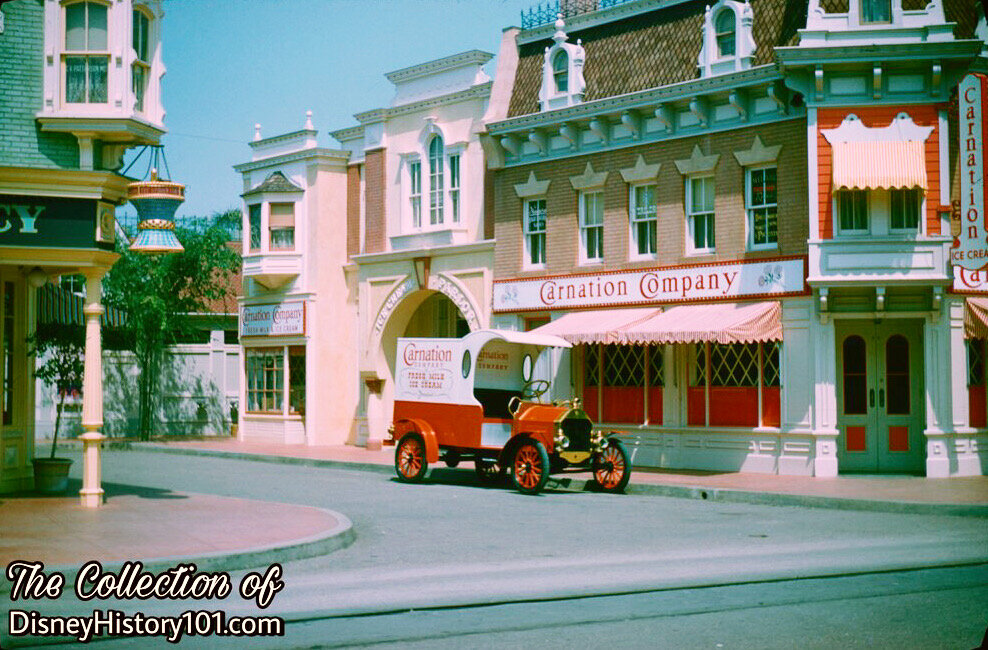
Carnation Cafe and Carnation Company Truck

(July 17, 1955 - January 4 or 15, 1997)
Since the creation of Mickey Mouse, Walt Disney extended numerous licensed character arrangements with manufacturers of ice cream like Southern Dairies and Balian Ice Cream.
Back in 1951, Walt Disney and Art Linkletter visited the famous entertainment complex Tivoli Gardens in Copenhagen. He was researching and talking notes to build a family entertainment center and Tivoli was much like what he envisioned. It was clean, directed to the entire family, fun, entertaining and educational. Walt noted how important it was to have a lot of places for guests to sit down and a wide variety of eating spots that served excellent meals.
During 1954, Walt was searching for participants to lease shop and restaurant spaces and help generate the necessary capital to fund construction of DISNEYLAND®. In a synergistic relationship, the companies (in turn) could sell their products and advertise their corporate names in the Park as they provided services and shows. Disneyland Participant Corporate Sponsors were carefully selected. High quality, long term corporate sponsors would provide incremental income that enabled Disneyland to enhance its show and attractions, offset some operating expenses, and capitalize on marketing opportunities.
“55er” Rima Bruce (who started with Jim D'Arcy in Food when all food was Lessee and typed memos and menus) recalled that “the phone never stopped ringing with everybody trying to get a food lease in the Park.“ By July of 1954, Raul Grizante of Disneyland, Inc. was overseeing food philosophy, area & location, food specialties, and beverages for Disneyland.
By July 1, 1954, George Whitney of Disneyland, Inc. directed Amusements, with Ron Miller overseeing analysis, philosophy, capacities, planning, operator training, and amusement procurement. Individuals like Nat Wyncoff provided the essential orientation for curious lessees, selling them on the idea of Disneyland using various visual aids like sketches and one of Herb Ryman’s oil paintings of Disneyland. Soon, “a cross-section of American industry…[was] represented in Disneyland. Each of these companies… [would expose] its institutional advertising and public relations message to Disneyland guests through various forms of participating exhibits and displays. In each case, the exhibit… [was be] related to the theme of the ‘land’ in which it is located, and is woven into the overall concepts and themes of Disneyland”, according to “Disneyland, U.S.A.”, published 1958. It was intended that Disneyland feature “the turn-of-the-century shops and stores - the photographer's shop, ice-cream parlor, penny arcade, bakery, drug store, music shop, butcher, grocer, many of which are sponsored by outstanding American companies whose names are familiar ‘household words.’”
Many free exhibits of Main Street U.S.A. were sponsored by one of the United States’ “old reliable firms, which have been in business fifty years or more. Here they can show how they started and reproduce their first place of business” , [according to one draft of the Disneyland Prospectus, published 1954]. Several of these “reliable old firms” sponsored the “abundance of restaurants devoted to pleasing all tastes and all budgets,” according to “The Story of Disneyland,” published 1955. In turn, Disneyland, Inc. received income. For example, in 1958, Bank of America appraisers figured of the total income received from leases, 16.02% was derived from the selling of advertising rights and 40.12% from the leasing of space to concerns whose main reason for occupancy is for advertising purposes. The remaining 43.86% of the lease income was derived from stores that sell various products and food.
The “legen-dairy” Carnation Company (whose origins pre-date the turn-of-the-century), was one such “reliable firm,” and an appropriate choice for Disneyland sponsor. Carnation Company founder Elbridge Amos Stuart began processing evaporated milk in 1899 in Kent, Washington. During the early 1900’s Mr. Stuart developed “the famous Carnation line of Holstein-Friesan dairy cattle” with the ability to produce extraordinarily large quantities of milk. This the cows did, from a stress-free and peaceful pasture, ensuring their health and happiness.
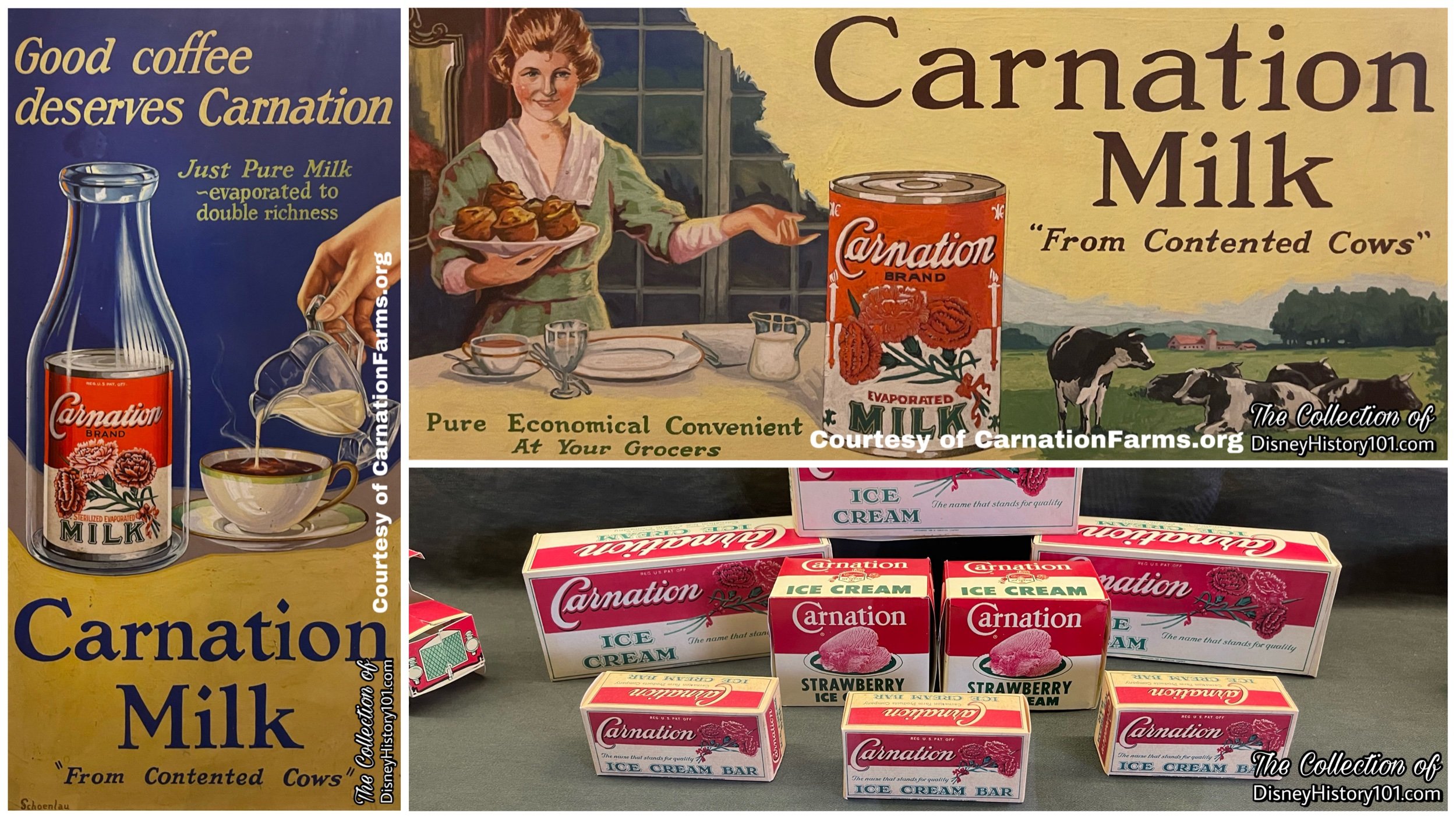
Carnation Milk Original Advertisement Artwork and Ice Cream & “Frozen Novelty” Packaging
Now 55 years after that important development (and a great deal of dairy research), the “milk from contented cows” would soon both content and bring happiness to visitors to Walt Disney’s Disneyland! This was all thanks to a partnership between Elbridge Amos Stuart’s son (Carnation Company Chief Executive Officer Elbridge Hadley Stuart).
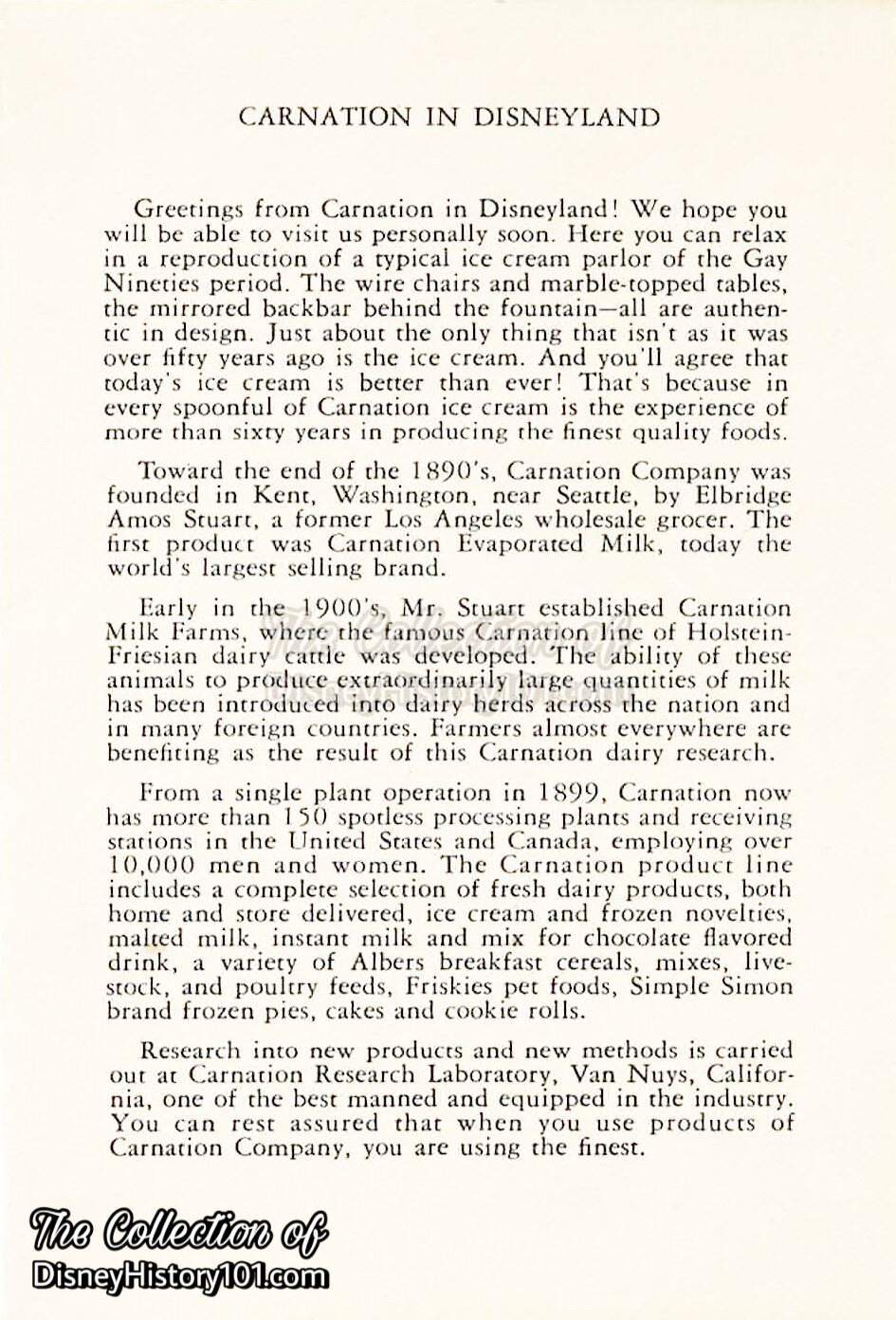
The “Carnation in Disneyland” Souvenir Menu Postcard Tells the Carnation Story
This souvenir menu page (pictured above) is a prime example of “the possibilities for a sponsor to capitalize on this association” with Disneyland. The many ways of “merchandising, sales promotion, advertising, public relations and publicity programs are almost limitless. Regardless of the type of product, goods or services manufactured and marketed by sponsors, the Disneyland association can be effectively and importantly translated into the sponsor’s promotional activities,” according to “Disneyland, U.S.A.,” published 1958.
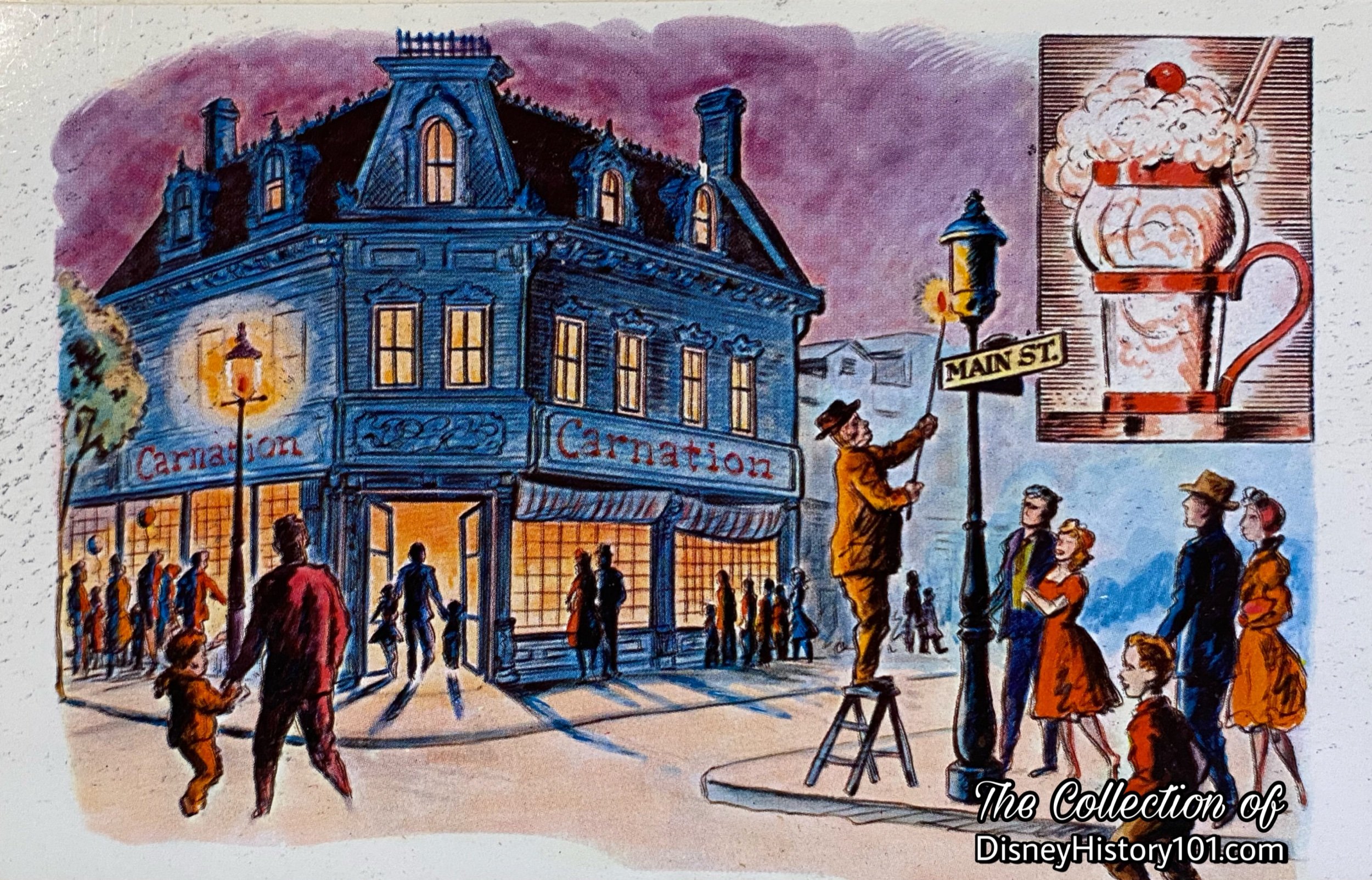
Carnation Farms at Disneyland postcard. Some of these viable project Concepts (as depicted above), were supported by a well-developed business case and built expectation.
“Master Planning a ‘Place Setting’ to Dine At Disneyland”
According to “THE DISNEY THEME SHOW - an introduction to the art of Disney outdoor entertainment: Volume II”: Of all the guests’ senses that come into play at Disneyland, the most difficult response to predict was taste. If 70,000 guests were to arrive on a single day, there would probably be 70,000 different ideas about food. Generally speaking, Disneyland food locations fall into three categories - sit-down restaurant service, “buffeteria,” and fast-food categories. The most extensive theming has always been found in the sit-down restaurant locations but all locations were housed in authentically decorated facilities.
Early thumbnail sketches and other concept artwork seemed to be unencumbered by restrictions of budget, schedule or the laws of nature and physics. Though guided by Walt, his artists appeared to engage in “free-thinking,” as if implementing the modern “Blue Sky” Imagineering process. Like some advanced “High Concept,” final designs were quickly generated and approved.
Some of the earliest Main Street site plans prepared, depict an American Motors - sponsored exhibit in this space of the 400 block of Main Street U.S.A. The same plans intended for a Carnation Farms - sponsored exhibit, but on the 500 block of Main Street U.S.A. (across the street, on the East side). As things continued to develop, it was decided that the American Motors’ exhibit would be best housed in an exhibit hall in Tomorrowland. As for the space on the south side of Main Street’s 400 block (and the corner of West Center Street), it would be inhabited by Carnation Farms’ free exhibit.
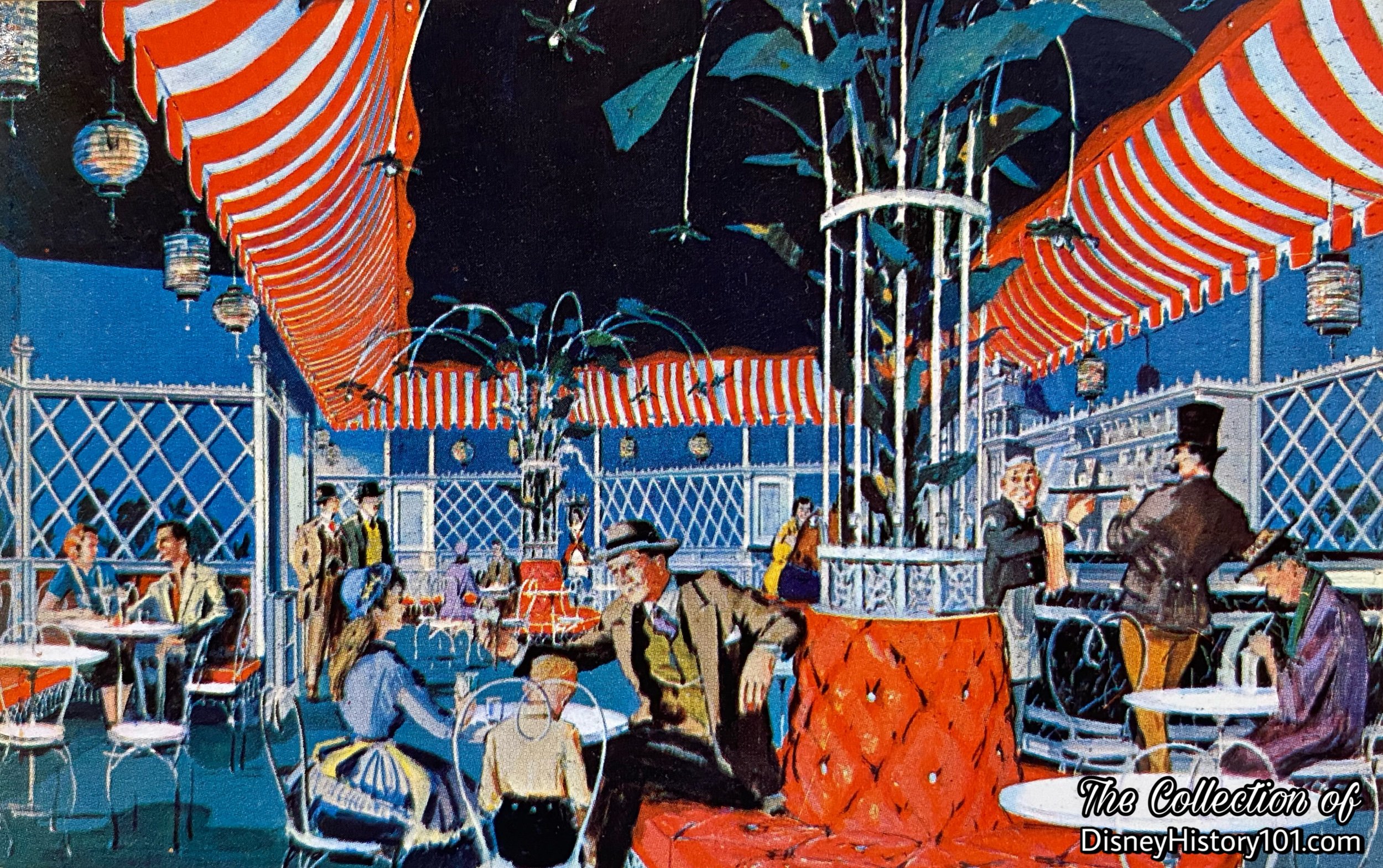
Carnation Company postcard featuring the artist's conception of the interior of Carnation's Gay, 90s ice cream parlor at Disneyland.
“Disneyland is unique in that some of the world's foremost creative artists and architects control all design at Disneyland.“ Disneyland Inc. furnished an artist's conception of such a parlor, which was being duplicated in every phase. For instance, a photograph was supplied from the Disney Library showing a soda fountain back bar that was actually in use during that time. Engineers devoted considerable time to further research and were able to procure a book of the history of the soda fountain industry.
As Walt described to Bob Thomas (of Associated Press), “some industries will have exhibits, but all of them must be in keeping with the era.” A year prior to opening, Carnation's ice cream parlor was a sketch in Disney's studio. But soon, Disneyland guests would be able to visit an authentic turn-of-the-century sweet shop, or ice cream parlor thanks to other talented artists and skillful craftspeople. Under the supervision of Ray Keplinger of Carnation Company, Disneyland, Inc. artists created site plans and other designs for the c.1890’s themed Carnation Ice Cream Parlor exhibit which would also function as a restaurant with waitress service.
“Architectural Designs by Lessees”
Disneyland, Inc. printed materials for Lessees detailing specifications for architectural designs of exhibit spaces. These were revised by March 16, 1955 and issued to Lessees.
All of the interior architectural drawings were done by competent registered architects or an approved display house of the lessee's choice. All of the designs submitted by the lessee's architect, whether for buildings or construction of interiors in DISNEYLAND, were approved as to the theme and general plan of DISNEYLAND as established by WED Enterprises, Inc.
Three sets of preliminary drawings were furnished DISNEYLAND, Inc. as soon as possible after signing of the lease. Two sets were retained by DISNEYLAND and one set was returned to the lessee’s architect with any revisions noted thereon and stamped “APPROVAL TO PROCEED TO FINAL DESIGN.” This stamp when properly signed and dated constituted the lessee’s authority to proceed with the final drawings.
The Lessees revised their final drawings to incorporate any revisions noted on the approved preliminary drawings, and submitted three sets of the revised drawings to DISNEYLAND. One set was returned to the lessee’s architect and any revisions noted thereon are to be incorporated on the original drawings. When the lessee had incorporated the final revisions on the drawings, two sets of transparent ozalids were forwarded to DISNEYLAND for approval. DISNEYLAND would stamp both sets “FINAL DESIGN APPROVED” and “LESSEE’S CONTRACT DRAWINGS”, and return one set to the lessee who could then release drawings for bid and/or construction.
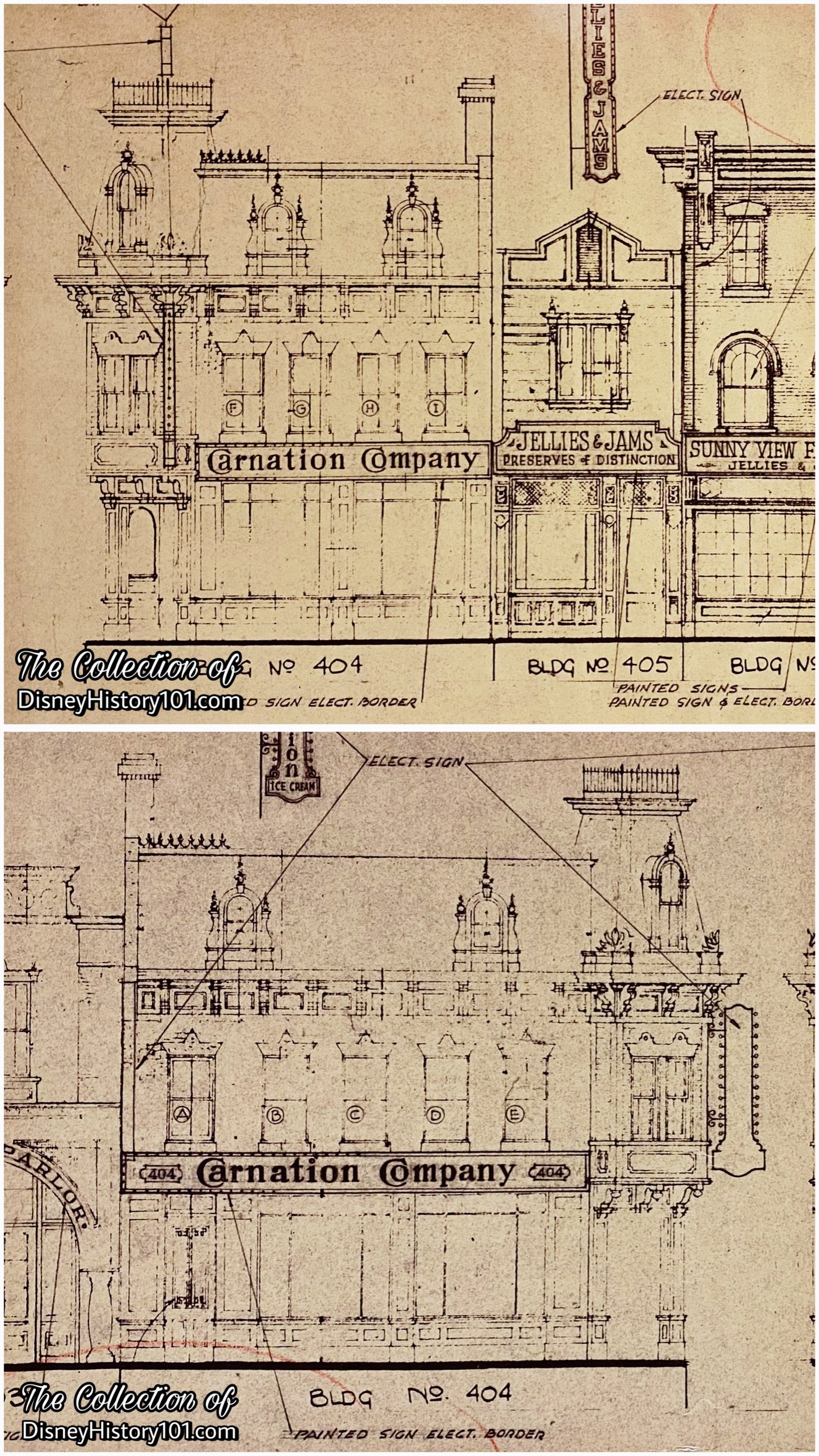
Carnation Ice Cream on a Main Street Building Elevation with Signs, designed by WED Enterprises for Disneyland, Inc.
Next, architectural drawings helped define all designs, production and construction strategies, costs, schedule, and resource requirements. Models explored the various dimensional relationships, site-lines, flow patterns, ergonomics, and visual appeal to convey the desired creative intent.

Carnation Ice Cream on a Main Street Building Elevation with Signs, designed by WED Enterprises for Disneyland, Inc.
Forced perspective would make the buildings on Main Street appear taller than actually are. On Main Street the buildings would not be full scale. Ground floors were built about 9/10ths scale. Second floors measured up to 7/10ths scale. The scale on the uppermost floors would be smaller still.
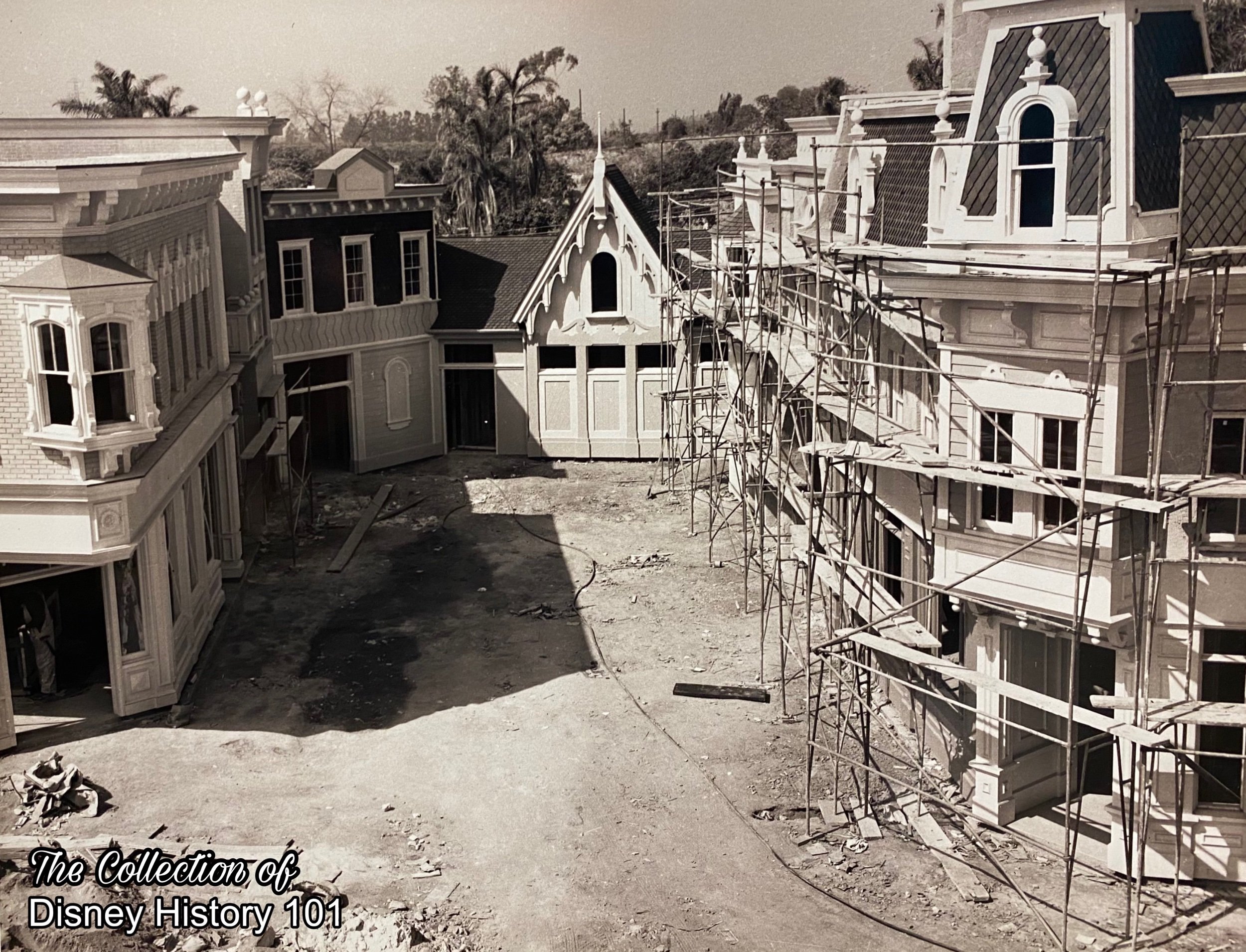
Carnation Ice Cream Parlor under construction (right).
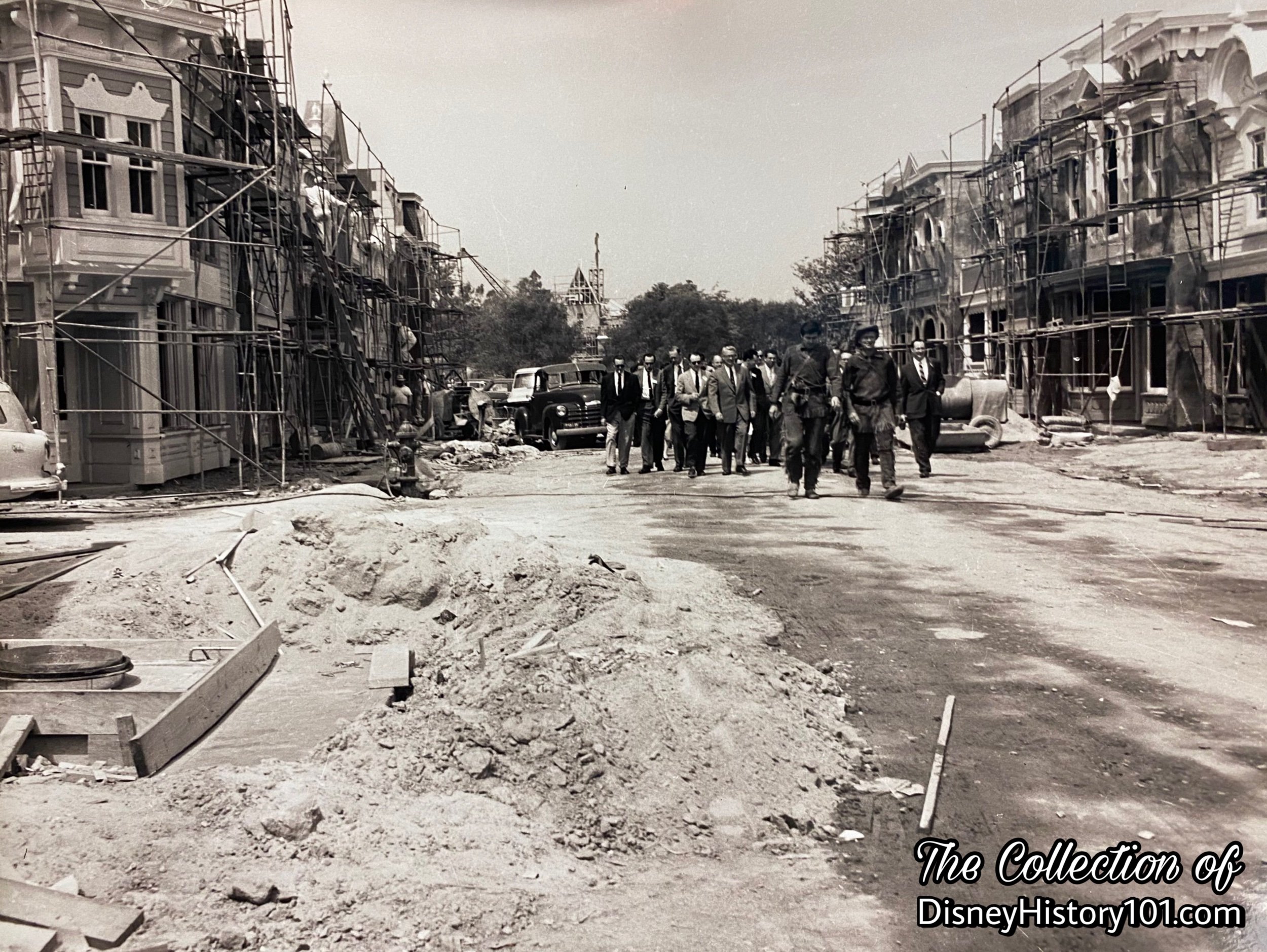
Carnation Ice Cream Parlor under construction (left).
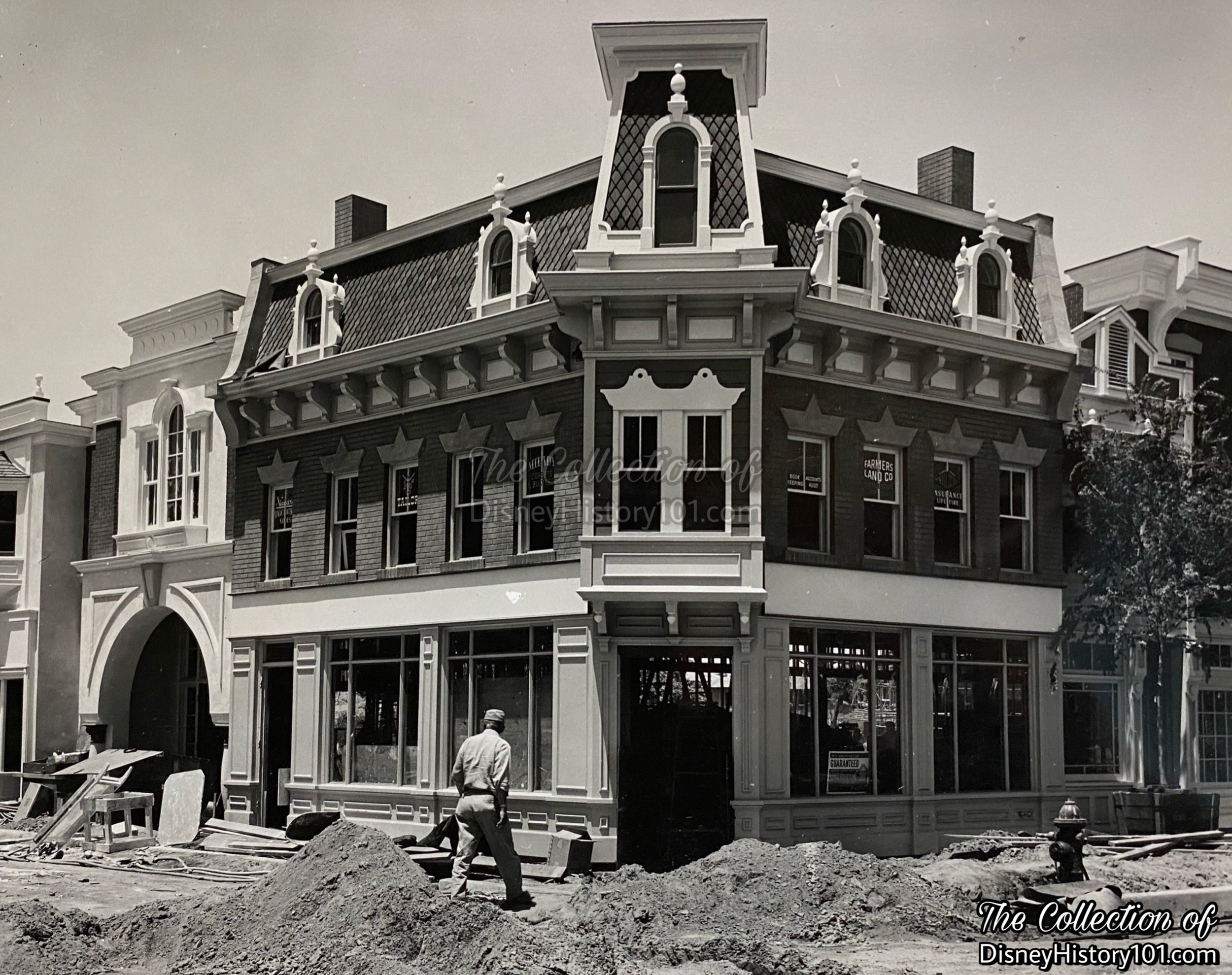
The Carnation Cafe Architectural Facade
“When the giant earth-moving undertaking was completed, the building crews took over. Soon, the rat-tat-tat of riveters was shattering the air, and sparks were flying from welders’ torches as the steel frameworks, capable of withstanding the ravages of time and the elements rose above the newly formed ground. While carpenters hammered and masons laid row upon row of brick and stone and mortar, the permanent buildings began to take shape and form,” according to “The Disneyland Story” published 1955.
F. M. Franz, manager of operations for McNeil Construction expressed: "We feel sure there has never been anything built like this in Southern California, or elsewhere in the United States. Many of the items were constructed from artist’s sketches.”
First, a concrete foundation and slab floors were prepared, followed by wood frame construction (while store units would have a combination wood and rigid steel frame).
According to inserts published in area newspapers during July of 1955, Disney buildings were roofed by Pioneer Roof & Shingle Company (then located at 608 Mateo Street, Los Angeles, California; 7522 Westminster Avenue, Westminster, California). The roof covering was a variable, dependent on the architectural design.
The buildings (as each on Main Street U.S.A.) possessed complete fire sprinkling systems. By June 30, 1955, related Disneyland Site Work Fire Protection Utilities Plot Plans were prepared for Disneyland Inc., by J.E. Thomasson of WED Enterprises Inc.
King Electric Contractors performed the electrical job on site.
As of June 2, 1955, C.V. Wood Jr. sent an Inter-Office Memorandum to Walt Disney regarding the best estimates that could be obtained at the time regarding the status of individual sections of the Park and Opening Day. C.V. wrote: “Building #401 - Carnation: The best estimate available today is that they should be able to complete. However, it is going to be very tight due to the time required for fabrication of the fixtures.” By July 2, 1955, shadow gags were ordered. Painted signs, window, curtains, and shades were projected to be completed on time. The sound equipment was be installed, with completion of the tape recordings appearing to be fairly tight.
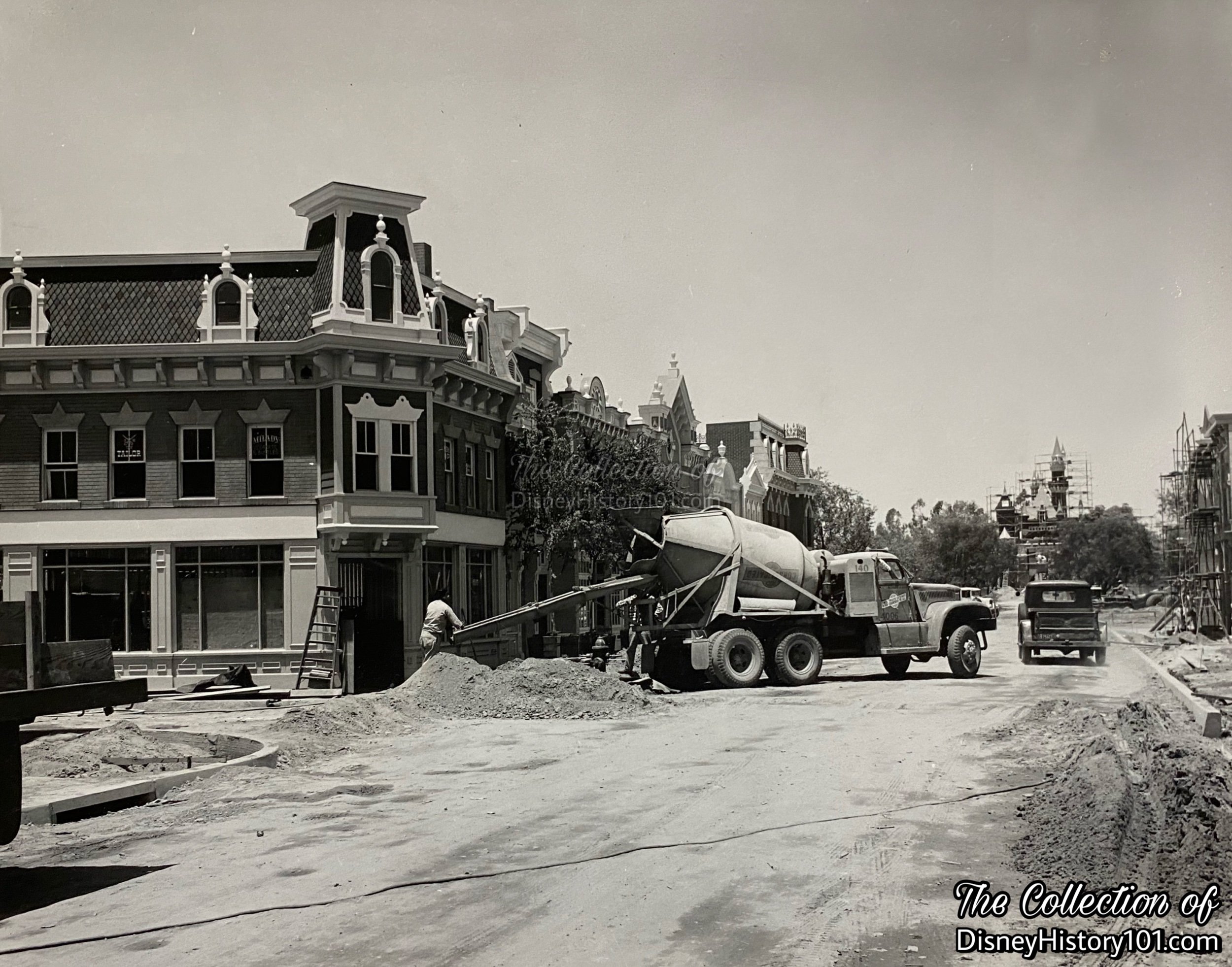
Show Documentation captures the creative intent.
One of the first buildings to be constructed was the Main Street Opera House, which was used as the Mill. There, the woodwork of Disneyland (including the wood framing of the Main Street complexes and the Carnation exhibit) was generated - from the functional to the aesthetic! Soon work began on the 8,833 square-foot Main Street Building #400 (at the intersection of Main Street and West Center Street).
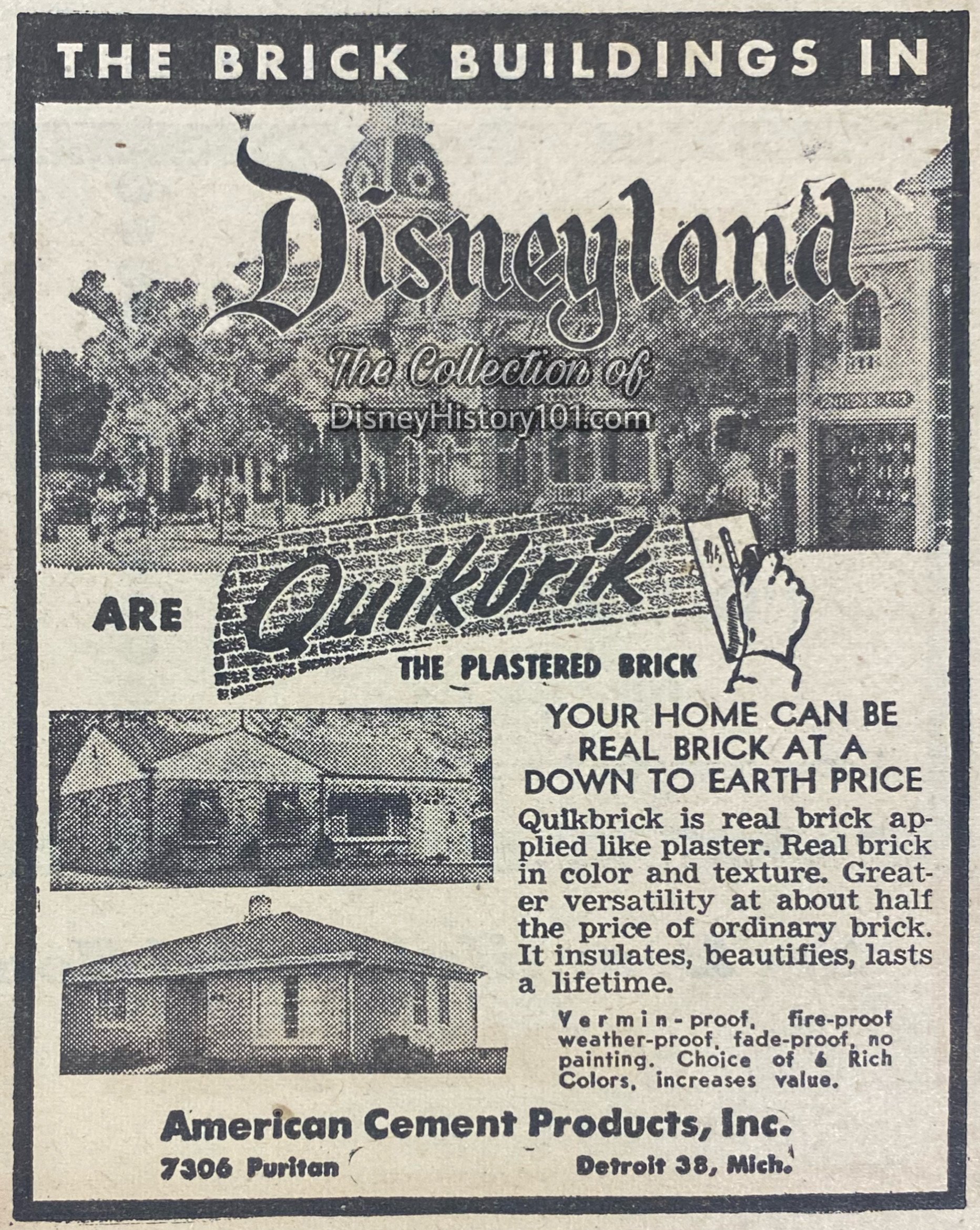
Larson Brothers Plastering Company of San Diego was a proud part of Disneyland. The company crafted the ornamental plastering and all brick used at Disneyland (including their amazing new plastered brick veneer).
The versatile Quikbrick (real colorful and textural brick applied like plaster) was about half the price of ordinary brick. It insulated, beautified, and was meant to “last a lifetime.” It was used on the facade.
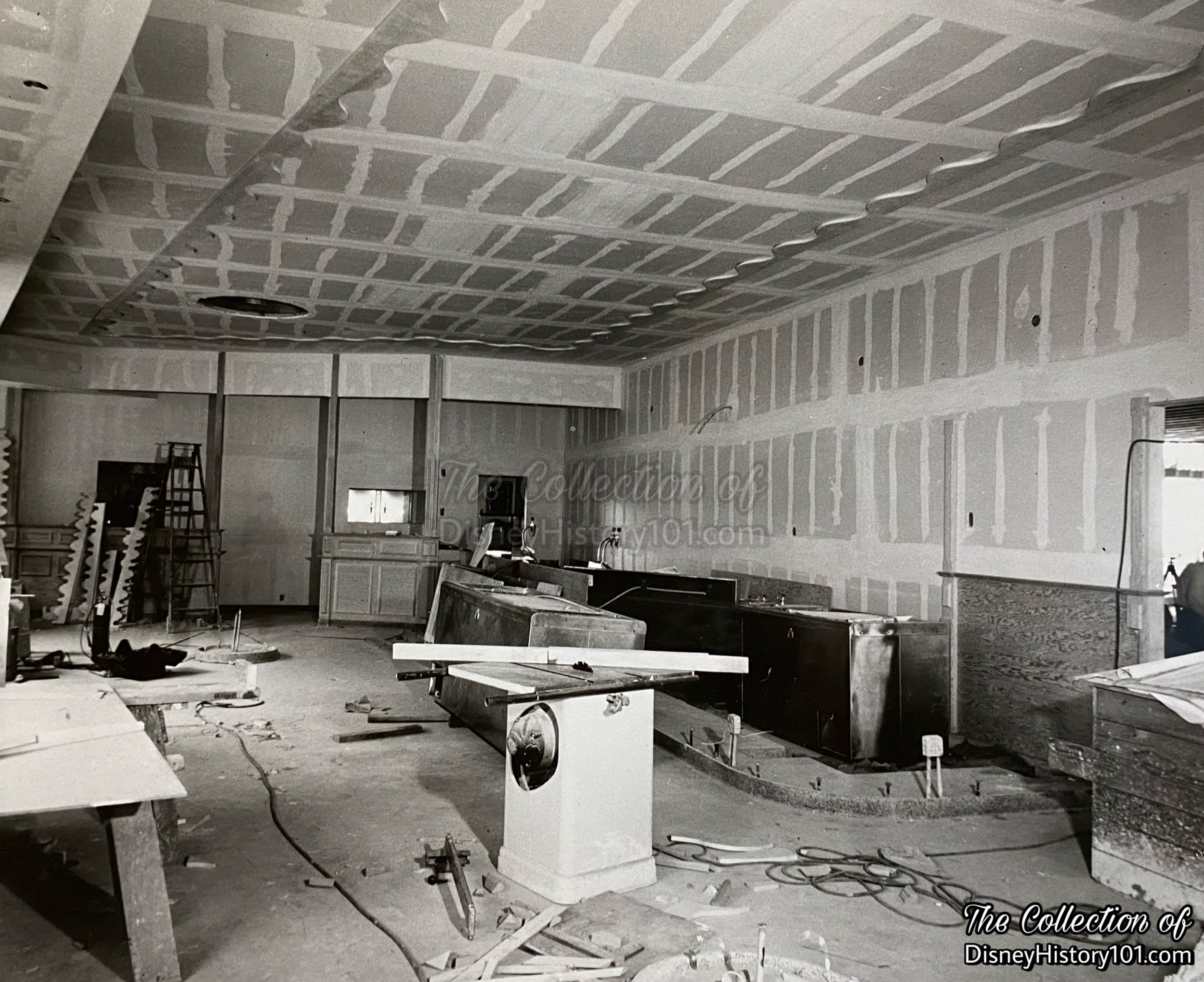
A portion of Main Street Building #400 would soon become Carnation Ice Cream Parlor
After construction of the building complex, work began on the 1,672 square foot Carnation Ice Cream Parlor and 274 square foot storage space). Only three weeks before the grand opening, its interior looked as if a hurricane had hit it. But soon, faithful decorative elements were brought in and installed, like diamond-paned-type windows. Under the guidance of Fresh Milk and Ice Cream's Southern California assistant manager for sales, C. J. Noell, Carnation Company's own unusual part in Disneyland was readied.
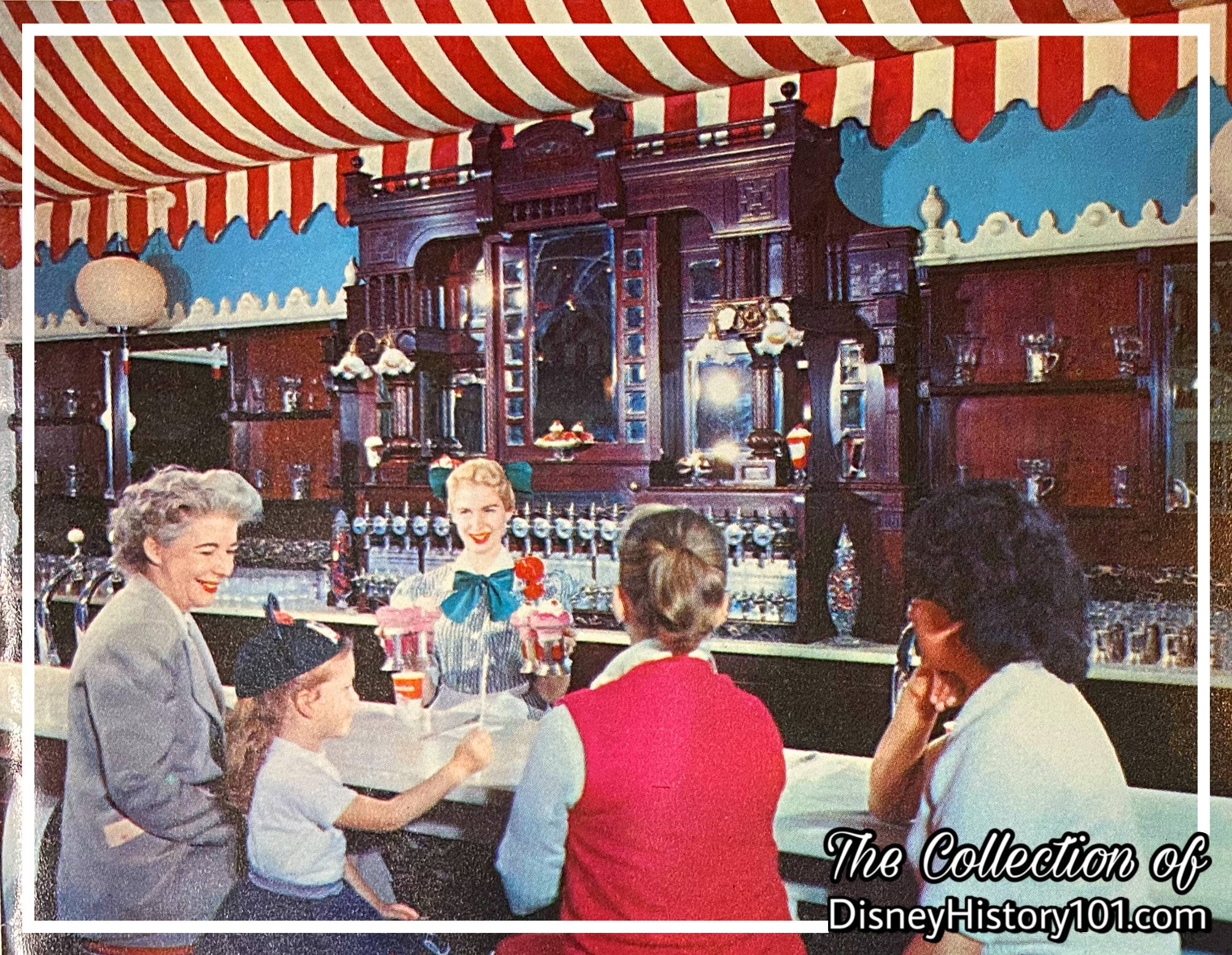
Excerpt from “Walt Disney’s Guide to Disneyland” published for 1962 depicts the finely-crafted cabinets of the Carnation exhibit.
The restaurant was designed to handle a 77 Guest seating capacity. All fixtures were designed to give fast short-order service and placed in their correct motif. Wire backed chairs, wireframe tables, leather tufted seats, island benches, and the mirrored-back bar behind the carved marble fountain counter top are all authentic in 1890s design. Those circular island seats were decked out with planters and a sunburst-type the reflector for each light bulb being a poinsettia. Many light fixtures were authentic antiques and additional lighting was by Chinese lanterns. “25-watt clear glass lamps are used in specially designed fixtures that have the flavor of the past, and 100-watt inside frosted lamps are used in the lanterns.” All of these were under gay red-and-white candy-striped metal awnings inside.
To duplicate faithfully such an establishment, Carnation commissioned Dohrmann Hotel Supply Co. to supply the furniture and fixtures. Ostrander Manufacturing crafted the hardwooden furniture, and much of this fine (and beautifully crafted) carpentry was both performed and overseen by Cliff Carothers. The very same aforementioned publication references their contribution (though not by name) this way : “Cabinet-makers carved and painted the accurate reproductions that furnish the buildings.” Metal castings of hand-turned wooden valves and faucets were produced, and “mirrors were hand-cut and framed in the popular hardwood of the 1890s, Honduras mohogany.”
The bar was of Honduras mahogany embellished with hand-cut mirrors and ornamental lights, and black and gold Italian marble topped with snowy Alabama marble. The marble-top may have been crafted by Frank Silveri, a Santa Ana tile & marble contractor.
Special silver holders for soda glasses were to be used to further the 1890 theme.
Finally store-front signs give the appearance of Gay Nineties lighting but use improved equipment.
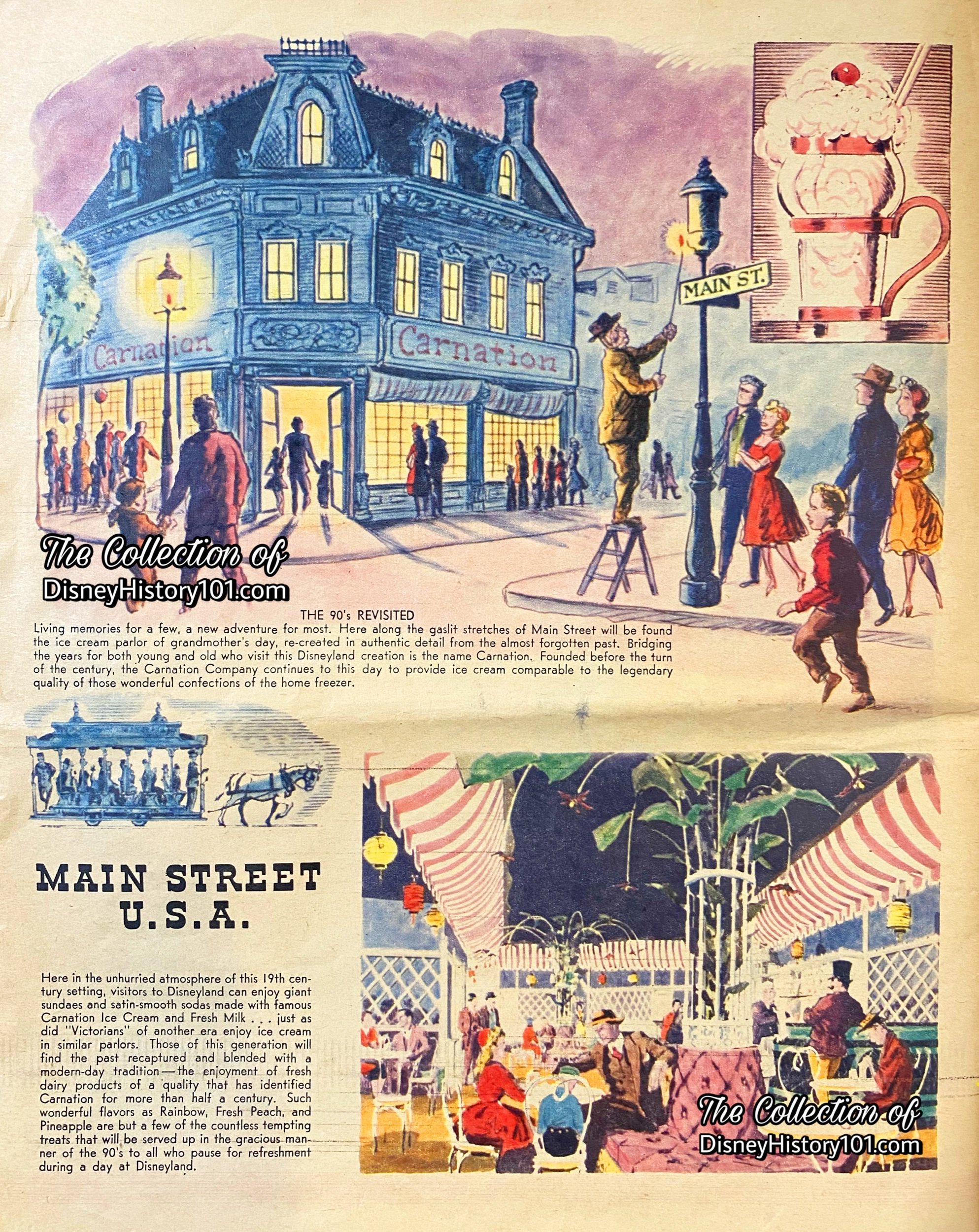
The Carnation Brand at “Disneyland” in this Excerpt, (July 15, 1955)
However, not everything about this ice cream parlour would draw back to mind grandfather’s day. The latest serving equipment featured valves and faucets turned out of wood and duplicated in metal to gain the appearance of originals of the period. The ultra modern kitchen measured 231 square feet full and completely arranged with the best equipment obtainable, including equipment from Hobart Mfg. Co. and a Waste King garbage disposal. It had a seven-foot griddle, reach-in refrigerator, work-pantry-table and automatic dishwashing equipment.
There was a sherbet dispensing cabinet and two special cabinets for ice cream cone dispensing. Under the counter was a modern marvel of 20th century technology - the Everfrost refrigerated 60-gallon two station stainless steel soda fountain unit (bearing a compartment and three temperature controls) that dispensed ice. There were two complete sets of draft arms, three separate temperature controls, automatic soda water carbonator, and accurately gauged syrup pumps to dispense accurate measurements of flavor into the sodas.
“Just about the only [other] thing that isn’t as it was over 60 years ago is the ice cream. It’s better than ever! In each spoonful of Carnation ice cream is the experience of more than a half-century in producing the finest quality foods.”
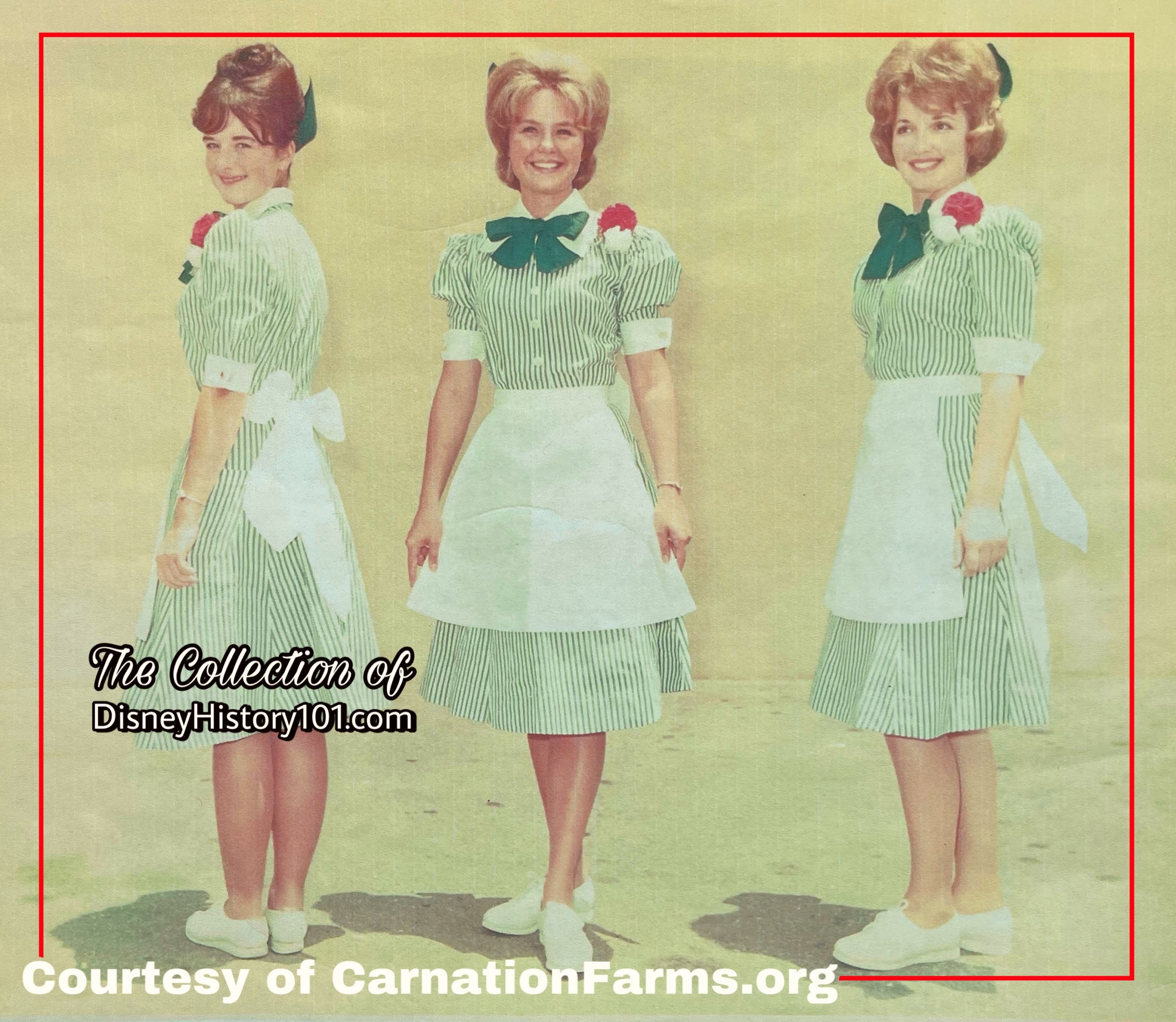
Carnation Ice Cream Parlor Hostess Costume.
Waitresses wore specially designed uniforms combining present day practicability with 1890 style additions such as modified mutton leg sleeves. They were in green and white stripe and green tie and head bow, completed by a dainty square white apron. Some elements of the original custom (and authentic) wardrobe of Hosts and Hostesses were possibly provided by Warren Ackerman’s House of Uniforms (yes, “uniforms”), then located in Beverly Hills, California.
“Your Disneyland: A Guide for Hosts”, published 1955, reminded Disneylanders of a few simple rules of personal appearance: “We feel better when we look our best… Cosmetics should emphasize naturalness. Use only conservative nail polish and avoid heavily scented perfumes. Hair should be neat and well groomed. Hands and nails should be clean and well kept. If you wear a costume furnished by Disneyland, it must be clean and fresh at all times… Shoes should be shined and heels straight. The host should have a fresh shave and a neat haircut - both essentials of good grooming. Our Disneyland look should emphasize our natural good qualities, and our habits of neatness and cleanliness.”
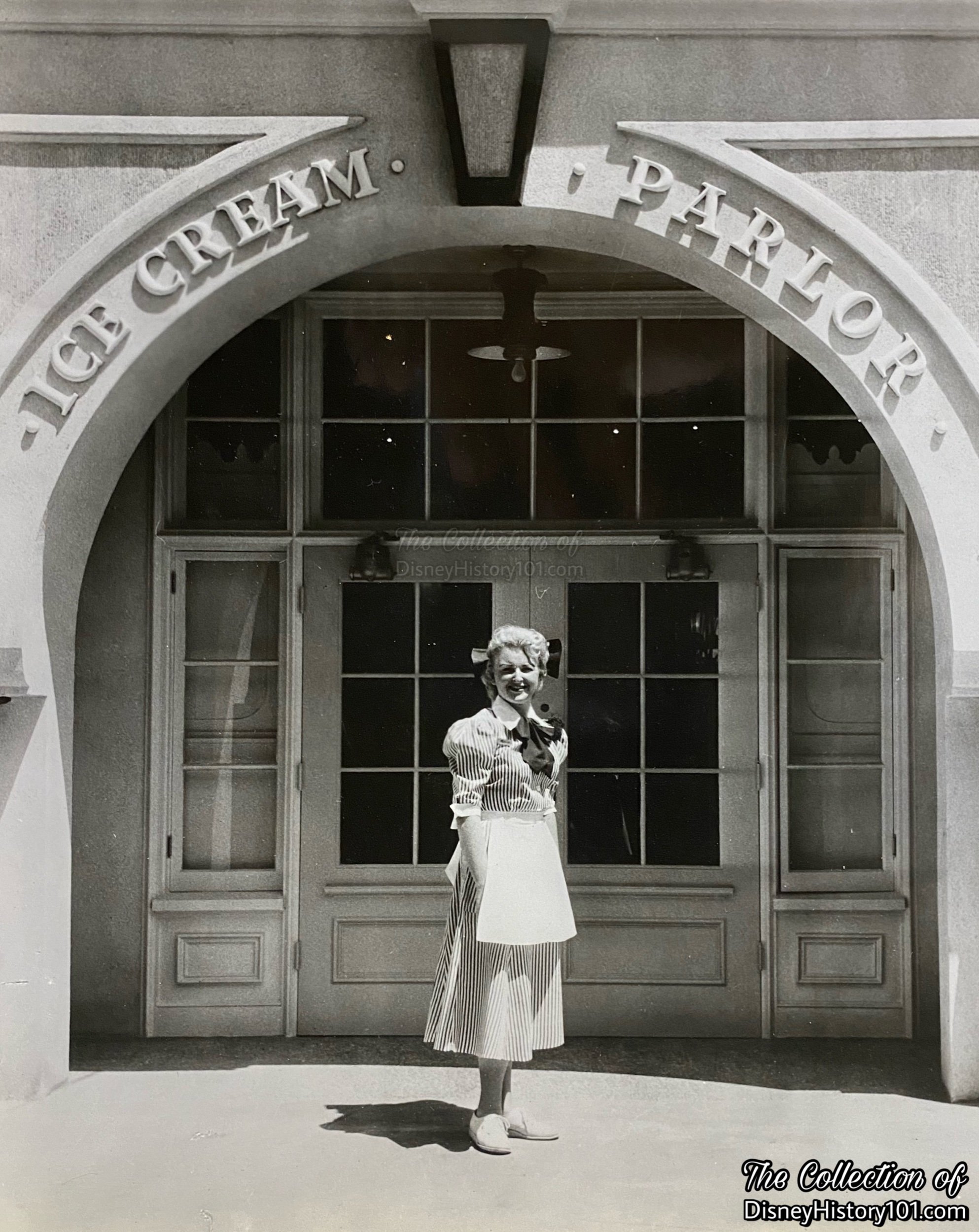
A Carnation Hostess extends a courteous smile in Front of House.
As far as those Disneylanders who would fill the wardrobe (and the roles) representing both Walt Disney Productions and lessees on a person-to-person basis, Walt later expressed the following confidence: “What you do here and how you act is very important to our entire organization and the many famous names of American business represented among our exhibitors… Your every action (and mine also) is a direct reflection of our entire organization… For our guests from around the world the curtain goes up on an all new show at Disneyland everyday and you, as a host or hostess, are truly ‘on stage.’ I know you will give a courteous and friendly performance.” Five months before the premier opening of Disneyland, Hal Hensley (of the Disney University Orientation Program ; under the Direction of Van France and his assistant Dick Nunis) held classes (which would become a Disneyland “tradition”). These classes would instruct some 1,200 Disneylanders (including those fulfilling roles at the Carnation Ice Cream Parlor) in some of Walt’s personal philosophies, as well as the policies which would “create happiness” for visitors! Despite their 1890 On Stage setting, Hal wanted to ensure that Disneylanders to “get a ‘new world’ feel about this place.” The result was that even at its foundation in 1955, Disney University was producing specialists in the field of outdoor theme entertainment.
The Carnation Ice Cream Parlor table service restaurant would be managed by Bill Slamina and overseen by Jim Baker of Disneyland, Inc. Waitresses (like Carolyn Moody of Garden Grove, Cal.) served Guests. Woody Woodworth was hired before the grand opening recalled: “You couldn't get too much to eat and the only place you could get a sandwich was Carnation.”
The 1,672 square foot restaurant was one of Disneyland’s eating facilities which was estimated to serve a capacity of 300 guests per hour (according to facts prepared by the Disneyland, Inc. Public Relations Department), and thus predicted to contribute to accommodating the Park’s overall potential of “15,000 persons daily, hitting a peak of 60,000 on holidays and week-ends.” The same documents predicted that Carnation Ice Cream Parlor would be one of “twenty restaurants and snack bars, capable of saving 8,000 hourly,” at least according to “Building A Dream” (prepared by the Disneyland, Inc. Public Relations Department).
As of June 2, 1955, C.V. Wood Jr. sent an Inter-Office Memorandum to Walt Disney regarding the best estimates that could be obtained at the time regarding the completion status of individual sections of the Park and Opening Day. C.V. wrote: “Electric Signs: All are in work - with the exception of the shoe store and the Bank of America, all will be completed.”
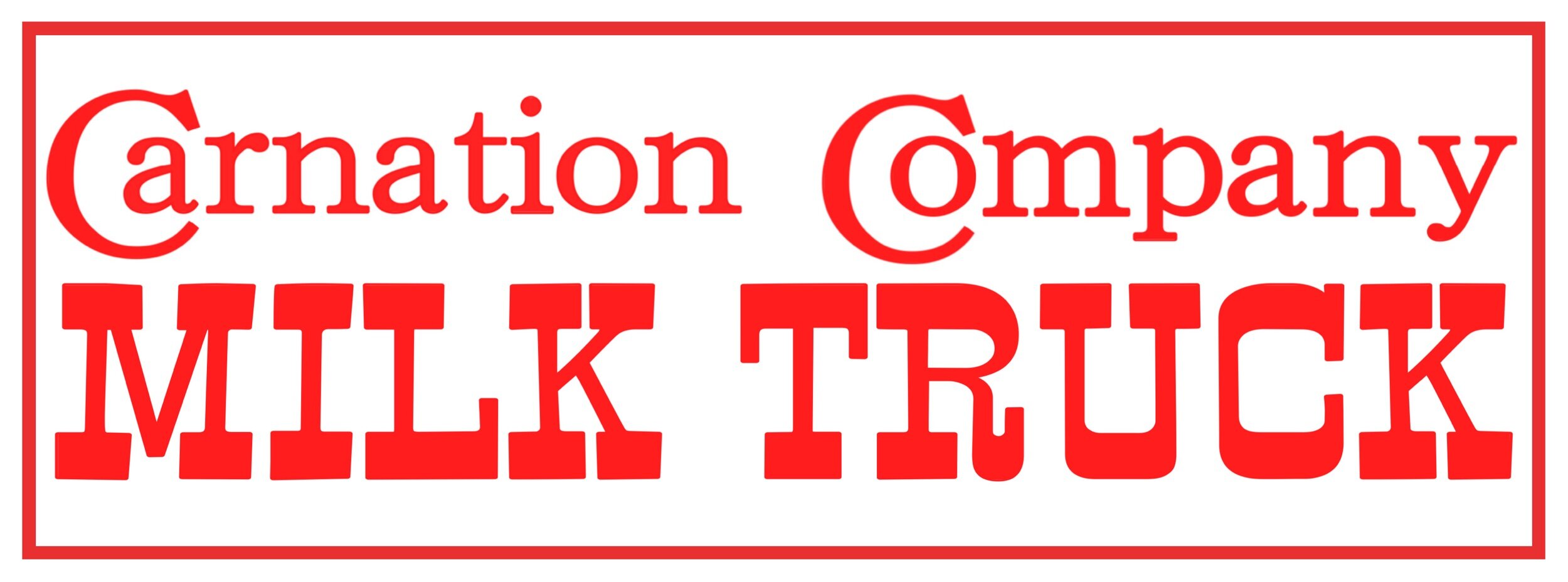
Since the beginning, a number of Main Street, U.S.A.’s antique vehicles were a nostalgic reminder of “the good old days” of product delivery to small towns across the U.S.A.! Disneyland sponsors Swift & Company and Bekins had their Horse Wagons, while Global Van Lines and Carnation Farms would have their trucks. While early articles suggested the truck would be used for deliveries around the Park, the old-time Carnation delivery truck - complete with horn - would come to be displayed outside Carnation Ice Cream Parlor, as a favorite picture-taking prop.
Some have wondered : “Why did Carnation Farms choose a truck (rather than a horse wagon) to represent their free exhibit at Disneyland?” According to an article published one year after the vehicle’s debut, “Anticipating that the demands of a warm summer day might exceed their available in the store supply of ice cream, they contacted the Disneyland management and suggested some sort of delivery service be arranged to the store from their off site facilities. A modern day truck would clash with Main Street’s 50 years ago flavor.” It was believed that a Carnation GMC truck (similar in style to the one that made the first Transcontinental round trip from Seattle to New York, and back to Los Angeles in 1916) would best represent the company before Guests that would remember this tremendous feat!
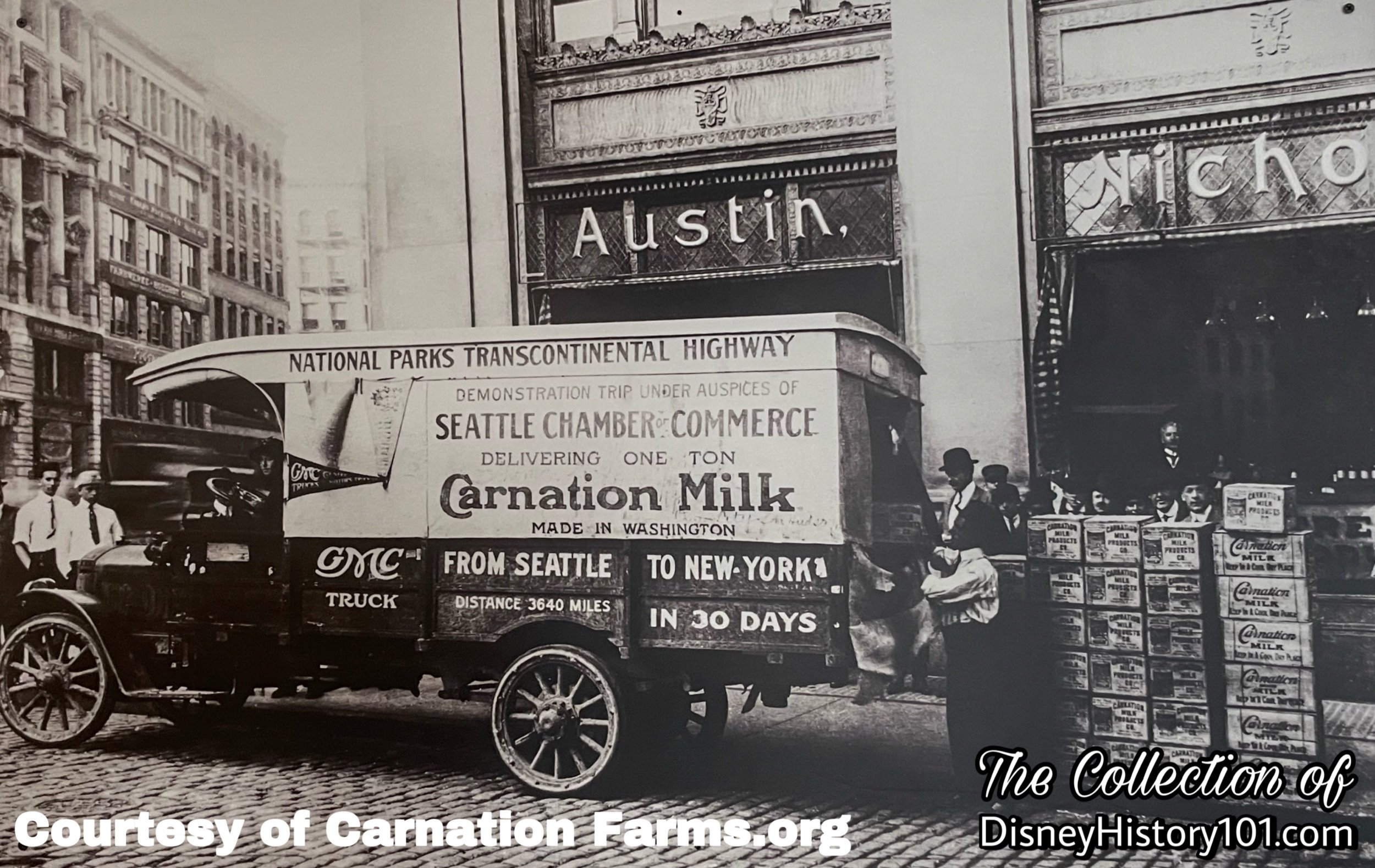
Carnation Farms - GMC Transcontinental Promotional Image
According to Walt (in interview with Bob Thomas (of Associated Press), “We have built nearly everything from scratch. When you buy old cars, trains and boats, you have a terrific upkeep problem.” And so, “the assignment to build a special truck was given to Bob Gurr, young mechanical wizard of the Walt Disney Studio Construction Department. Bob, who had already met a major challenge by designing ‘the car of the future’ for Tomorrowland’s Autopia, was more than equal to designing a ‘car of the past. The idea that a car of that vintage, in suitable condition, might be found was quickly discarded.”
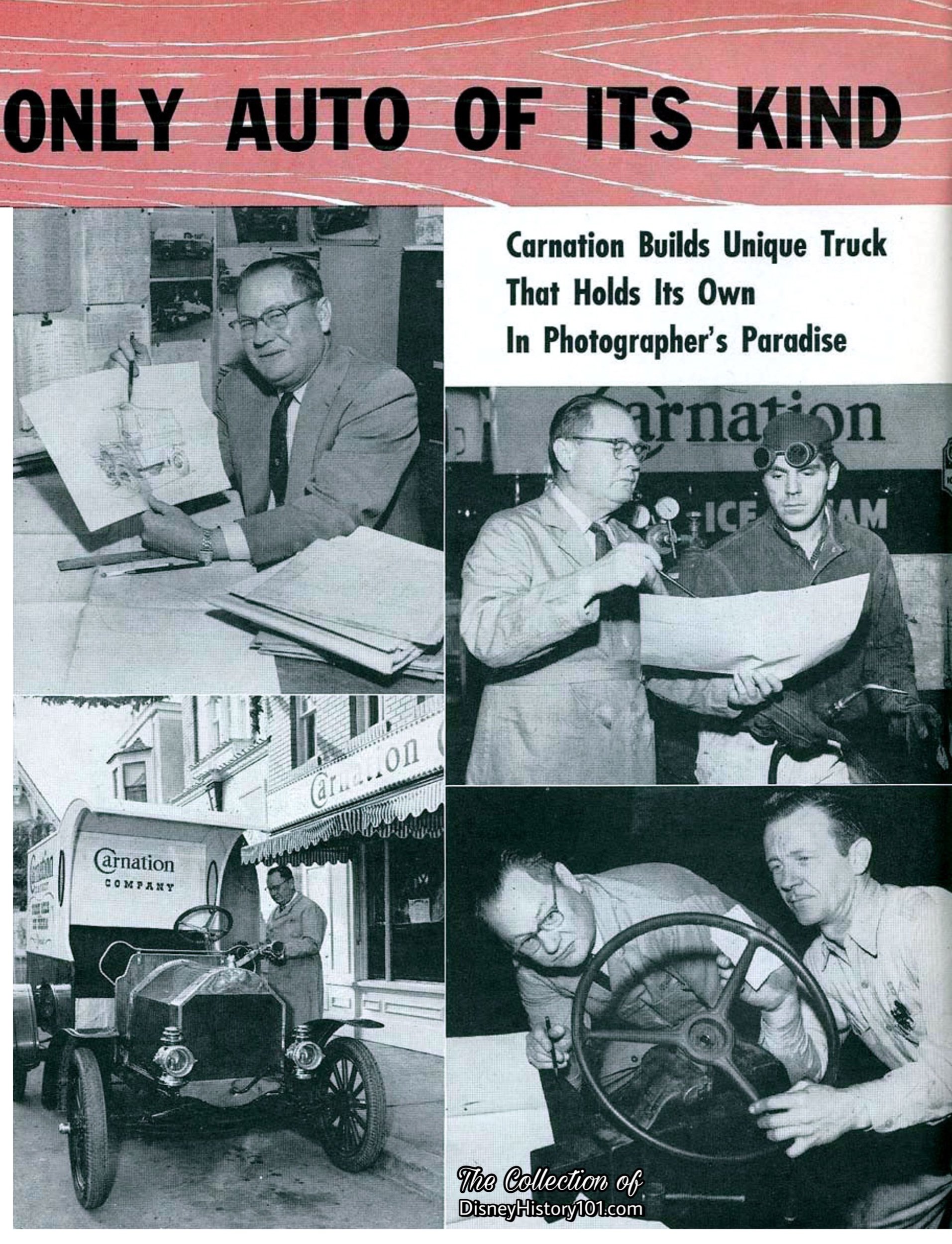
“Only Auto of Its Kind,” Carnation Magazine (March-April, 1956)
As the Carnation Farms Delivery Truck was reckoned a Horseless Carriage of WED, Enterprises’ design, it shared many similarities with some of Main Street’s other vehicles, while it was also the “only auto of its kind.” According to “Main Street Vehicles”, published 1966 by Disney University, “The Horseless Carriages are sometimes called the ‘1903’s’, but you could pick any year - 1904, ‘05, or ‘06, and be just as accurate. These little cars are of WED ‘composite’ design. On the basis of extensive research, Studio designers created a horseless carriage which was a composite of the design and size of many gas-driven cars of that early period in automobile history. And our Horseless Carriages are a little bit of everything. The two-cylinder engines are actually not auto engines, but have the horsepower, the sound - and even a slight case of the shakes - as did the originals. WED designers selected today’s most efficient two-cylinder water pump engine. Some of the external parts, such as lights are authentic.” Some of these same things ring true with the Carnation Farms Delivery Truck.
The Carnation Farms Milk Truck was designed by the legendary Bob Gurr to be a reproduction of the delivery trucks used by the Carnation Company from 1910 to the 1930s. Certain elements were patterned after particular vehicles, like the “1908 model car Ford” which inspired the design of the “high fenders, running board and hood,” according to a Carnation Company Press Release document dated July 17, 1955. “Carnation’s crew also constructed its ‘special delivery’ body from 1890 era designs.” However, a full-scale truck would have certainly looked very strange. So, this mobile (and free) Disneyland exhibit would be both designed and fabricated at a “3/4 scale” (according to Carnation Company Press Release), so as to not clash with the 5/8 scale of Main Street U.S.A.’s buildings.
Similar to the design of the Horseless Carriages, the Carnation Farms Milk Truck was to be of “composite design” in this regard. Bob went on to design “the body by following guidance provided in his old automobile book Antique American Cars by Floyd Kramer. He also sought out old automobile magazines in the studio’s library,” according to “Eat Like Walt - The Wonderful World of Disney Food” by Marcy Smothers. Then, a “2-inch stack of engineer drawings” was delivered to Ray Groom (FM and IC division fleet superintendent) and Frank Renta of the Carnation Company’s Glendale metal-working and service shop (in Los Angeles), which was located not too far away from Walt Disney Studio in Burbank.
The project began with an early 1931 Ford Model "A" chassis, which was “shortened with axles and frame altered to fit.” Next, both hand-made reproductions and antique stock parts were acquired. Both the stock and “hand-made parts… [were] checked against specifications by Groom and Frank Renta,” according to Carnation Magazine (March-April, 1956).
Many Ford Model “A” and Ford Model “T” parts (like Model T wheels, and a Model “A” four cylinder motor) were utilized for the moving exhibit. For instance,“special two wheel brakes were built by Groom’s mechanics to more modern standards for greater safety.” A Model “A” motor block was rebored. According to the Santa Ana Register (published July 15, 1955), the truck (following Bob Gurr’s designs and Frank Renta and Ray Groom’s specifications) also featured “a special panel body, brass headlights and radiator, high pressure tires, tufted leather upholstery”. “The cherry wood dashboard, fenders and hood were hand made ; and the lemon wood steering wheel, salvaged from a 1902 vehicle (Buick) , was rebuilt to fit,” according to one Carnation Farms Press Release (July 17, 1955). As a “sidelight,” a photograph published in Carnation Magazine (March-April, 1956) depicted Ray Groom and Carnation Shop Foreman Dean Klippert sanding the lemon wood steering wheel from the 1902 vehicle.
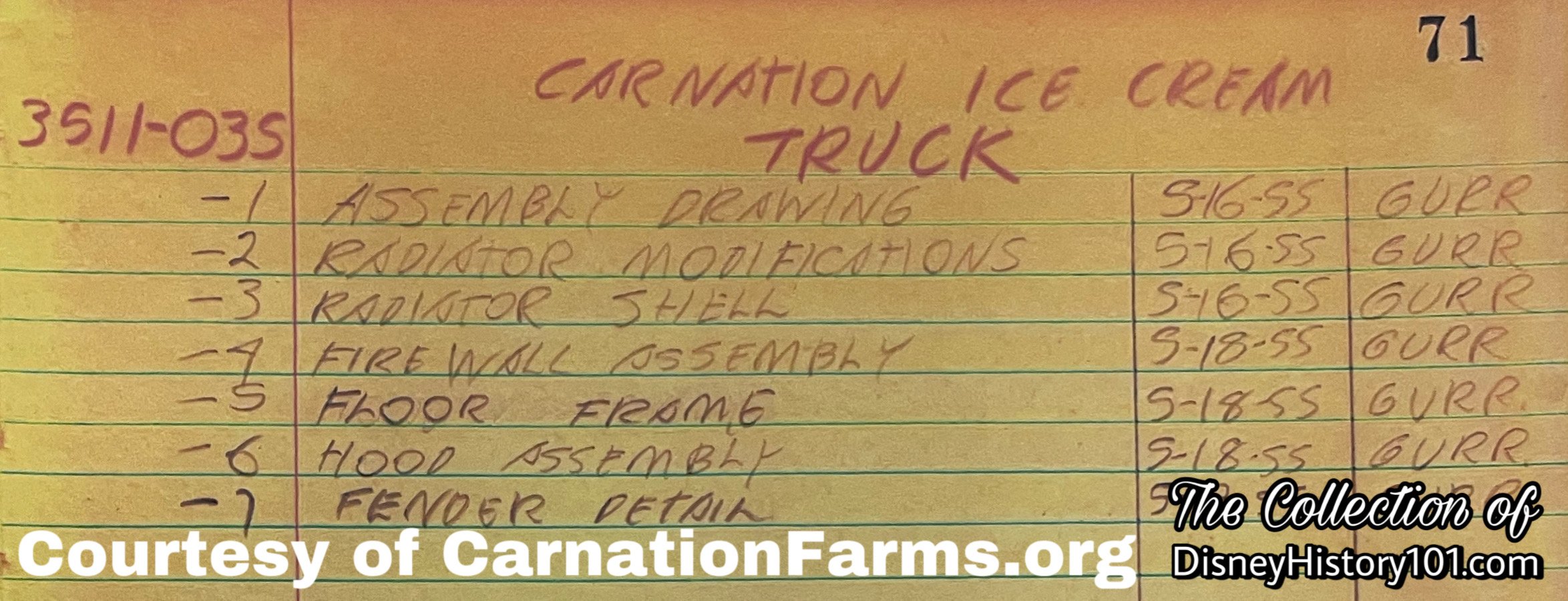
Bob Gurr Hand-Written Production Notes Fascimile
Other parts were also salvaged and modified. According to one newspaper article (“Main Street Dilema - Ice Cream Delivery Poses Unique Problem”), “The steering wheel was adapted from a [sic] 1902 Buick and the brass headlamps… [were] from another car of the same era.” Yes, a “month’s search produced these coal oil brass headlamps found by Groom in [a Los Angeles area]… antique shop ; the bulb-type horn came from a [Altadena] Horseless Carriage Club Member.”
The Press Release document adds : “Also authentic and hand-made, gas and spark controls, radiator and dummy coil box. Old fashioned hand rails, head lamp brackets and crank were reproduced in brass. In keeping with tradition, a leather thong to secure the crank, was made.” The vehicle also had brass headlights and radiator and high-pressure tires to match the Main Street decor.
One final detail gives homage to the exhibit’s creator. “An amusing sidelight of the construction of the Carnation Delivery Wagon concerned its naming. Affixed to the exterior radiator shell is an oval brass plate describing the machine as a ‘Gurrmobile,’ after designer Gurr. When casting about for a name for the machine the Carnation people heard the story of how Bob had been kidded during his school days by classmates because of his habit, during otherwise dull lectures, of drawing automobiles on his notebooks. At the time, the story goes, Bob was accused of attempting to design his own car and the name his fellow students gave to his doodles was the ‘Gurrmobile.’”
After “eight weeks of determined shopping and careful, loving workmanship to build the Gurrmobile,” the Carnation Farms Milk Truck was ready (and parked Backstage near Tomorrowland Lake) by the time that the LIFE Magazine photographer arrived to take pictures for the soon-to-be published pictorial. Press Releases (for Immediate Release on July 17, 1955) divulged every detail of the vehicle.
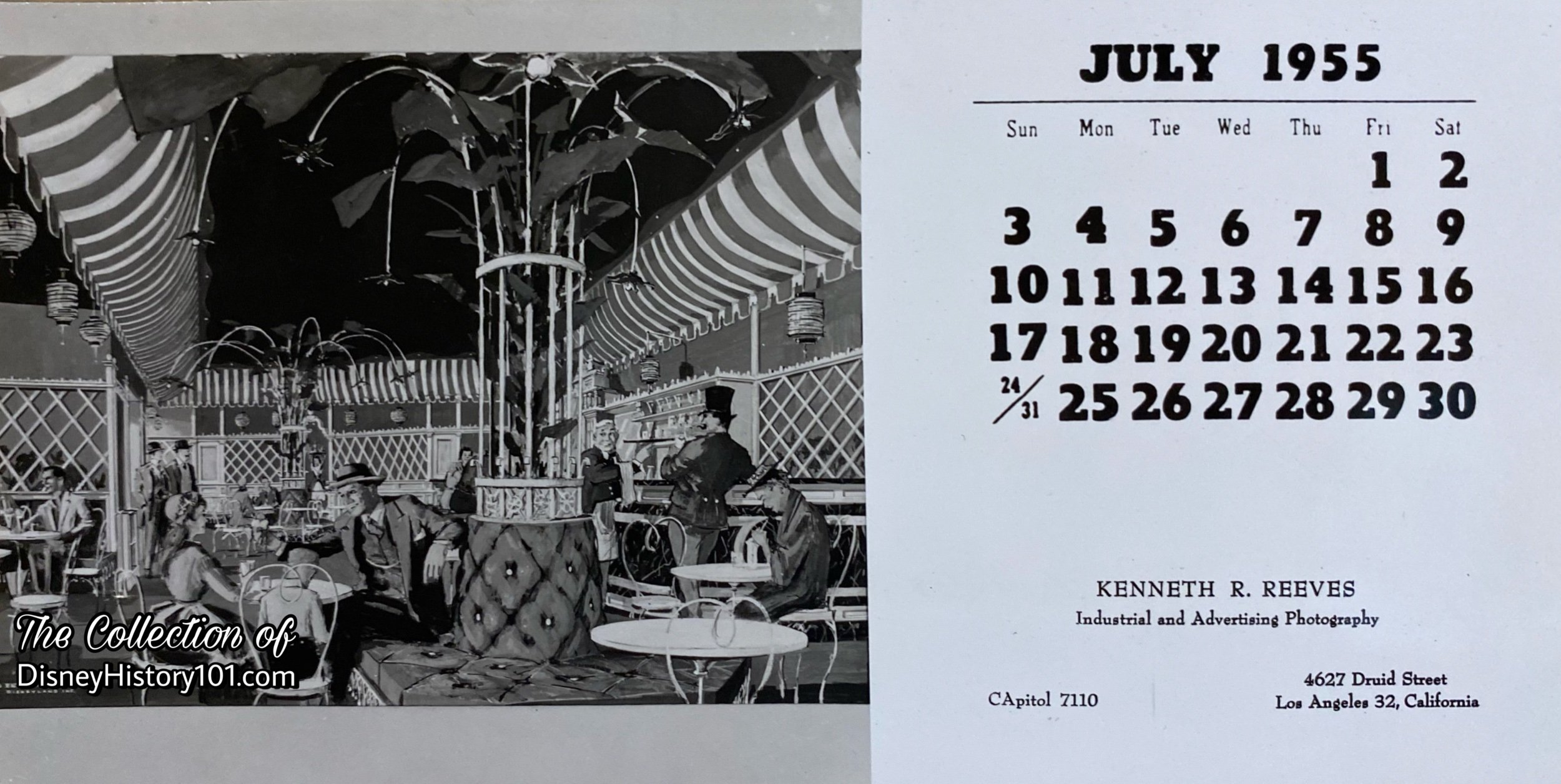

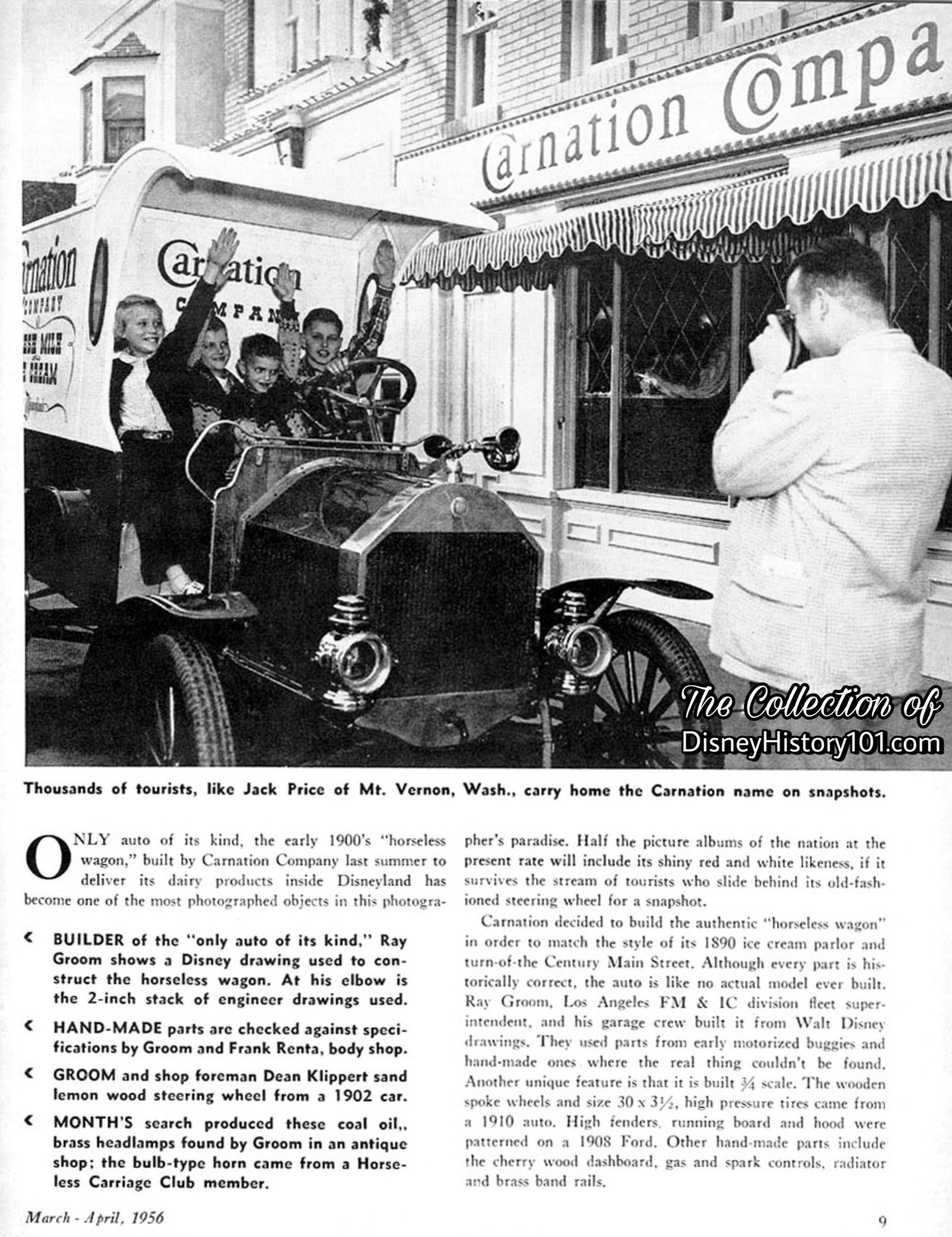
“Only Auto of Its Kind,” Carnation Magazine (March-April, 1956)
Very soon, the Carnation Farms Milk Truck made its way down the turn-of-the-century thoroughfare, for the Press Preview Day Parade held on July 17th, 1955! However, due to a limited amount of time and the placement of the Carnation Truck (at the very end of the parade), it was not seen by television viewers.
After this, the Carnation Farms Milk Truck frequently appeared parked on Main Street. The Carnation Farms Milk Truck would go on to become one of the most photographed of the Disneyland exhibits! “The Carnation Wagon was an instant hit from day one, though Walt had one objection: the plaque behind the driver’s seat read CARNATION. Walt knew hundreds of pictures a day were taken of kids sitting behind the wheel, so he had it replaced with one that said DISNEYLAND,” according to “Eat Like Walt - The Wonderful World of Disney Food, by Marcy Smothers. By the time this took place, guests had already taken countless photographs in front of the old plaque (testifies to in the following Vintage Views).
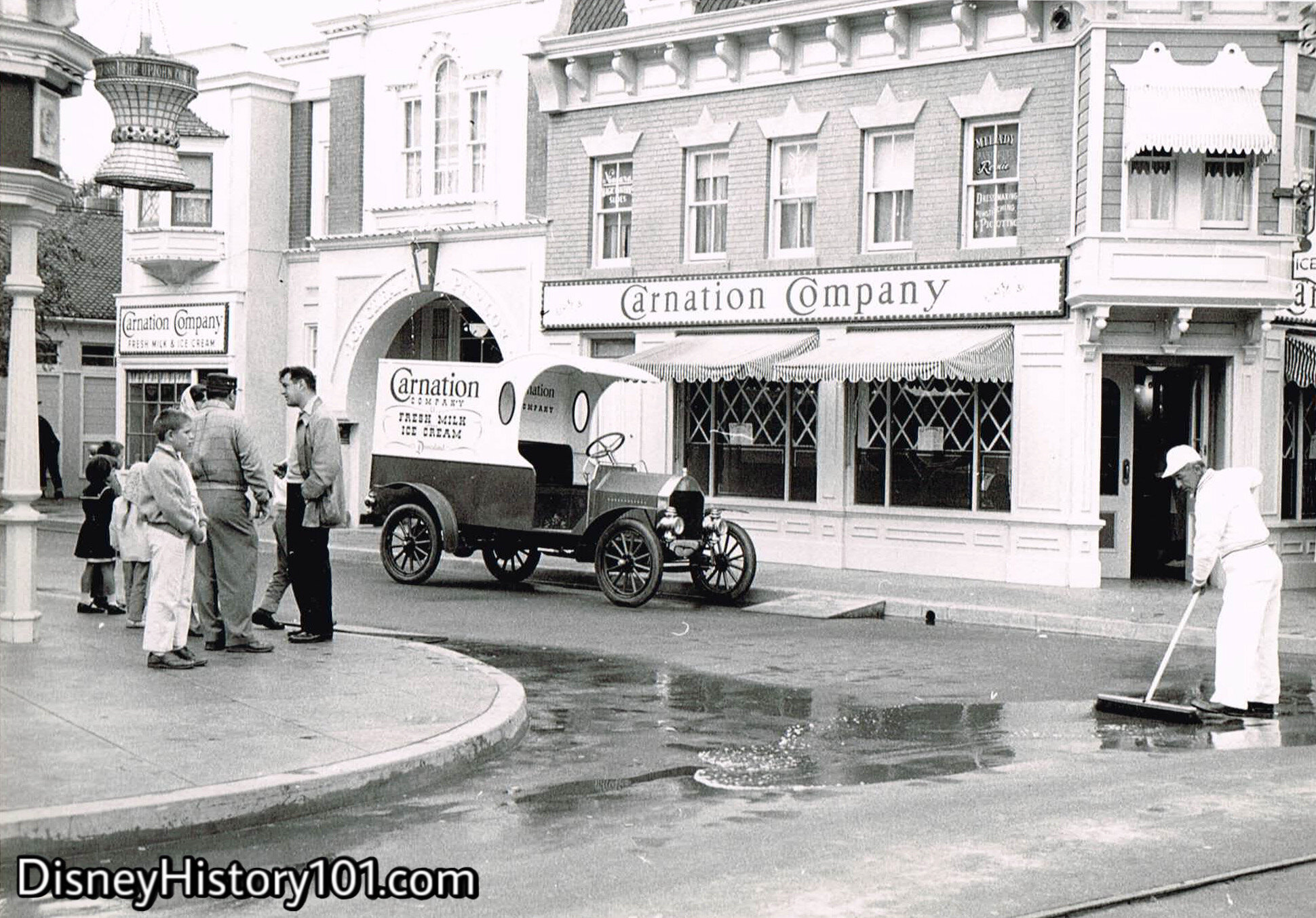
Carnation Cafe and Carnation Company Truck, (1955)
The morning is damp on Main Street U.S.A., and as the last of the water is brushed away by Custodians, guests begin to make their way toward the shops and restaurants. Accessible ramps have been laid down and the doors have been opened. It’s time to welcome guests at the little Carnation Cafe on the corner!
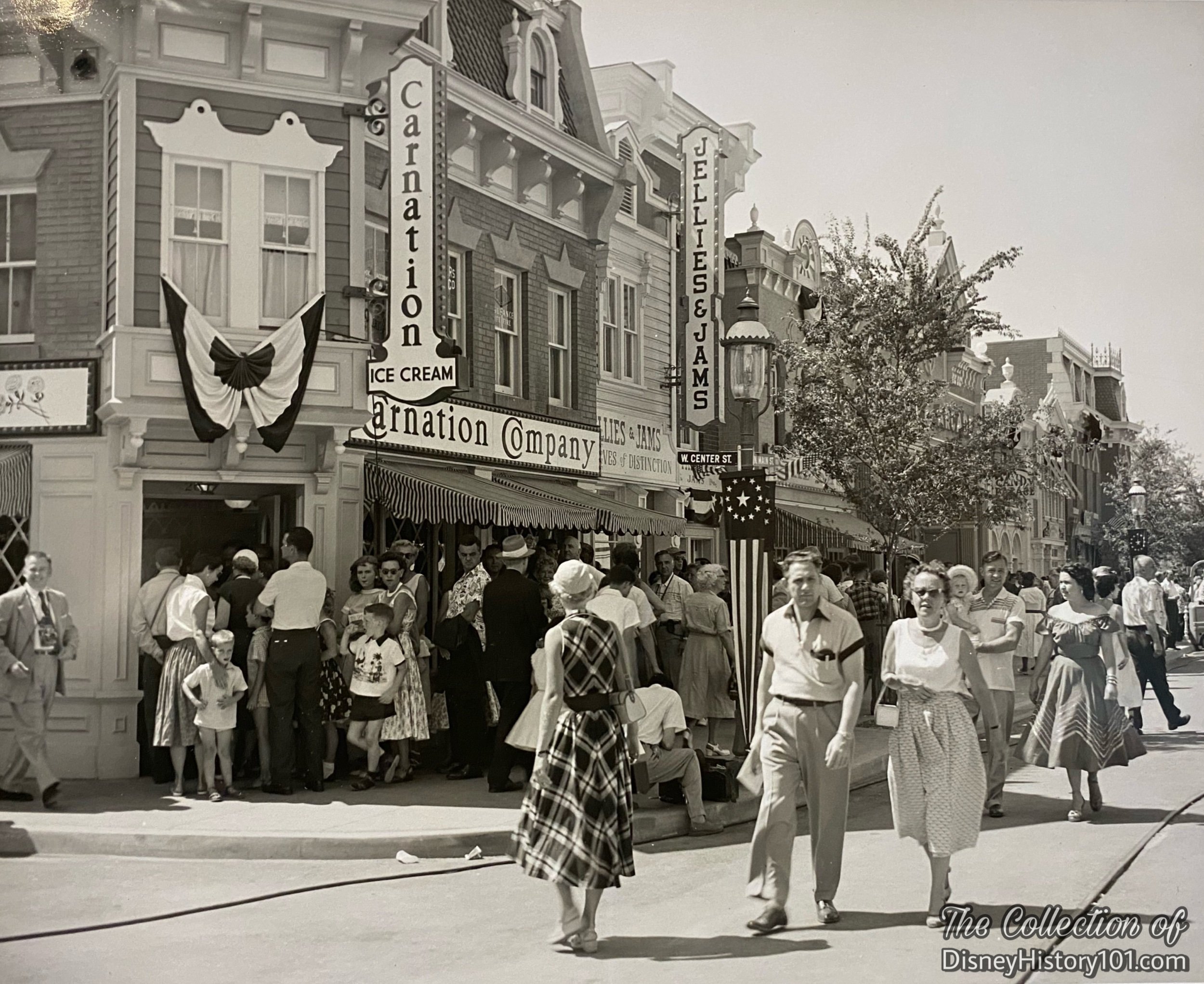
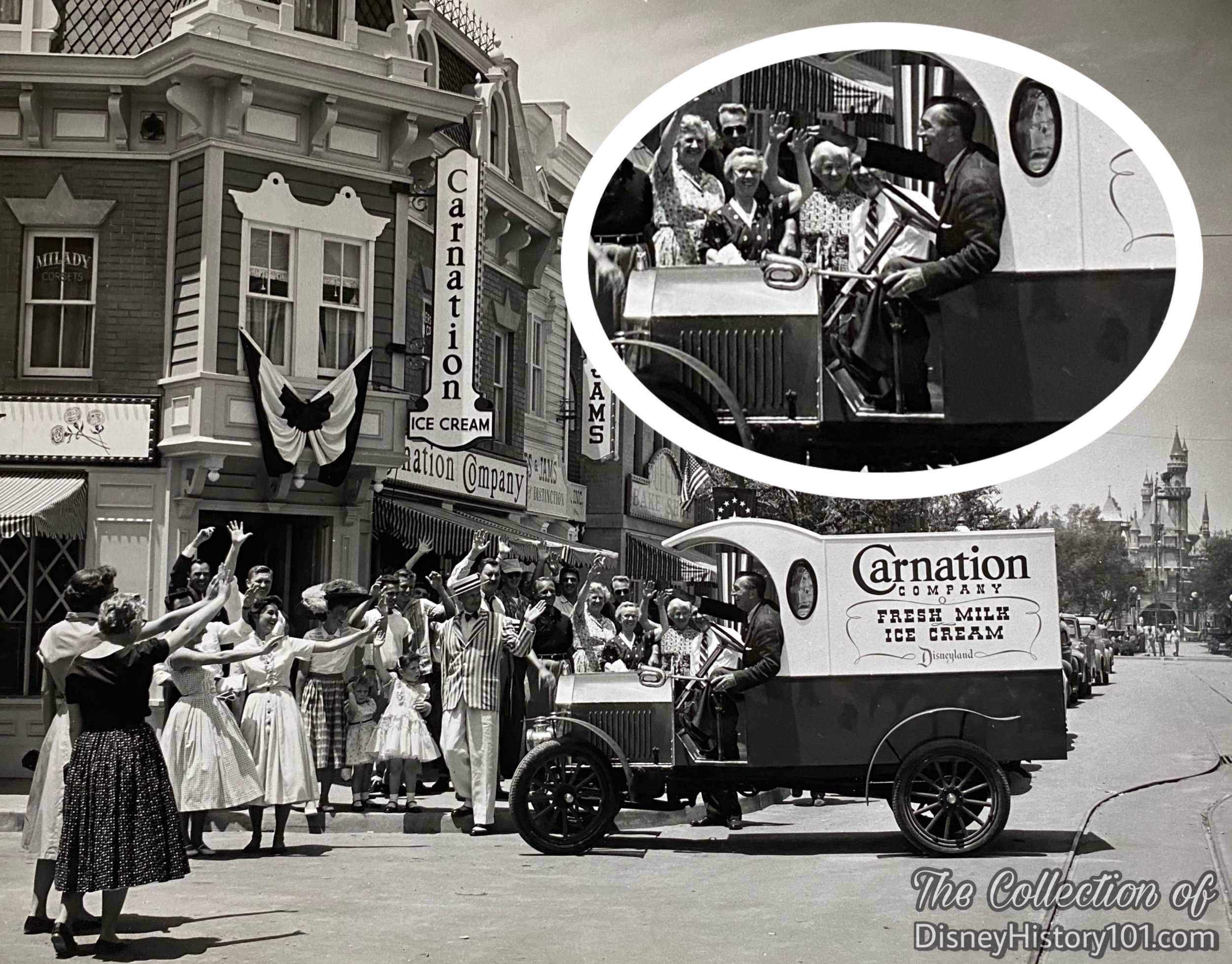
Delivery of the first milk and ice cream by E. Hadley Stuart, Jr.
The following day (July 18th), the Carnation Company invited specific members of the press and their families to be their “special guest at their Ice Cream parlor located on Main Street.” It appears that the big Grand Opening Ceremony was initiated when Elbridge Hadley Stuart Jr. (the grandson of the Carnation Company’s founder) and Walt Disney drove the Carnation Truck down Main Street U.S.A., arriving at the shop and“unloading ice cream and milk from the vehicle.”
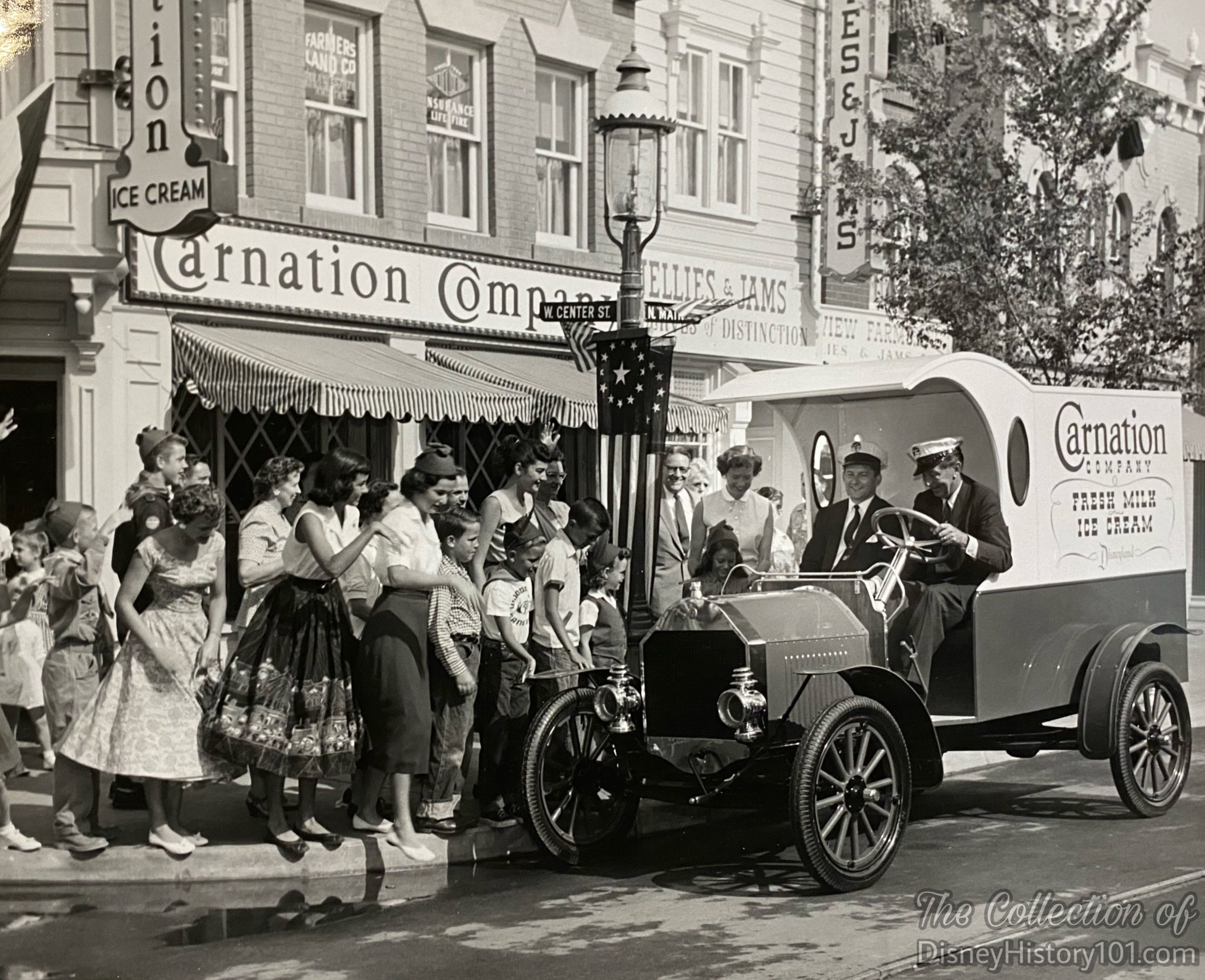
Elbridge Hadley Stuart Jr and Walt Disney arrive in the Carnation Milk Truck, July 18th, 1955.
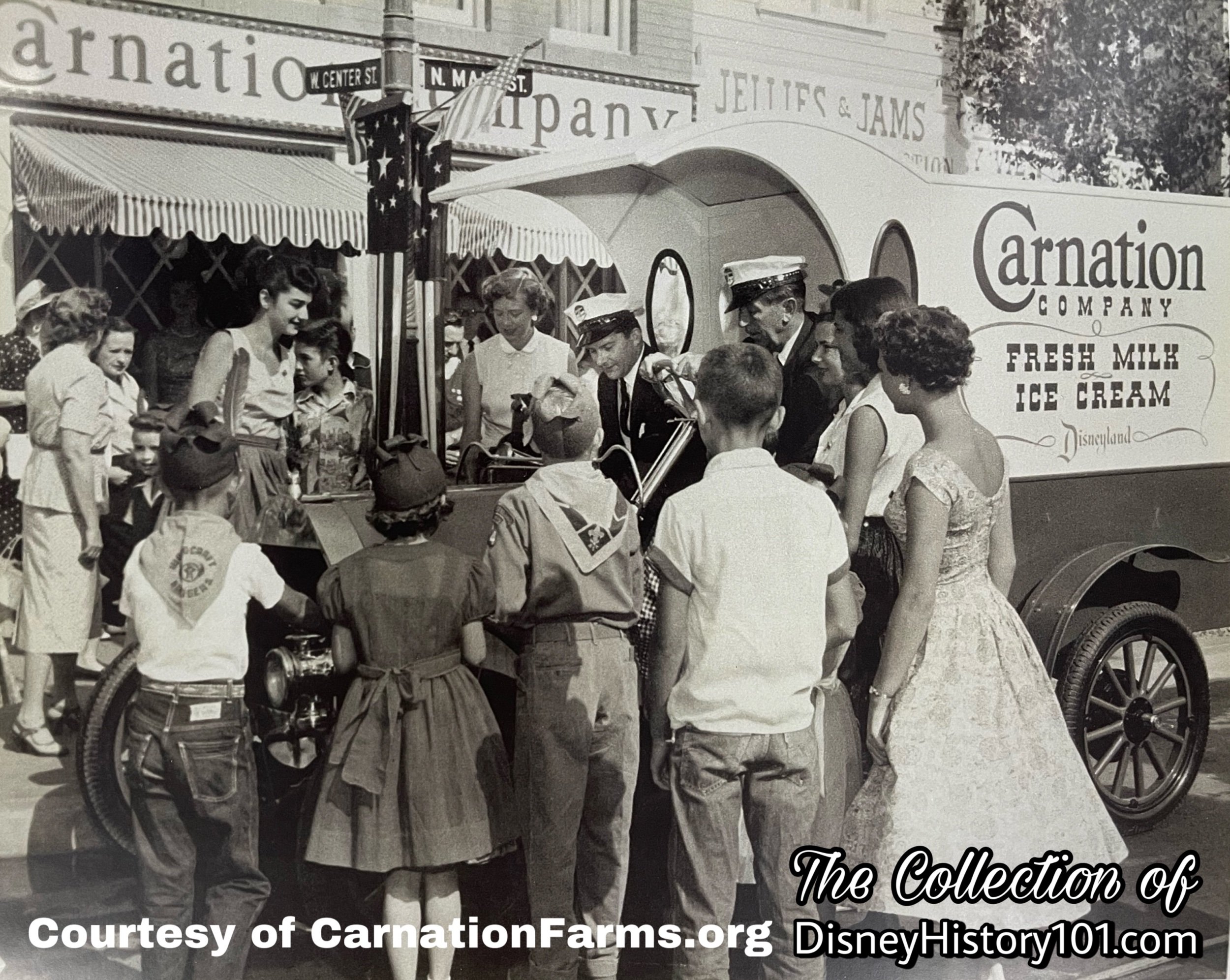
Elbridge Hadley Stuart Jr and Walt Disney make “Disney magic” as they deliver ice cream and milk to youth group members, July 18th, 1955.
According to Elbridge Hadley Stuart Jr., driving the Carnation Company Truck required much skill and great care, watching for both guests and the rails of the Main Street Horse Drawn Streetcar (in which the truck’s wheels had a tendency to get stuck). It sounds like they could have used some “cheese” - those orange rubber wedges used to fill trolley tracks during parades. Of Walt’s overall actions (as depicted in these Vintage Views), Bill Cottrell later noted that “Walt had an ability to put himself in the shoes of the common man… He wanted people to be treated the way he expected to be treated himself.”
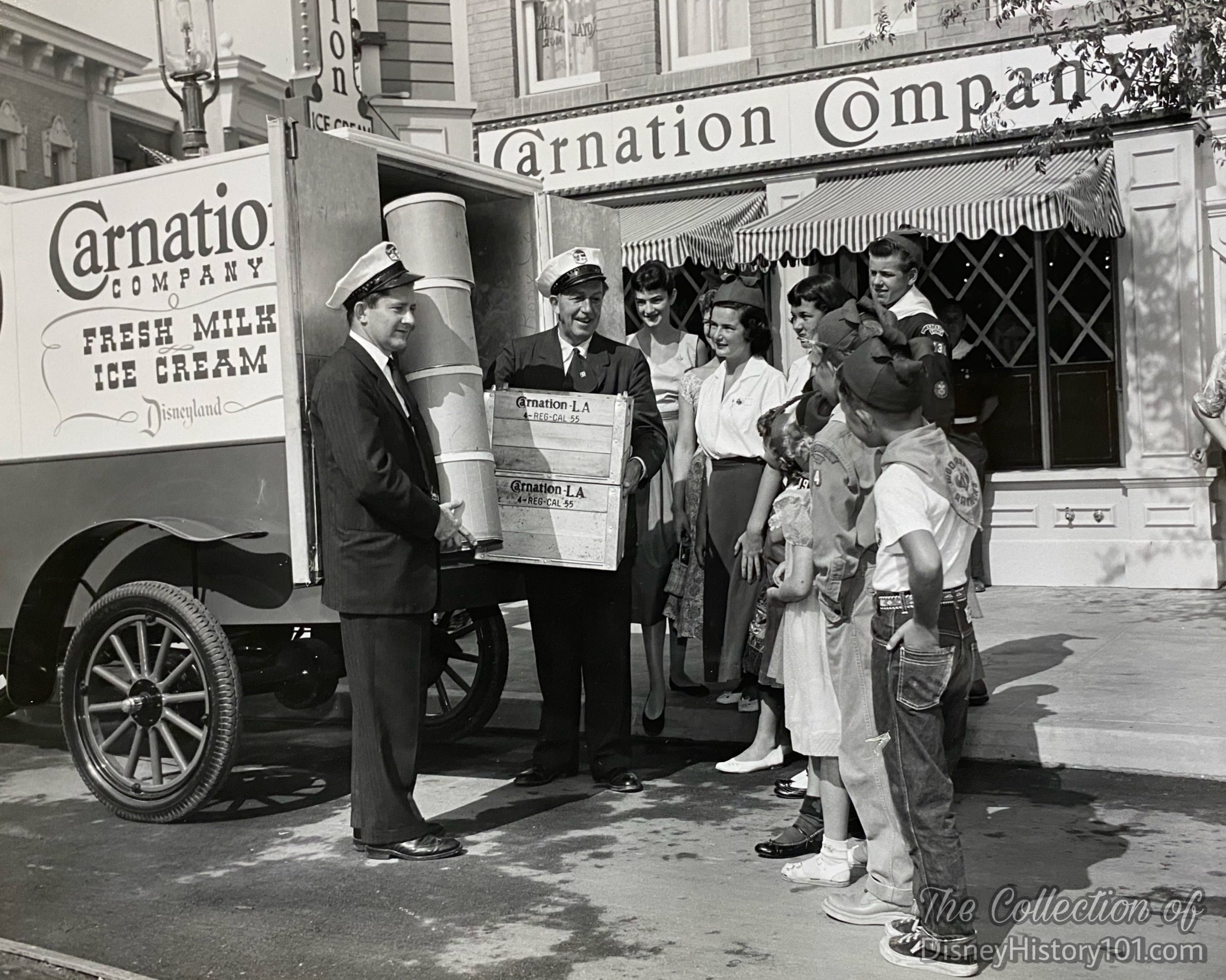
Elbridge Hadley Stuart Jr and Walt Disney deliver ice cream to Carnation, July 18th, 1955.
Above: Children from seven youth groups watch Disney and Hadley Stuart, grandson of Carnation's founder, unload the the first ice cream at the formal opening.

First guest at the Carnation Company 1890 style ice cream parlor at Disneyland was Walt Disney himself (R), accepting the first soda, whipped
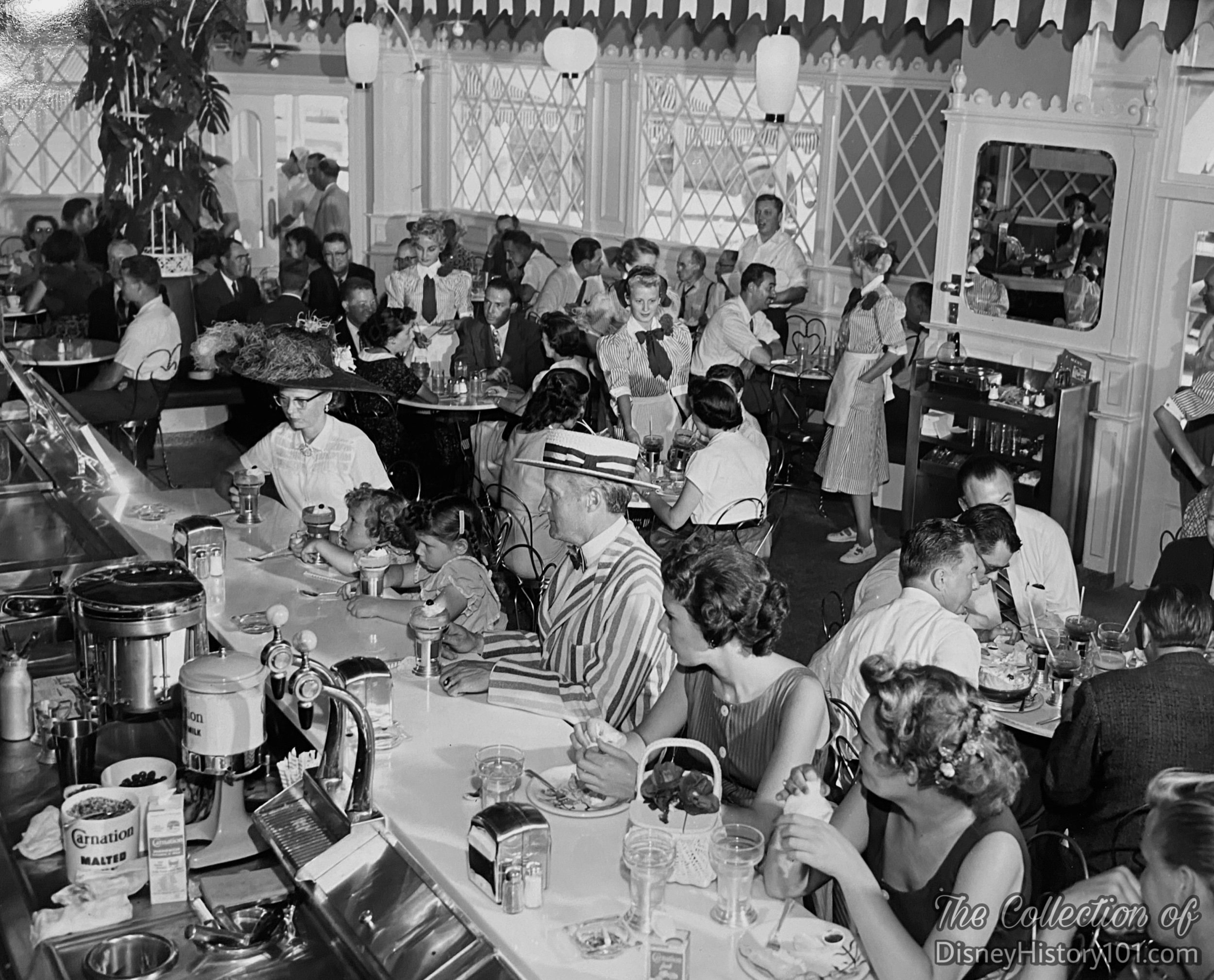
On the first day 4500 hungry and thirsty people were served in its 1890-style ice cream parlor.
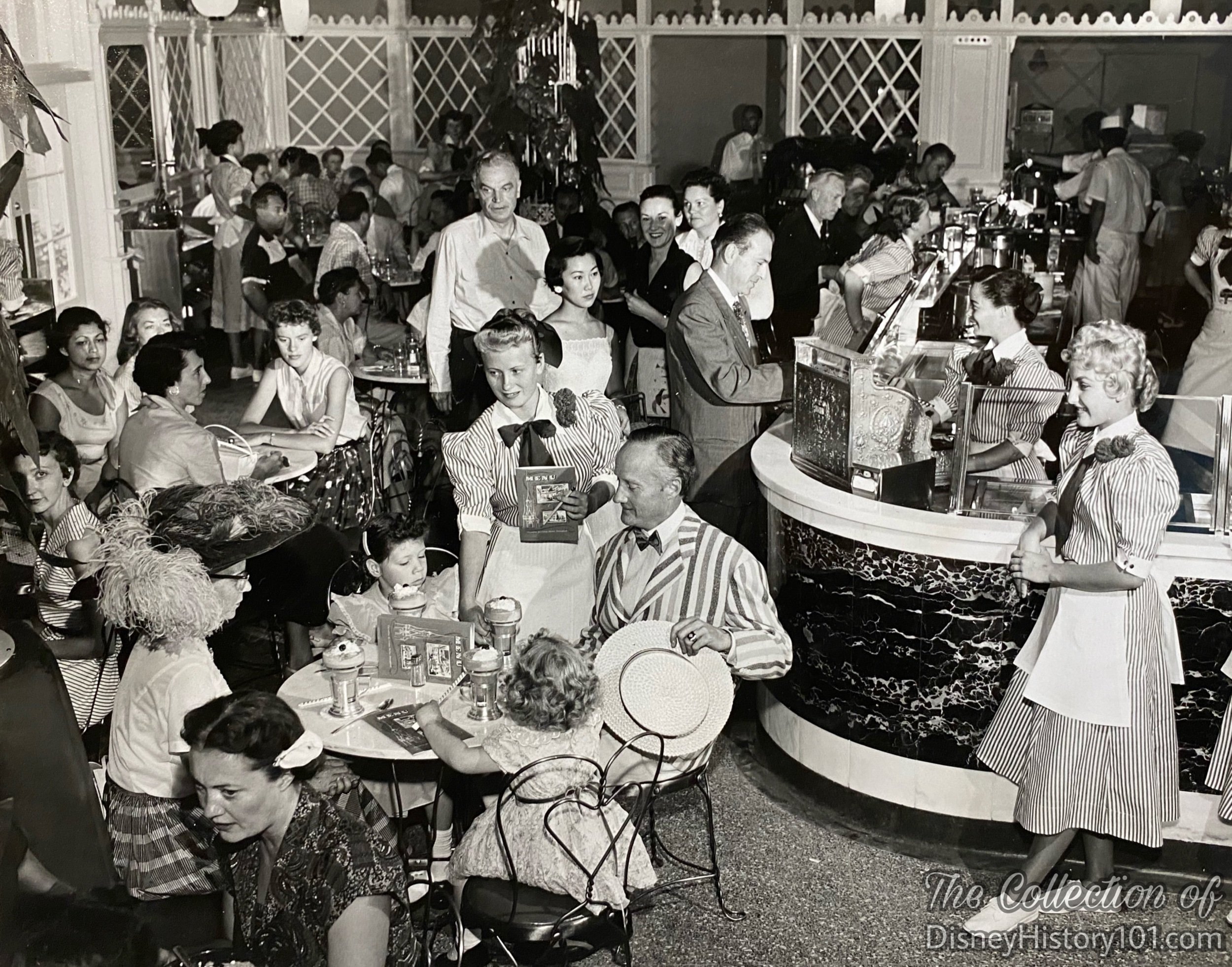
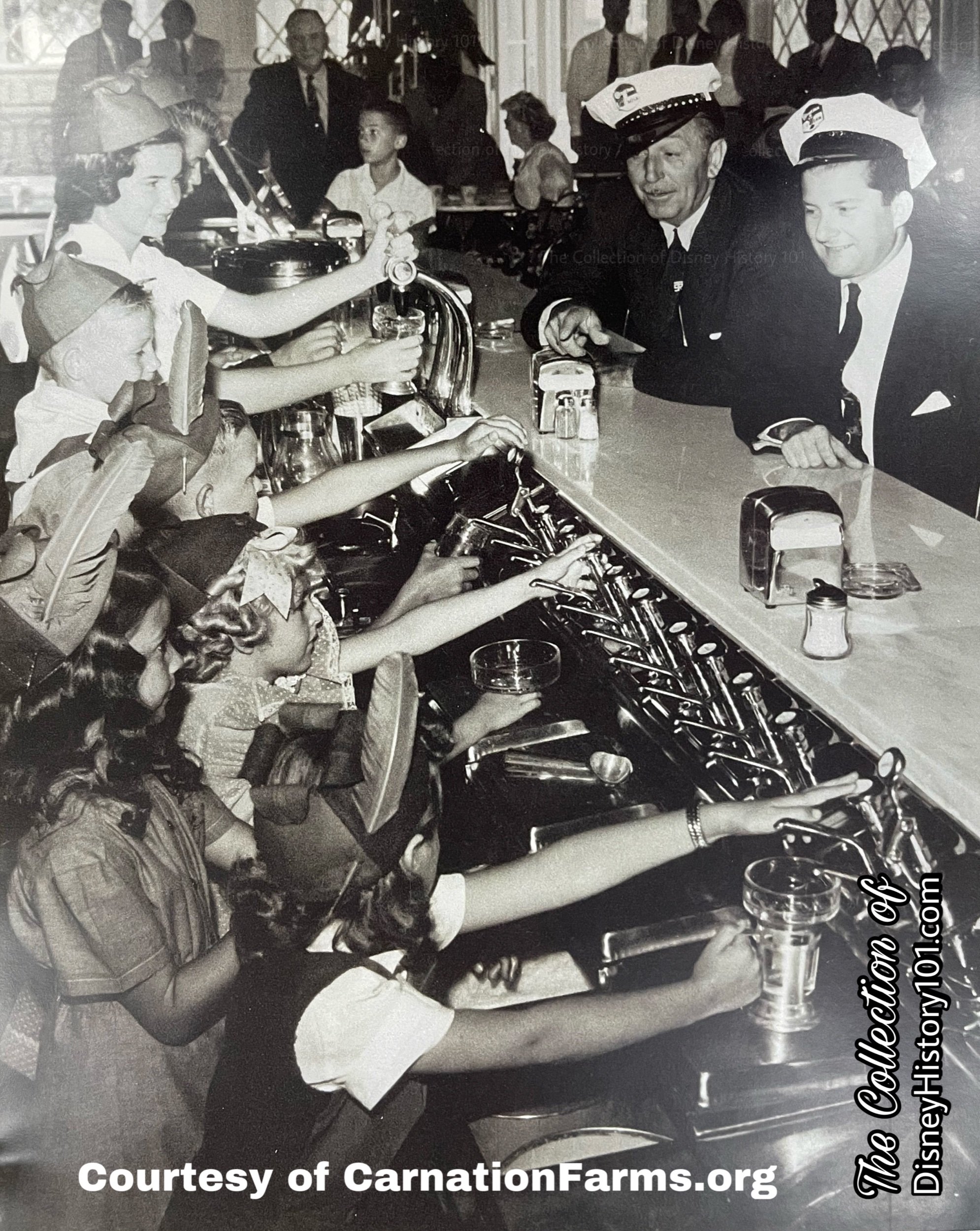
According to a column appearing in Milk News (Vol. XLV, No. 15 ; July 29, 1955) :
“Still another wonder was piled on the multitude of wonders at the nation’s newest entertainment center today, when two dozen youngsters affiliated with Los Angeles and Orange County youth organizations were given ‘run of the fountain’ at Carnation’s 1890 Ice Cream Store…
Inside the store, the youngsters were shown the various syrup wells, where located, how to use a syrup scoop and then told to concoct their own combinations.
Many of the finished dishes were new concepts of flavor combinations which had the regular fountain personnel scratching their heads in bewilderment. Most of them were top-heavy with garnish, but the youngsters agreed they were all delicious when they had lapped up the last spoonful at the tables in the company’s picturesque old-time ice cream parlor.
Linda Blakely of Anaheim, a Brownie, was designated ‘Champion Fountain Specialist’ after all the dishes were judged by a panel of experts for her concoction which consisted of a scramble of various flavored ice creams, several syrups, a couple of toppings and whipped cream. One more ingredient - Linda added a banana for good measure.”
Reports of these ceremonious events were swiftly published. As a result, in the days and weeks that followed, Carnation Ice Cream Parlor continued to receive visits by many notable VIP guests, from Richard Nixon (whose brother was a Carnation Sales Manager) to actress Shirley Temple.
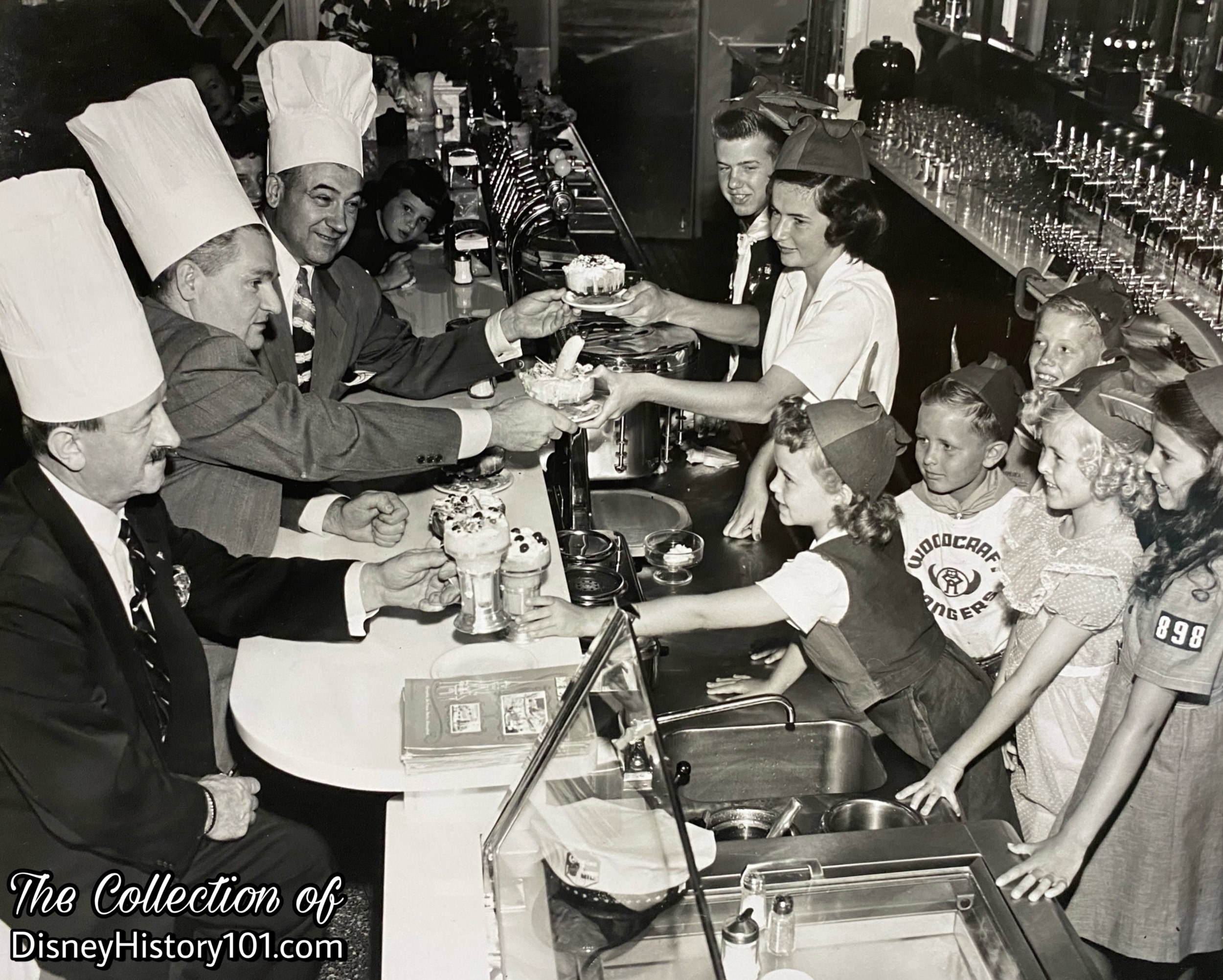
The dessert-making contest.
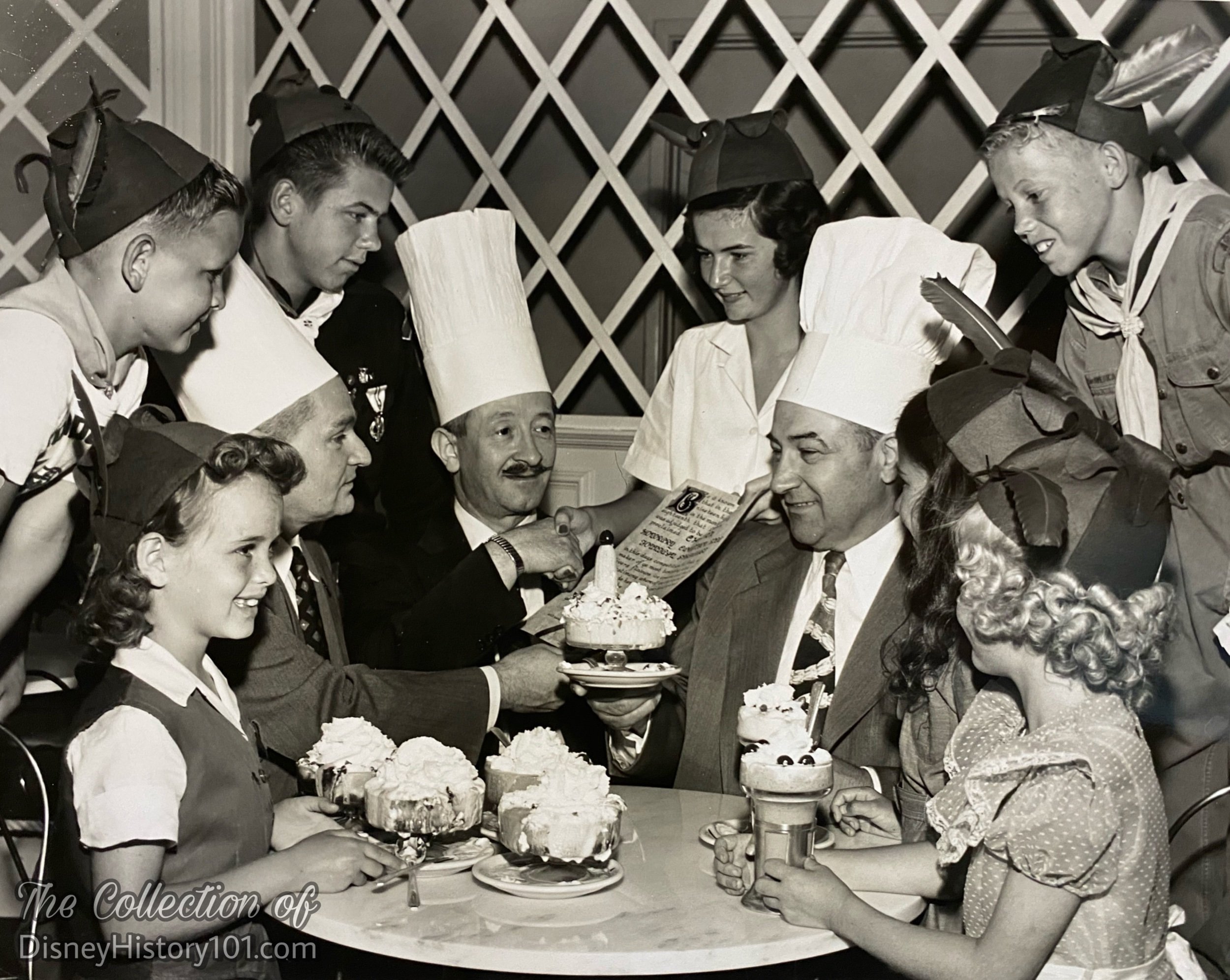
Chefs of the Los Angeles Ambassador, Billtmore and Statler hotels show winning dessert.
Ice cream desserts made by the Boy and Girl Scouts and other Community Chest agency children were judged by the head chefs of three leading Los Angeles hotels. Each child was Carnation's guest at Disneyland for the day.


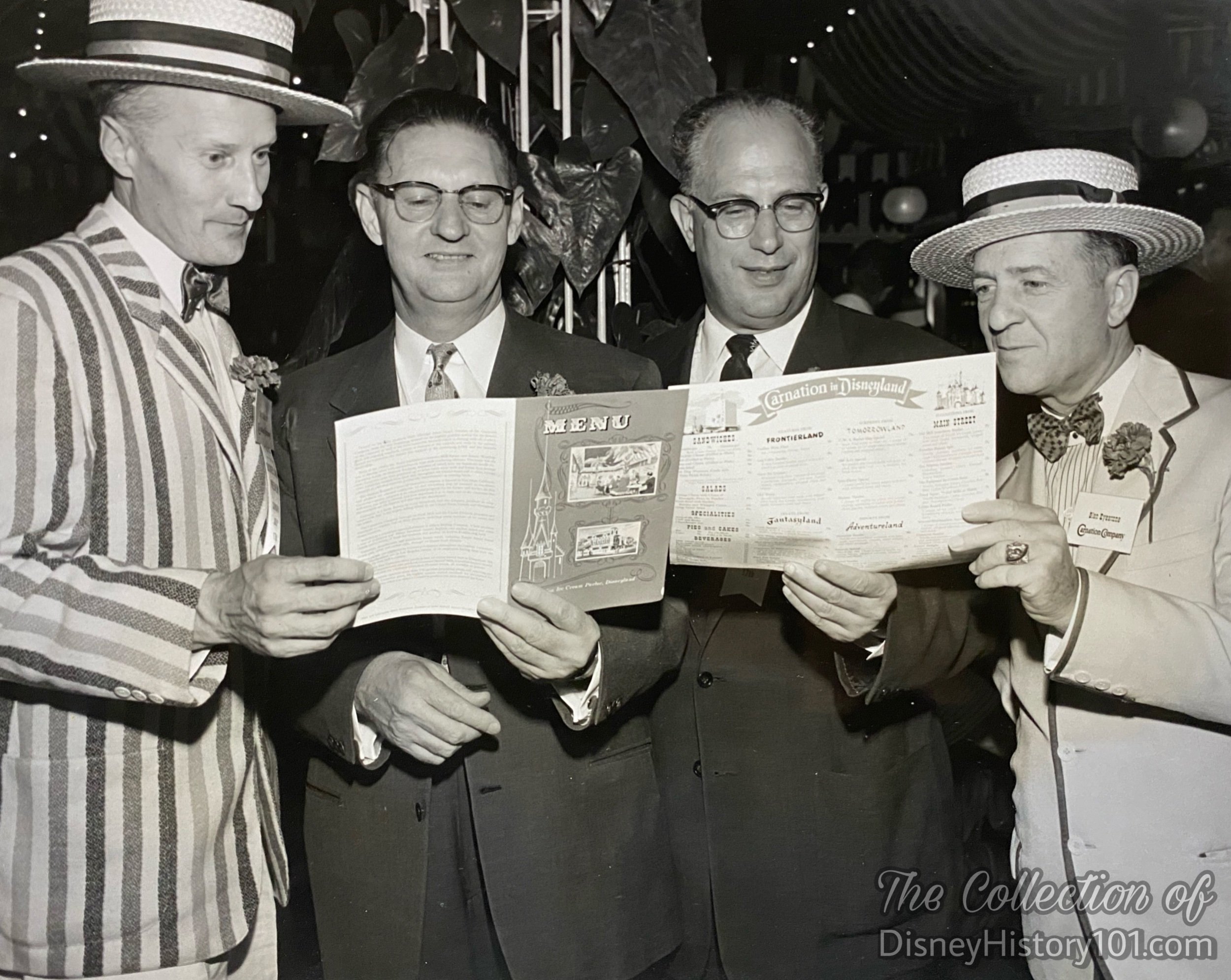
Coy Watson Photo of Los Angeles.
Above: Carnation's key men in Disneyland, reading the special menu, are, (L. to R.) R. A. Keplinger, C. J. Noell, F. A. Nelson, G. Eyestone. Not pictured is store's manager, W. C. Slanina.
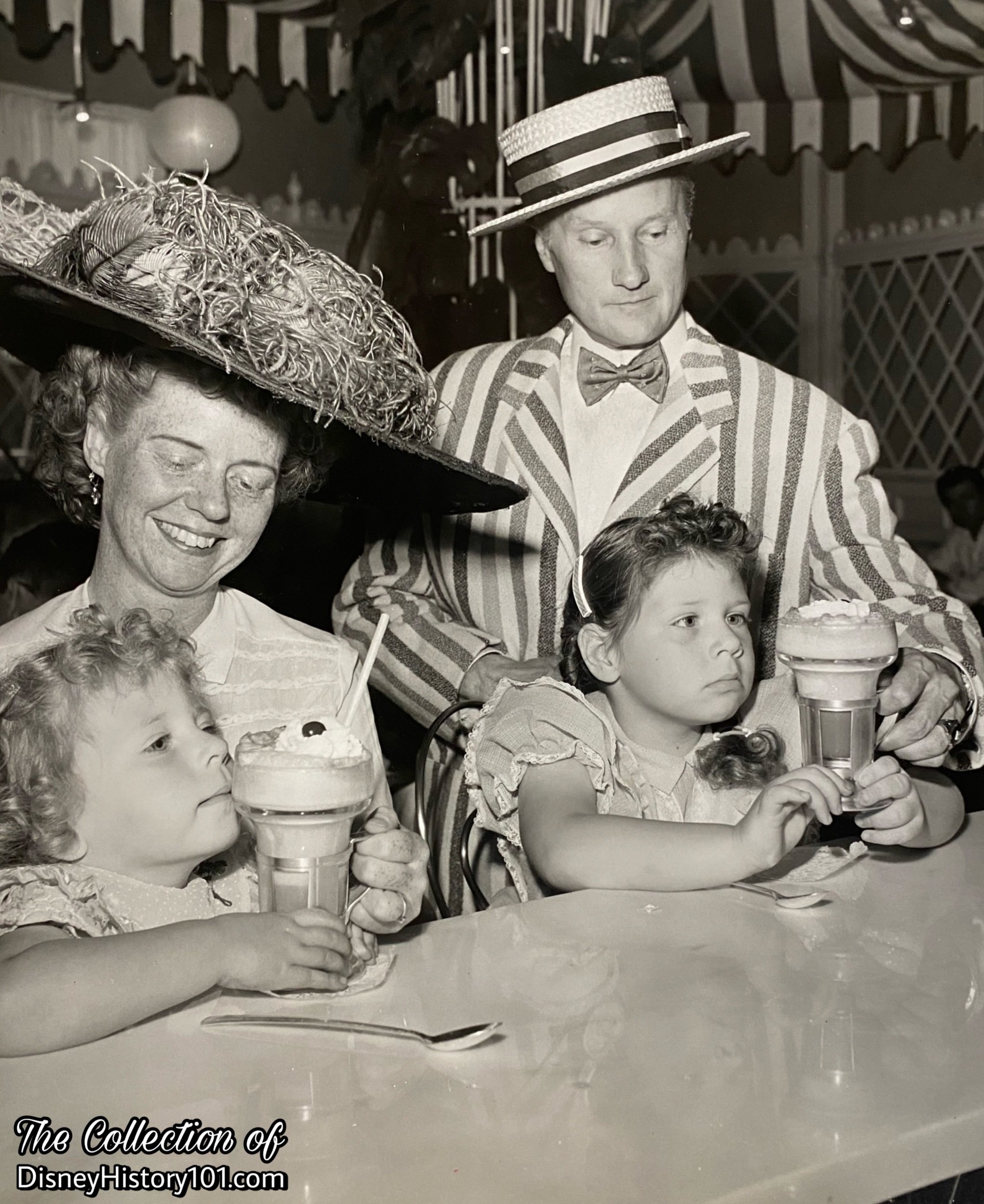
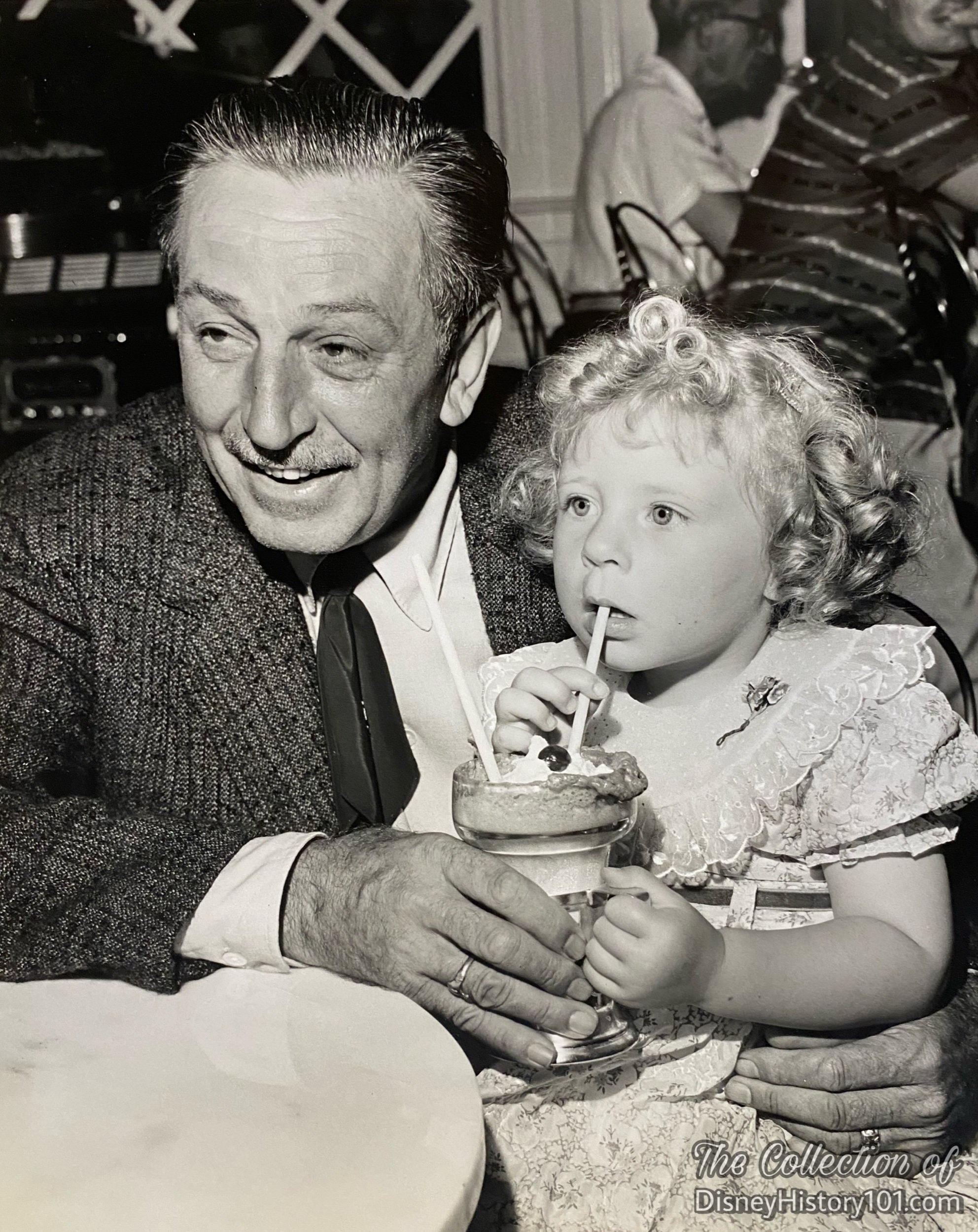
International News Photo.
According to The Daily Oklahoman: “The first visitor to Disneyland sneaked in one day early and got some special treatment from the boss. She's Blaine Long, 3, and her host for an old-fashioned ice cream delight in the Gay Nineties ice cream parlor is Walt Disney himself.”
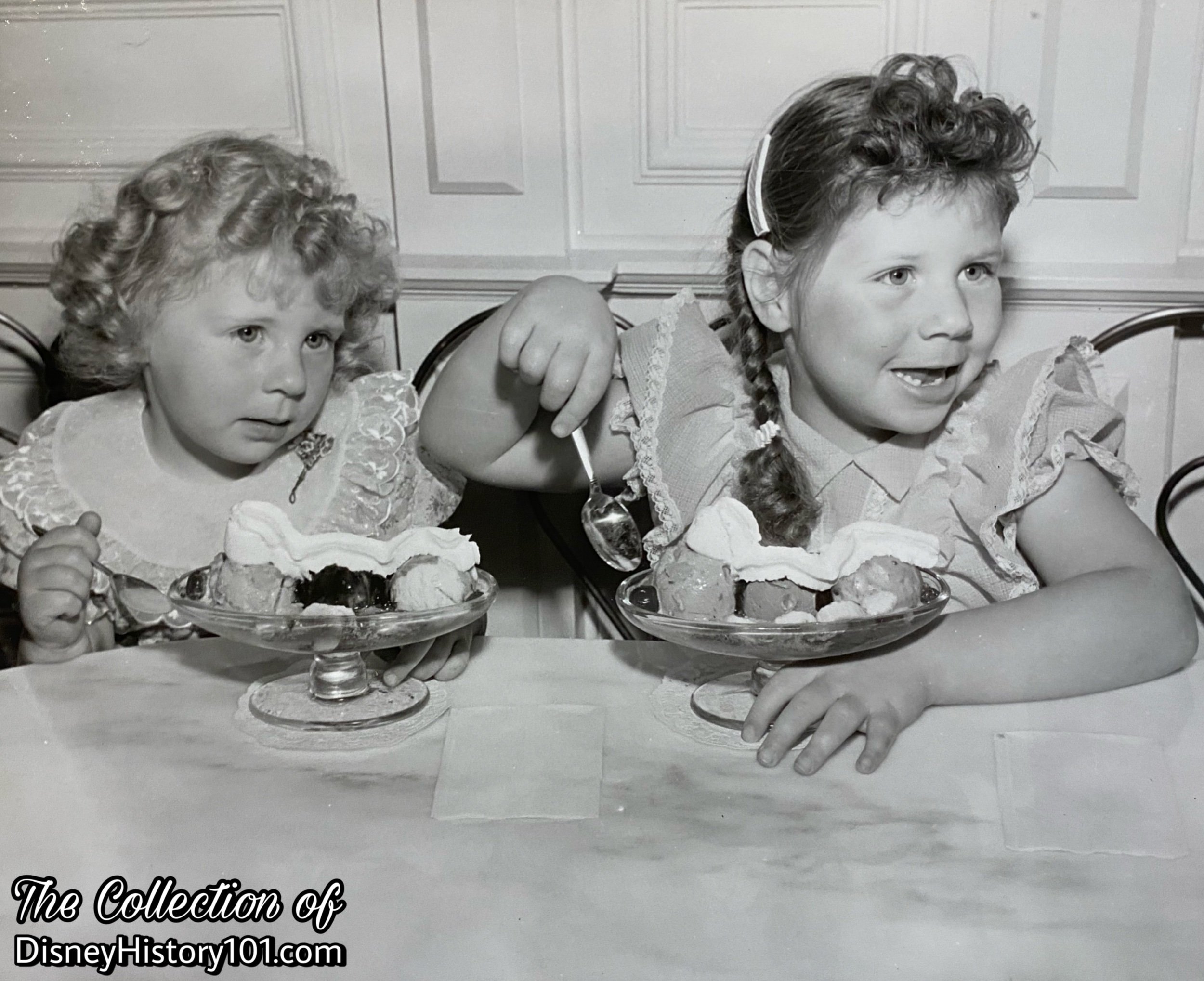

According to Pacific Coast Review: “Christine Long didn't let the ostrich-plumed picture hat interfere with her attack on a Lillian Russell parfait as she helped in the recent opening of Carnation Company's 1890-style ice cream parlor in Disneyland near Anaheim, California.”
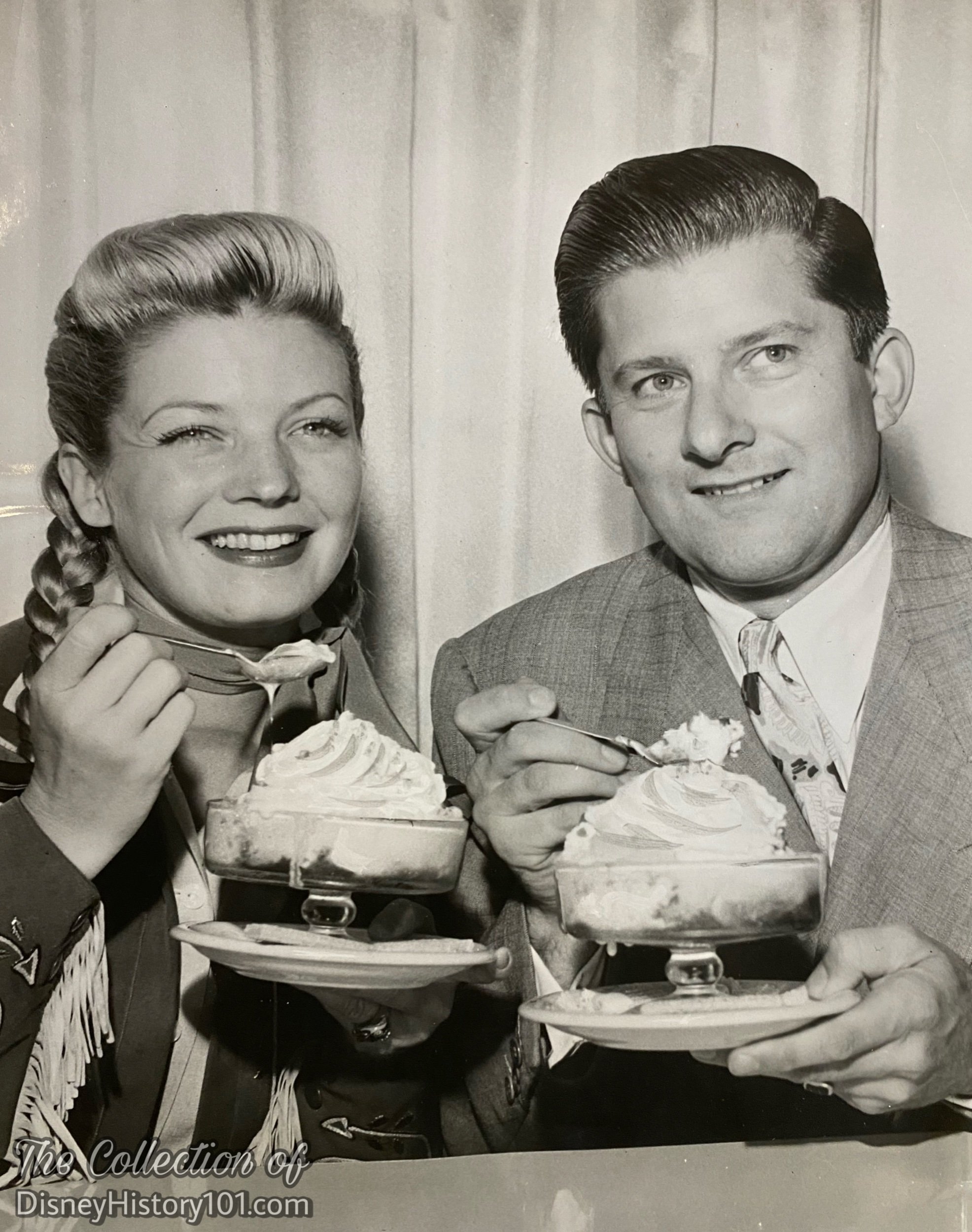
Gail Davis, (television's Annie Oakley) cohosted a party for more than 1,000 newsmen in the old-fashioned parlor at a preview on July 17th. She and Mr. E. Hadley Stuart, Jr. (grandson of Carnation's founder) took part in American Broadcasting Company's national telecast of the pre-view. Millions saw Carnation's TV star, Annie Oakley ride horseback in the national telecast.
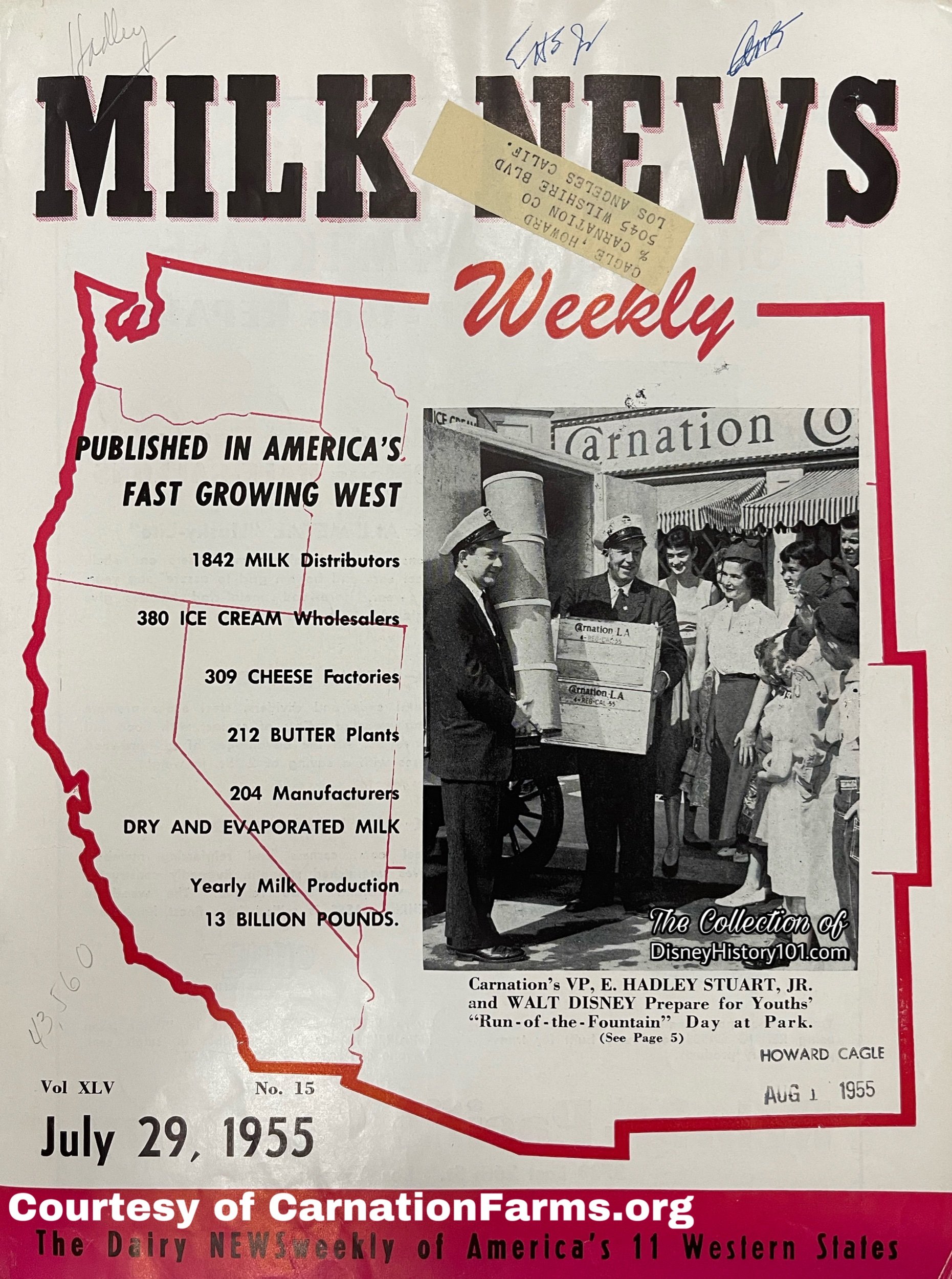
“Disneyland is News” (again), this time, on the cover of Milk News Weekly published for July 29, 1955
Carnation would also serve 15 wholesale customers who operated restaurants and snack bars in Disneyland.
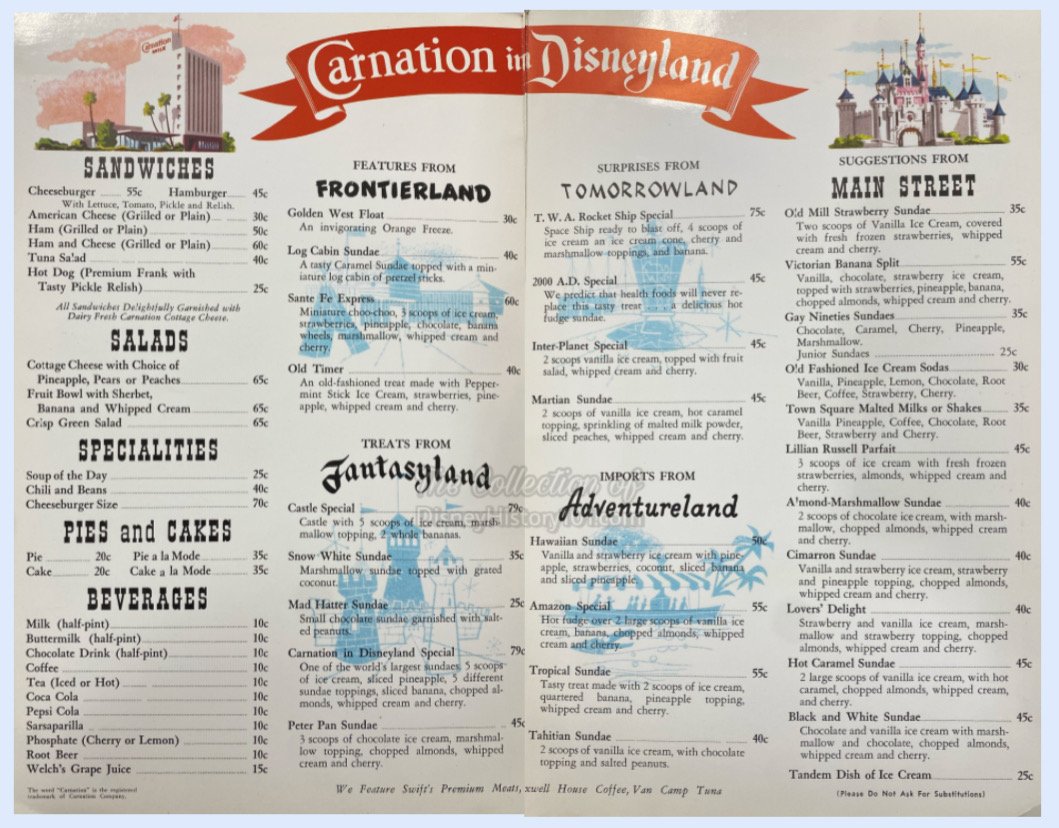
The Carnation menu in 1955.
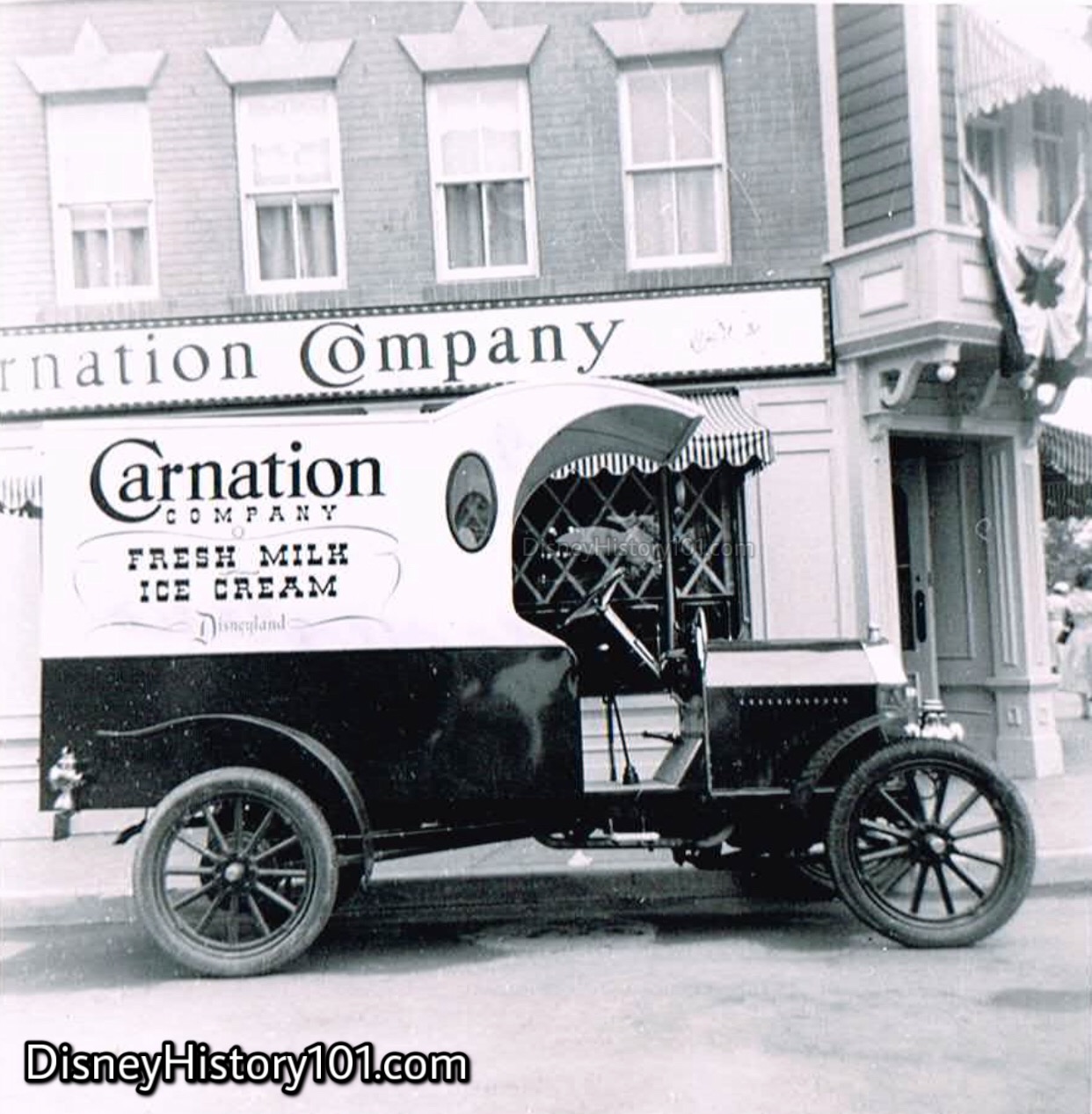
Carnation Company Truck Exhibit, (August 4th, 1955)
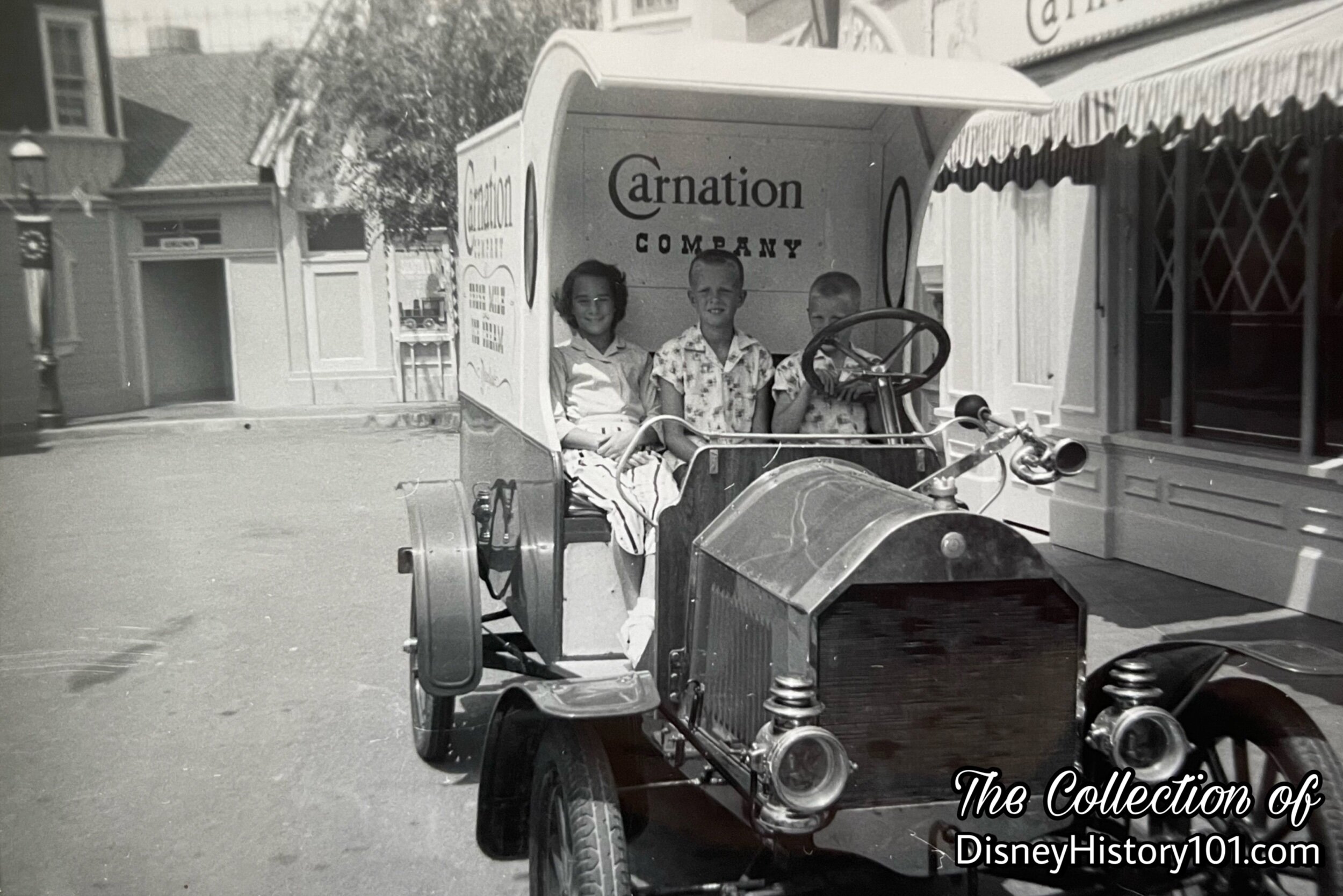
Carnation Company Truck Exhibit
The first Disneyland Dictionary (printed in October of 1959) noted “Old-time Carnation delivery truck - complete with horn - is displayed outside, and is a favorite picture-taking prop.” You may notice that the “bulb-type” horn is present in the preceding Vintage View, while it was removed at some time (perhaps to prevent guests from squeezing it to produce a honk).
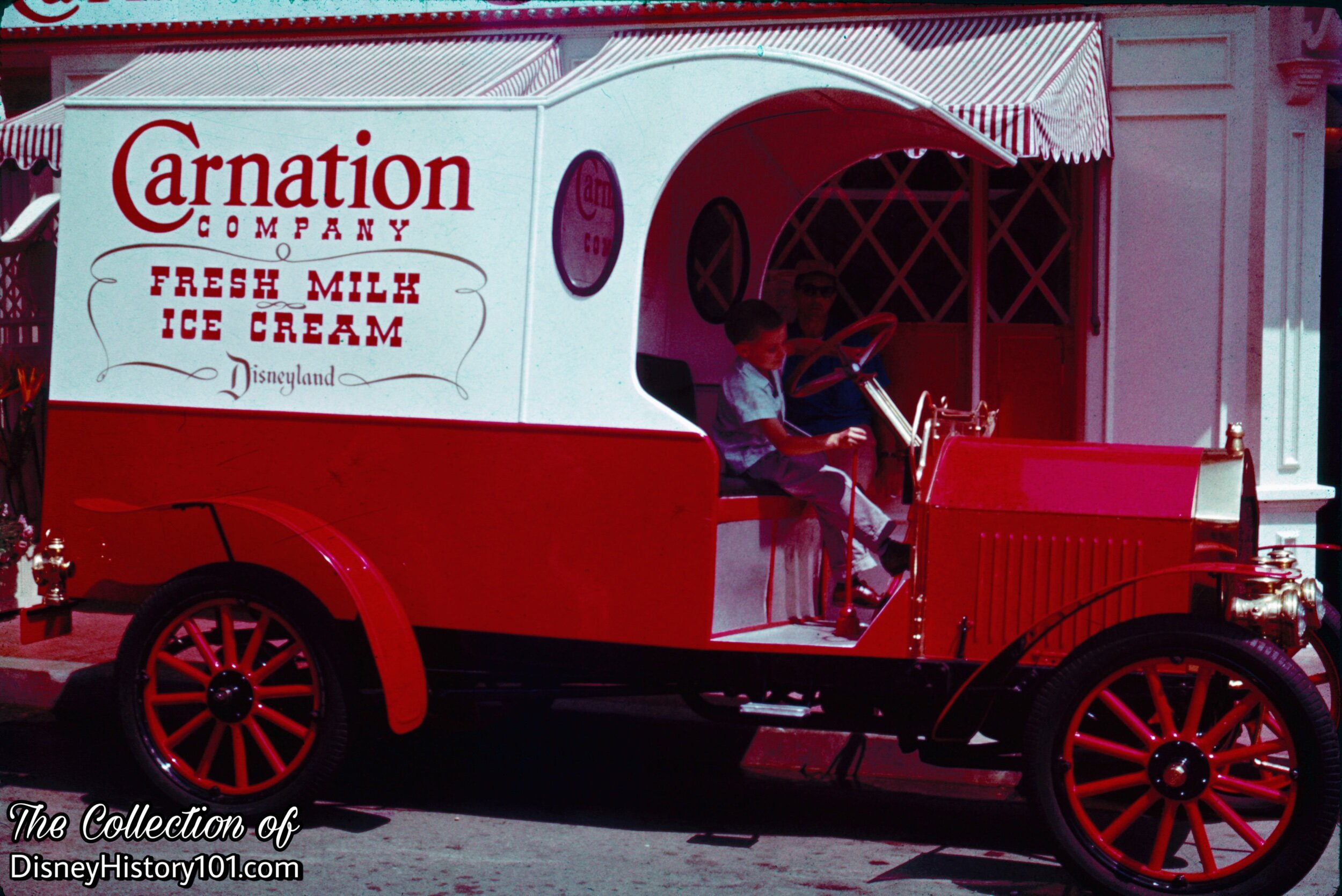
Carnation Company Truck Exhibit, (Summer, 1960)
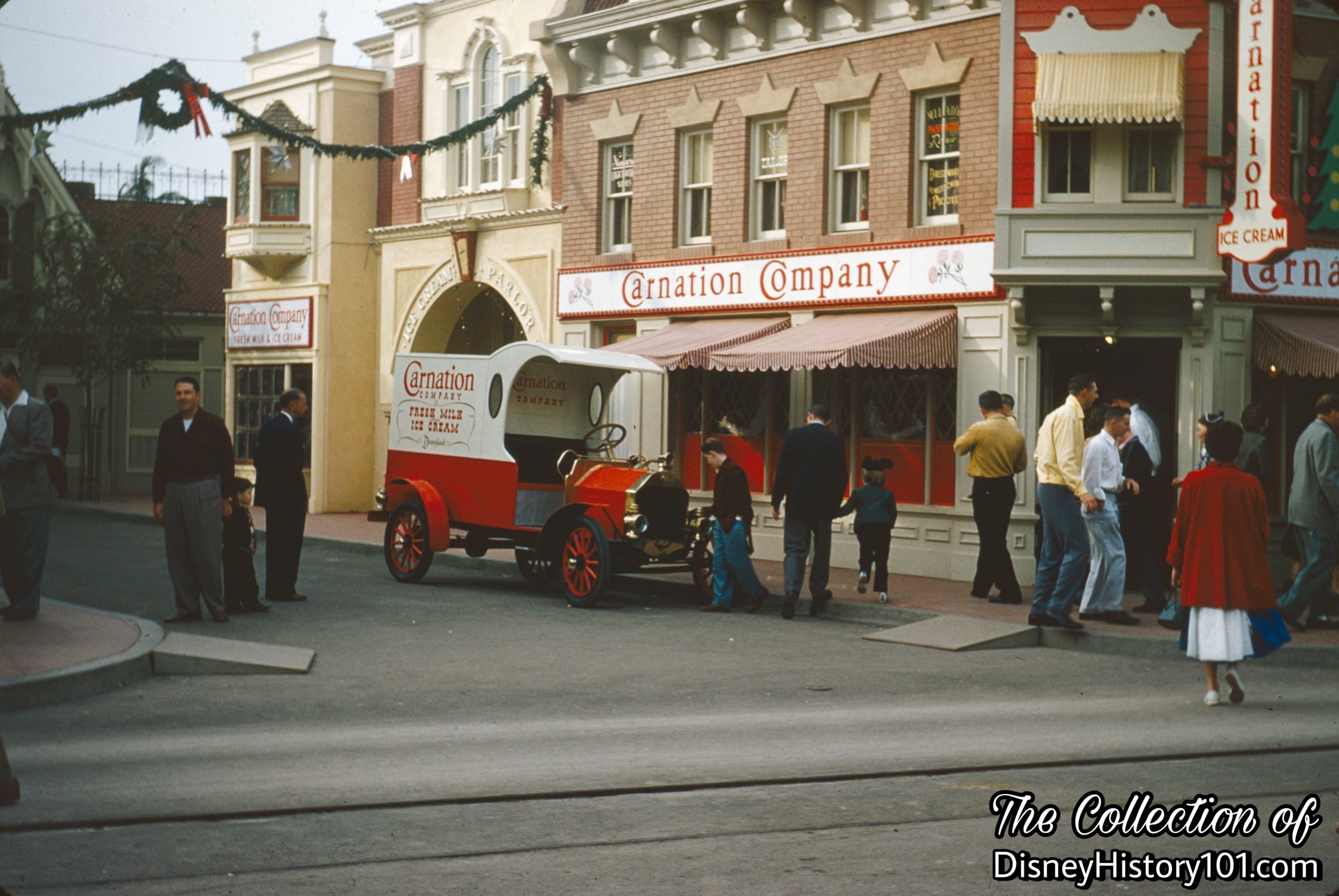
Deember of 1955

Carnation Company Truck Exhibit
In the previous Vintage View, you may be wondering where those noticeably absent shiny brass headlamps are?
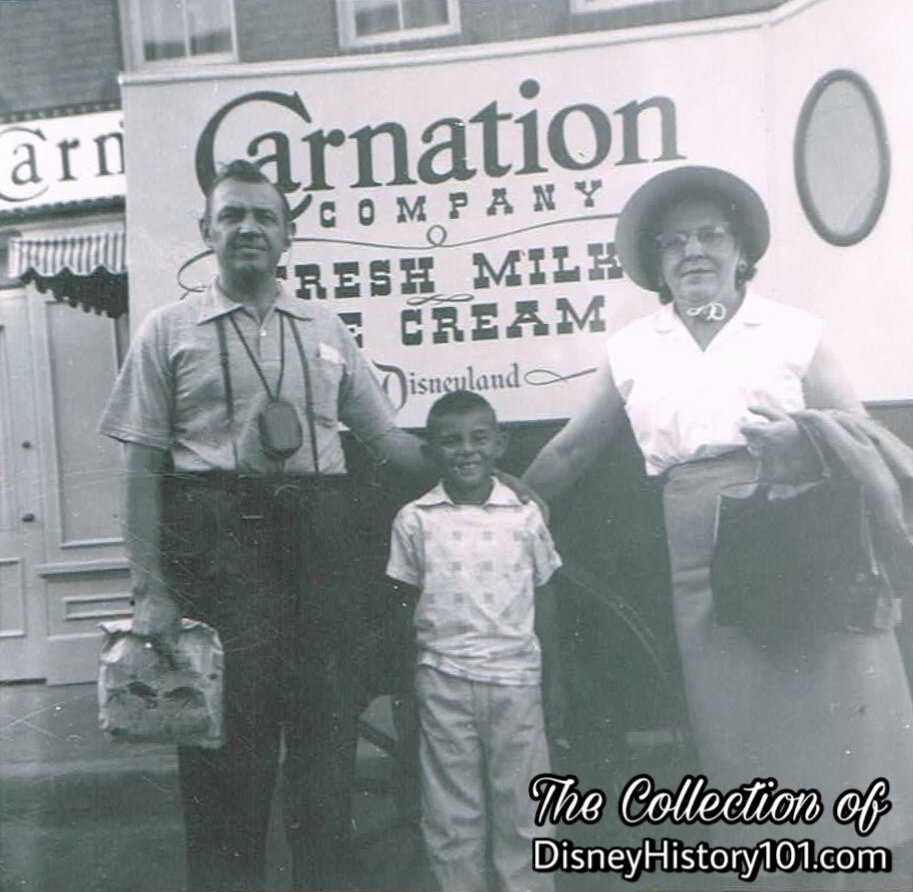
Carnation Company Truck Exhibit
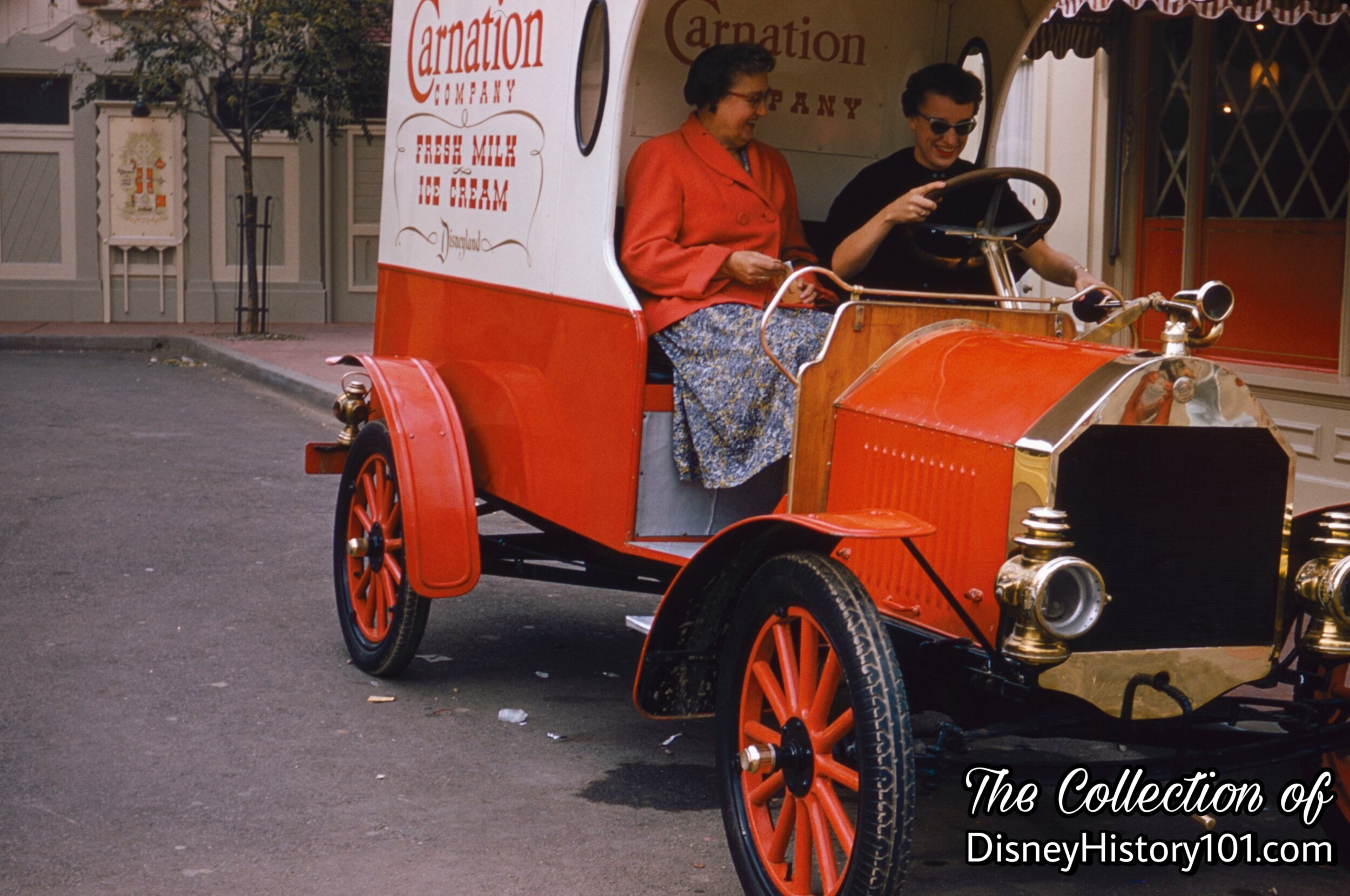
Carnation Company Truck Exhibit
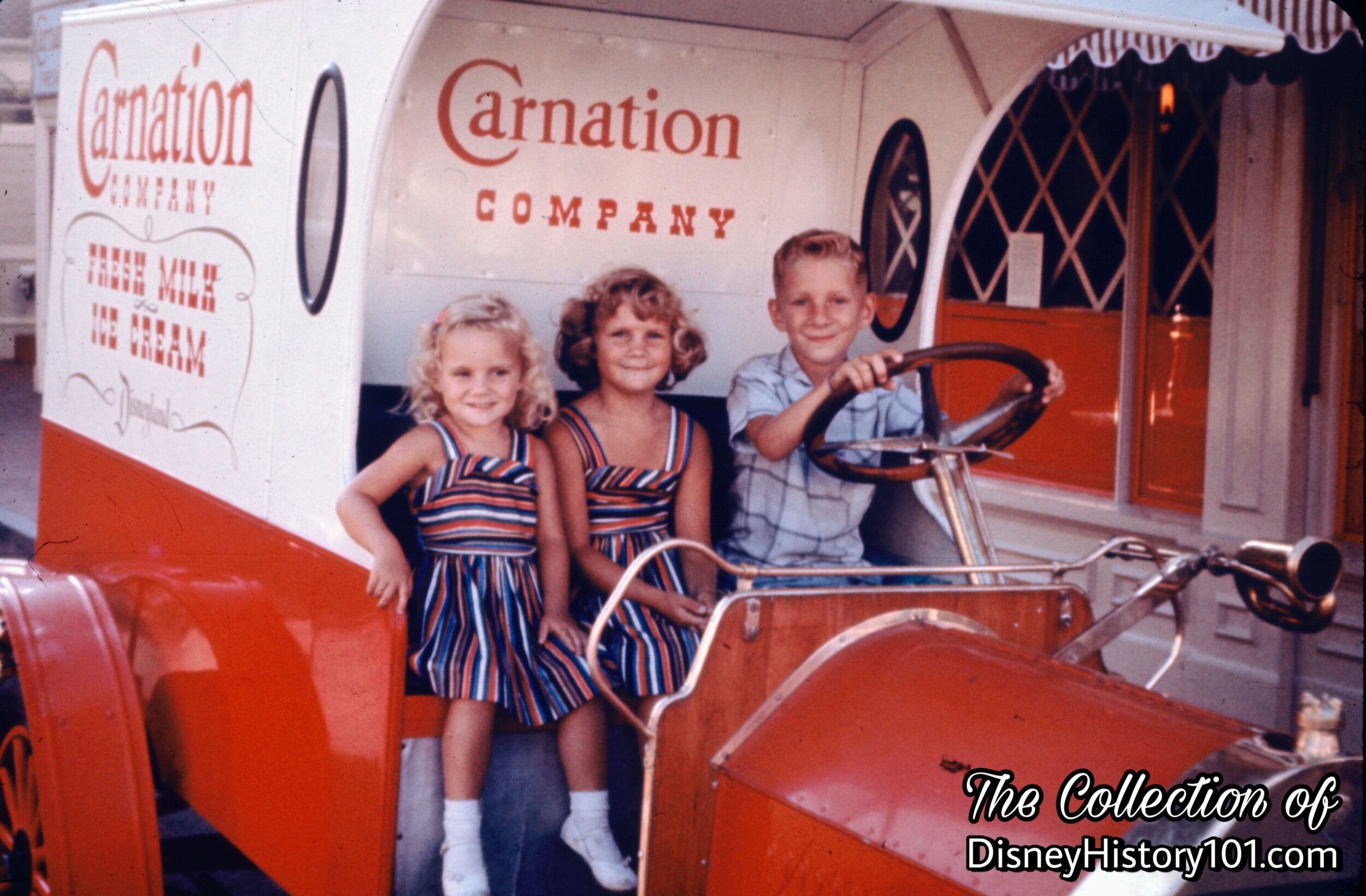
Carnation Company Truck Exhibit
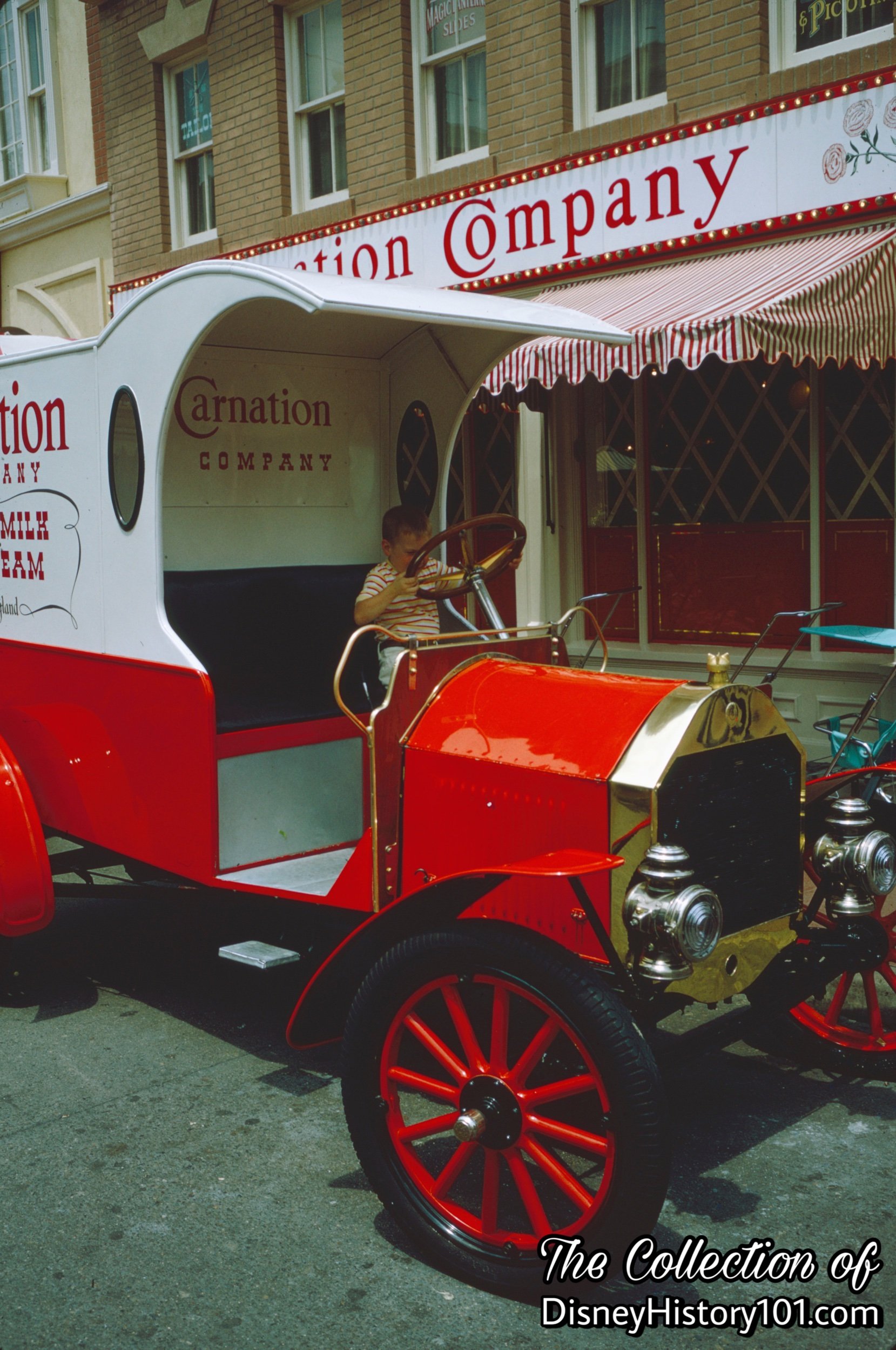
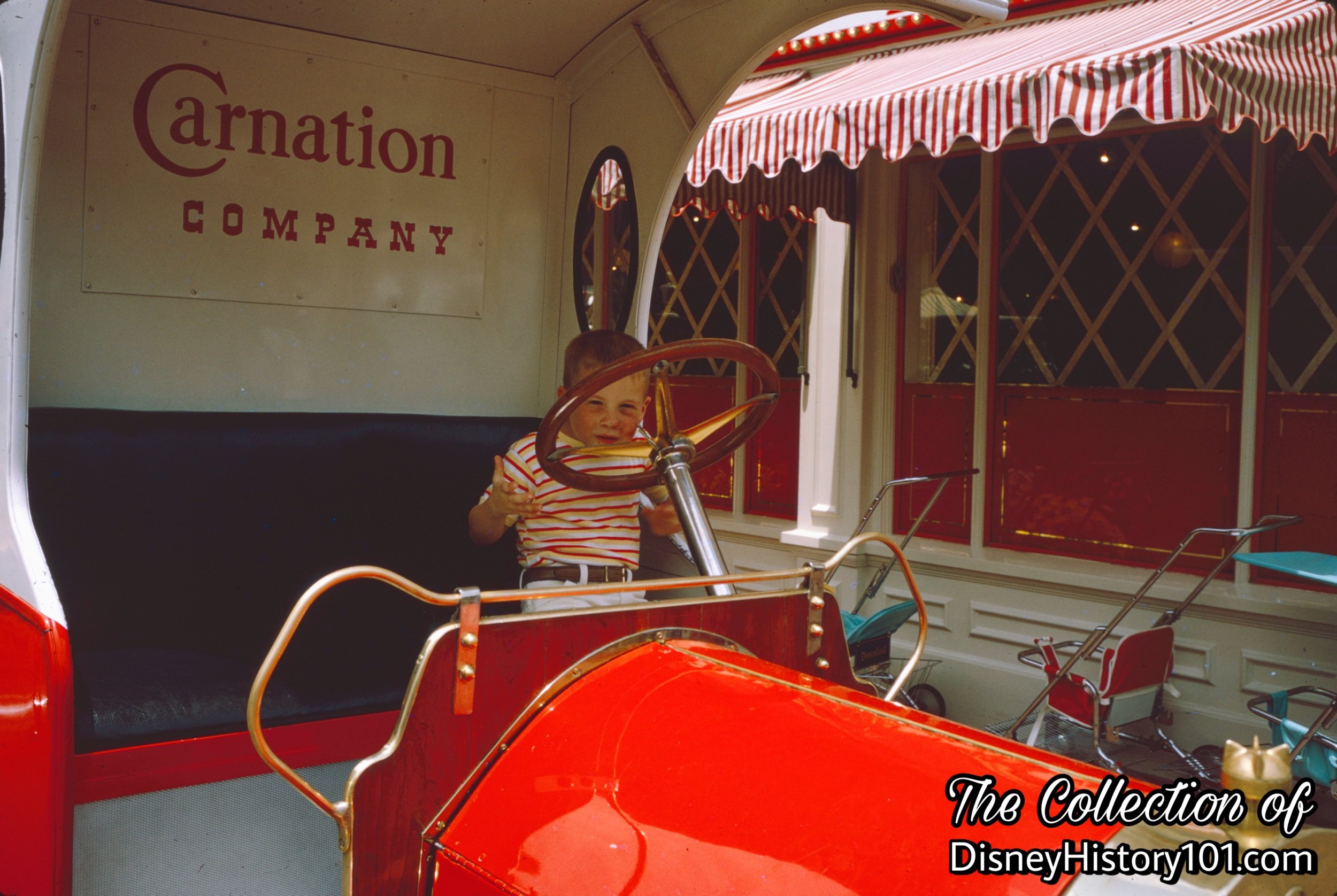
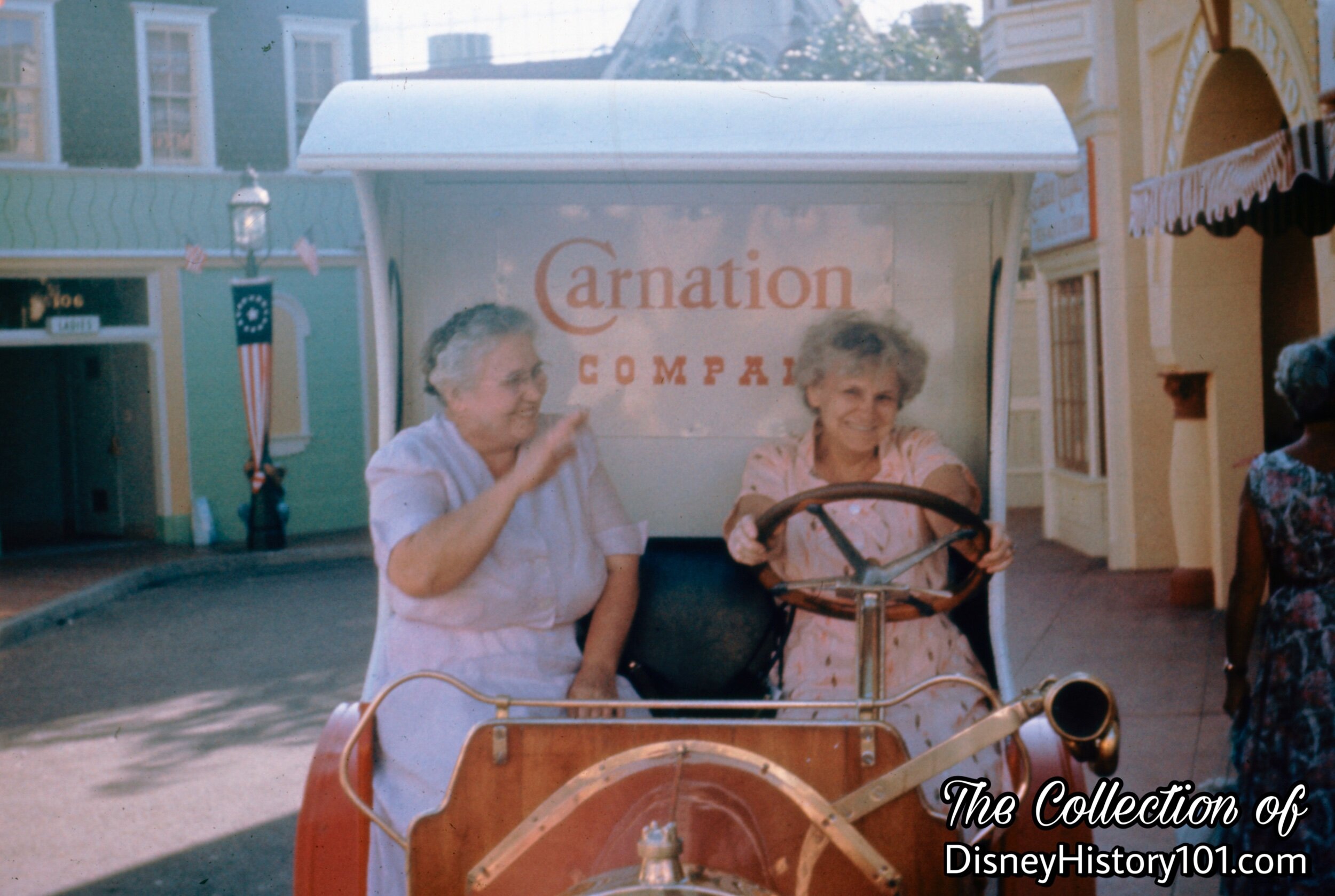
Carnation Company Truck Exhibit
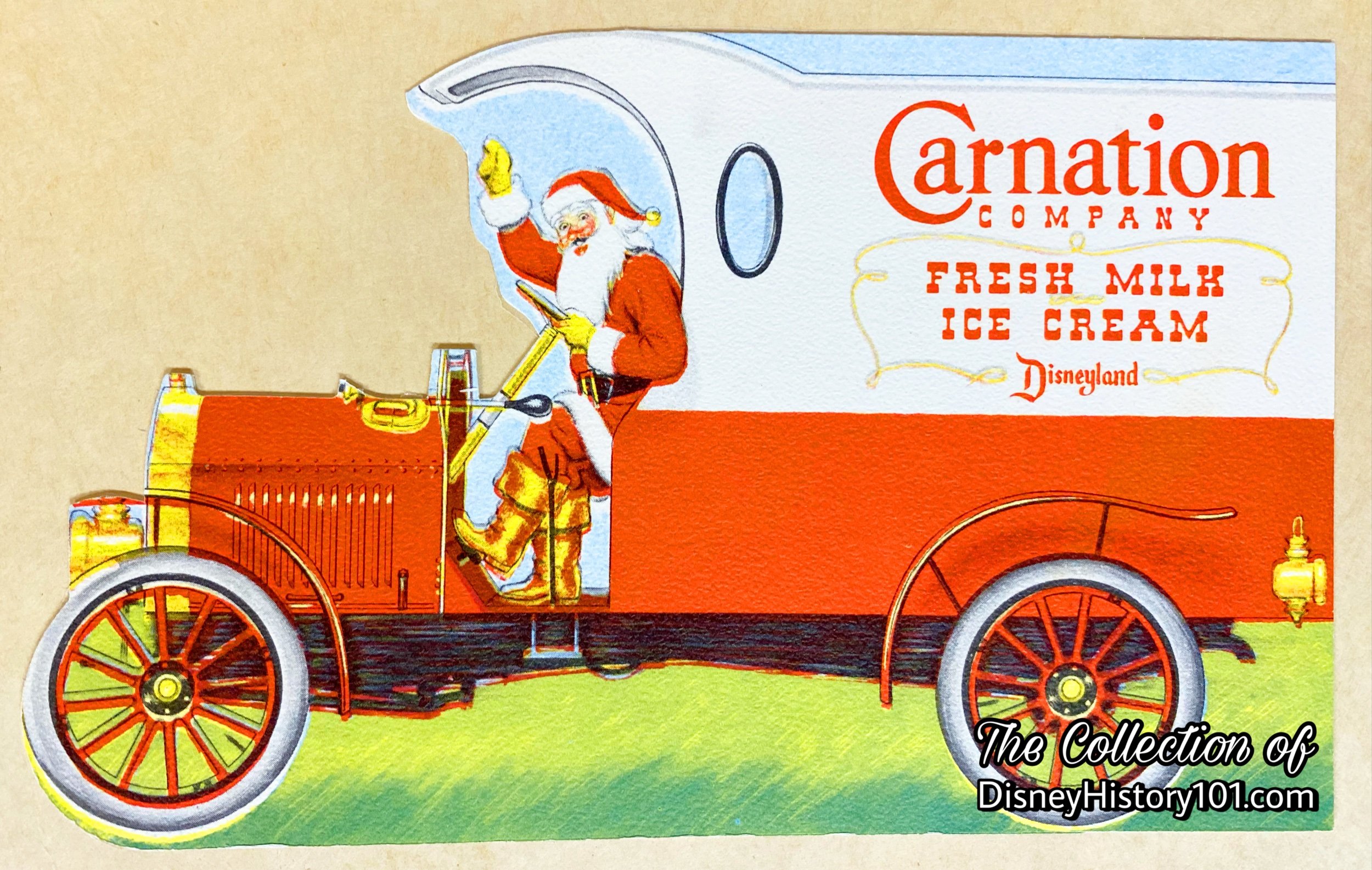
Carnation Company Christmas card.
The Carnation Co. contributed food to the First Annual Disneyland Christmas Party on December 10, 1956.
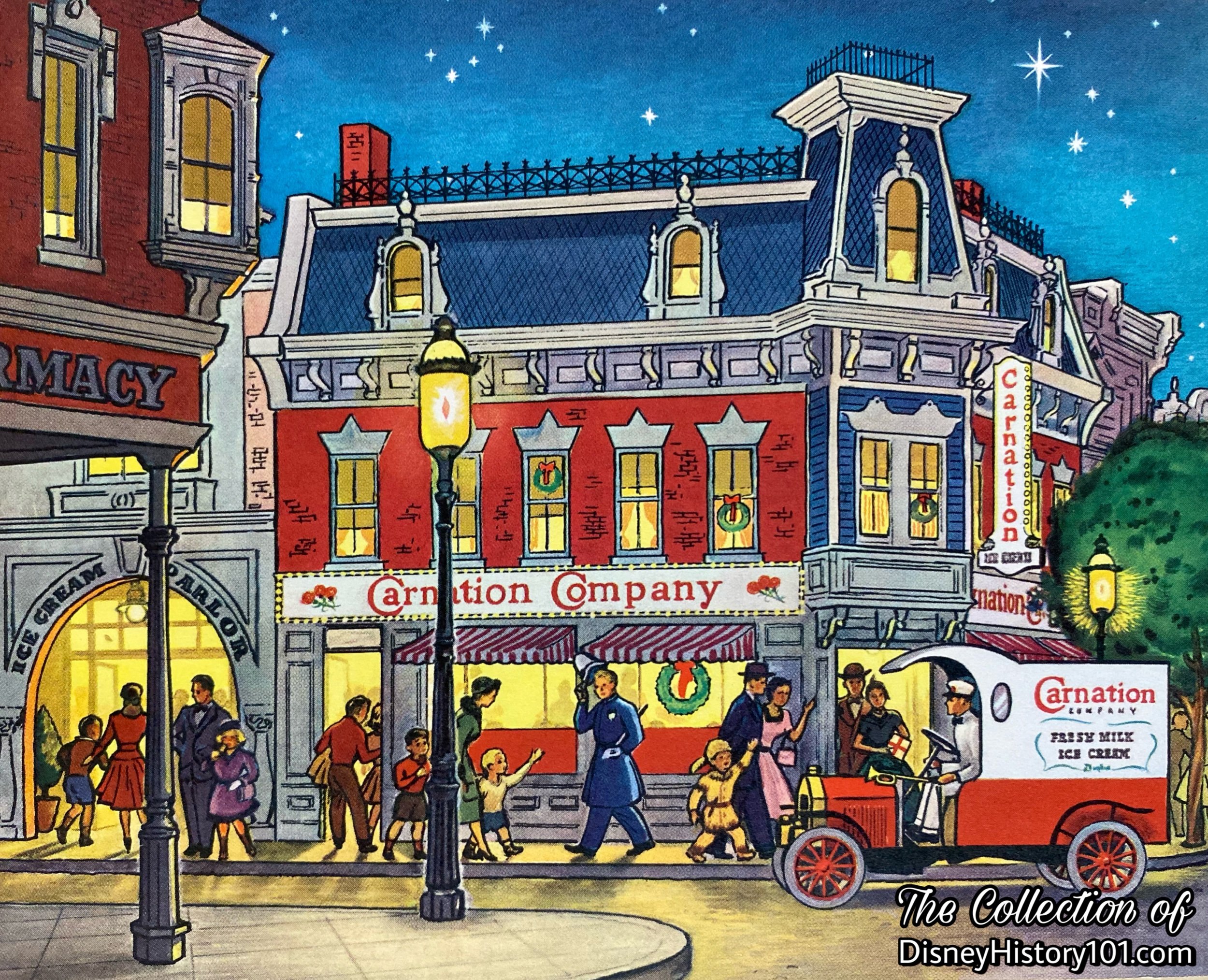
Carnation Company Christmas card.
Many Disneylanders would serve as Hostess like Mary Alice Duncan.

Carnation’s Ice Cream Parlor was notably mentioned in “Disneyland 1st Anniversary Souvenir Pictorial”
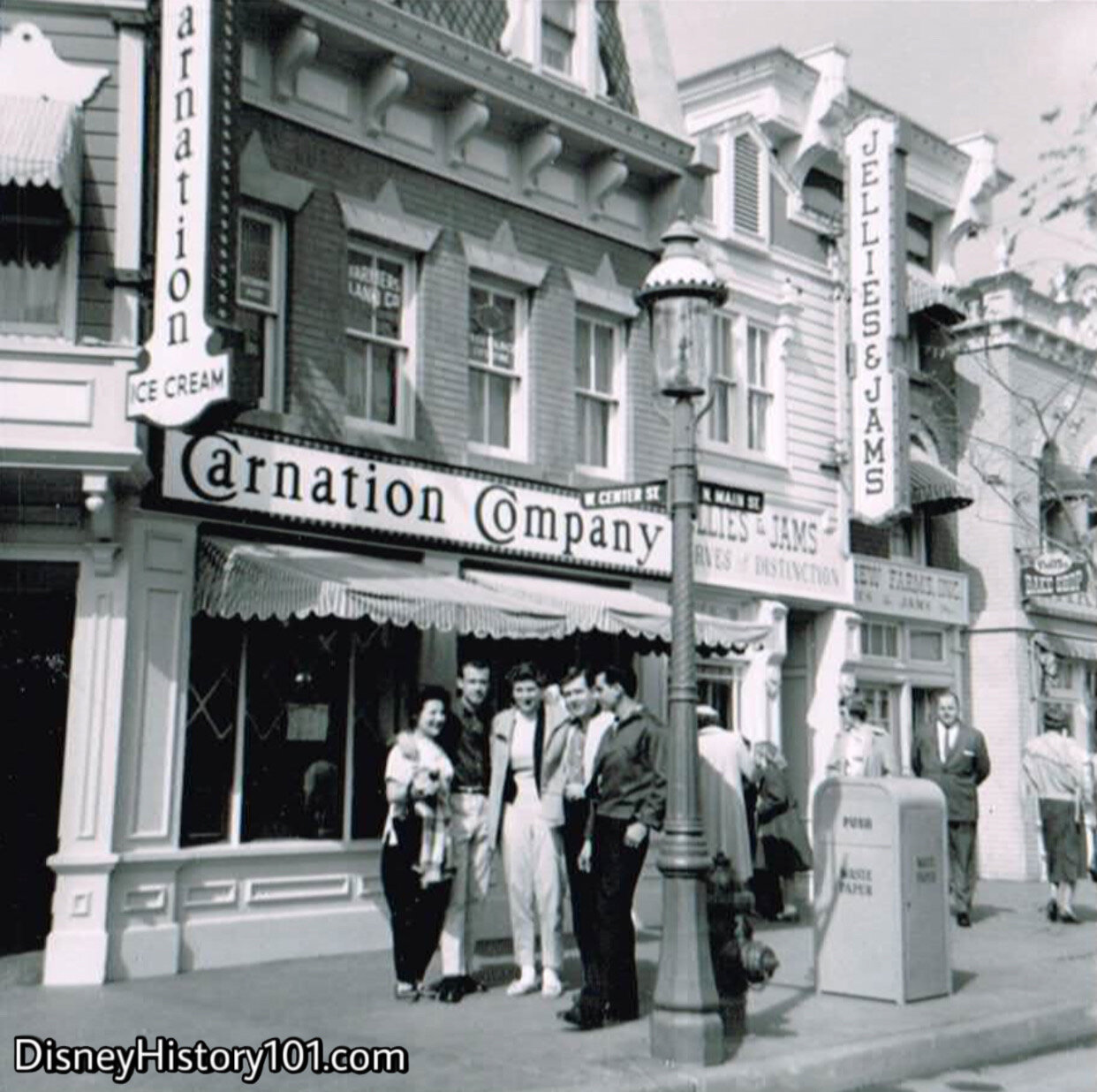
Carnation Cafe, 1957.
The corporate synergy was good for a time. Institutional lessee Carnation Company Ice Cream Parlor yielded some revenue for Disneyland Inc. - $30,329 for the fiscal year ending September 29, 1957 and $33,440 for the fiscal year ending September 28, 1958. In addition commercial lessee Carnation Company Ice Cream Cone Bar yielded $4,059 for the fiscal year ending September 28, 1958.
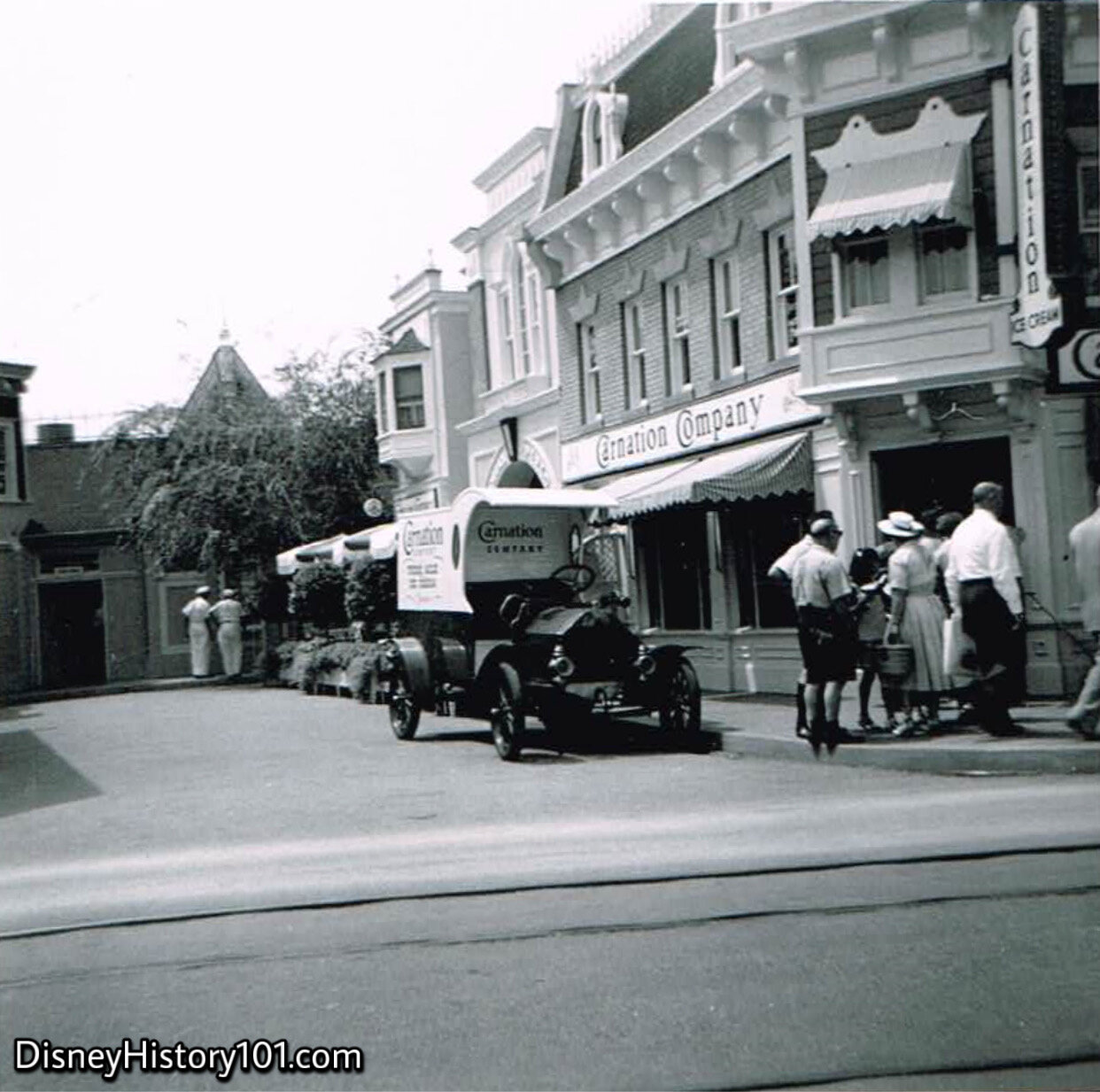
Carnation Company and Carnation Company Truck, September, 1958.
Earlier that year (during April of 1958), Carnation helped Disneyland Guests celebrate Dairy Day!
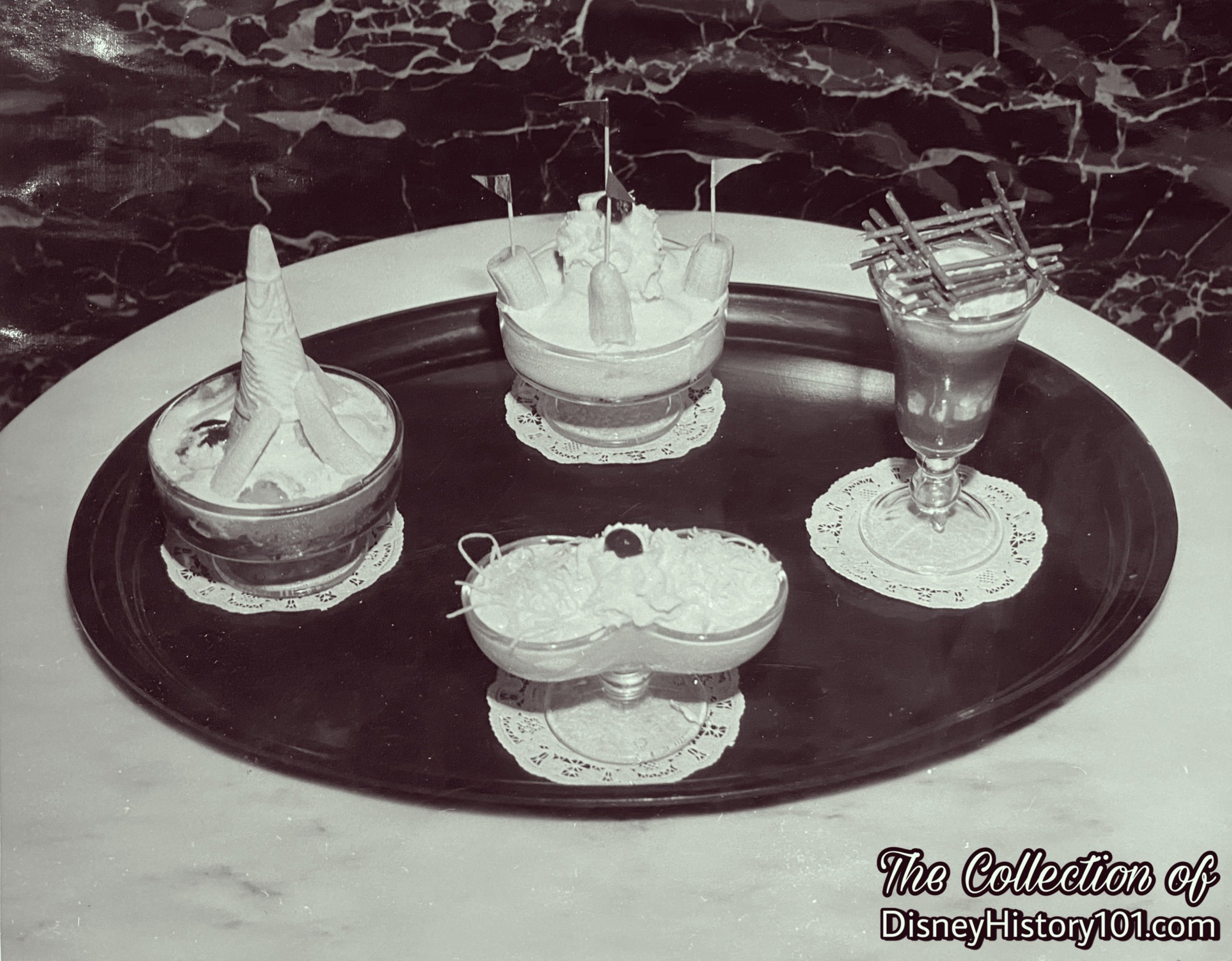
As far back as 1955, such“Disneylandish delights as a Mad Hatter Sundae, Amazon Special, Old Timer, and T.W.A. Rocket Ship Special” were offered at the counter, according to KEY Magazine, 1955. Some were Character themed like the Snow White Sundae, while others were themed after the character of lands - Amazon Special, the Main St. Victorian Banana Split and the Lover's Delight, and the TWA Rocket Ship Special (four scoops of ice cream, an ice cream cone, cherry sundae topping and whipped cream).
On July 28, 1955, Disneyland received a visit by Cal Farley (of Texas) and his group of 200 Boys Ranchers (comprised of boys from 42 different states and three foreign countries). They enjoyed the Carnation Cafe’s Santa Fe Special (Three scoops of ice cream, smothered in three different fruit syrups, with sugar water and fresh sliced bananas on the side and topped off with marshmallows and whipped cream).
Through the years, other deserts were inspired by adventures at Disneyland. During the 1960s, guests may remember the delicious Carnation “I Scream Sundae” inspired by Disneyland’s Haunted Mansion.
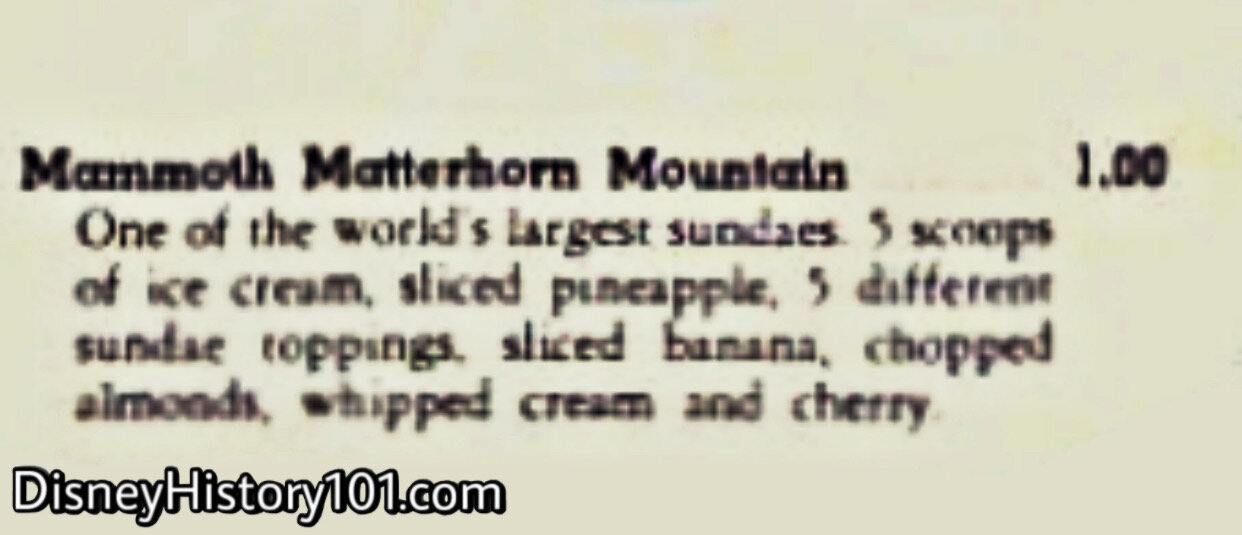
“Spectacular New Adventures in ‘Fancy Sundaes - circa 1959’”
Guest Pat Nolan vividly remembers the debut of this monumental menu item : “My brother ordered - and finished the Matterhorn Mountain Special on the day the new ride was opened. It had 13 scoops of various flavors of ice cream and sherbet. I resisted and merely enjoyed a delicious banana split. We were there as a prize for Los Angeles Herald paperboys.”
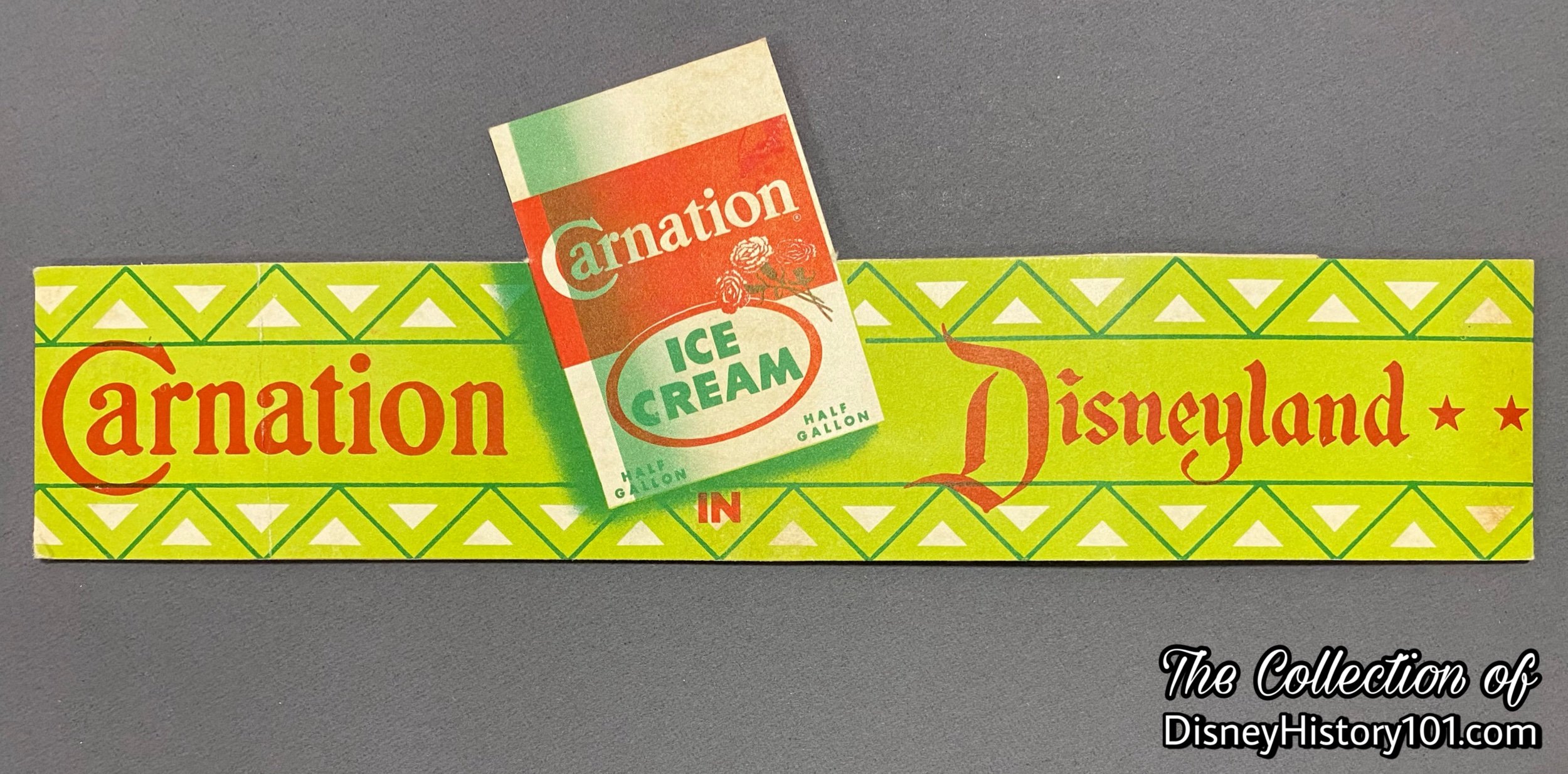
Disneyland Carnation Ice Cream souvenir headband.
A merchandise was a tangible memory for a Guest.
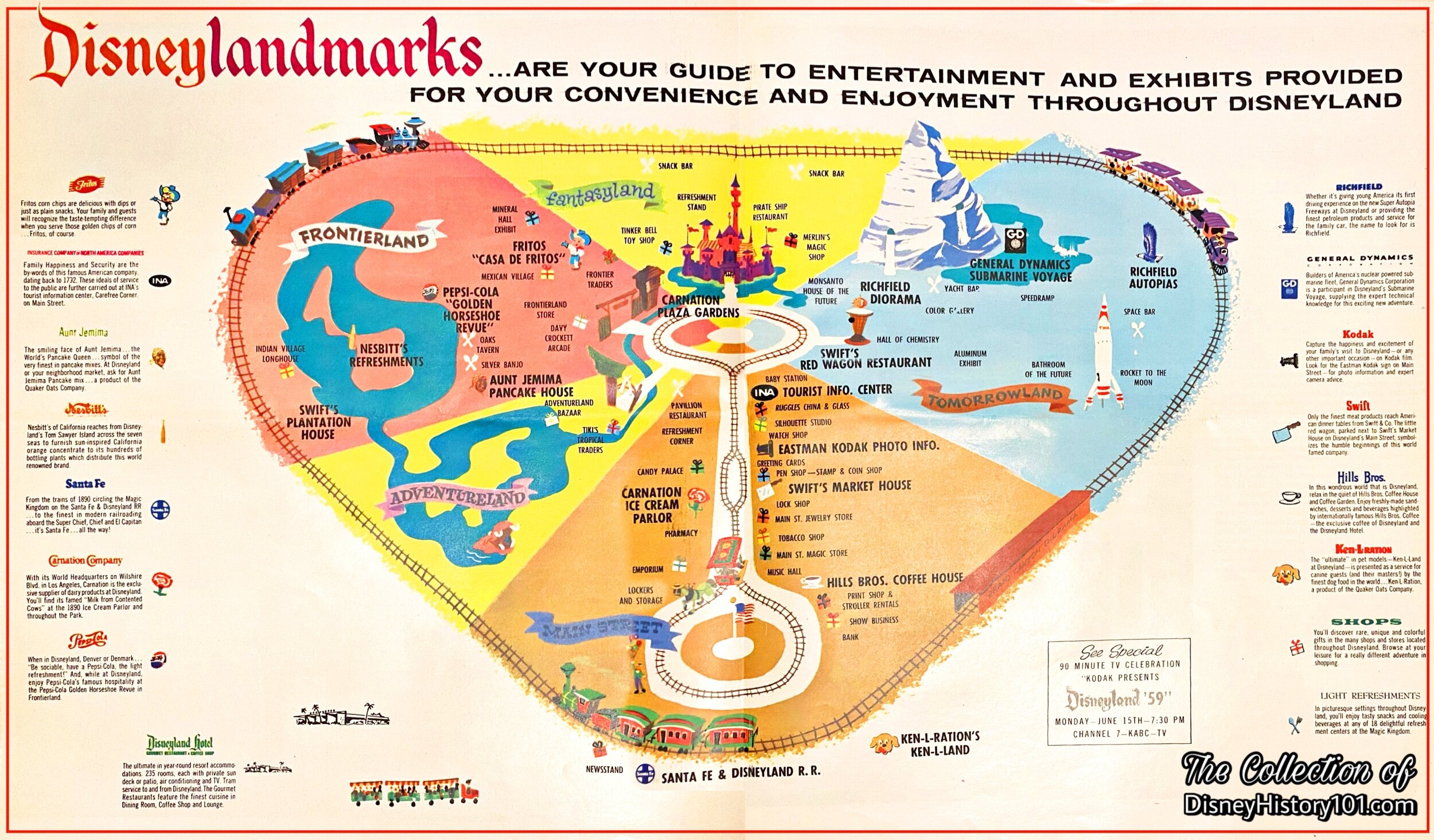
"Disneyland '59 Insert", 1959.
By 1958, Carnation had a definite presence at Disneyland. By January 1, 1958, appraisers took note of the 1,672 square foot Carnation Ice Cream Parlor (with its additional 274 square-foot rear storage), the 186 square foot Carnation Cone Bar, and the 216 square foot Carnation Side Walk Cafe (an exterior area also occupied by the lessee; similar to the contemporaneous, 312 square-foot Coca-Cola Side Walk Cafe). The lessee nearly occupied the most square footage of the 8,833 square foot Main Street Building #400.
By September of 1958, Carnation was also contributing a routine portion of accounts receivable to Disneyland, Inc.
Owning to Jack Sayers (of Lessee Relations), Carnation Farms was a contributing Participant in Disneyland ‘59! The first Disneyland Dictionary (printed in October of 1959) noted Carnation Ice Cream Parlor operated by Carnation Company served “Carnation ice cream in every form, and lunches.“ By October of 1959, the company was (1) of over sixty-eight other firms playing a vital part in the team effort to bring happiness to Disneyland’s Guests. Some were small, specialized individual operators; some were huge companies such as Swift & Co. - the Bank of America - United Paramount Theaters (which you hear as UPT) - Carnation - Richfield - General Dynamics - Crane - and many others. These companies used the park to publicize their wares, leased space in the Park to sell their wares, and Disneyland collected advertising fees from them.
As a sidelight, by October 1959, Jim Baker (of Merchandising) was overseeing the Disneyland Food Administration and Souvenir Sales. By that same year of 1959, of the total income received by Disneyland, Inc. from leases, 16.02% was derived from the selling of advertising rights and 40.12% from the leasing of space to concerns whose main reason for occupancy is for advertising purposes. The remaining 43.86% of the lease income was derived from stores that sold various products and food. To celebrate what was billed as “Disneyland’s Second Opening,” Carnation Ice Cream Parlor carried new special themed menu options.
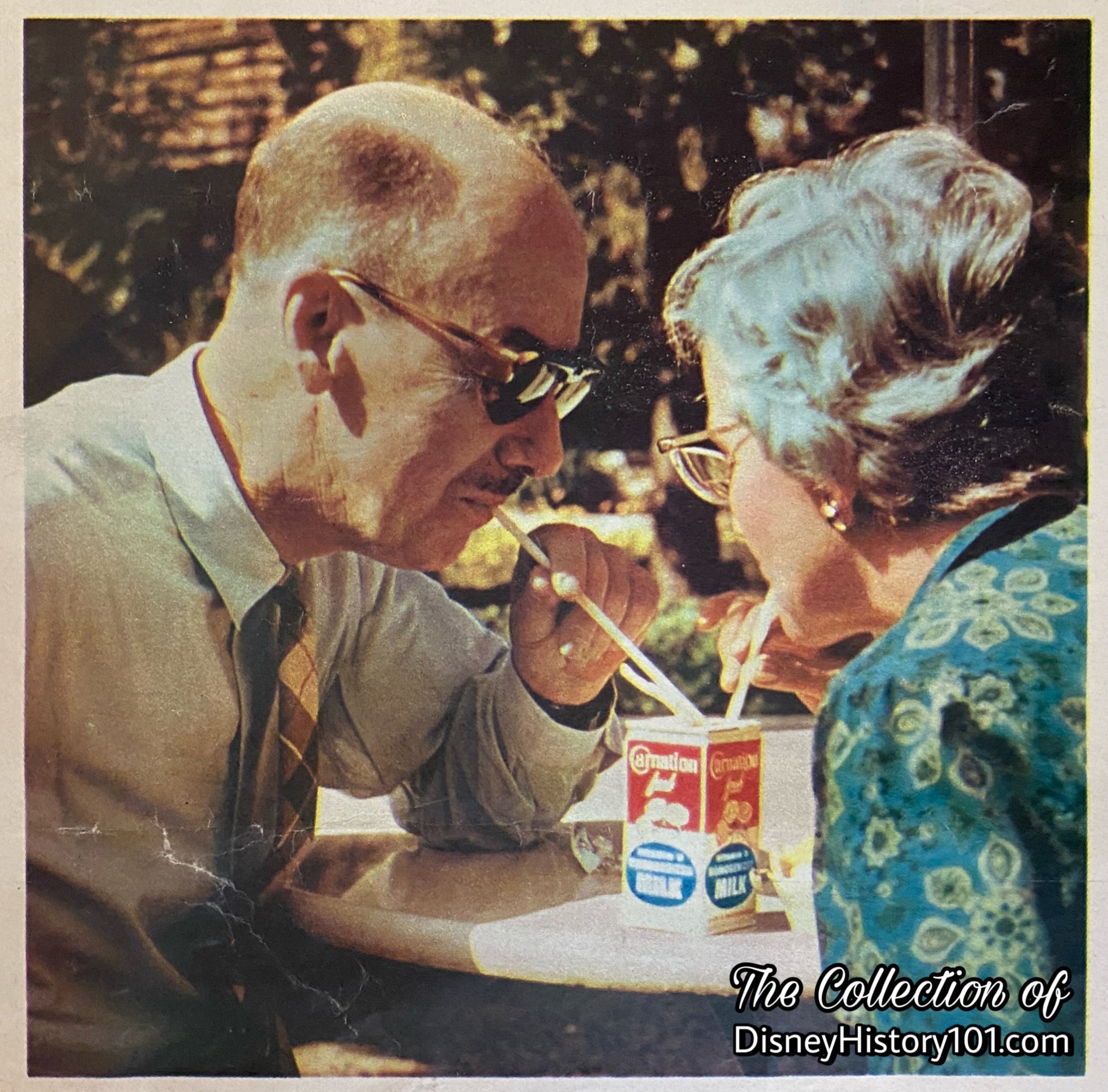
A couple enjoys Carnation as seen in “Disneyland Summer ‘59” Supplement Excerpt.
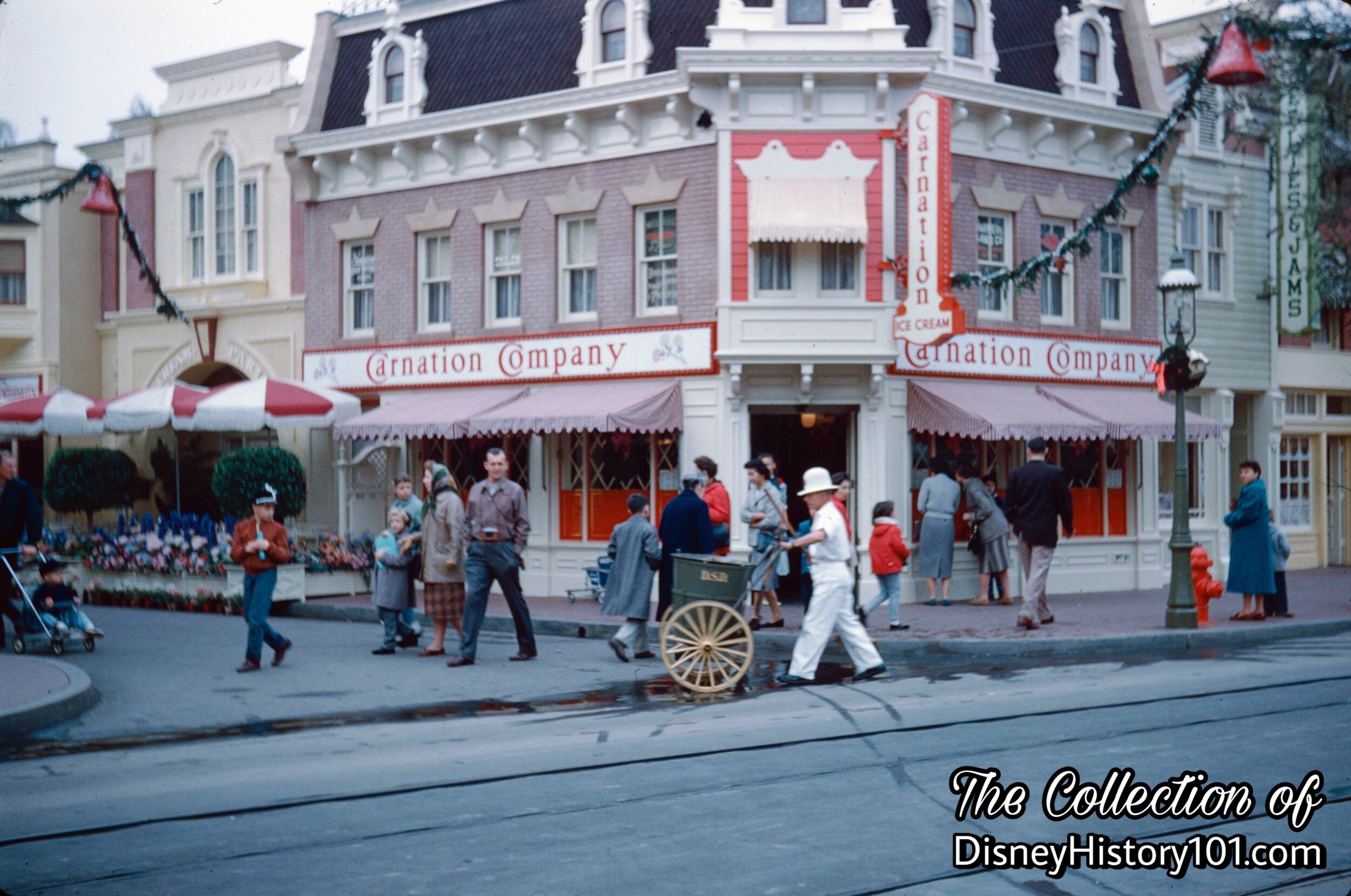
Carnation Company, Winter of 1959
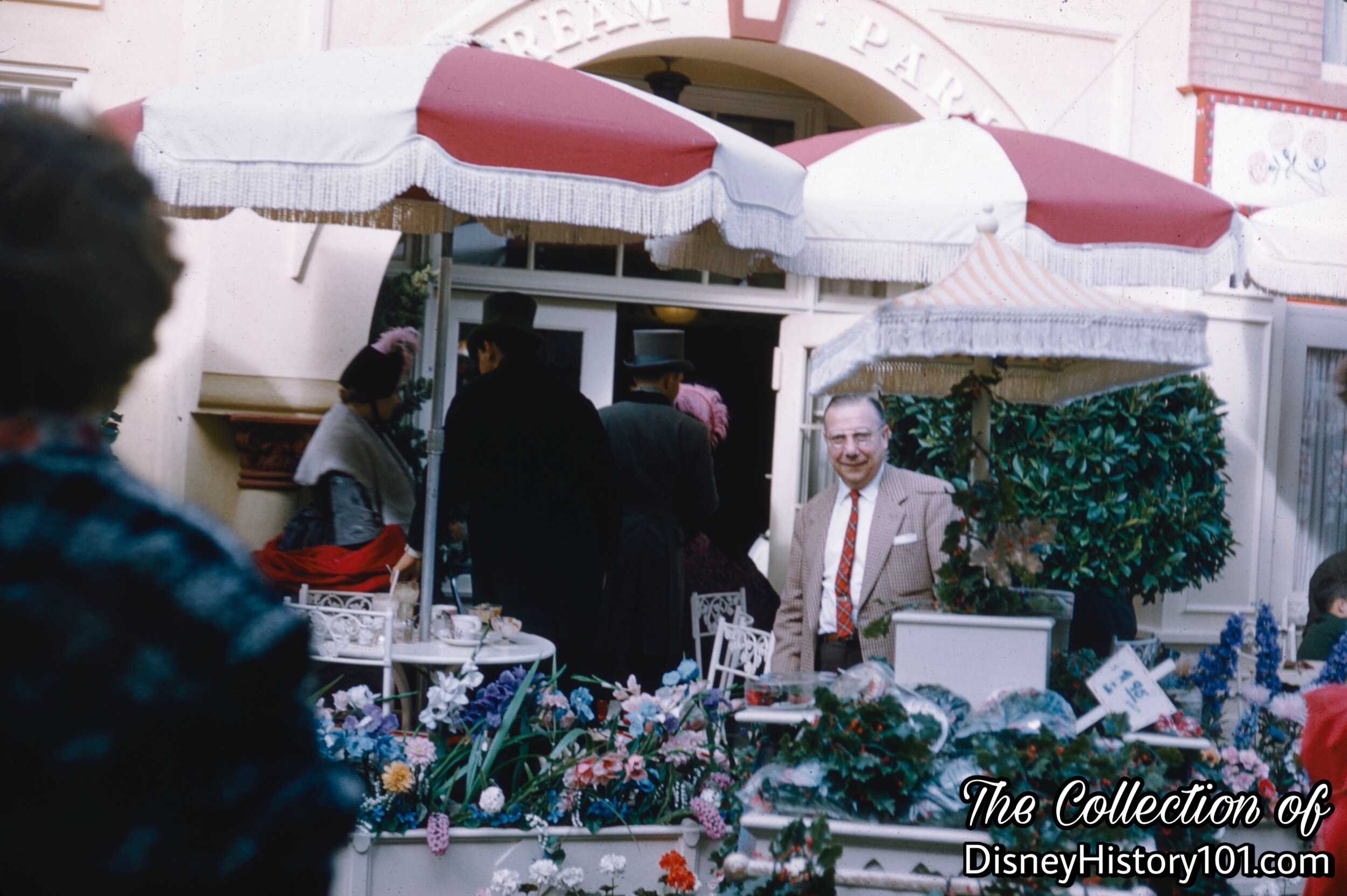
A few wandering carolers walk into Carnation Company, (Winter, 1959)
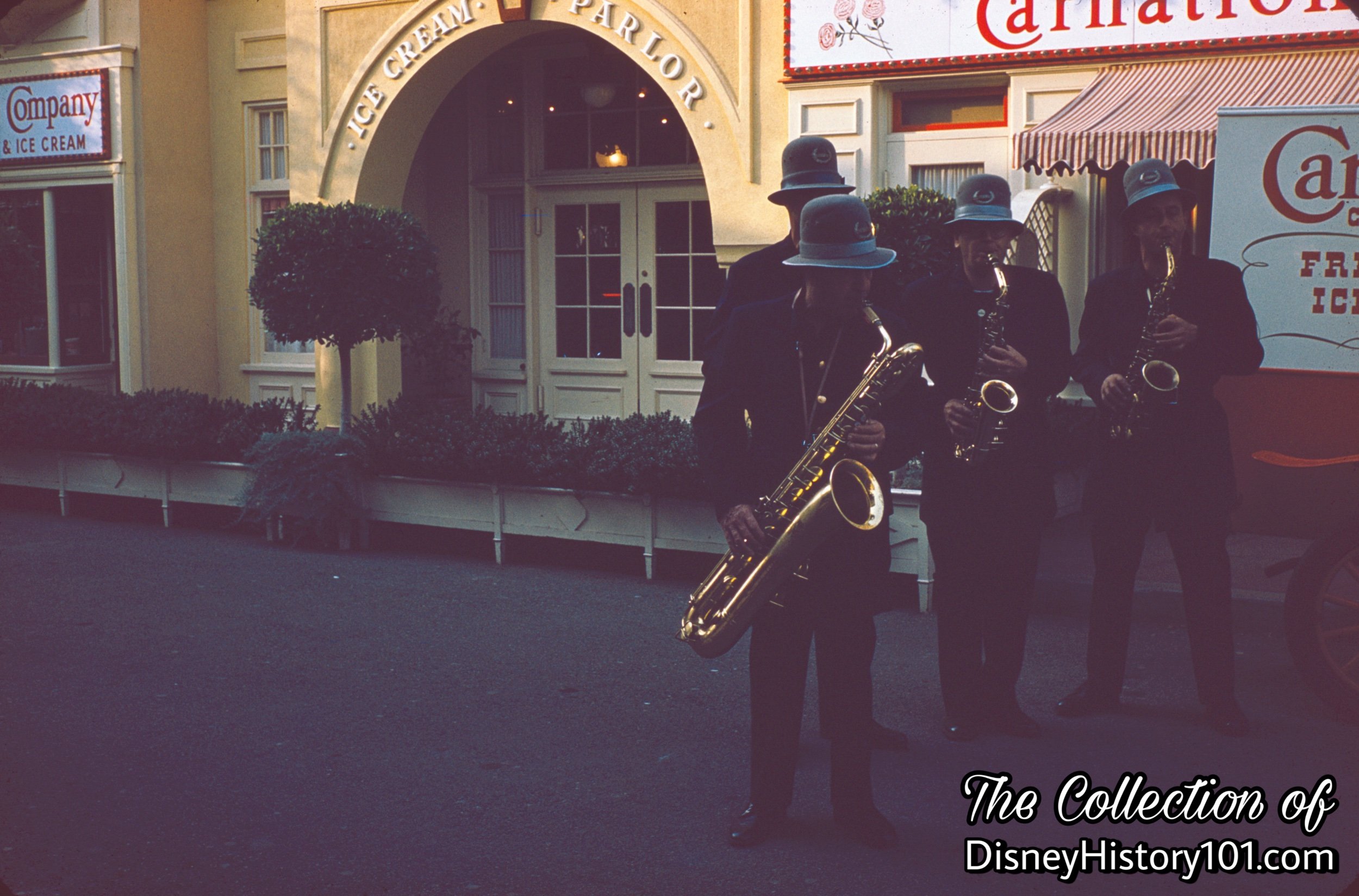
The sound of Saxophone Quartets could be heard near the Carnation Ice Cream Parlor entrance on West Center Street
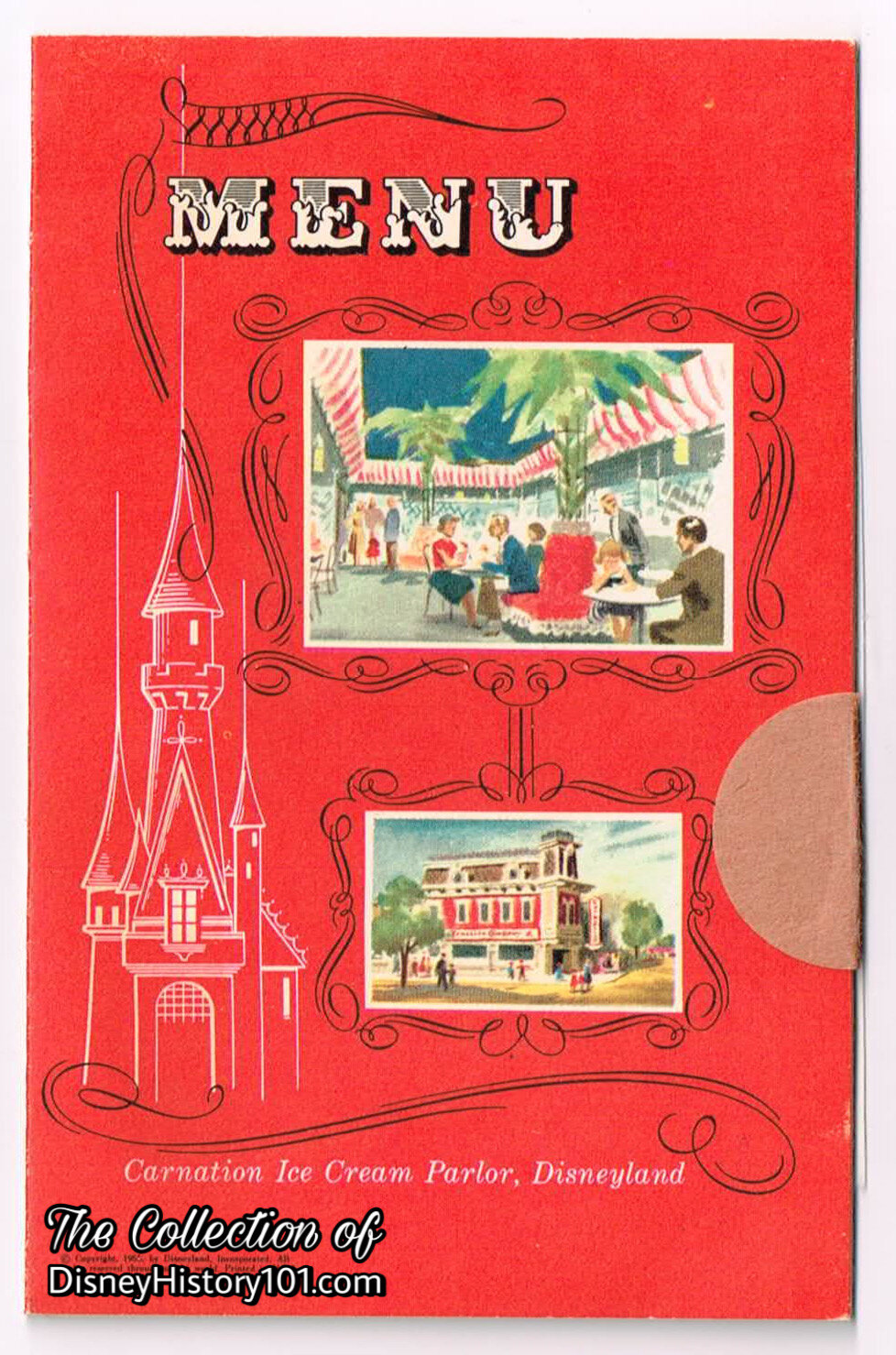
Carnation in Disneyland Souvenir Menu Postcard Cover
The main attractions were the “ice cream specialties” - giant sundaes and satin-smooth sodas, made with famous Carnation ice cream and fresh milk! Old timers would immediately note the phosphates, sarsaparillas, and parfaits! There were other traditional desert offerings on the menu, like the Lover’s Delight and the Banana Split. For those early morning visitors, breakfast was served until 11:30 a.m. Other menu items included hot and cold sandwiches, health food sandwiches, soup, salads, and beverages. In a move of corporate synergy, the Carnation Ice Cream Parlor was one of 16 Disneyland “eating places” which featured “fine food with fine coffee - Maxwell House!” In turn, “good coffee deserves Carnation,” and so Carnation products were offered at those 16 dining locations (including Maxwell Coffee House).

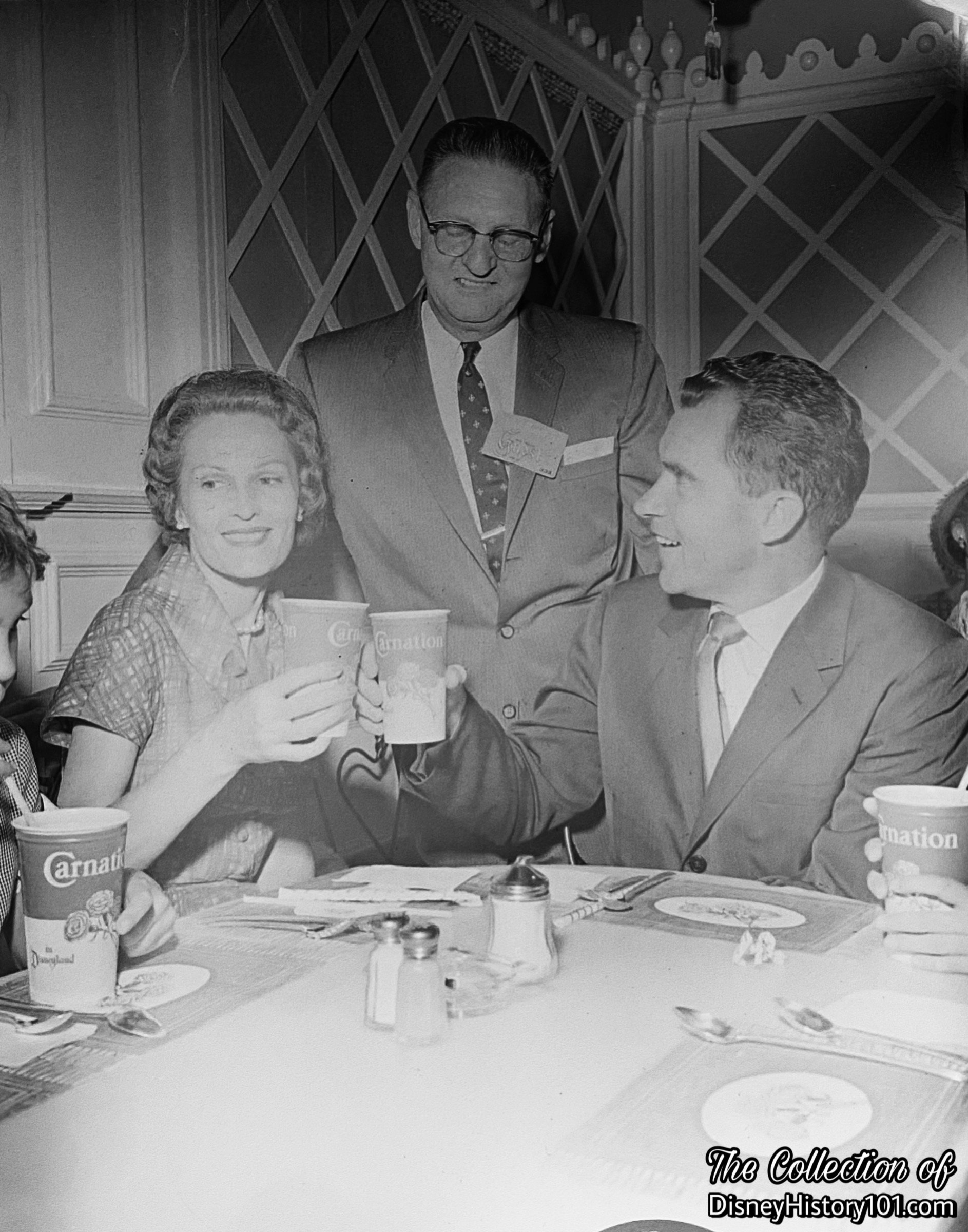
Then Vice President Richard Nixon and his wife and two daughters; residents of Whittier visit Disneyland, during the Park’s first summer.
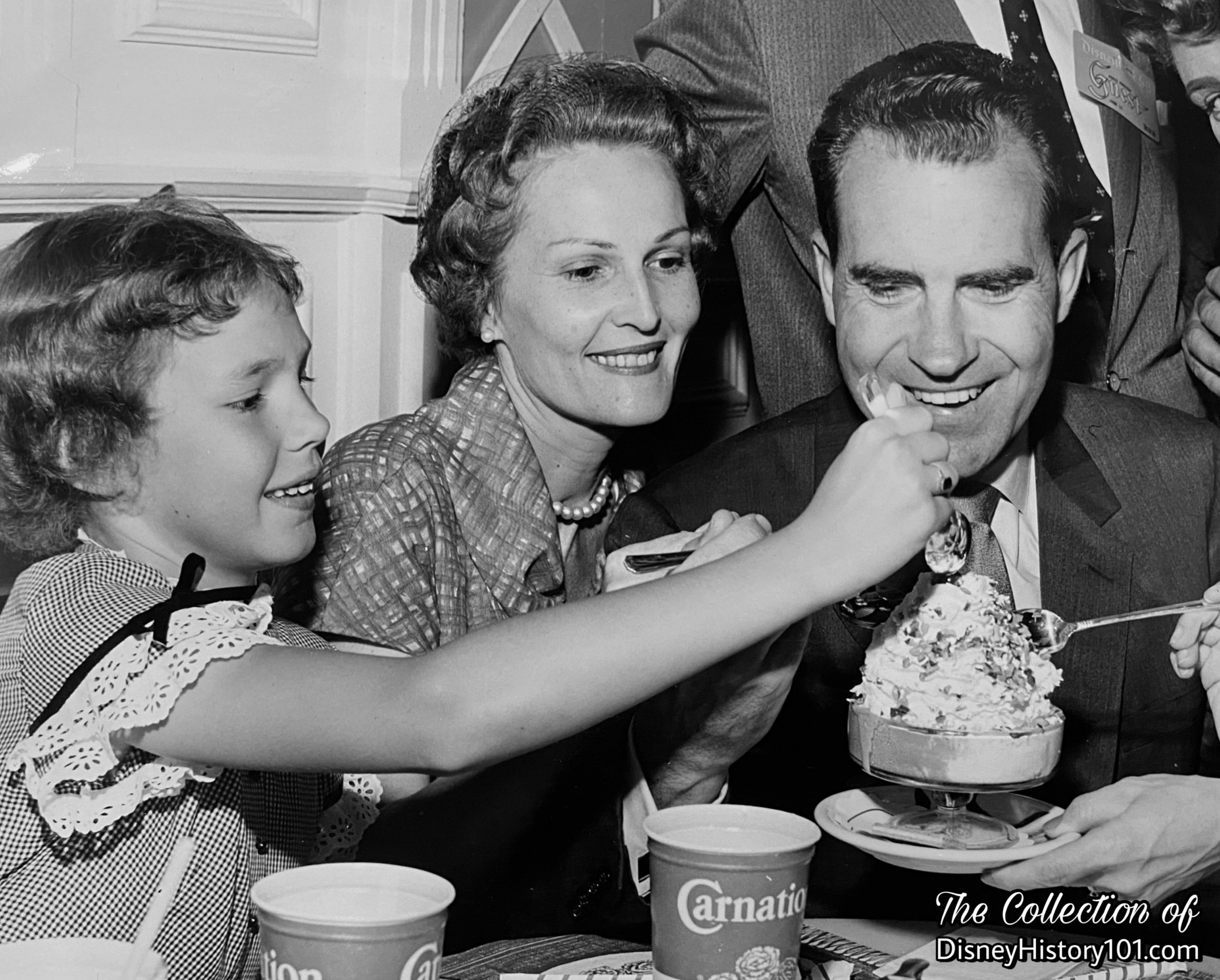
Then Vice President Richard Nixon and his wife and daughter Tricia; residents of Whittier visit “the Happiest Place on Earth,” during the Park’s first summer.
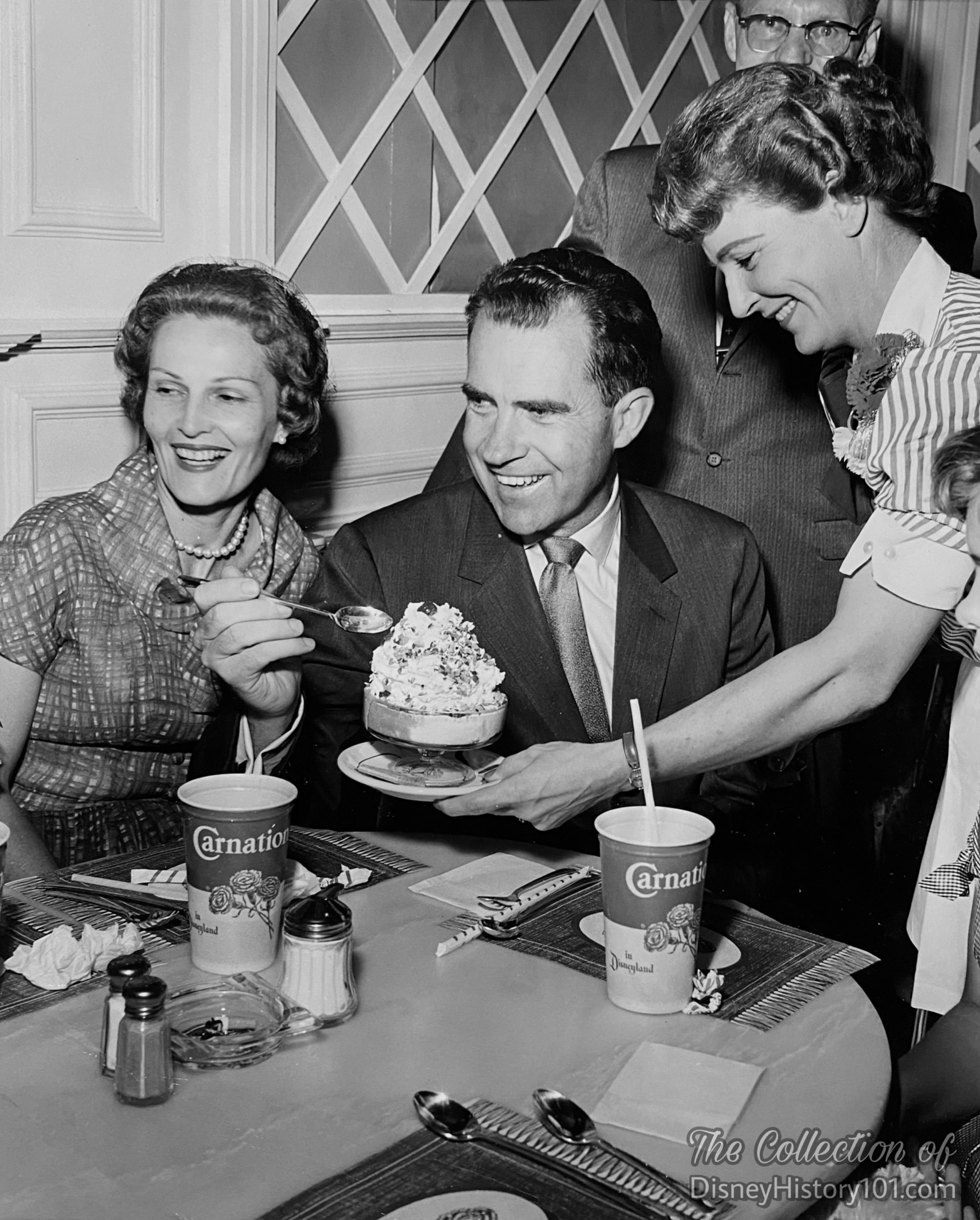
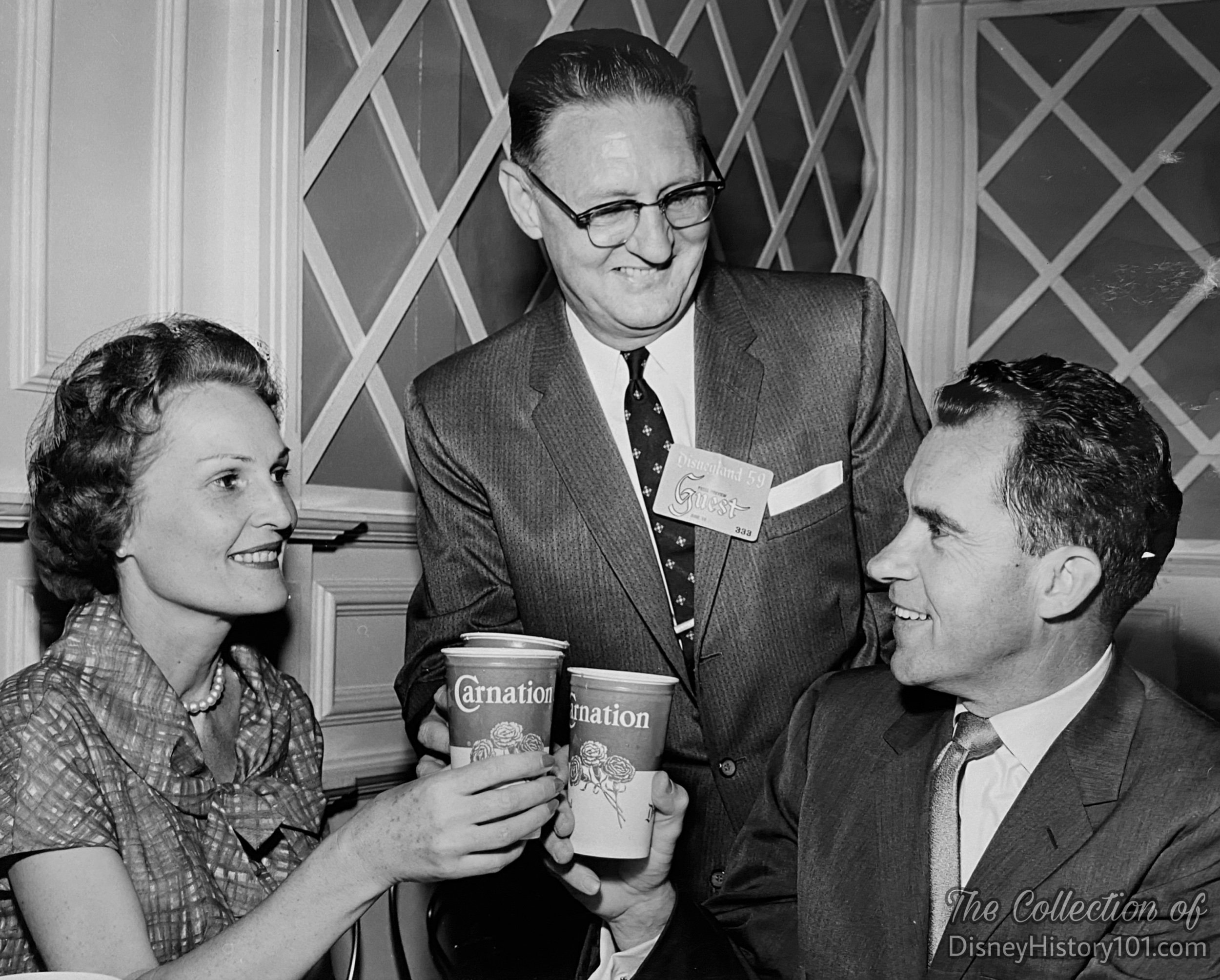
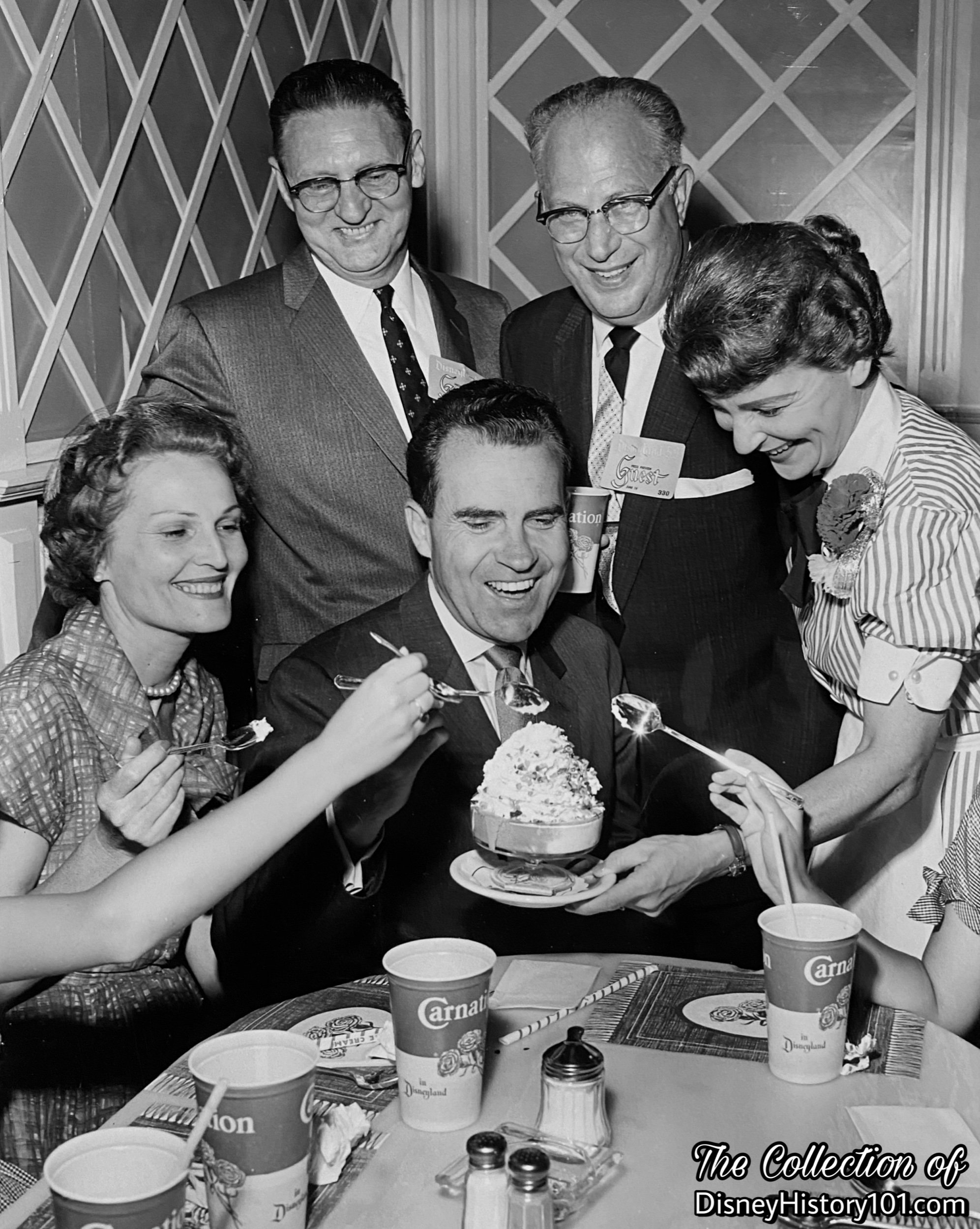
Then Vice President Richard Nixon and his wife and two daughters; residents of Whittier visit “the Happiest Place on Earth,” during the Park’s first summer.
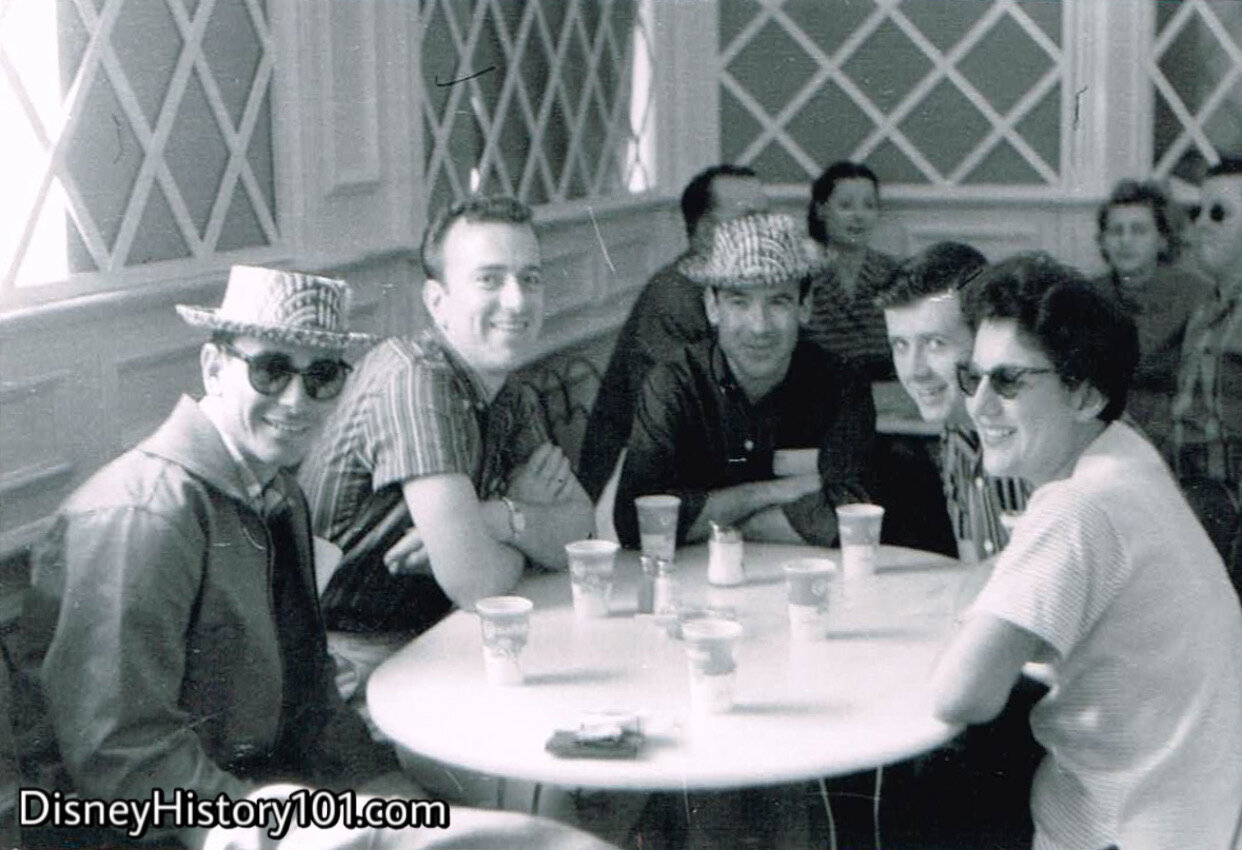
Guests Enjoy Carnation Refreshments at The Carnation Cafe
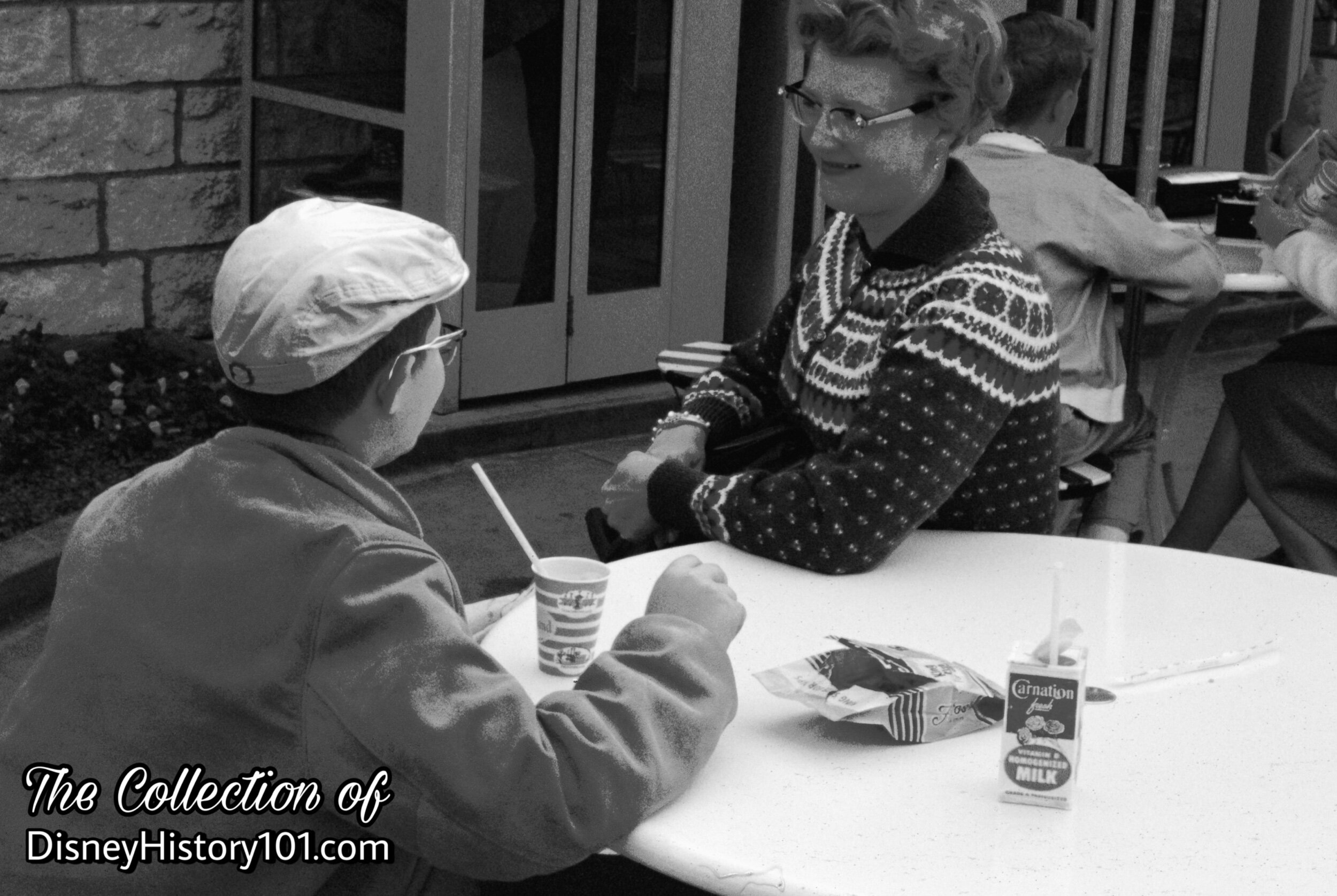
Guests enjoy Carnation products (like Vitamin D Homogenized Milk) at Fantasy Foods by UPT
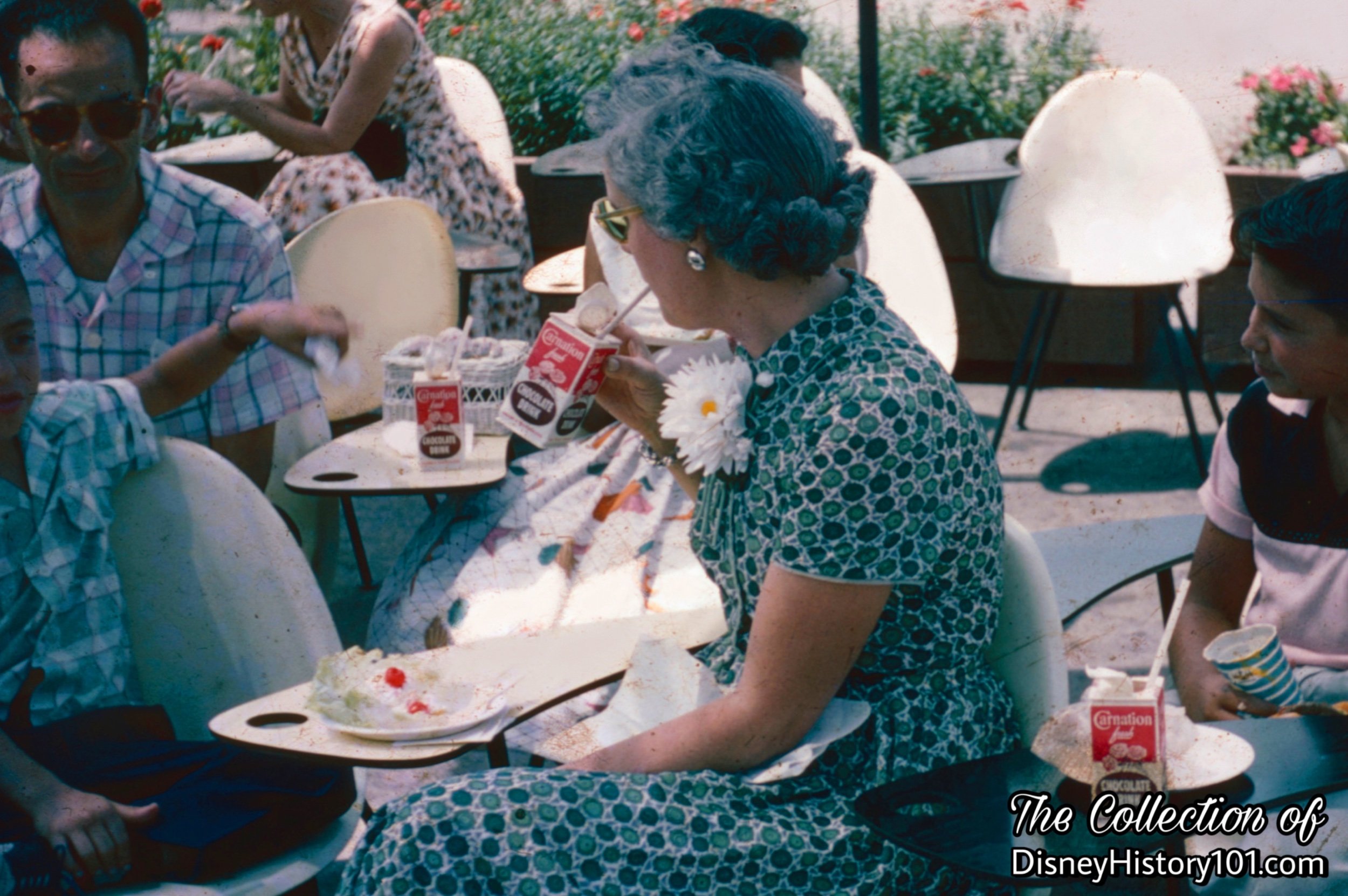
Guests enjoy Carnation at the Space Bar in Tomorrowland.
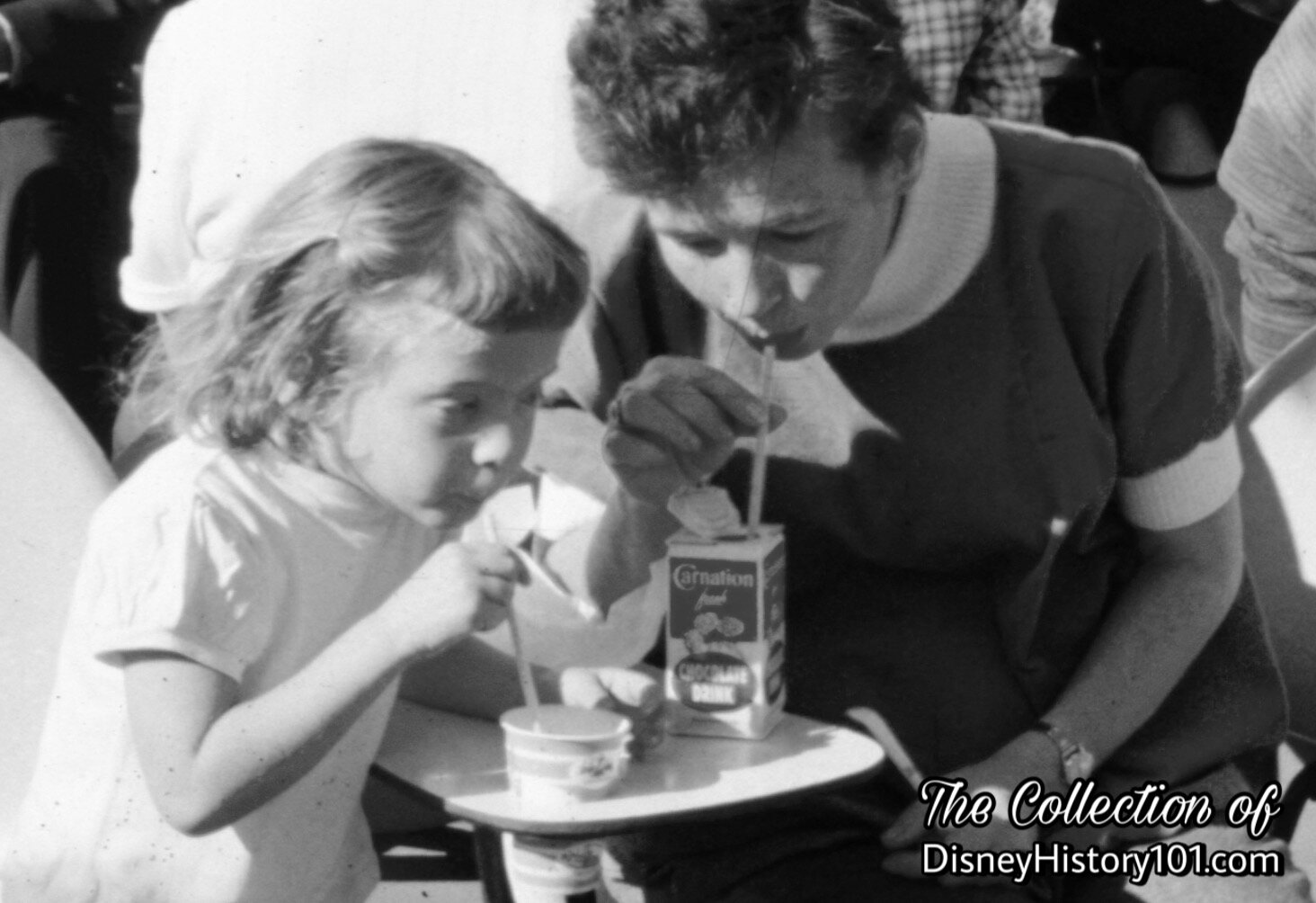
Guests enjoy Carnation products (like Chocolate Drink) at the Space Bar in Tomorrowland
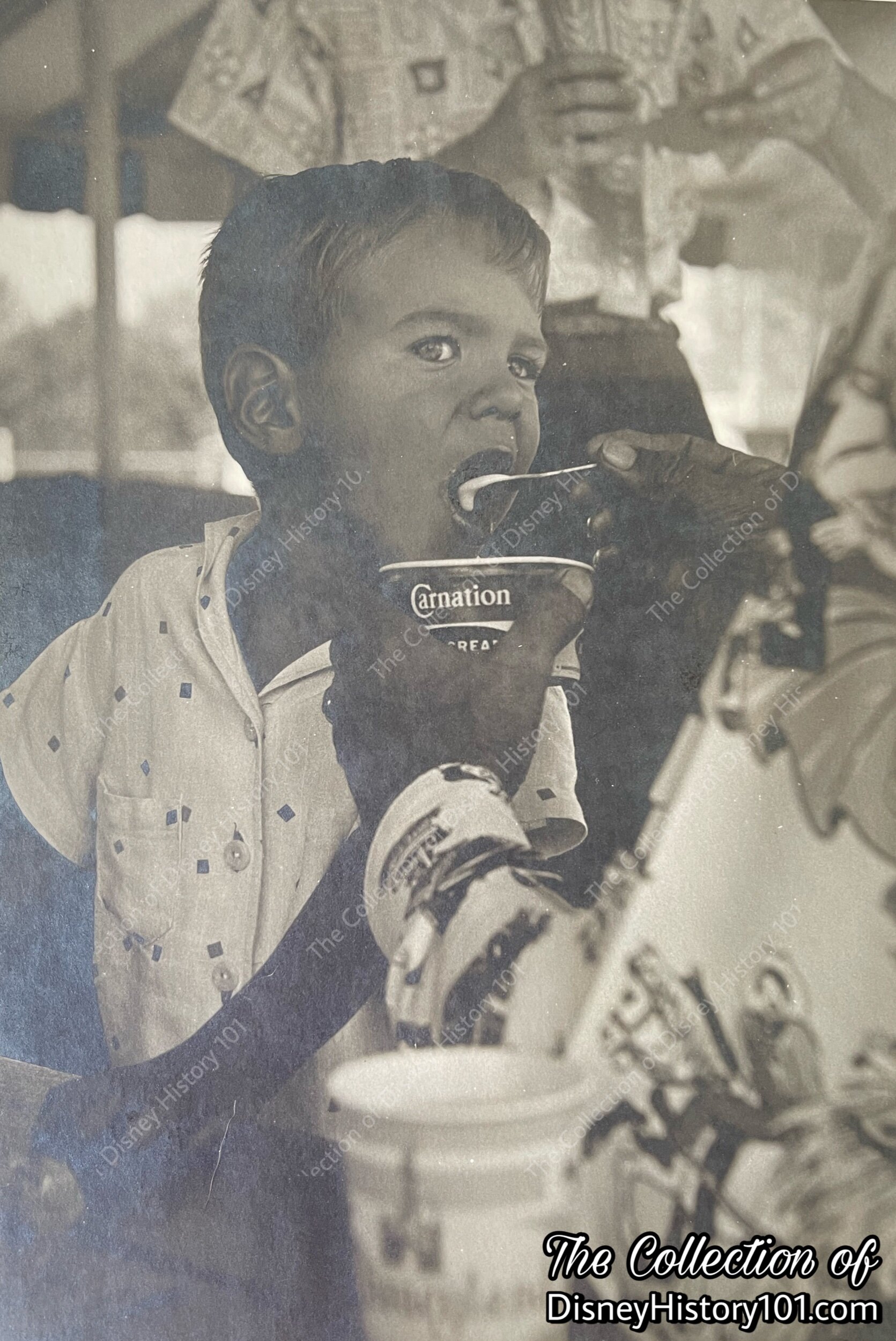
A Young Guest Enjoys a Carnation Ice Cream Under on of the candy-striped covers at Holidayland
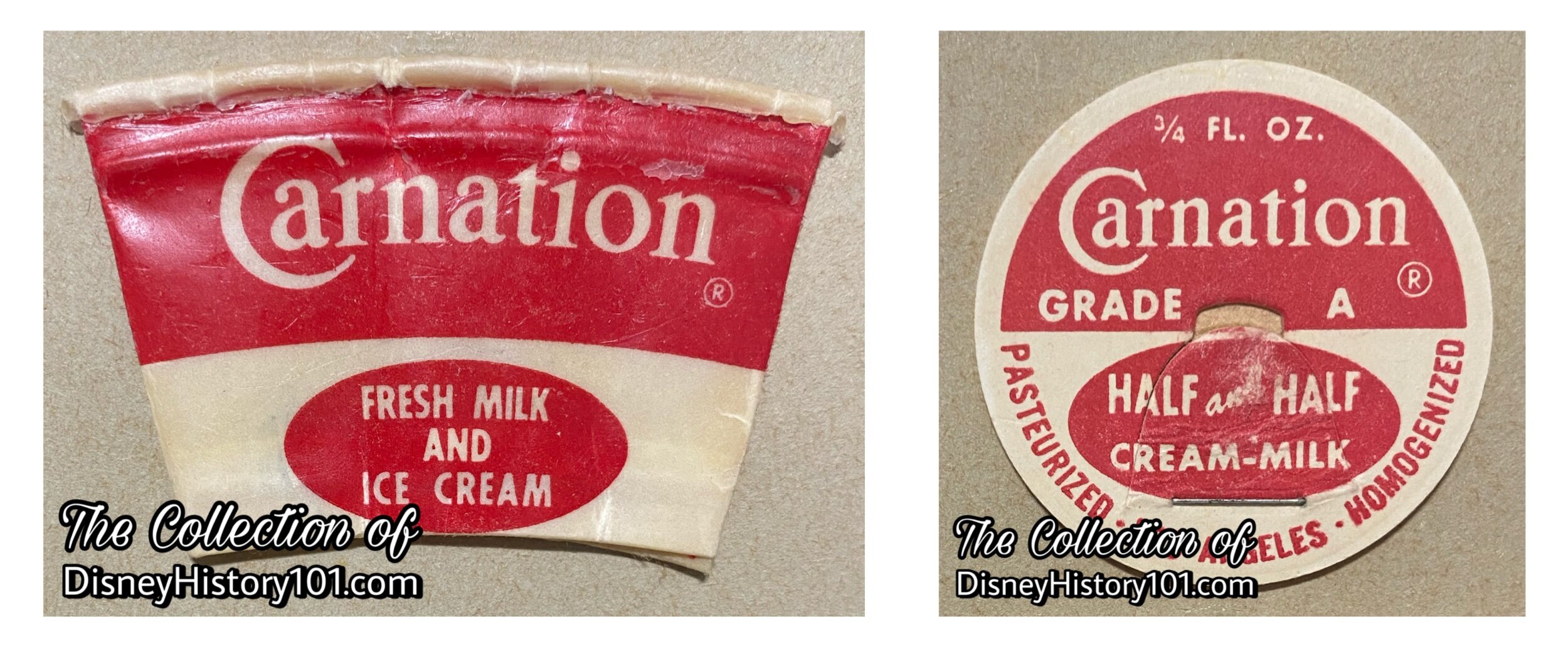
This Carnation Fresh Milk and Ice Cream 3/4 oz. Sample Cup was Acquired From the Carnation Truck at Disneyland and Preserved in a Scrapbook
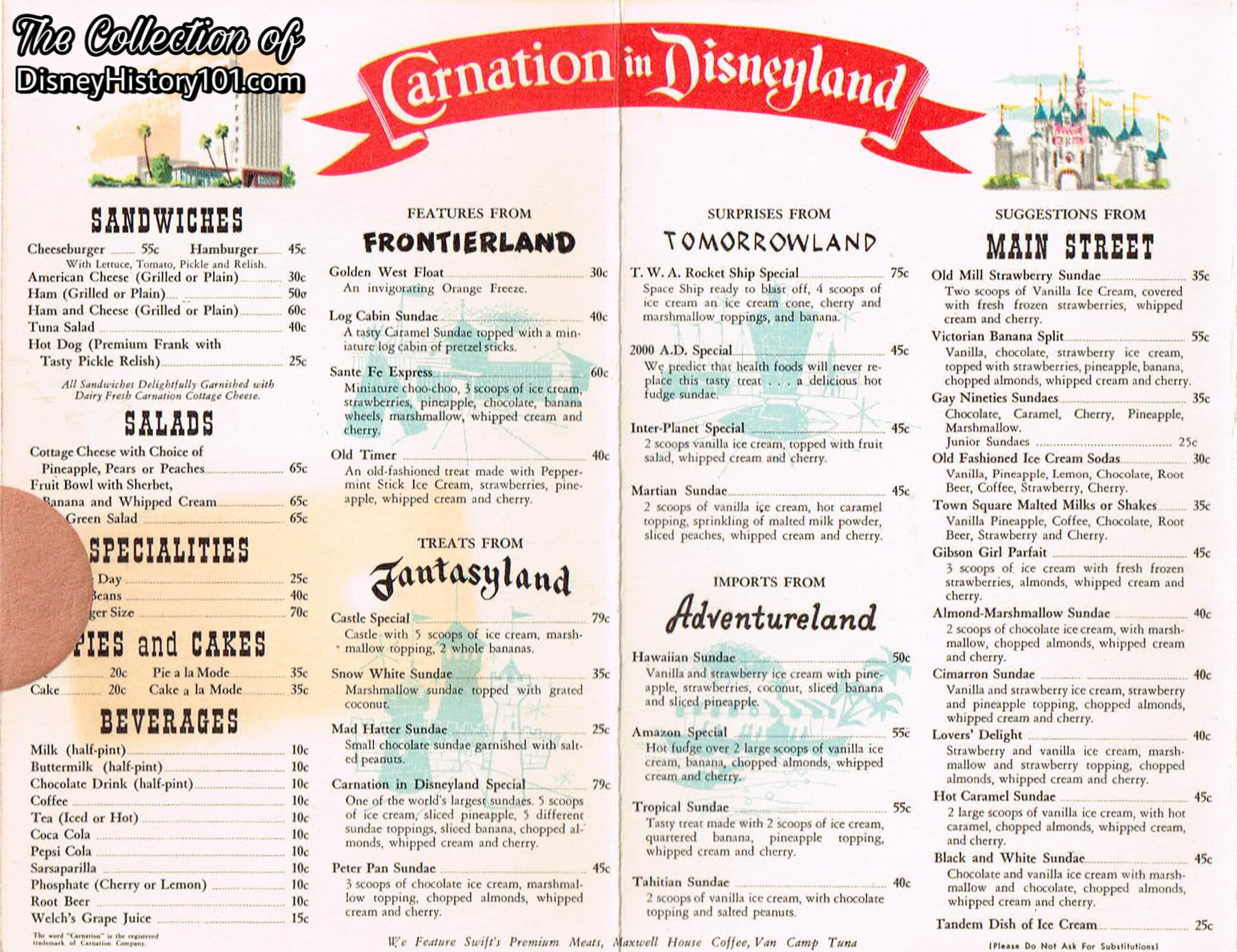
Carnation in Disneyland Souvenir Menu Postcard, 1960s
Though some Carnation products could be found at Ice Cream Carts (as Carnation held exclusive rights on milk, ice cream, and other dairy products in Disneyland), this was the only location that carried such a diverse amount of flavors. Such wonderful flavors as Rainbow, Fresh Peach, and Pineapple are but a few of the countless tempting treats served up in the gracious manner of the 90s to all who pause for refreshment during a day at Disneyland. Garnishes included sherbets and cottage cheese.
Though Carnation had exclusive rights on milk, ice cream, and other dairy products in Disneyland, this was the only location that carried such a diverse amount of flavors. By the end of Disneyland’s Tencennial celebration, Carnation continued to be the only ice cream sold in Disneyland for 10 years!
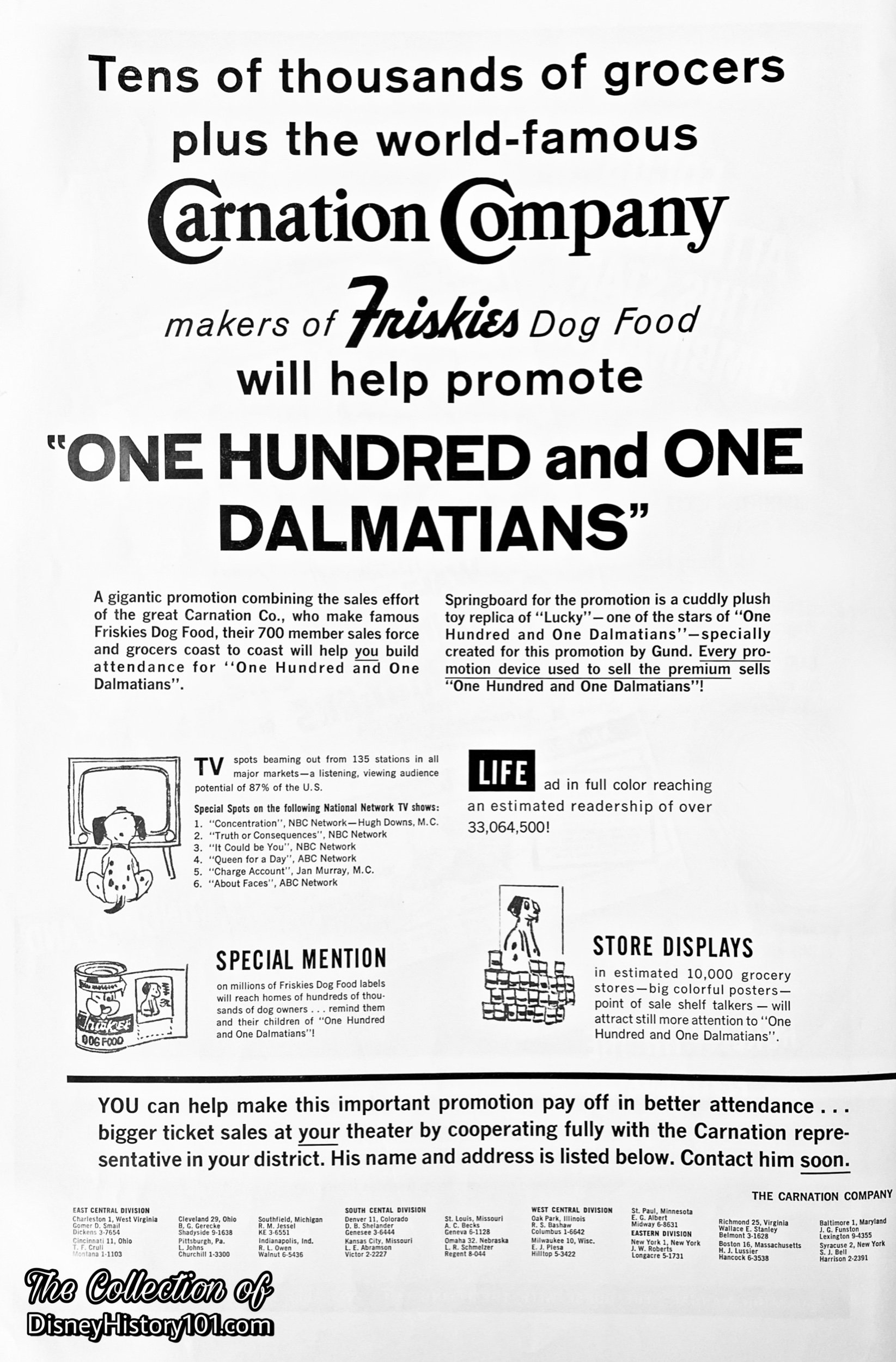
A synergistic promotional tie-in with Walt Disney's 101 Dalmatians, c.1961.
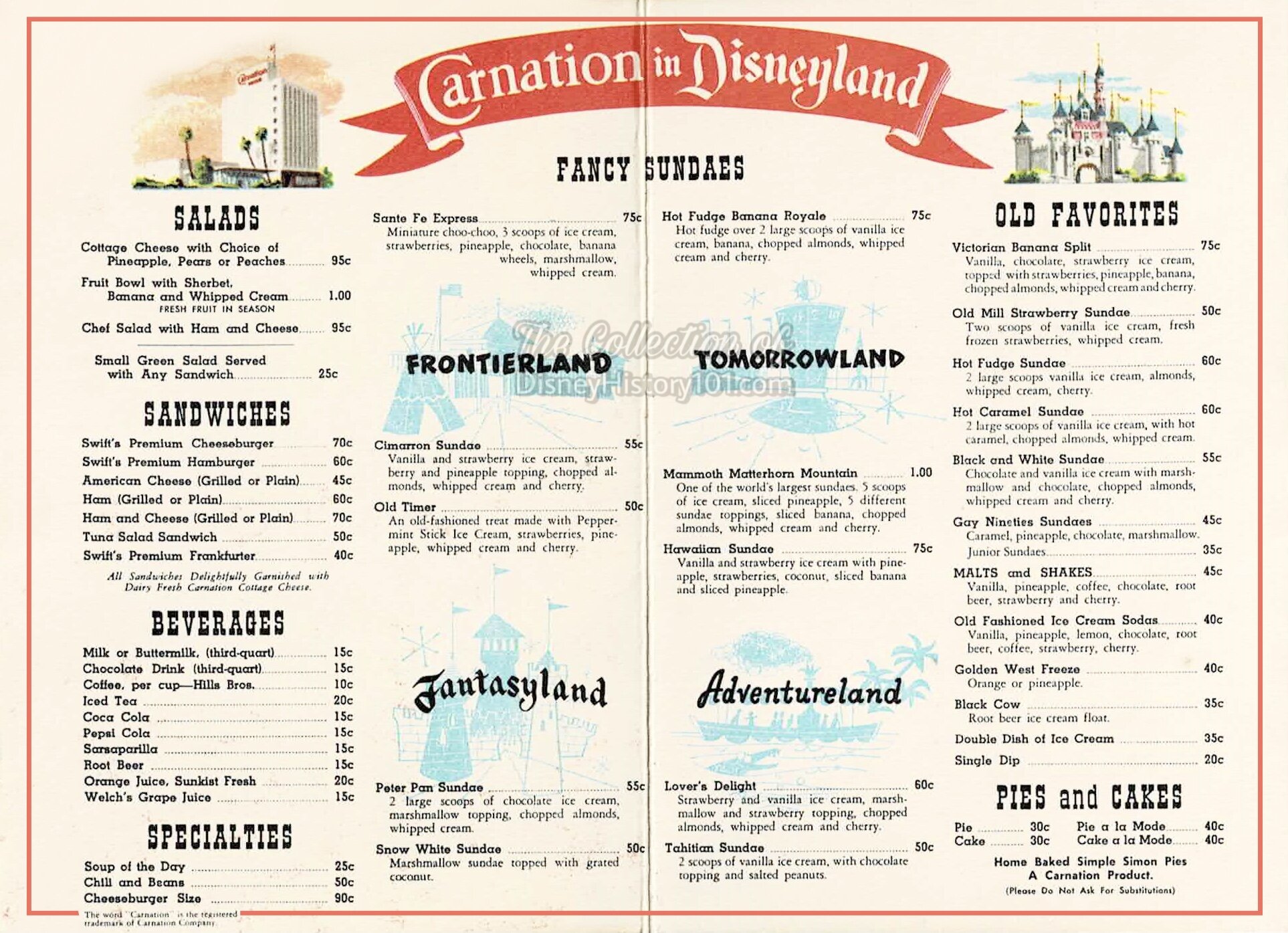
“Carnation in Disneyland” Menu, (1962)
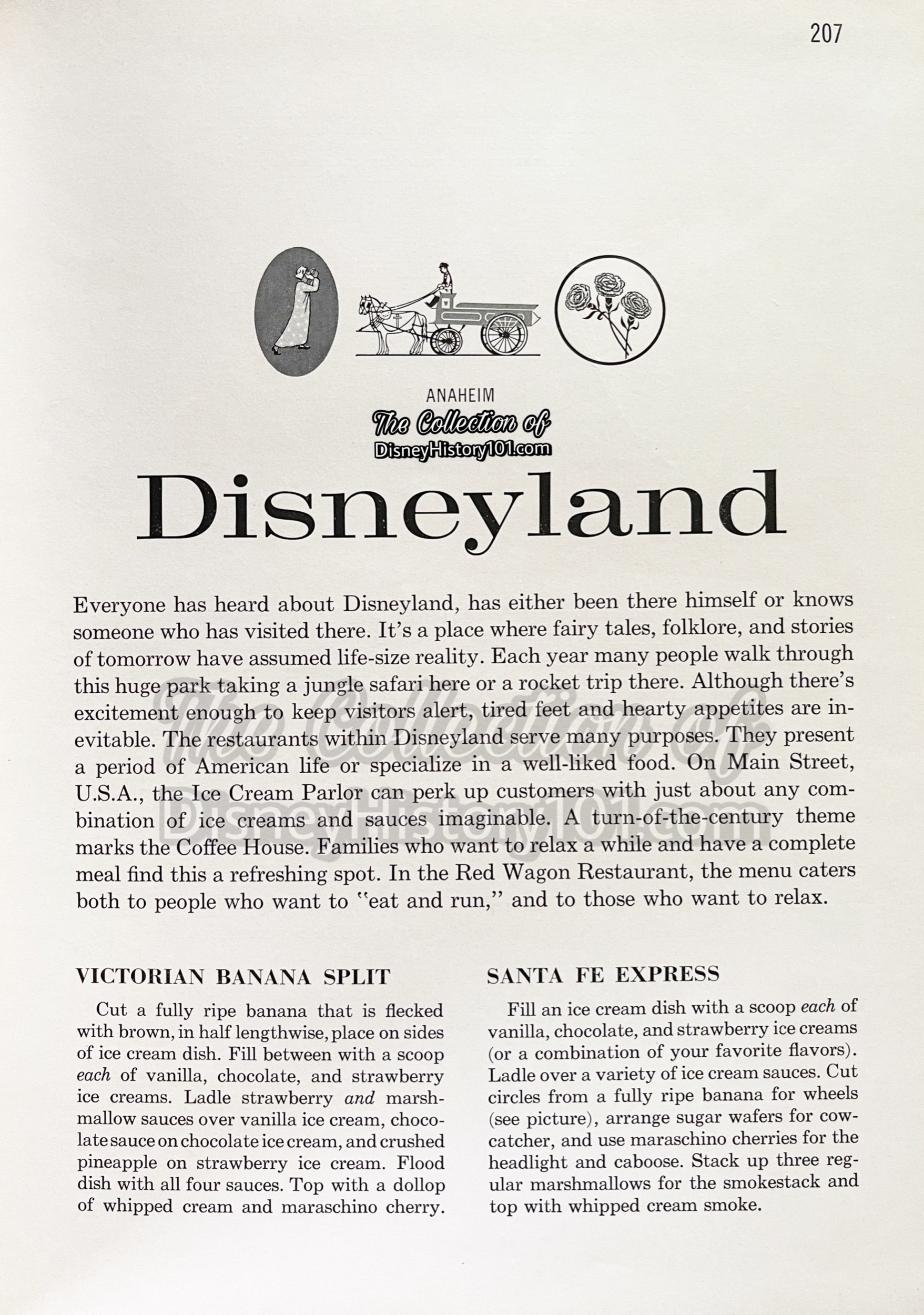
Better Homes and Gardens "Famous Foods from Famous Places," (1964)
Better Homes and Gardens "Famous Foods from Famous Places" (published by Meredith Press, 1964) pages 206-208, spotlighted a number of Carnation Ice Cream Parlor treats.
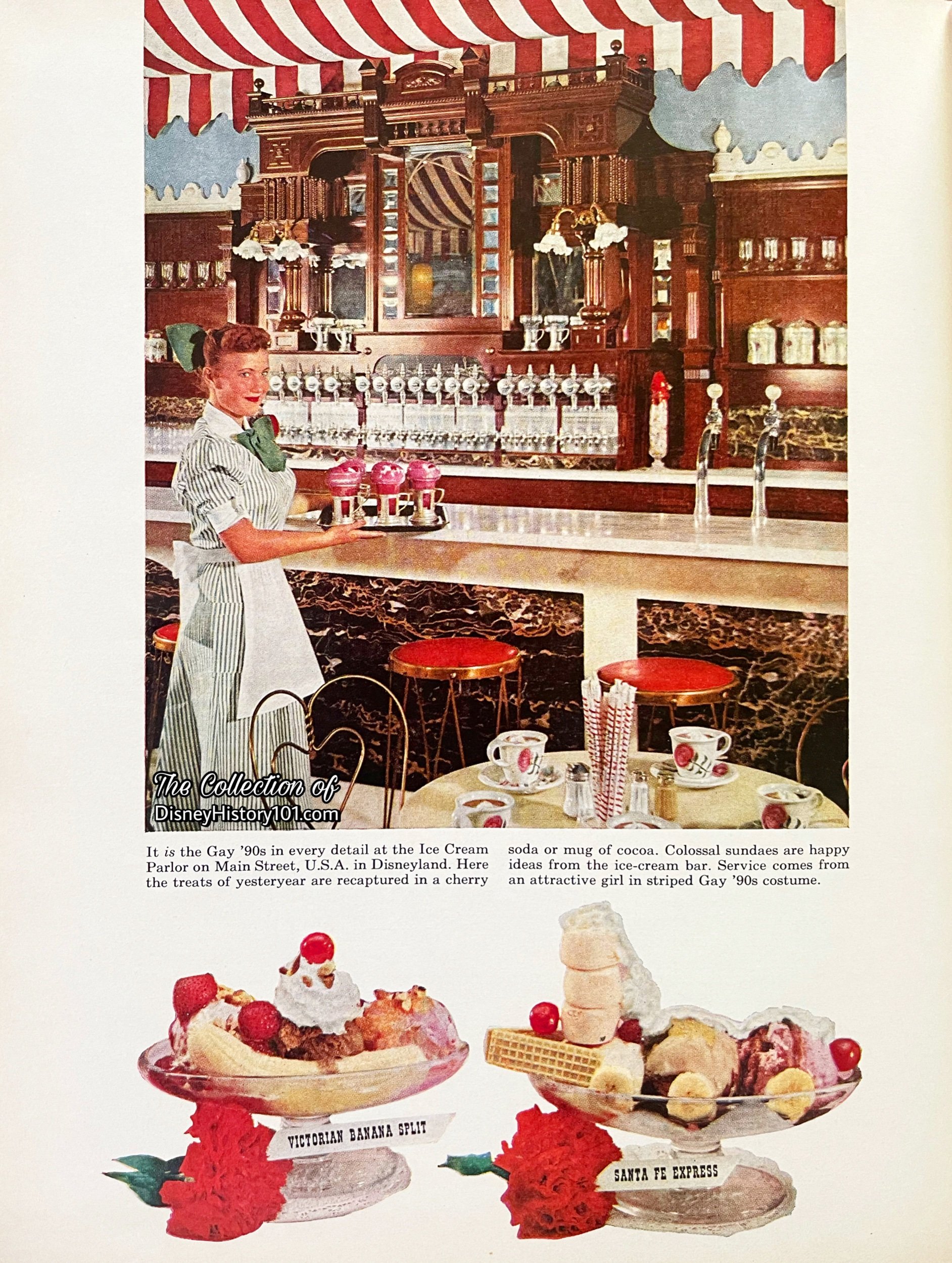
Better Homes and Gardens "Famous Foods from Famous Places," (1964)
An “old favorite” (left) and a “fancy sundae” (right) are pictured above, while two “suggestions from Main Street” are pictured below. Maybe some of you will remember eating some of the best banana splits at Carnation Ice Cream Parlor.
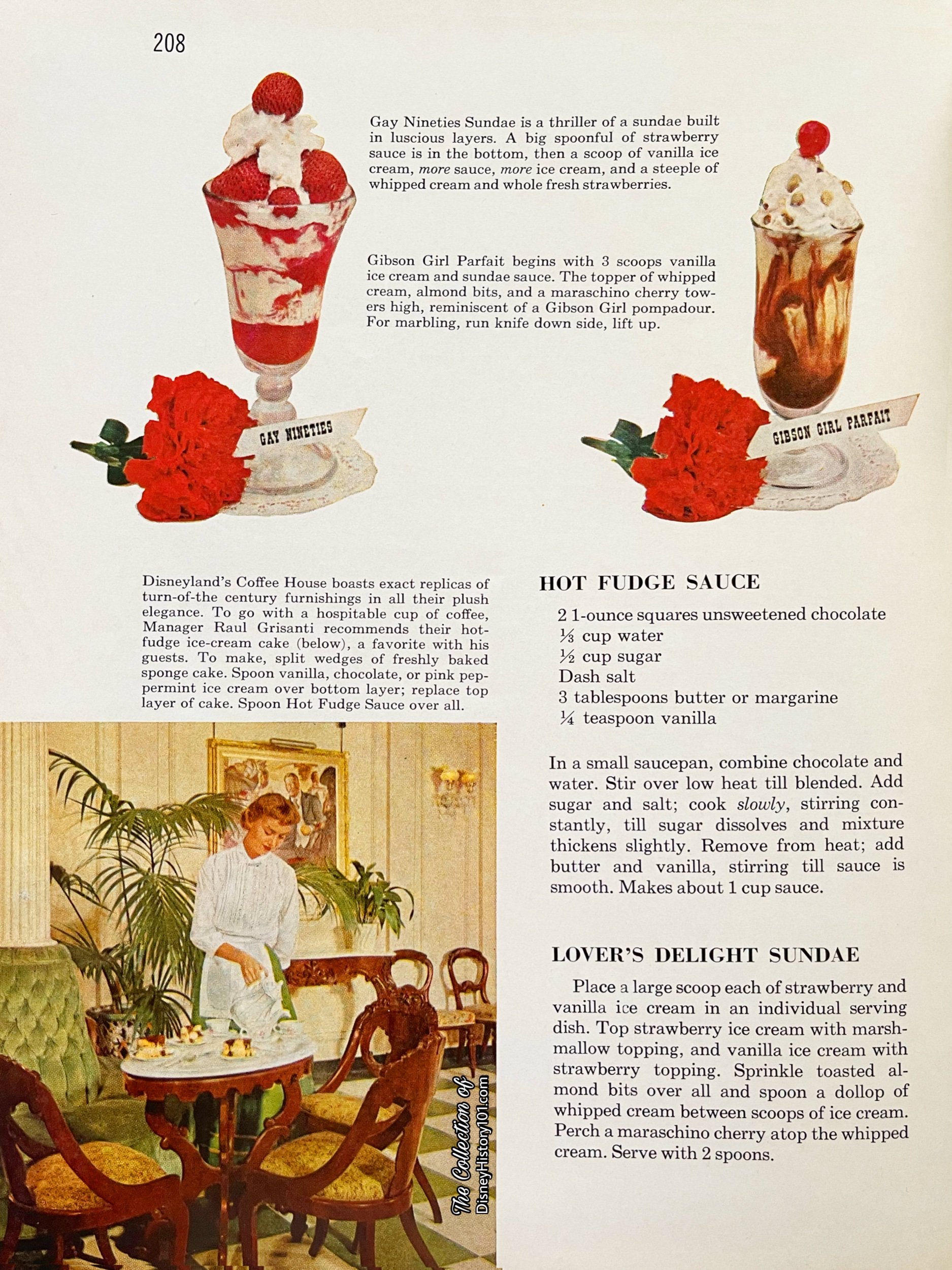
Better Homes and Gardens "Famous Foods from Famous Places," (1964)
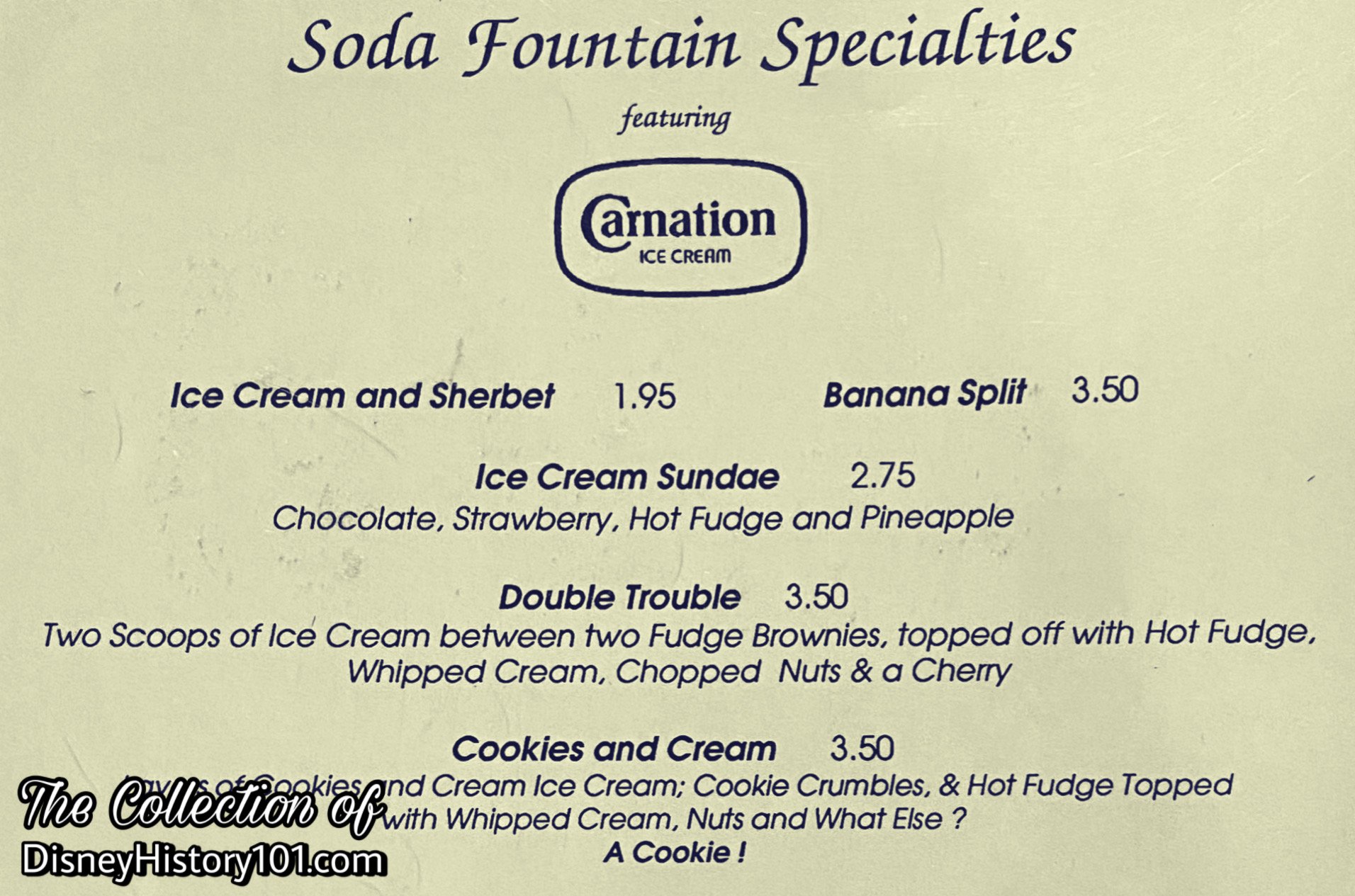
Monorail Cafe Menu Excerpt highlighting Carnation Ice Cream Products elucidate why those “Thick Milk Shakes” were so delectable.
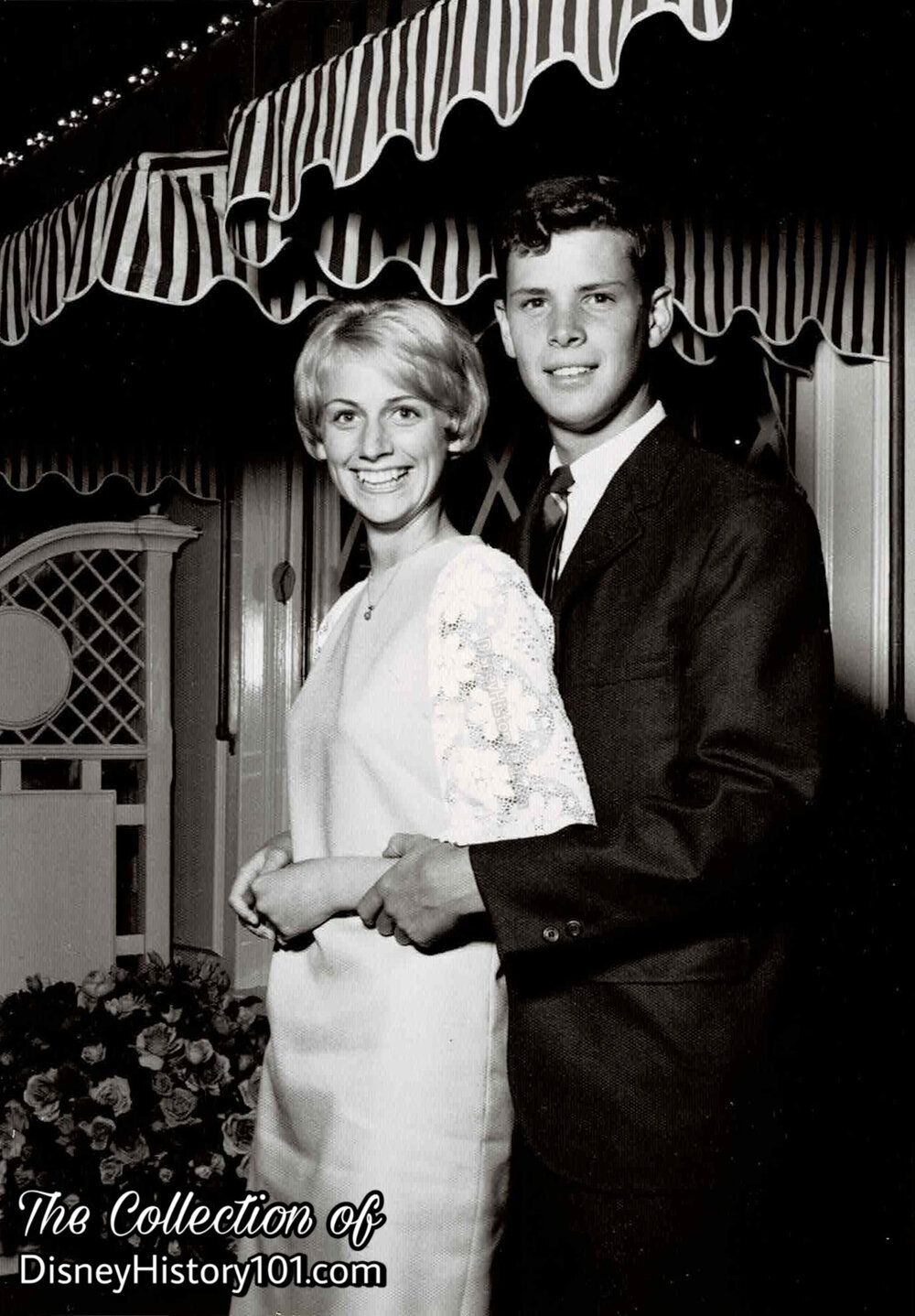
Seniors at Disneyland's Grad Nite 1966
An area adjacent to Carnation Ice Cream Parlor was used as a Disneyland Grad Nite Photo Location for several years through the 1960’s.
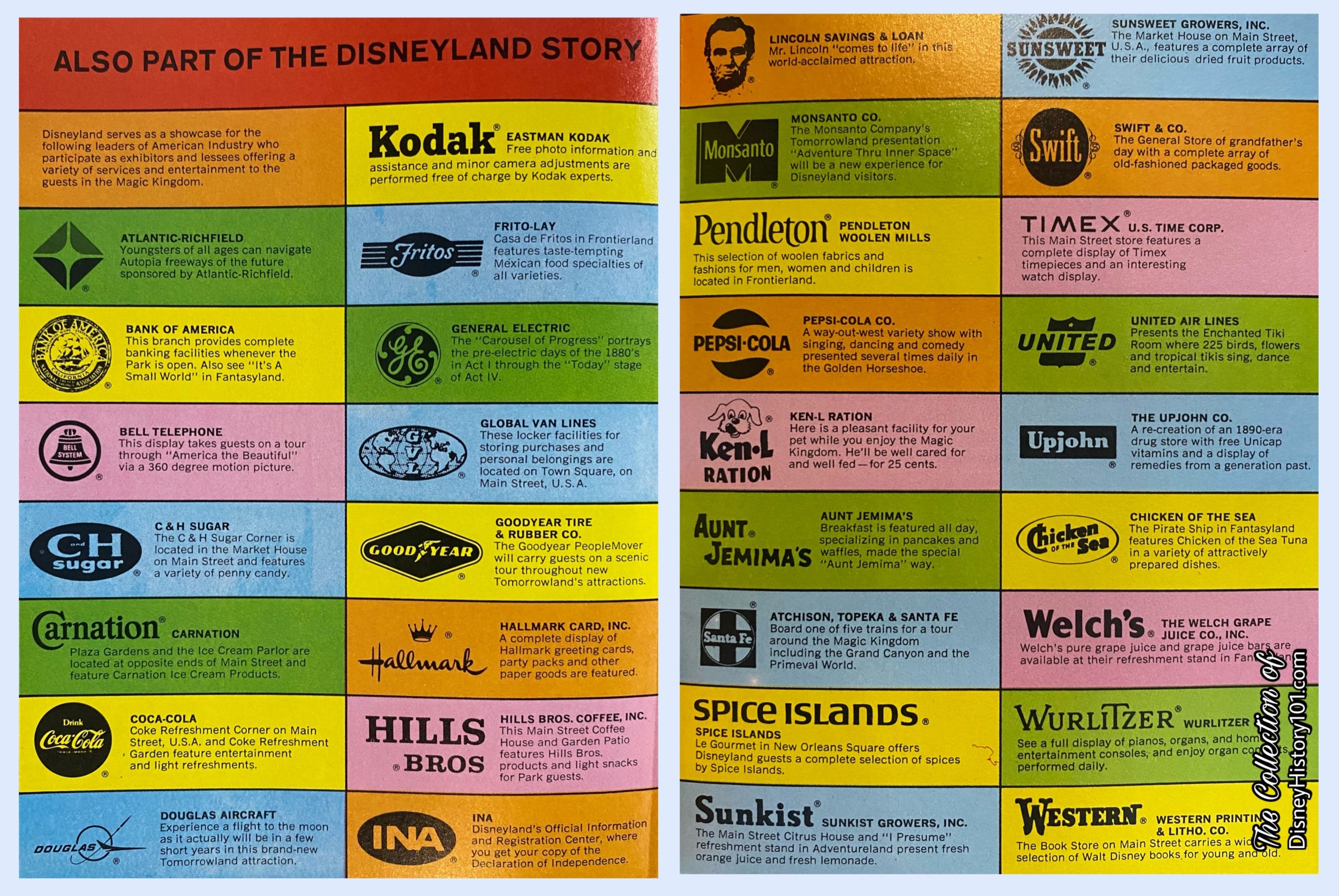
Carnation was a Disneyland Participant and thus “part of the Disneyland story according to this “Disneyland ‘67” Excerpt.
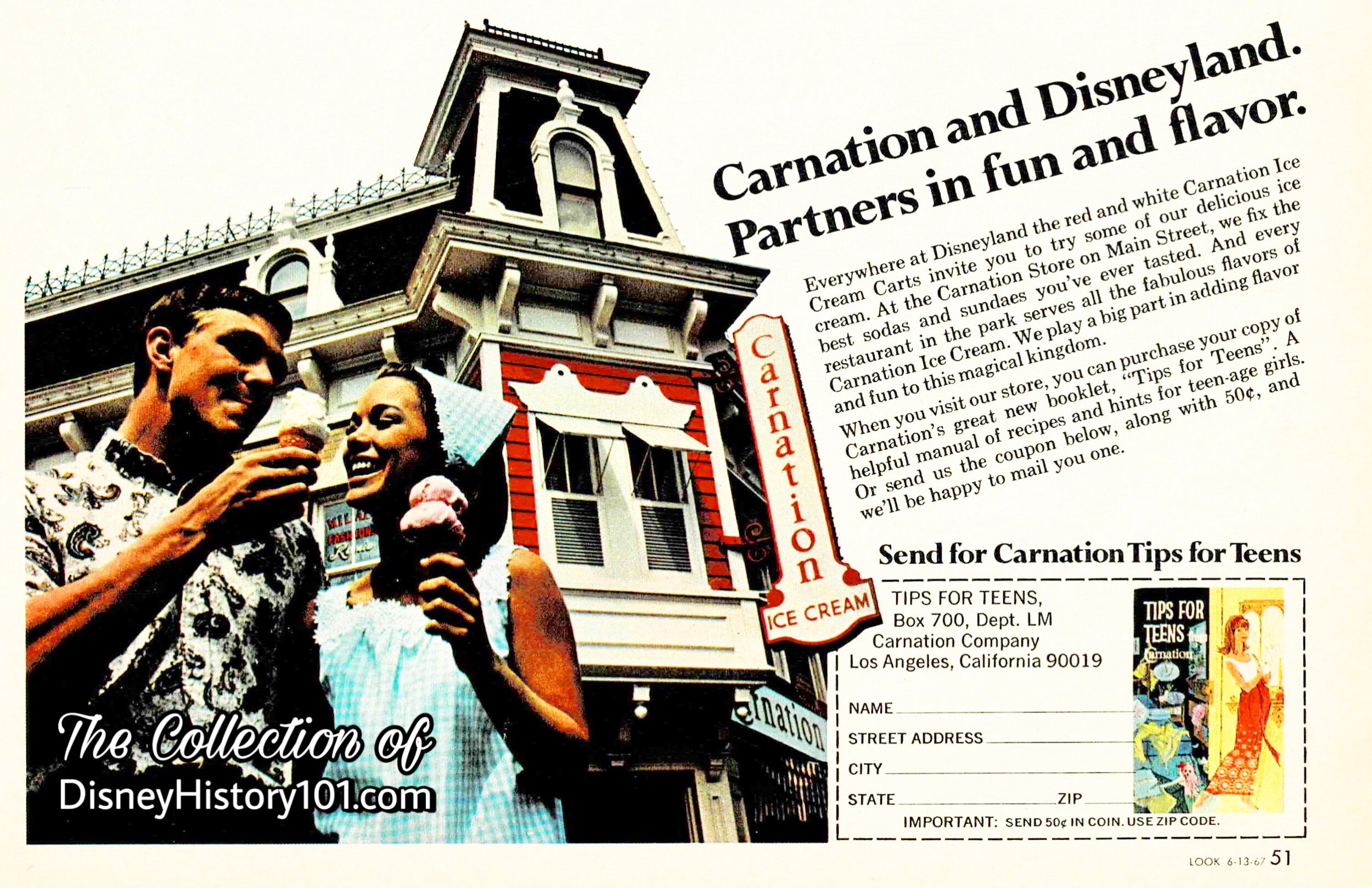
Carnation and Disneyland "The Look Supplement" Advertisement, 1967
“Fun and Flavor Sweepstakes and Other Promotions”
During 1967 and 1968, Disneyland supported the “Carnation Fun and Flavor” campaign. Disneyland Ambassador Sally Sherbin made an appearance on the “Carnation Fun and Flavor Sweepstakes” program. In addition, Mickey Mouse, Sally, and other members of Disneyland’s staff (like Disneyland Hostesses) made more than 100 appearances on television, radio, and in-person at local supermarkets to assist the Carnation campaign!
“You’re In Good Company” (A Report To Disneyland Lessees, Summer ‘68) commented about the campaign this way :
“Many lessees through the years have promoted their association with Disneyland with outstanding results. One of the most ambitious - and successful - of these tie-ins came this spring [of 1968]… Carnation’s Fun and Flavor Sweepstakes. Here was a vast and complicated campaign that not only had the full cooperation and assistance of Disneyland’s marketing division, but also the cooperation of several other Park lessees [as Eastman Kodak, General Electric, and United Airlines] in a partnership promotion. ‘We won’t have the final results for awhile yet,’ said Charles E. Pritchard, Carnation’s marketing manager, ‘but I can tell you that overall it’s been the most successful promotion that we ever had. Our tie-in with Disneyland has given our sales staff a tremendous morale boost by providing them with a valuable tool to attract a great deal of attention and interest. Our first quarter sales were the highest in the fresh milk and ice cream division’s entire history. ‘What we’re looking for,’ Pritchard continued, ‘was a connection for our 1968 advertising campaign that would be of interest to our markets on a local level. In our western United States region, we have 23 separate marketing areas, each virtually autonomous, and each requiring intensely localized promotion. Carnation has always been associated with flavor - 38 in ice cream alone - and Disneyland has always been synonymous with fun. We wanted to tie the two aspects into one thought… Carnation - Disneyland, partners in fun and flavor.”
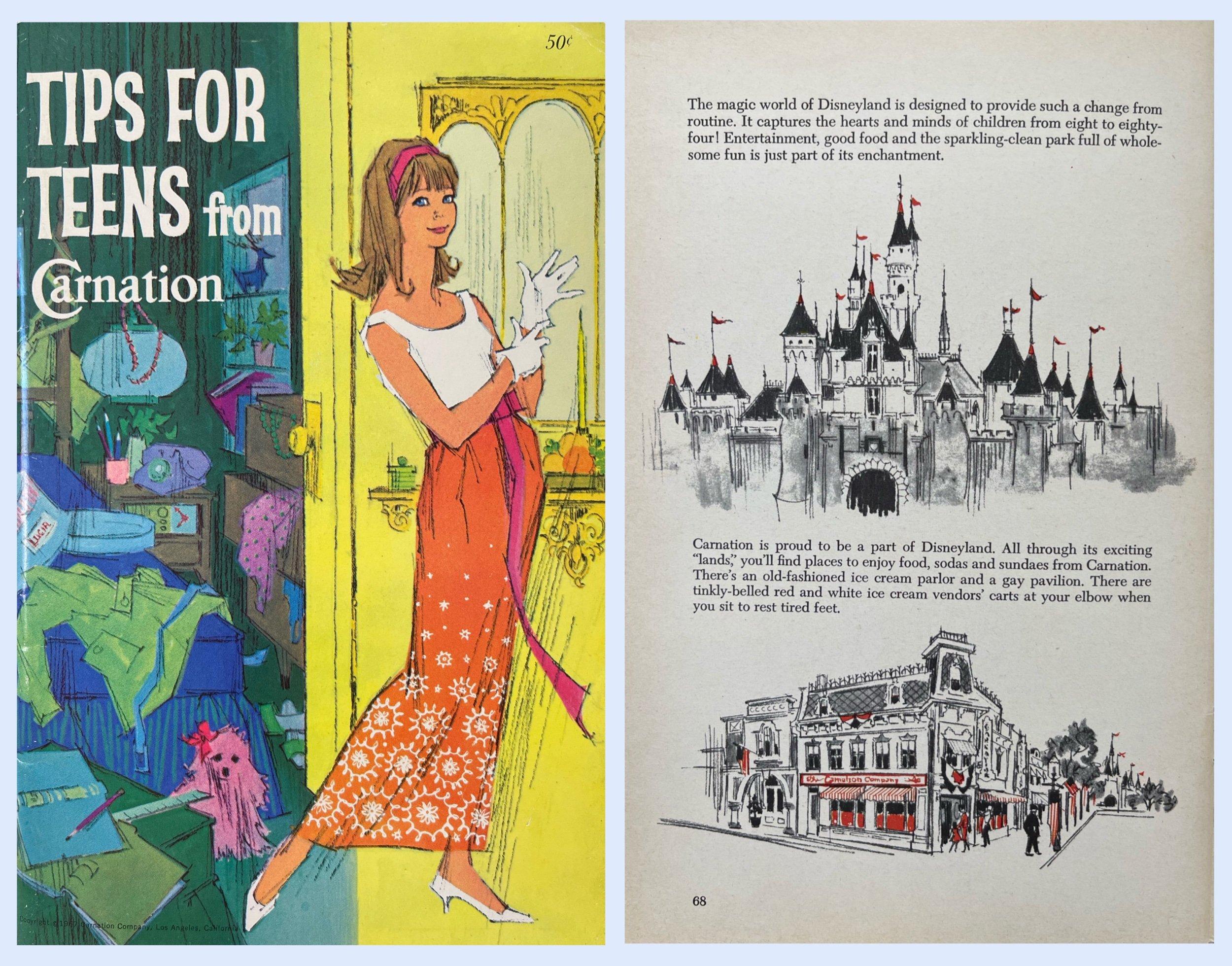
"Tips For Teens From Carnation," by Virginia Piper Copyright © 1967 Carnation Company, Los Angeles
Part of that previous advertising campaign, was the complimentary “Tips for Teens” handbook. Now, “‘Tips for Teens’ isn’t a sermon. It is a reminder that the whole people-world lives by some rules and accepts certain responsibilities, including some of the things you hear about from your family daily.
Carnation people feel they have a responsibility to you. That’s why ‘Tips for Teens’ tries to keep up with you, your brightness, your broader horizons and your up-to-date outlook. To keep up with the newness, we’re constantly changing too…
That [‘squirrel in a cage’] feeling needs relaxation and a change from routine to cure it.”
And so a whole two pages of Tips for Teens was dedicated to Walt Disney’s Disneyland!
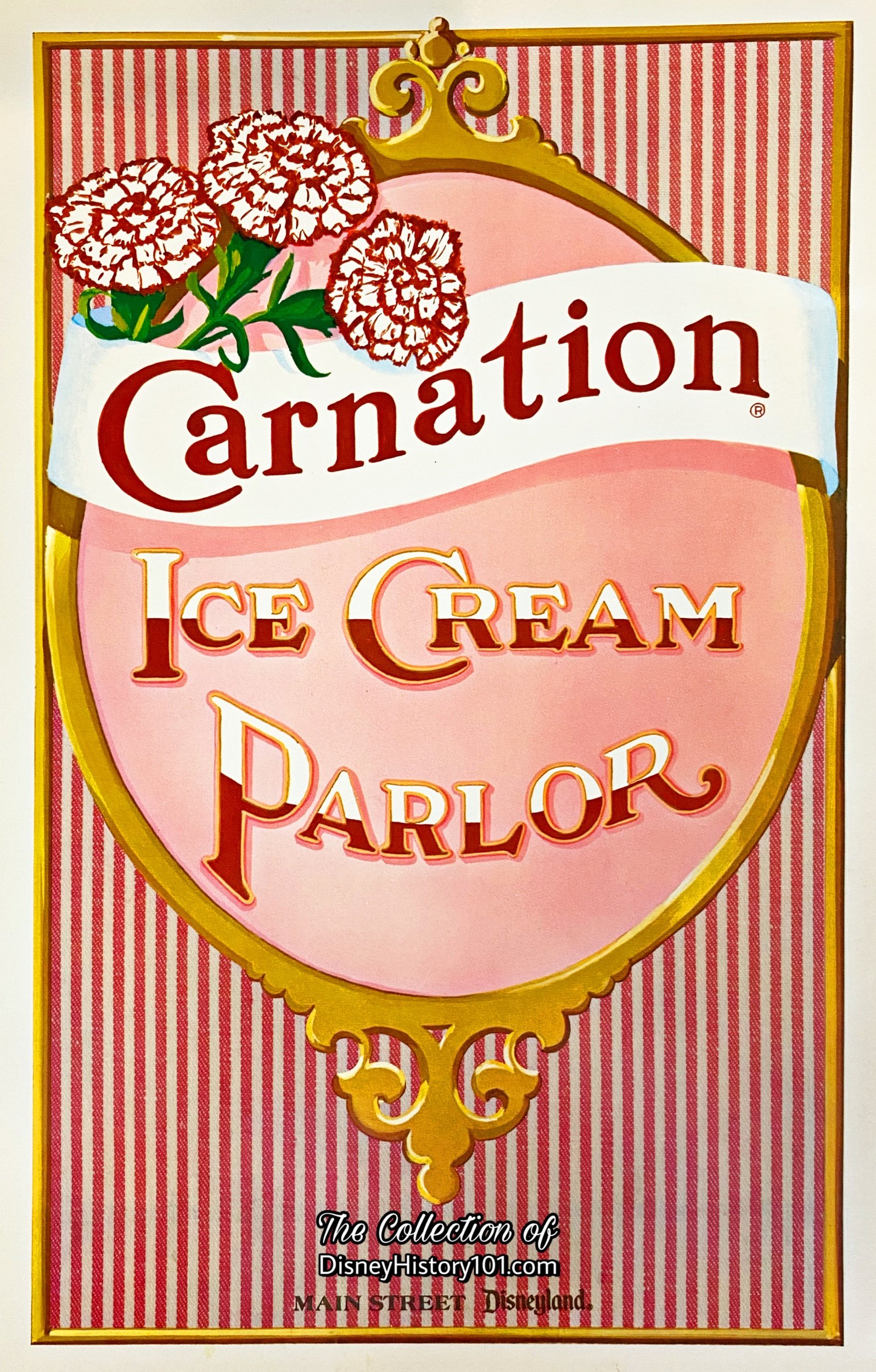
Carnation Ice Cream Parlor Menu Cover
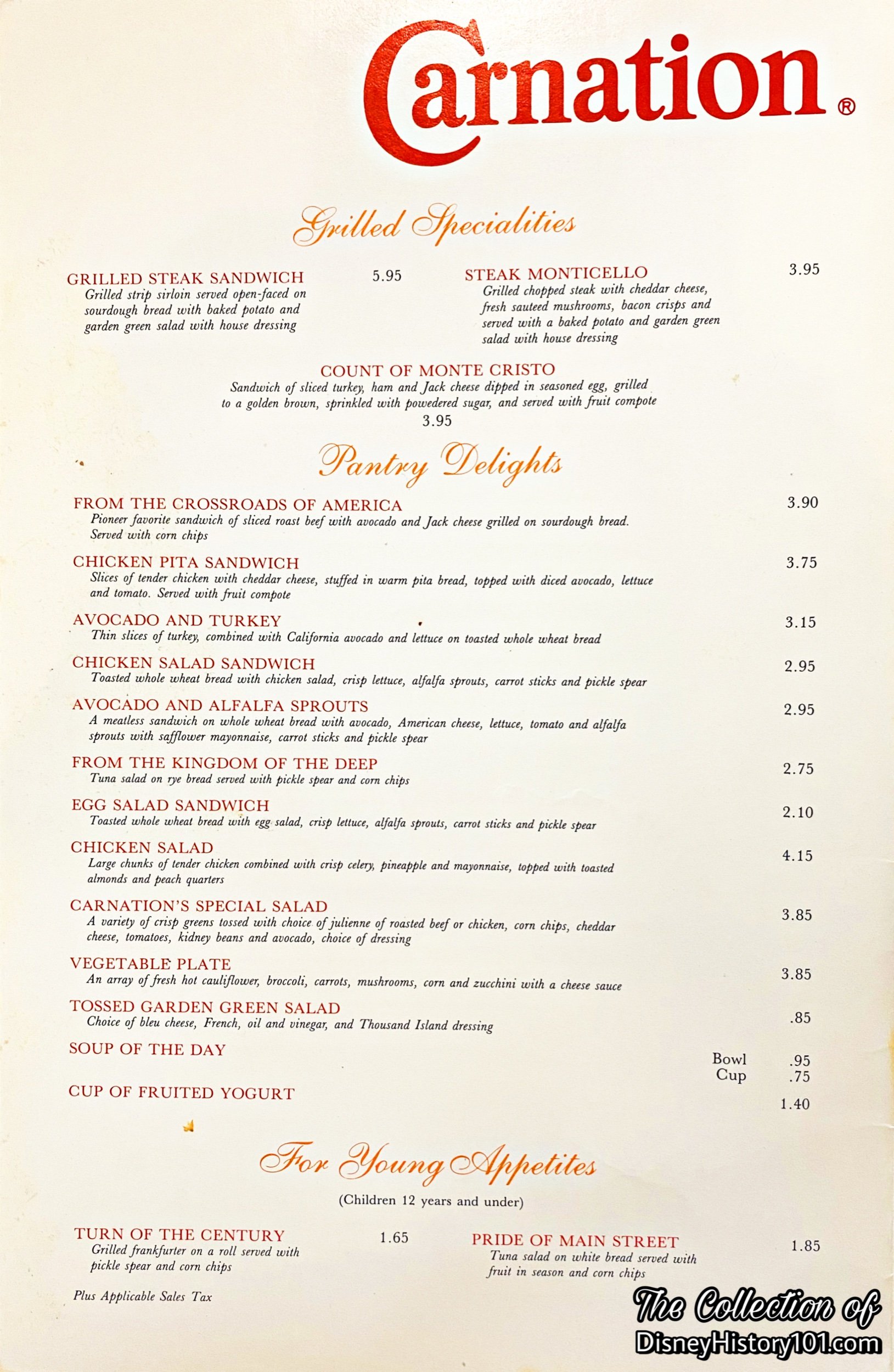
Carnation Ice Cream Parlor Menu Cover
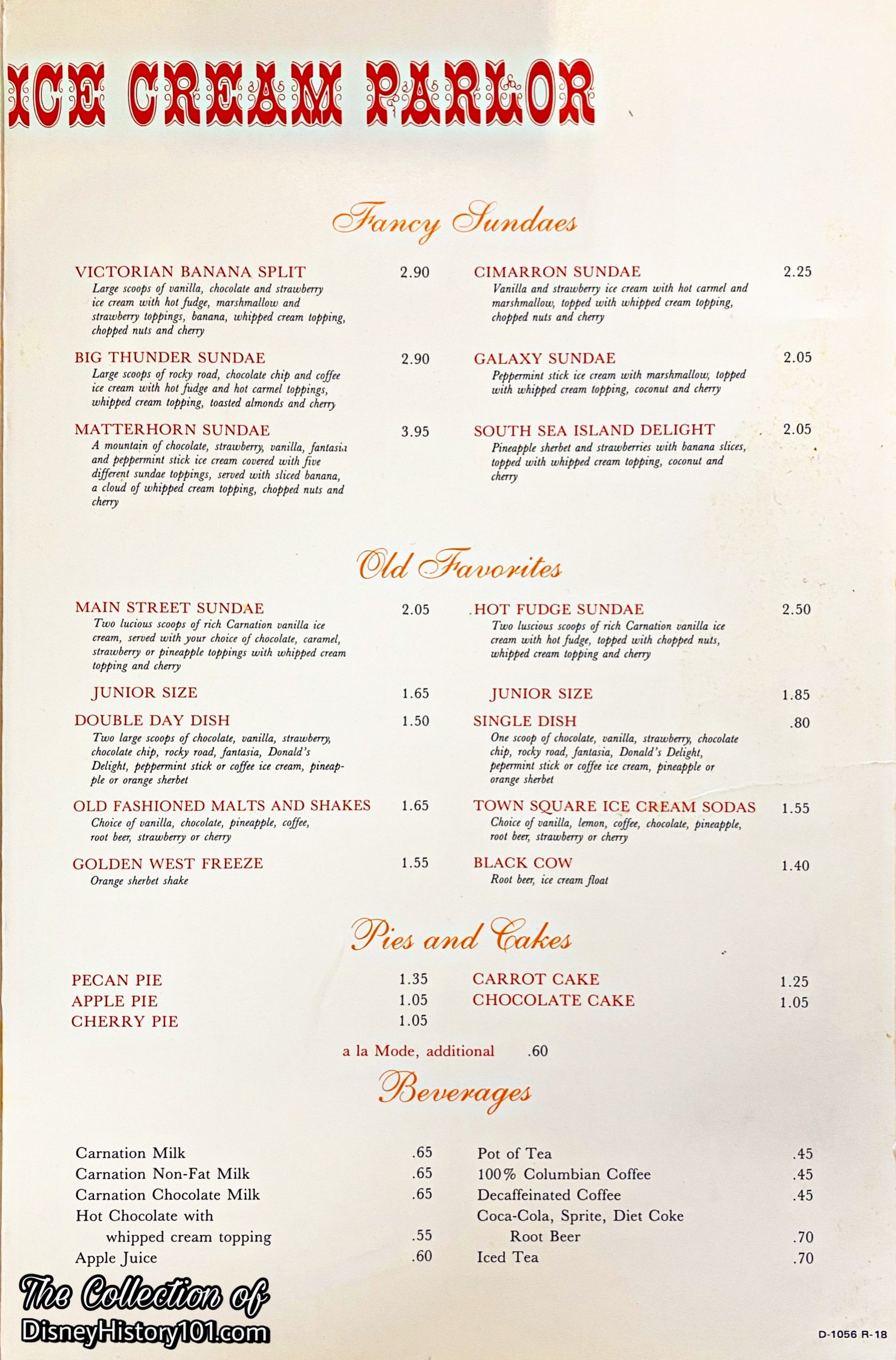
Carnation Ice Cream Parlor Menu Cover
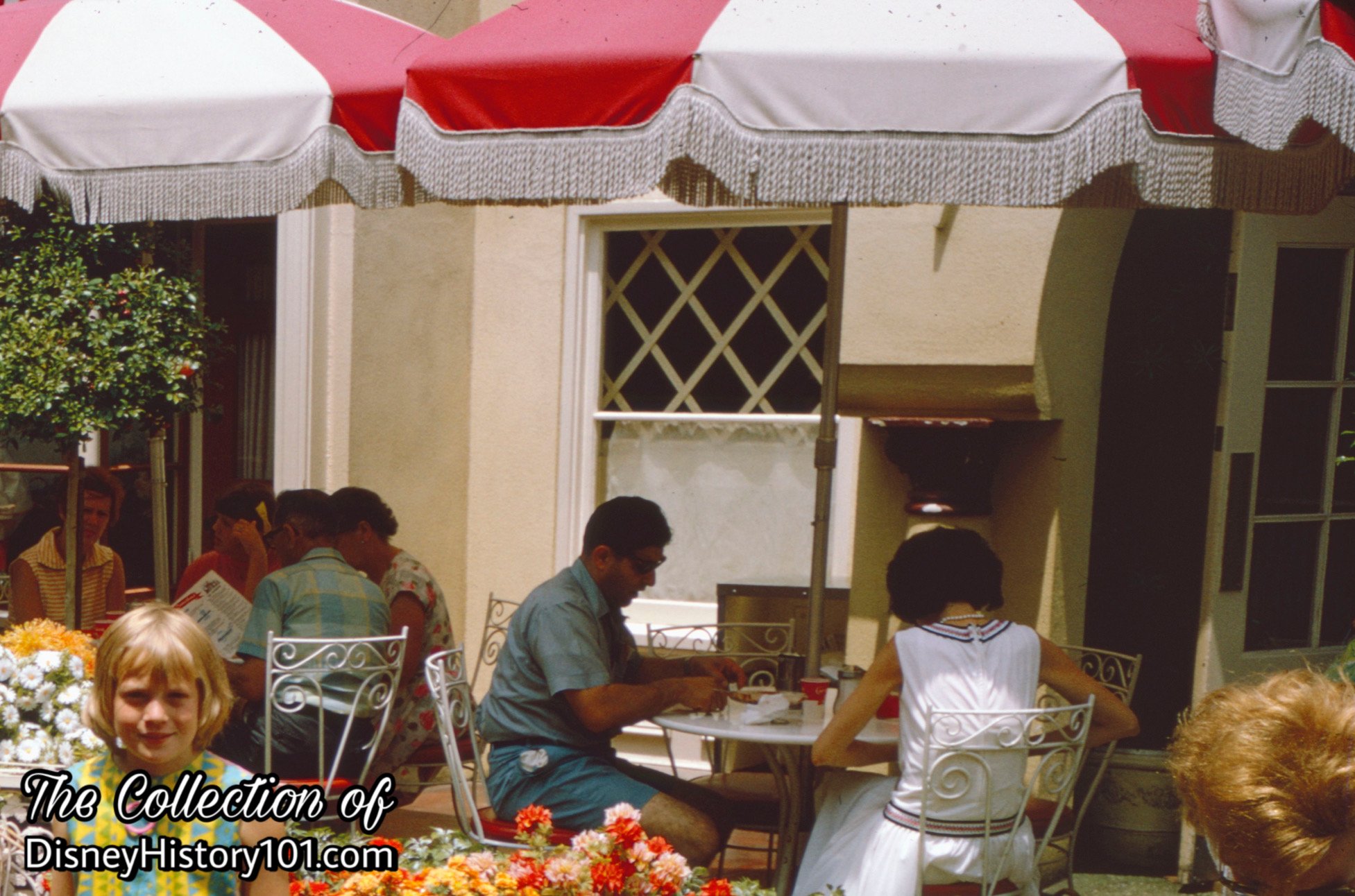
Guests dining at Carnation Ice Cream Parlor.

If you would like to read more about the Carnation Ice Cream Parlor, it’s my pleasure to recommend adding Marcy Smothers’ “Eat Like Walt - The Wonderful World of Disney Food” to your personal Disney Home Library! Therein, Marcy has extensively researched and finely crafted a small section of a chapter dedicated to “Walt Disney’s Disneyland - Main Street U.S.A.” If you would like to bring the magic of Disneyland restaurants and concessions (like the Carnation Ice Cream Parlor) to your dining room table, “please step this way” toward www.eatlikewalt.com where Marcy has shared a few recipes for memorable Disneyland menu options, so you too can “Eat Like Walt.”
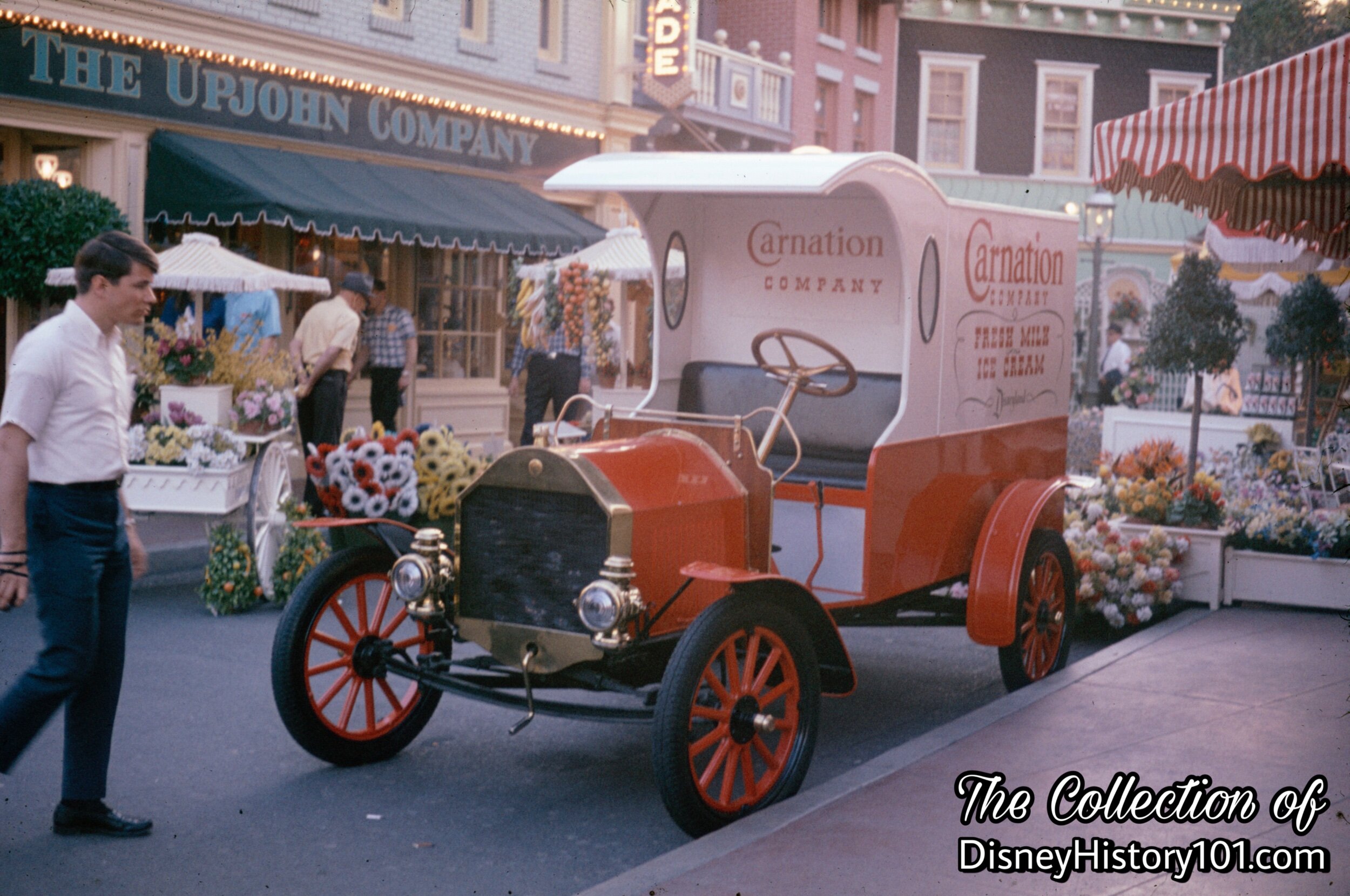
Carnation Company Delivery Wagon Exhibit
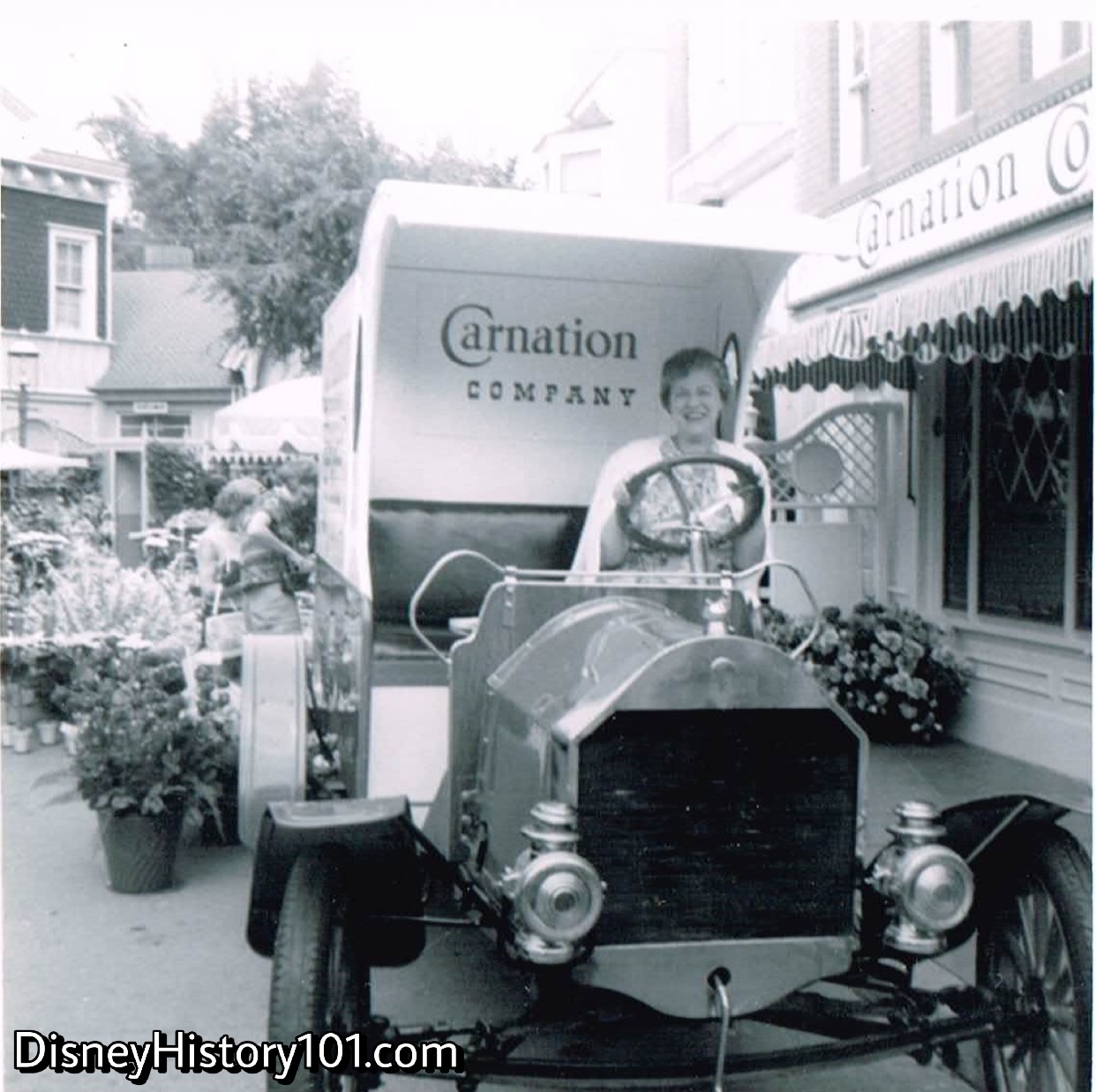
Carnation Company Truck Exhibit
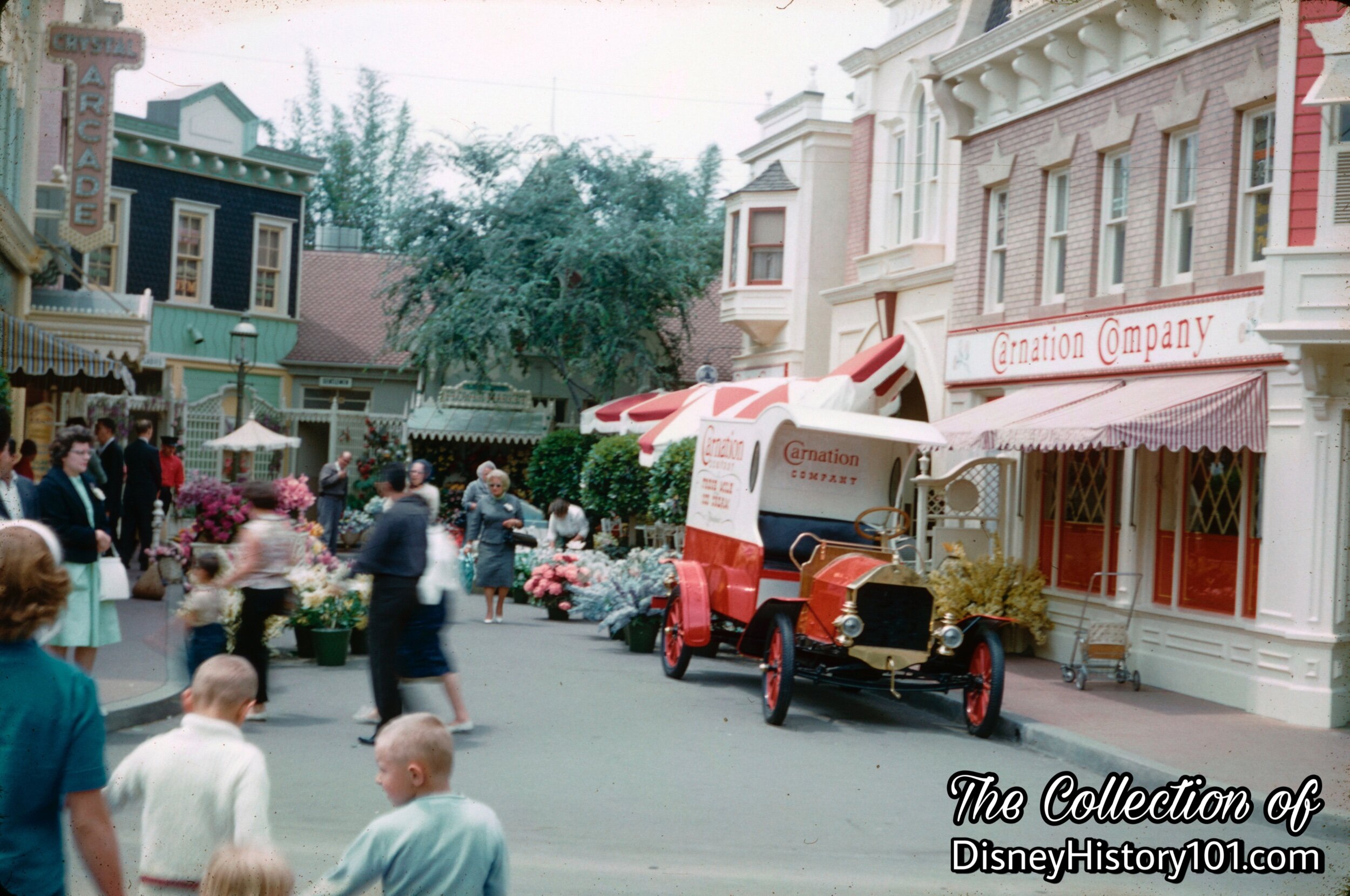
Carnation Company and Carnation Company Truck Exhibit, 1962

Carnation Company Truck Exhibit, (July, 1963)
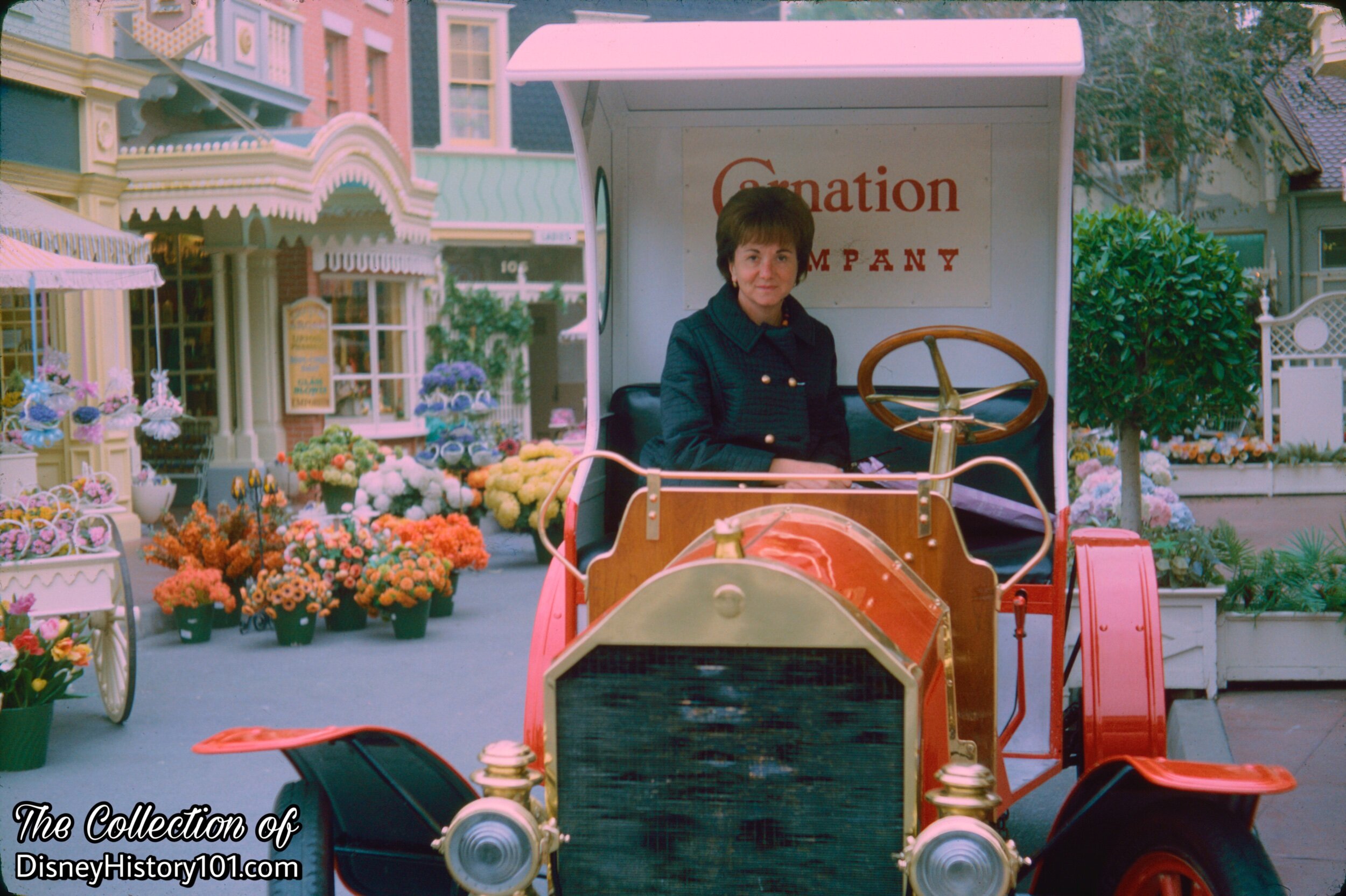
Carnation Company Truck Exhibit, (Spring-June, 1965)
Notice all the little indentations on the impressionable metal radiator filter, which was not easy to rehabilitate.
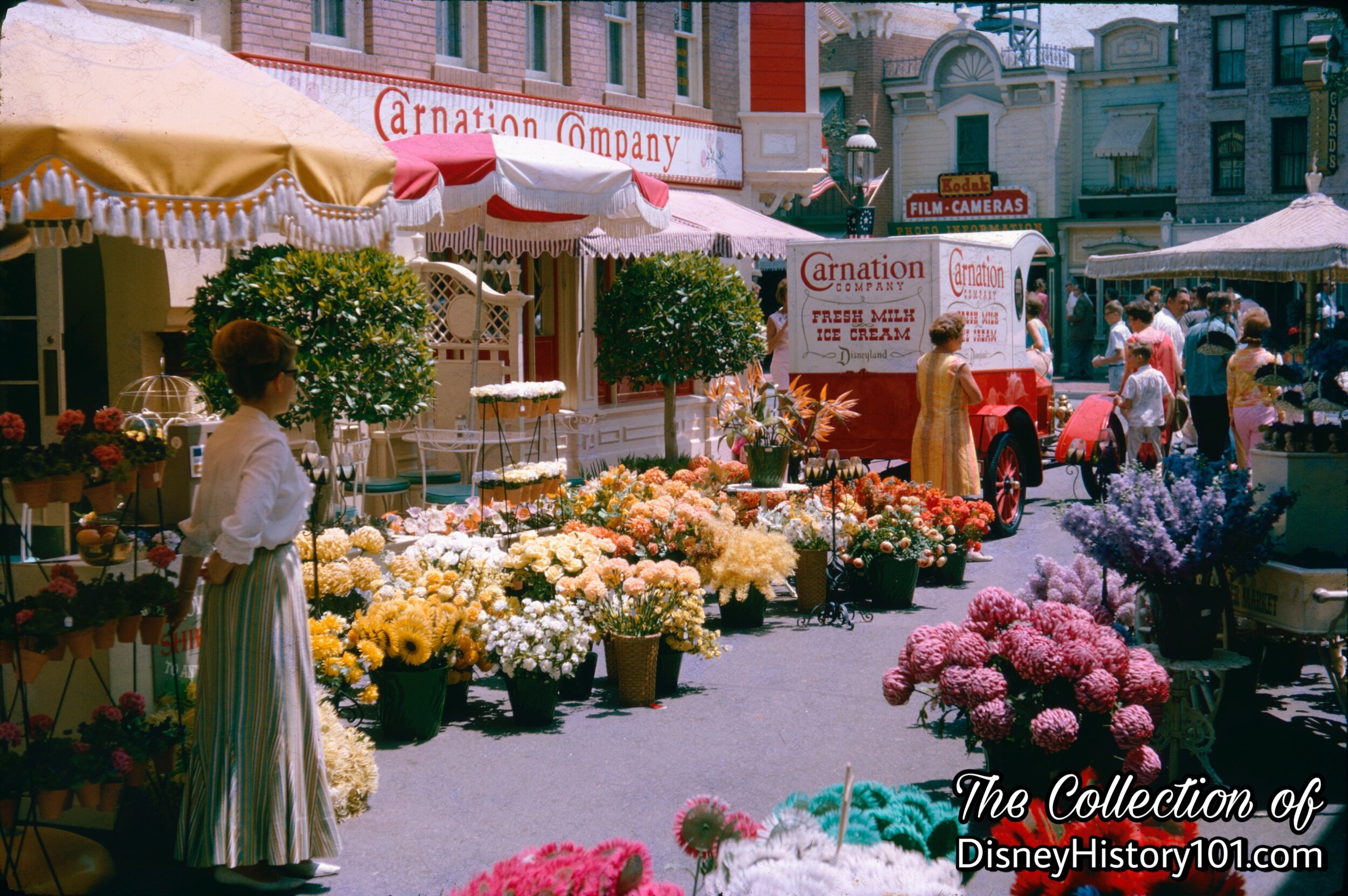
Disneyland Flower Market & Carnation Company Truck Exhibit near Carnation Cafe, (September, 1965)
Just outside the Carnation Cafe, Disneyland guests could purchase life-like carnations at the Main Street Flower Mart!
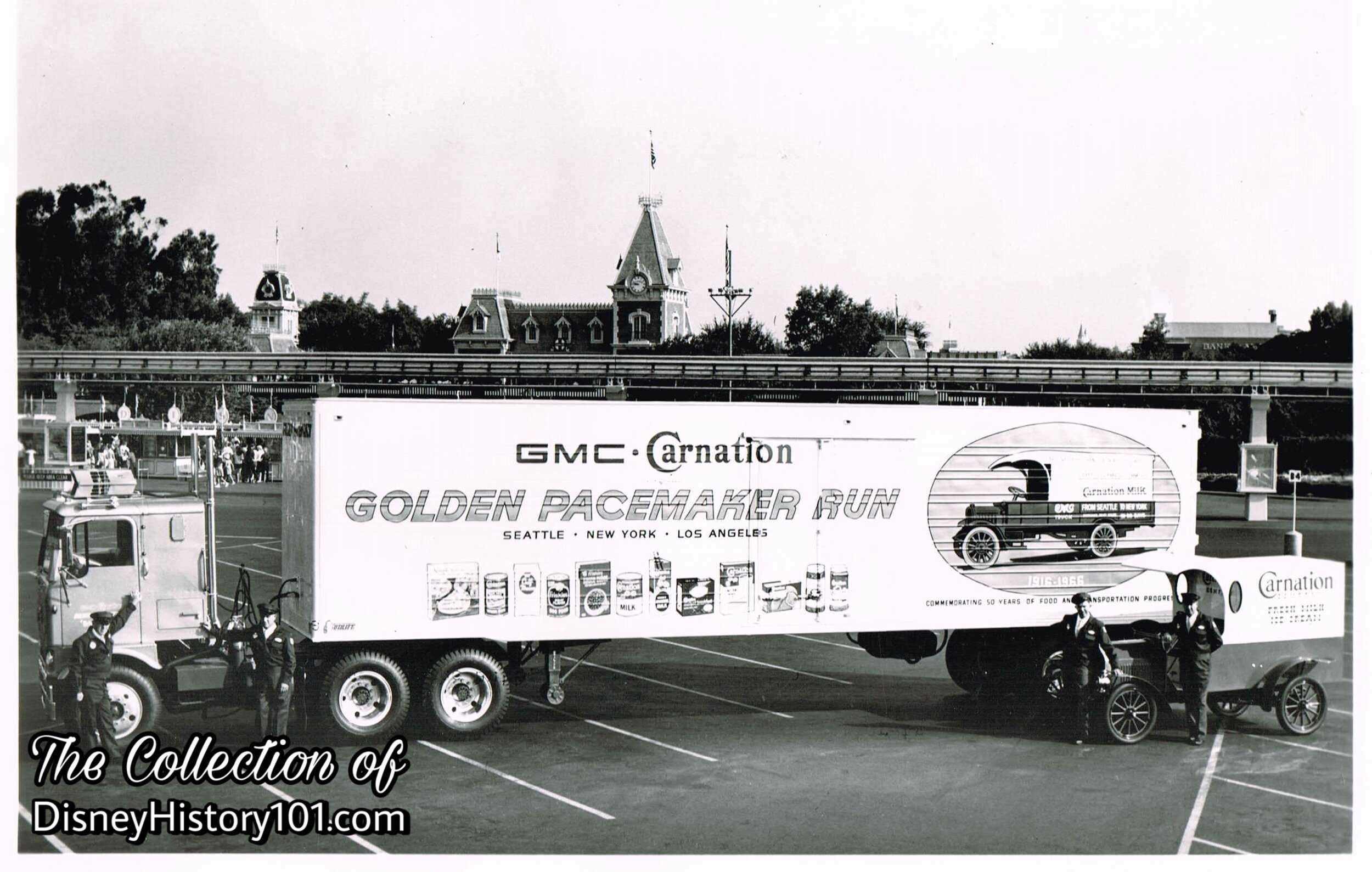
“THE GOLDEN PACEMAKER RUN”, (1966)
In 1966 (50 years after that aforementioned Transcontinental round trip), the trip would be restaged, in a promotion “to dramatize 50 years of progress in transportation and nutrition”. By this time, many of Main Street U.S.A.’s antique vehicles were a nostalgic reminder of the good old days! The sponsors of those vehicles (like the Swift’s Horse Wagon, or the Carnation Milk Truck) had replaced the archaic modes of transportation with modern vehicles. “This modern GMC diesel highway tractor with a 40-foot Utility semi-trailer, dubbed the “Golden Pacemaker,” shows how far commercial highway transportation has advanced since the first continental round trip. The first Seattle-to-New York leg of the original trip took 73 days. The re-run is expected to take slightly over three days, with drivers scrupulously observing all safety and highway courtesy rules.”
As an advertisement for this event, this publicity shot (featuring a few Carnaco Truck Drivers) was arranged with the Carnation Company Truck exhibit in front of Disneyland!
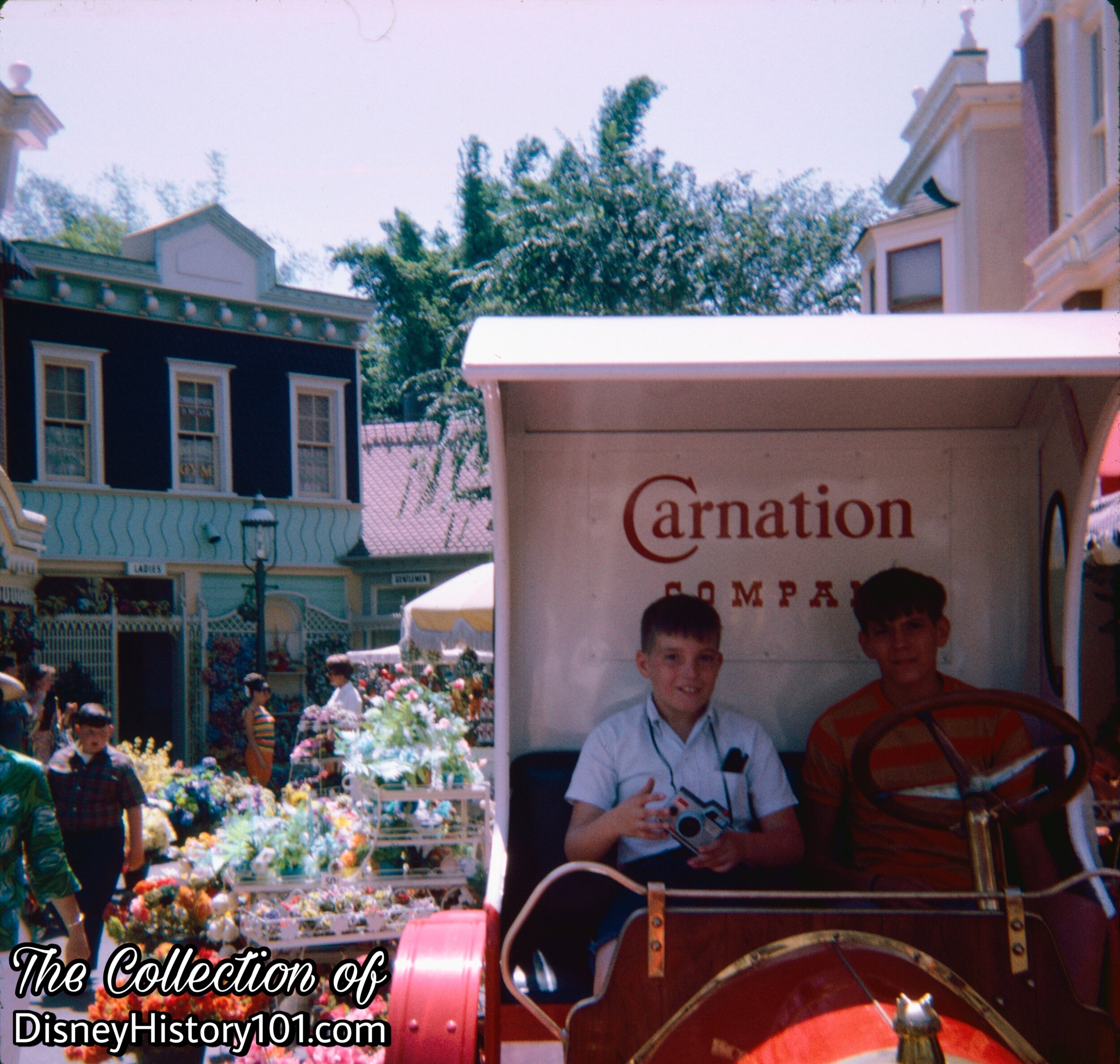
Carnation Company Truck Exhibit, 1967
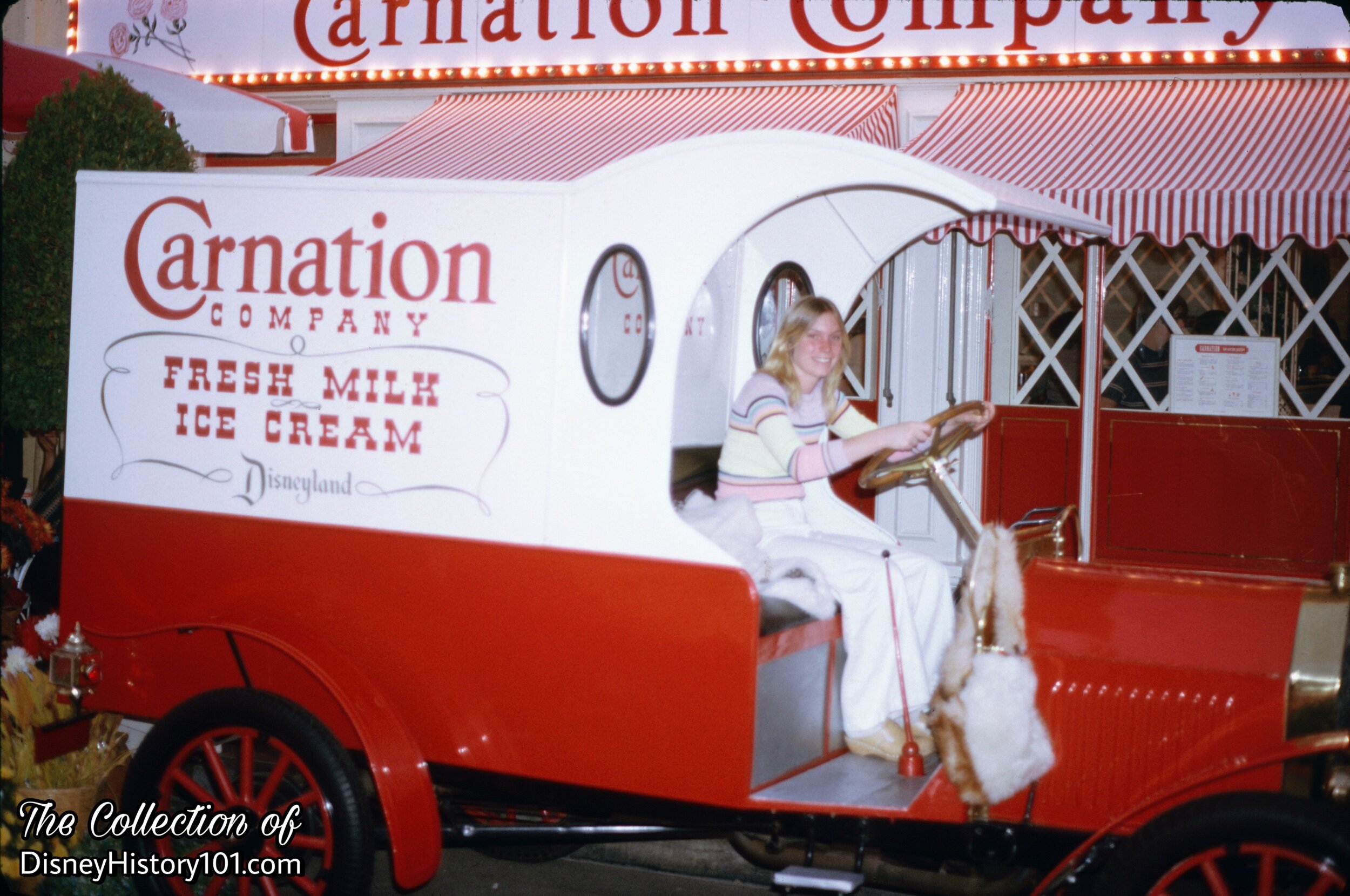
Carnation Company Truck, 1970s
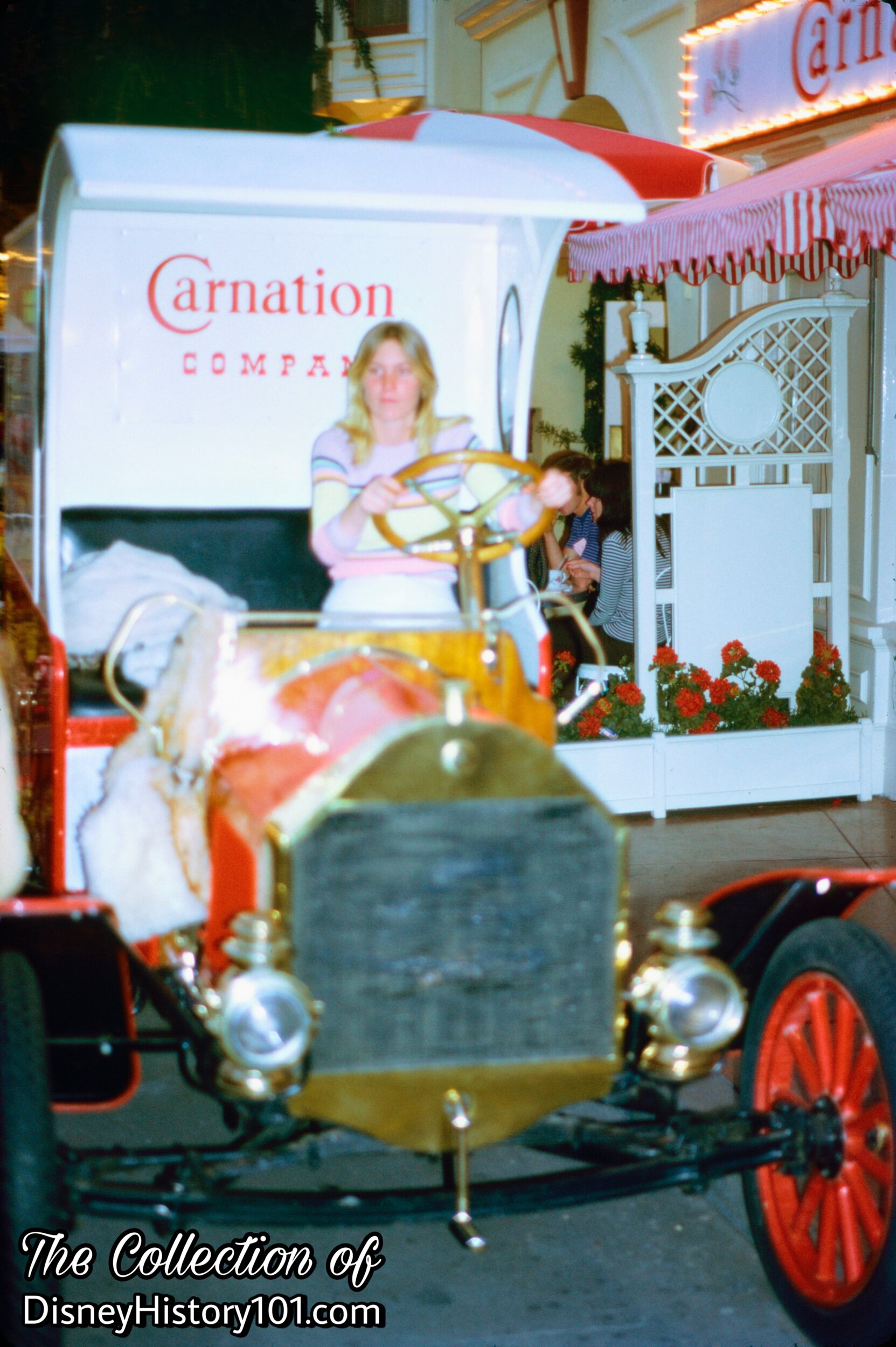
Carnation Company Truck, 1970s

Dapper Dans Perform in Carnation Cafe Foyer, (December 26, 1971)

Dapper Dans Perform in Carnation Cafe Foyer, (December 26, 1971)
In addition to the Dapper Dans, the Disneyland Christmas Carolers (under the direction of Dr. Charles C. Hirt and lead by Mr. Robert G. Hasty), were also known to perform on “the Carnation Patio” during various times of the day, from December 16th, 1967 thru January 1st, 1968. [“Disneyland Holiday Talent Master Schedule,” prepared for the period of December 16, 1967 through January 1, 1968]
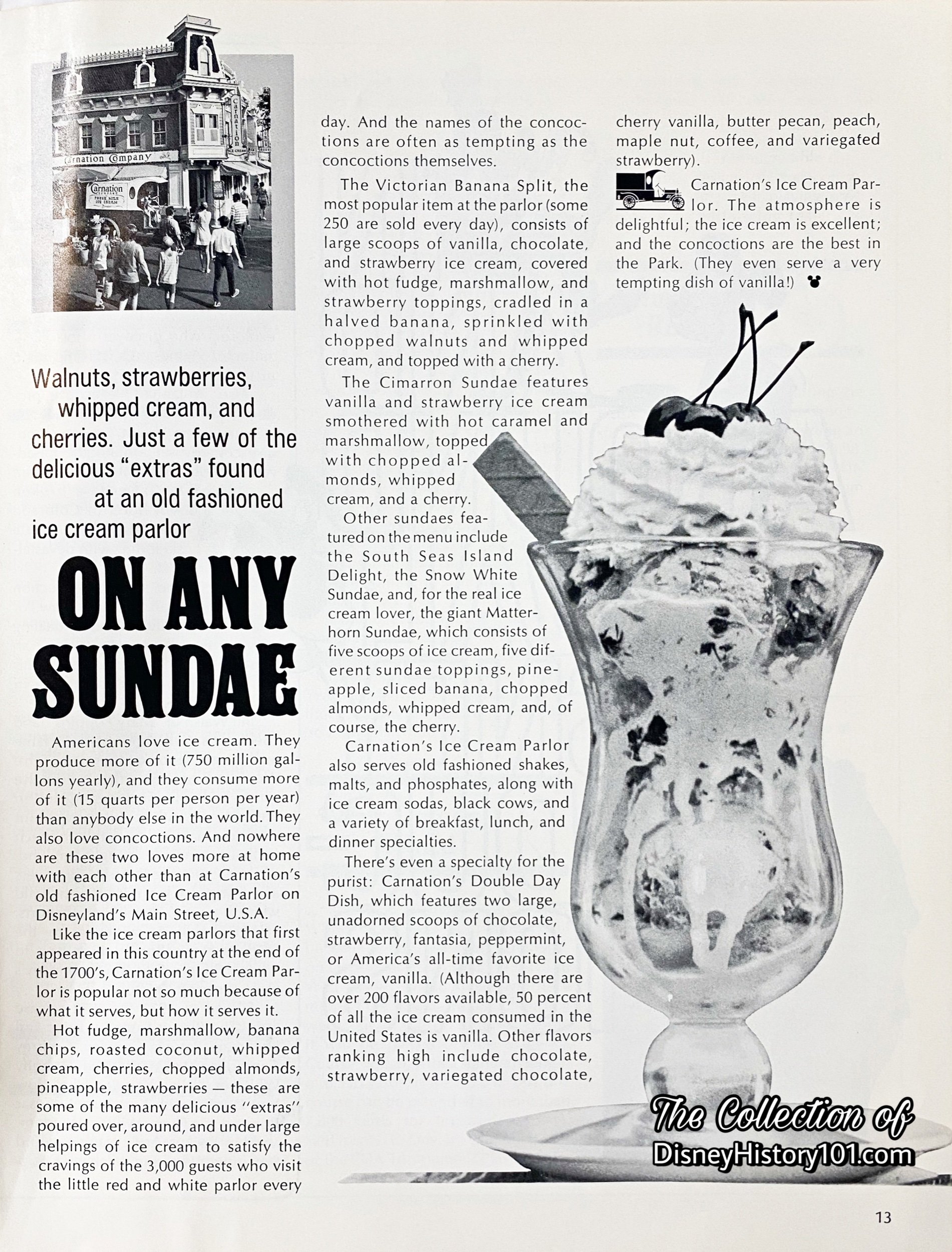
An article published in Disney News, 1971-1972.

Since the beginning, the Four Keys of the DISNEYLAND Show (operating priorities in presenting the DISNEYLAND Show) have been present - Courtesy, Safety, Show, and Efficiency. Guided by these Four Keys, are Walt Disney Imagineers, who are always seeking out new magical opportunities to increase the efficiency, safety, and show quality of Disneyland adventures.
“Maintenance”
In maintaining the magic after the Park closes, the staff take over with brooms, mops and dustcloths. Special attention was given to marred walls, posts and furniture. Items with marks that didn’t wash off were replaced or repainted. The Floors were waxed and buffed to preserve their beauty and protect them from the thousands of feet that scuffle over them each day.
“Rehabilitation”
By the year 1977, the Carnation Company remained a Disneyland Participant (providing Disneyland with its “name and quality food products”). However, management of the Table Service restaurant had long since been assumed by the Park. At this time, the Carnation Restaurant received new designs including a new entryway, a new waitress station, waiting area, and flow-through area to alleviate street traffic during parades, all courtesy of Tony Deleese of Planning. The rehab was performed by the staff of Disneyland Shops (The Maintenance Division at Disneyland).
During this time, the turnstile was eliminated, the front portion of the serving counter (which previously cured toward Sunkist Citrus House) was shortened and squared-off, the front portion of the restaurant was sectioned off by a decorative etched-glass partition, and the restaurant was now accessed by three sets of double doors (instead of just one main door). In addition, Disneyland LINE magazine (February 24, 1977) announced : “The street area between Carnation and the Clock and Candle Shops, once occupied by the Flower Market, will be filled in to provide a more complete outdoor dining patio. (The Flower Market has been moved across the street into the area between the Market House and Hallmark.) A three-foot, eight-inch high wooden fence will surround the patio, separating it from Main Street proper.” The Carnation Truck (which was moved rarely) was now parked near the Disneyland Central First Aid Center after the c.1977 restaurant rehabilitation.
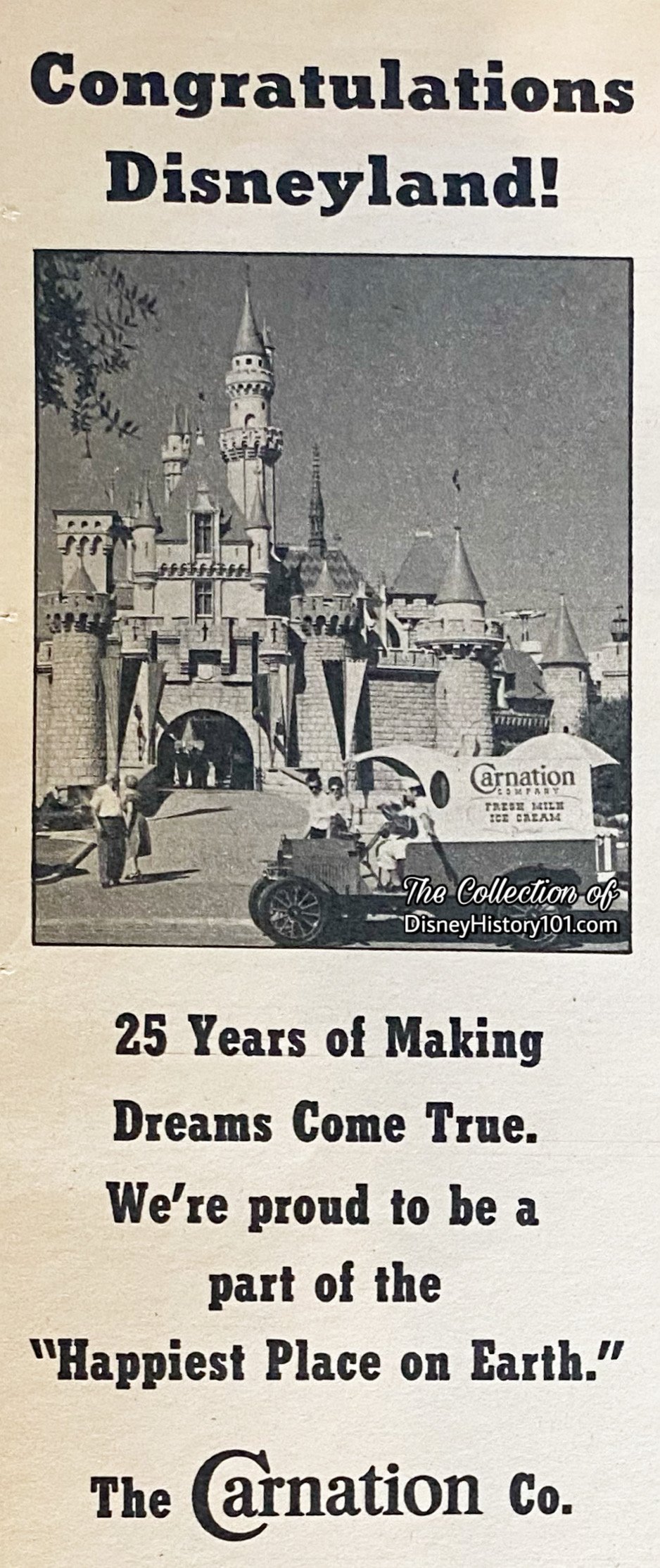
"Disneyland 25 - Happy Birthday to a Dream" supplement (published January of 1980).
By 1981, the Carnation Main Street breakfast menu offered:
•Traveler's Favorite (breakfast steak served with two eggs, golden brown potatoes and toast with butter and jelly)
•Conductor's Treat (Oscar Mayer ham served with two eggs, golden brown potatoes and toast with butter and jelly)
•Hometown Favorite (choice of bacon or sausage and two eggs served with golden brown potatoes and toast with butter and jelly)
•Turn of the Century (two eggs served with golden brown potatoes and toast with butter and jelly).
The Carnation Main Street Luncheon and Dinner menu offered:
•Grilled Steak Sandwich (grilled strip sirloin served open-faced on sourdough bread with a garden green salad and golden brown potatoes)
•Steak Monticello (grilled chopped steak topped with cheddar cheese, bacon crisps and served with garden green salad and golden brown potatoes)
•Count of Monte Cristo (sandwich of sliced turkey, ham and Jack cheese dipped in seasoned egg, grilled to a olden brown, sprinkled with powdered sugar, and served with fruit compote)
•From the Crossroads of America (pioneer favorite sandwich combining ground beef, diced avocado, onion, garlic and spices, stuffed in warm pita bread, topped with lettuce and tarato salad)
•Chicken Pita Sandwich (slices of tender chicken with American cheese, stuffed in warm pita bread, topped with diced avocado, lettuce and tomato salad)
•Avocado and Turkey (thin slices of turkey, combined with California avocado and lettuce on toasted whole wheat bread)
•Chicken Salad Sandwich (toasted whole wheat bread with chicken salad, crisp lettuce, alfalfa sprouts, carrot sticks and pickle spear)
•Avocado and Alfalfa Sprouts (a meatless sandwich with avocado, American cheese, lettuce, tomato and alfalfa sprouts with safflower mayonnaise, carrot sticks and pickle spear
•From the Kingdon of the Deep (tuna salad on rye bread served with pickle spear and corn chips)
•Egg Salad Sandwich (toasted whole wheat bread with egg salad, crisp lettuce, alfalfa sprouts, carrot sticks and pickle spear)
In 1981, the Carnation Main Street tum-of-the-century ice cream parlor with its breakfast and lunch menus produced $1,180,000 in revenue for Main Street Food. This was owning to VIPs of Disneyland (guests), its Main Street Foods hosts and hostesses (totaling 176 summer/118 fall), two Main Street Foods Stage Supervisors, and Main Street Foods Area Stage Supervisor.
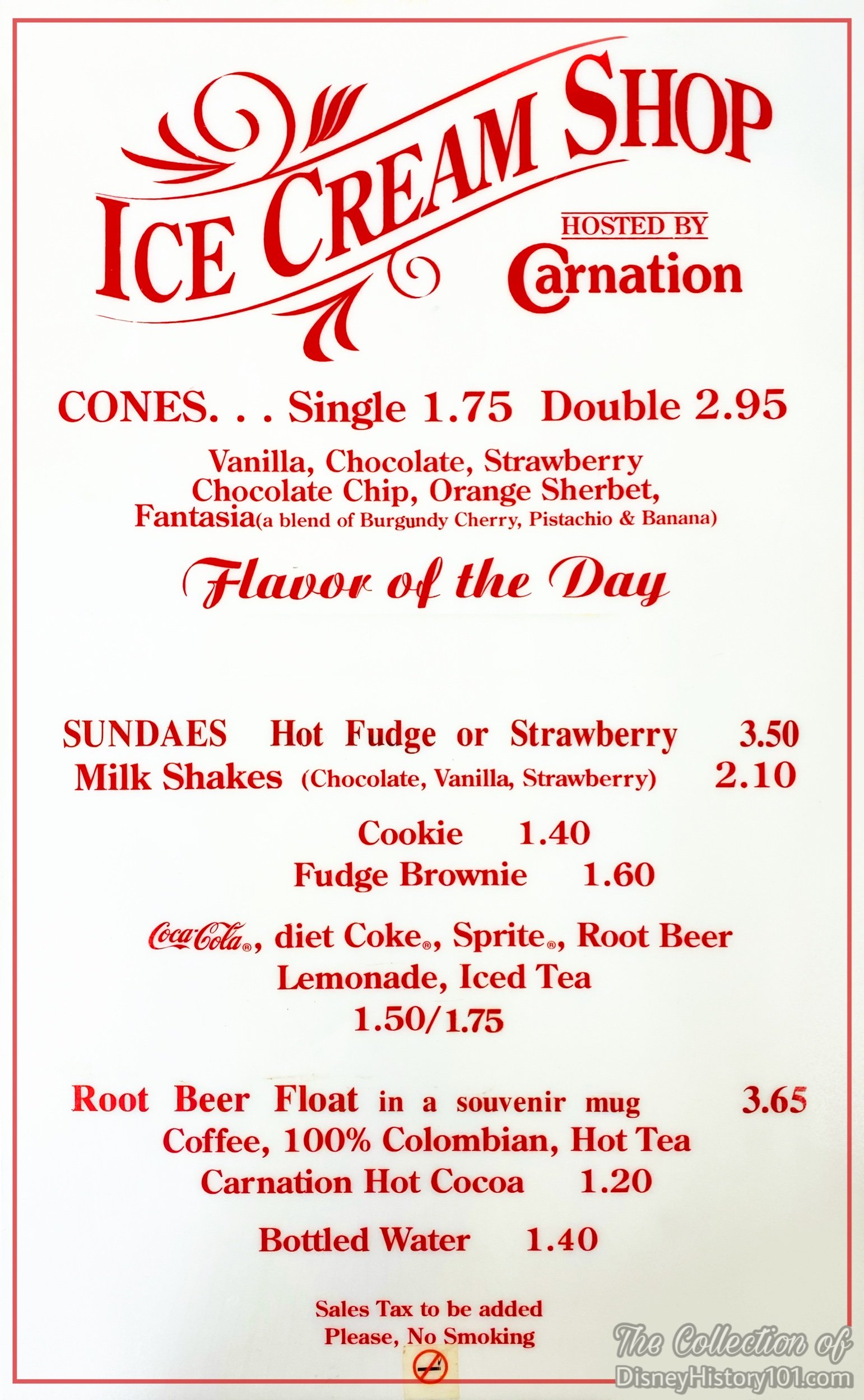

Carnation Company Truck Parked on the Plaza (Near Central First Aid); The truck appears here with Goofy in a photo published in Disney News, Summer 1992.
In 1985, a big change occurred when the Carnation Company was purchased by Nestle* (the largest marketer of food products in Europe). A year later, Carnation Ice Cream Parlor continued to occasionally host special events like Private Parties (e.g. GM and Hughes Employees, January of 1986).
By 1986, Carnation on Main Street was one of two Park locations that served breakfast for the convenience of Guests.
Four years later (by 1990), the Carnation Ice Cream Parlor was one of several locations contributing to the purchase of more than 3.2 million servings of ice cream annually at Disneyland. That same year (1990), individuals (like Pete Clark of Disneyland Participant Affairs Division, hired 1957) were maintaining the ongoing relationship between Disneyland and four lessee operations, as well as 20 participants like Carnation Farms. That year, Pete offered plaudits for Carnation (to Disneyland LINE Magazine, Vol. 22, No. 11 ; March 16, 1990) : “The name Carnation means quality to people. Guests are comfortable with it and expect and get a special experience.” About this same time, healthier menu options were made available to guests through Carnation - Avocado and Alfalfa Sprout Sandwiches, Marinated Boneless Breast of Chicken (Conductor’s Treat), and Avocado and Turkey Sandwiches. As a Participant, Carnation was also a co-sponsor of the Disneyland Baby Care Center, as its baby formulas were made available to visiting guests during this era.
*As a sidelight, Nestle signed an 11-year licensing agreement with The Walt Disney Company, in January of 1990. The Walt Disney Company 1990 First Quarter Report divulged that “by early 1991 Nestle will be Disney’s exclusive food products and promotional licensee in Europe and the Middle East.”
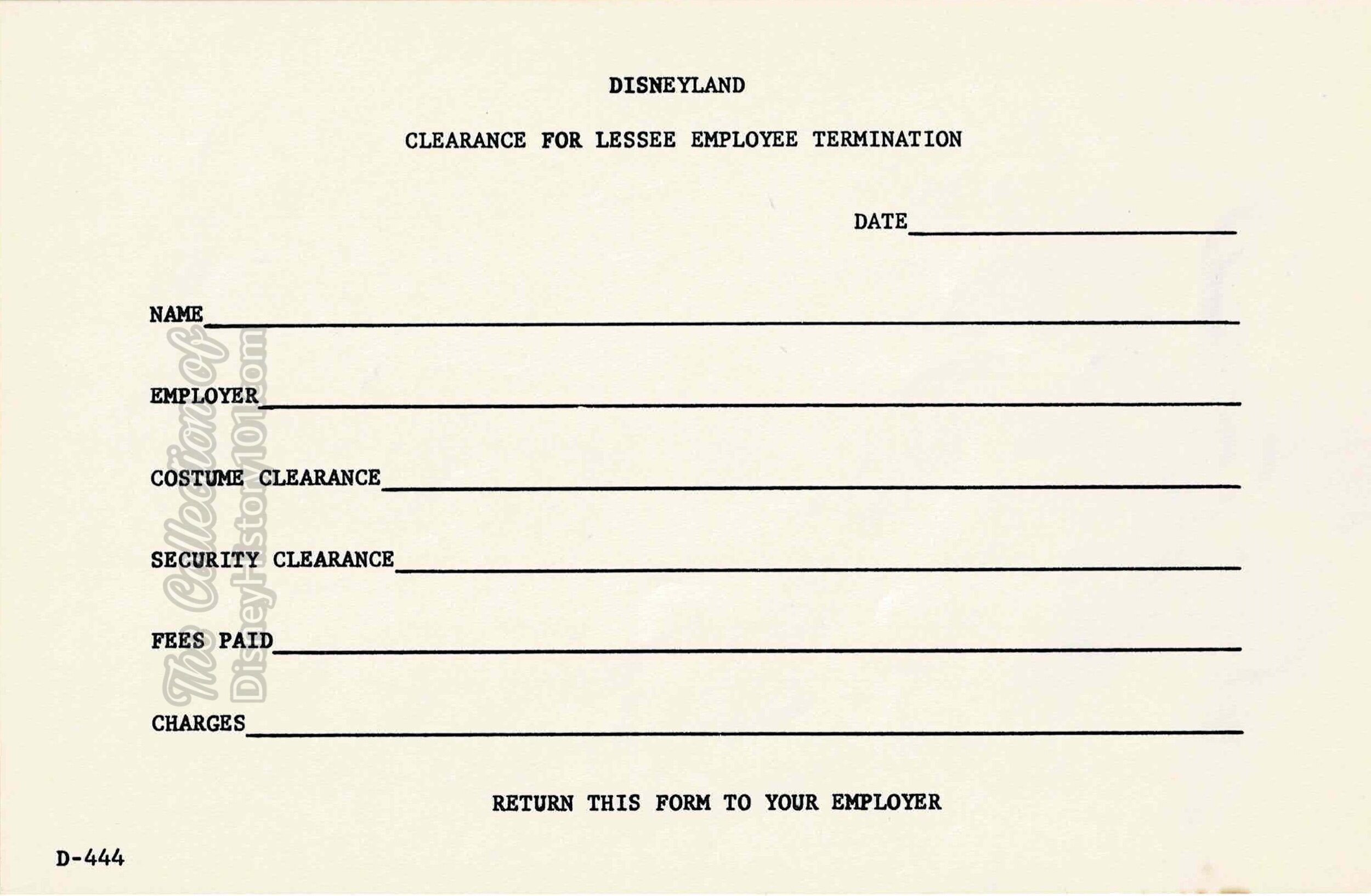
"Clearance for Disneyland Employee Lessee Termination" Form (D-444) once used for termination of individual Lessee Employees of Disneyland
The synergistic Partnership lasted seven more good years, owing to Pete Clark (Senior President of Disneyland Participant Affairs Division), Jennifer Gray (Participant Relations Manager), and their team. But alas, Disneyland Participant Affairs and Opening Day Participant Carnation Farms ultimately could not negotiate a new cooperative agreement to maintain their ongoing relationship). All good things must come to an end, including the Plaza Gardens hosted by Carnation, the Main Street Cone Shop hosted by Carnation, the Stroller Shop hosted by Carnation Infant Formula, and the Carnation Ice Cream Parlor and Restaurant hosted by Carnation. However, Carnation’s departure opened the doors for a new Disneyland Participant sponsor.
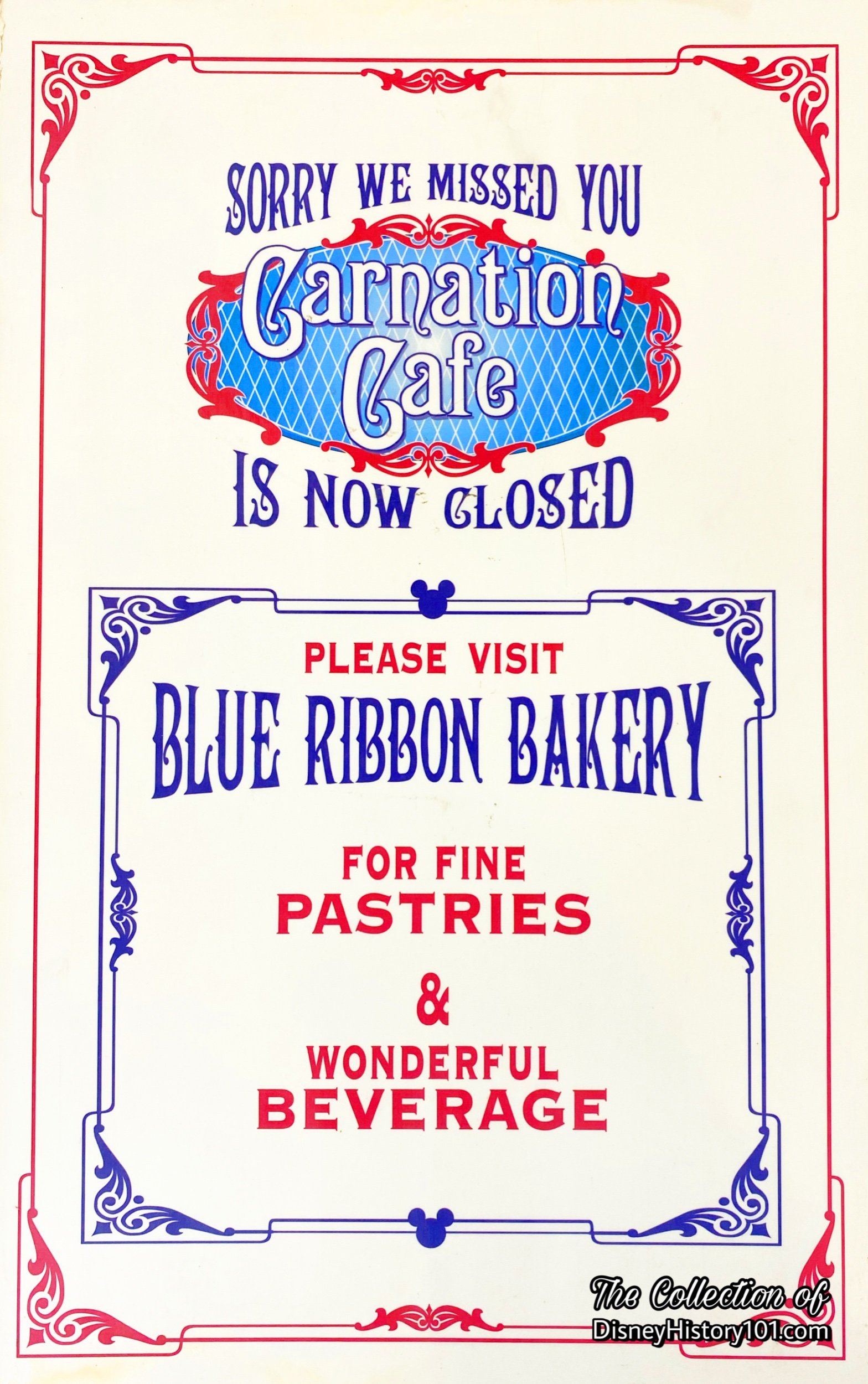
However, this isn’t the end of our Carnation-Disneyland story!

Signage that was looking pretty worn and stressed was replaced.
Soon, the quick-service Blue Ribbon Bakery food operation hosted by Nestlé Toll House occupied the address and space (opening March 21, 1997).
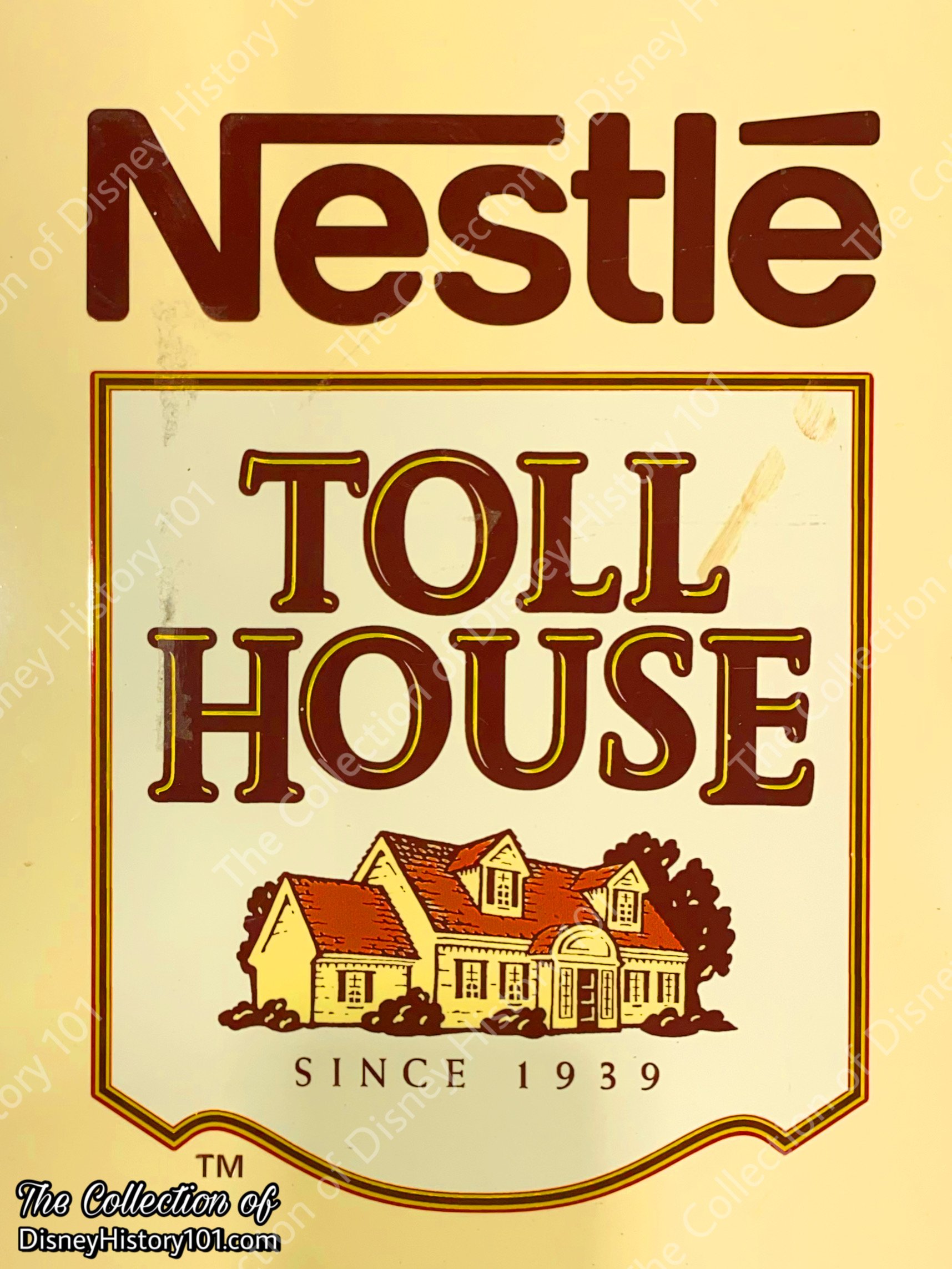
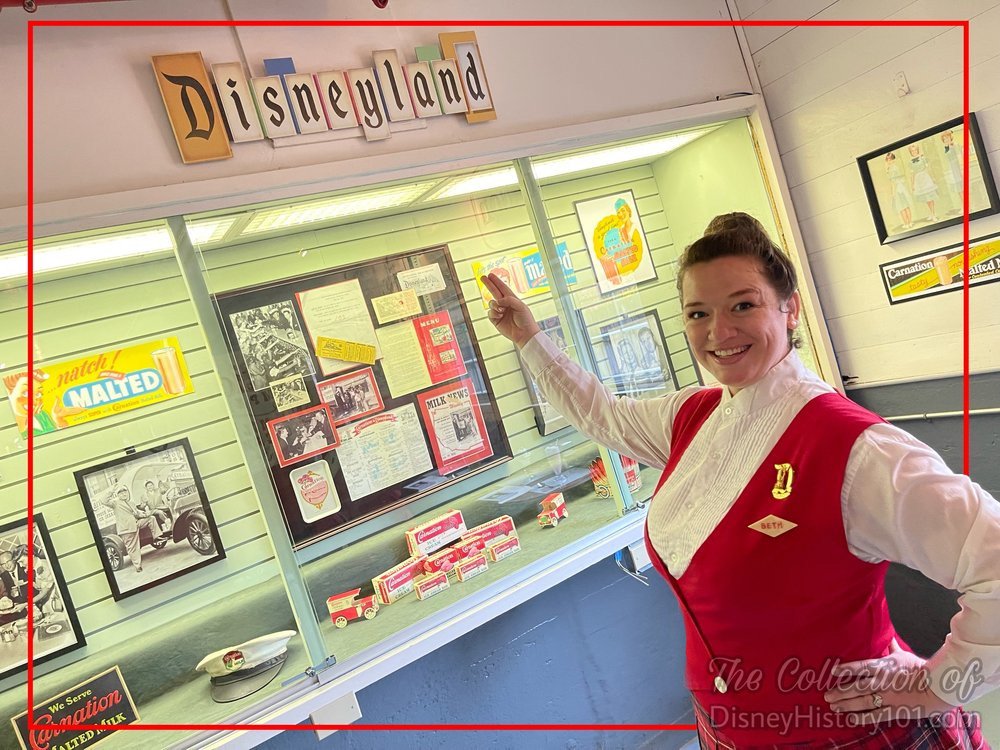
Carnation Farms Museum Disneyland Exhibit
The “cherry on top” of the Disneyland-Carnation story, is that several artifacts of the Disneyland Carnation Ice Cream Parlor are being preserved and are on exhibition at the Carnation Farms Carriage Museum in the town of Carnation, Washington! Included are numerous rarely-seen Press Release photographs (from Carnation Farms Museum Archives), Creation Ice Cream Parlor menus, and even a Carnation Ice Cream Parlor Tray (once used to pay the bill).
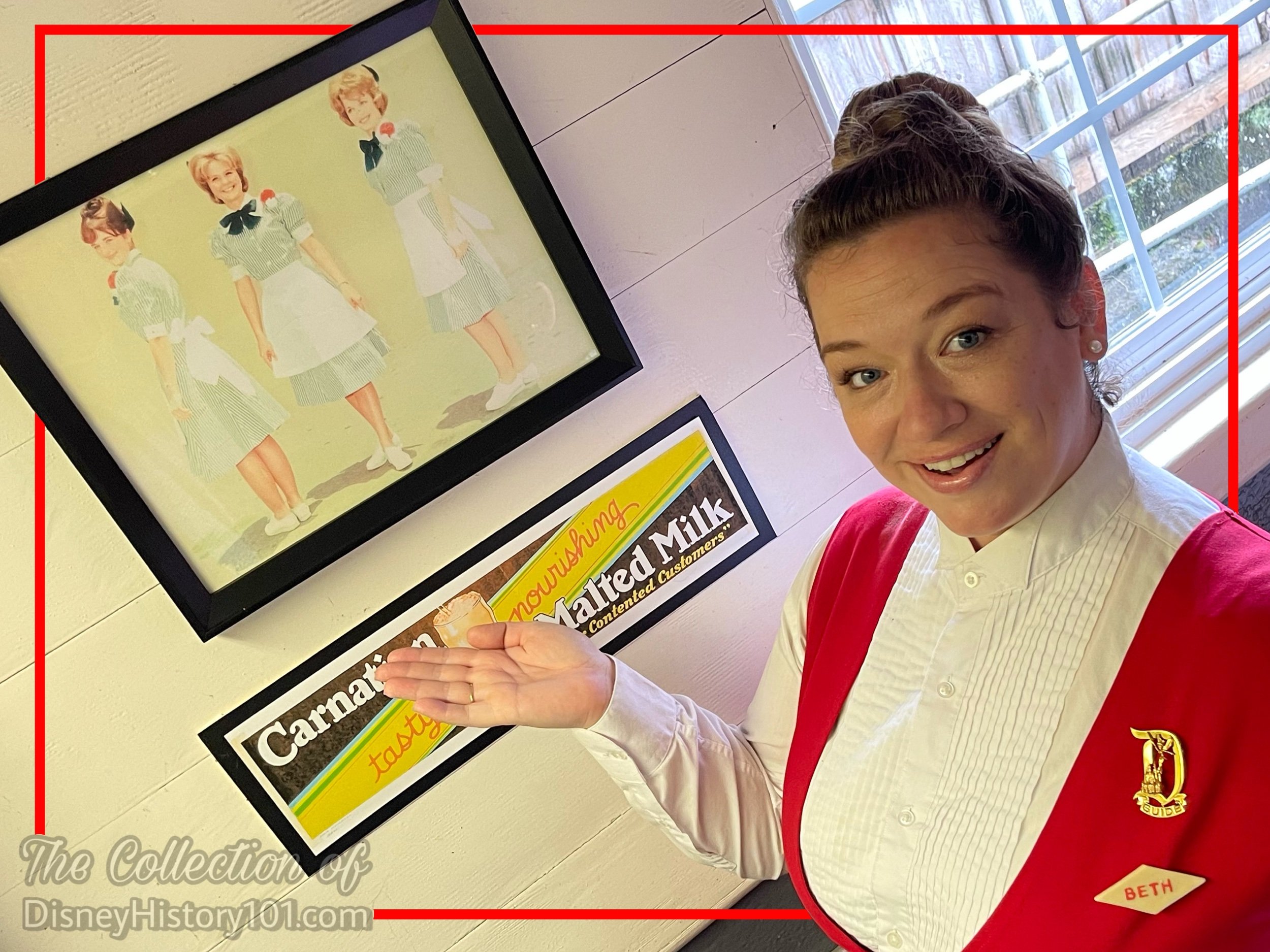
Carnation Farms Museum Disneyland Exhibit
The exhibit also preserves the “Disney Look” of the memorable original Carnation Ice Cream Parlor Hostess Costume.
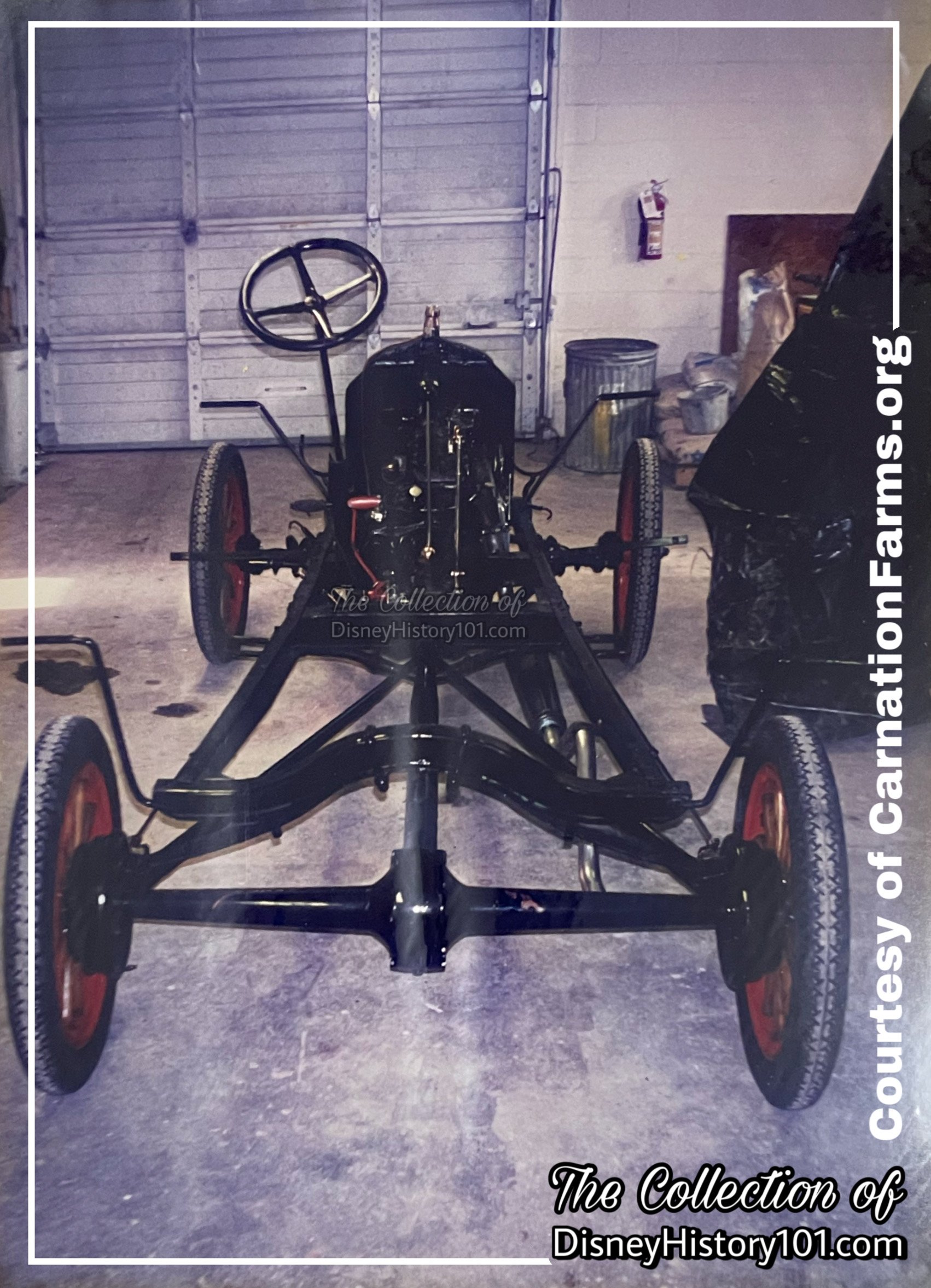
Carnation Truck Exhibit Chassis
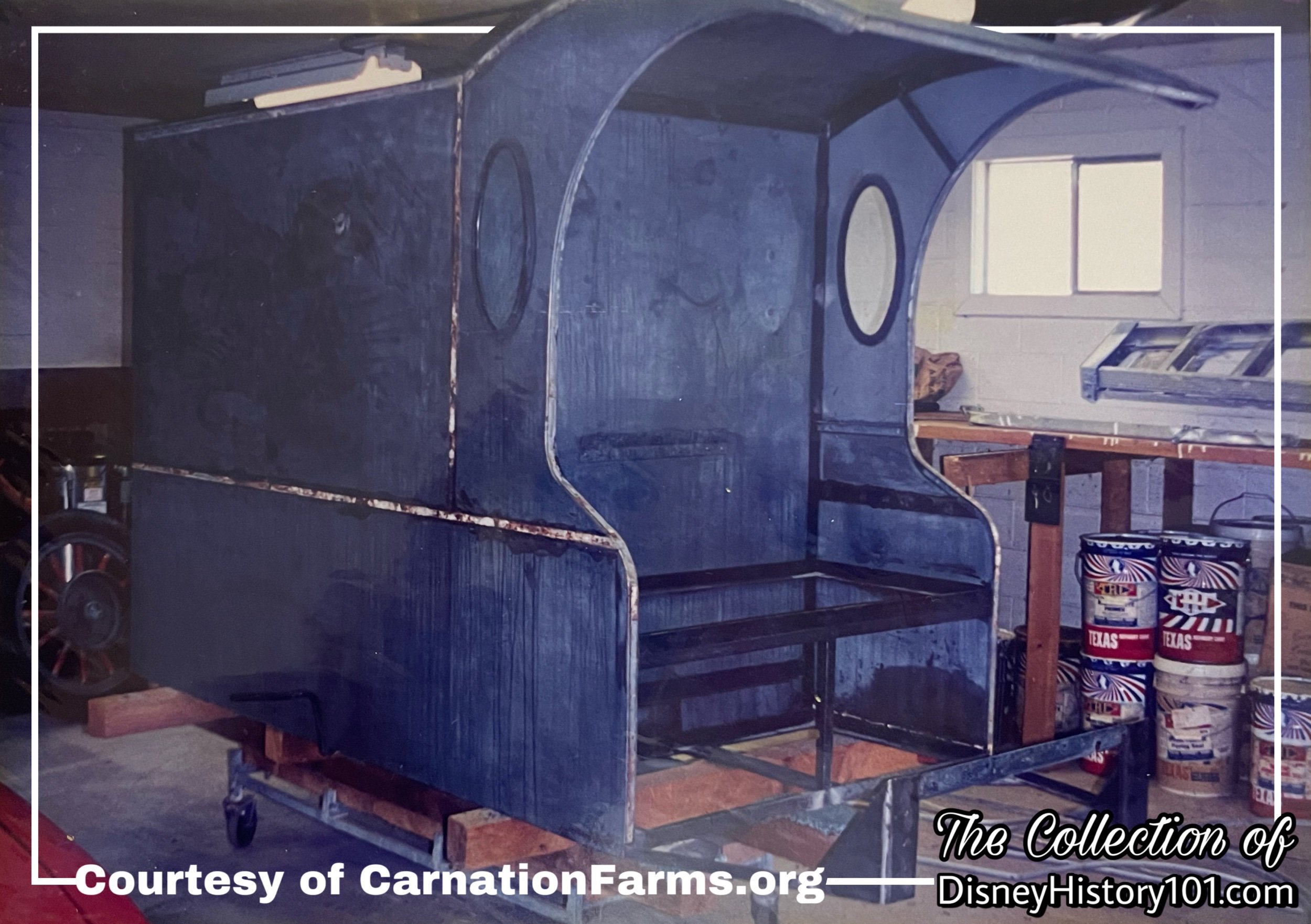
Carnation Truck Exhibit "Special Delivery Body"
In the preceding photo, the Carnation Truck “Special Delivery Body” section has been removed from the chassis and is prepared for stripping.
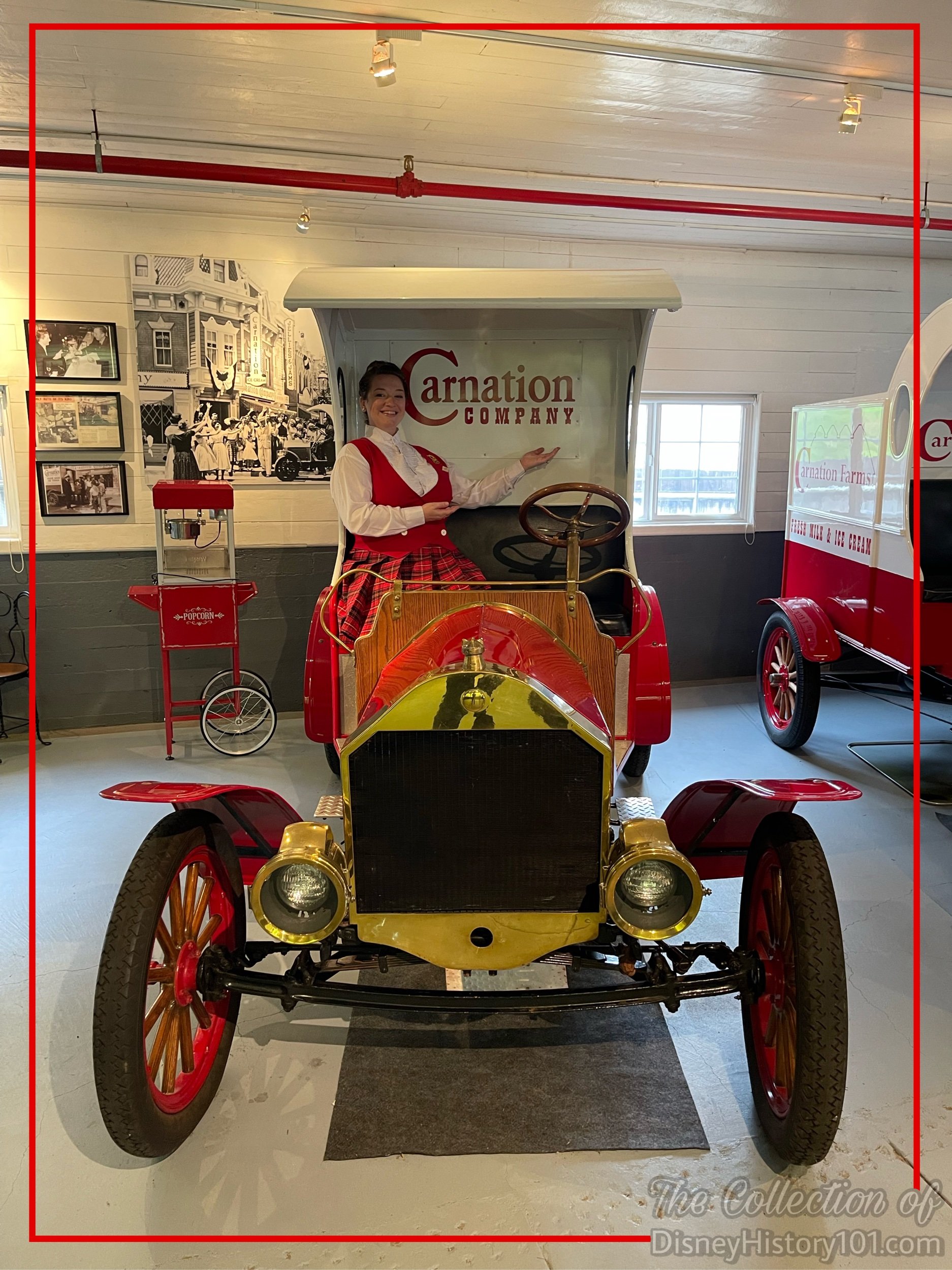
Carnation Company Truck Exhibit, Carnation Farms Carriage Museum
There is no doubt that the crowning artifact of the Carnation Farms Museum is the Carnation Company Truck Exhibit which once supported the Carnation Ice Cream Parlor at Disneyland! Please step this way, as we examine a few “highlights and sidelights” of this wonderfully restored Disneyland museum piece.
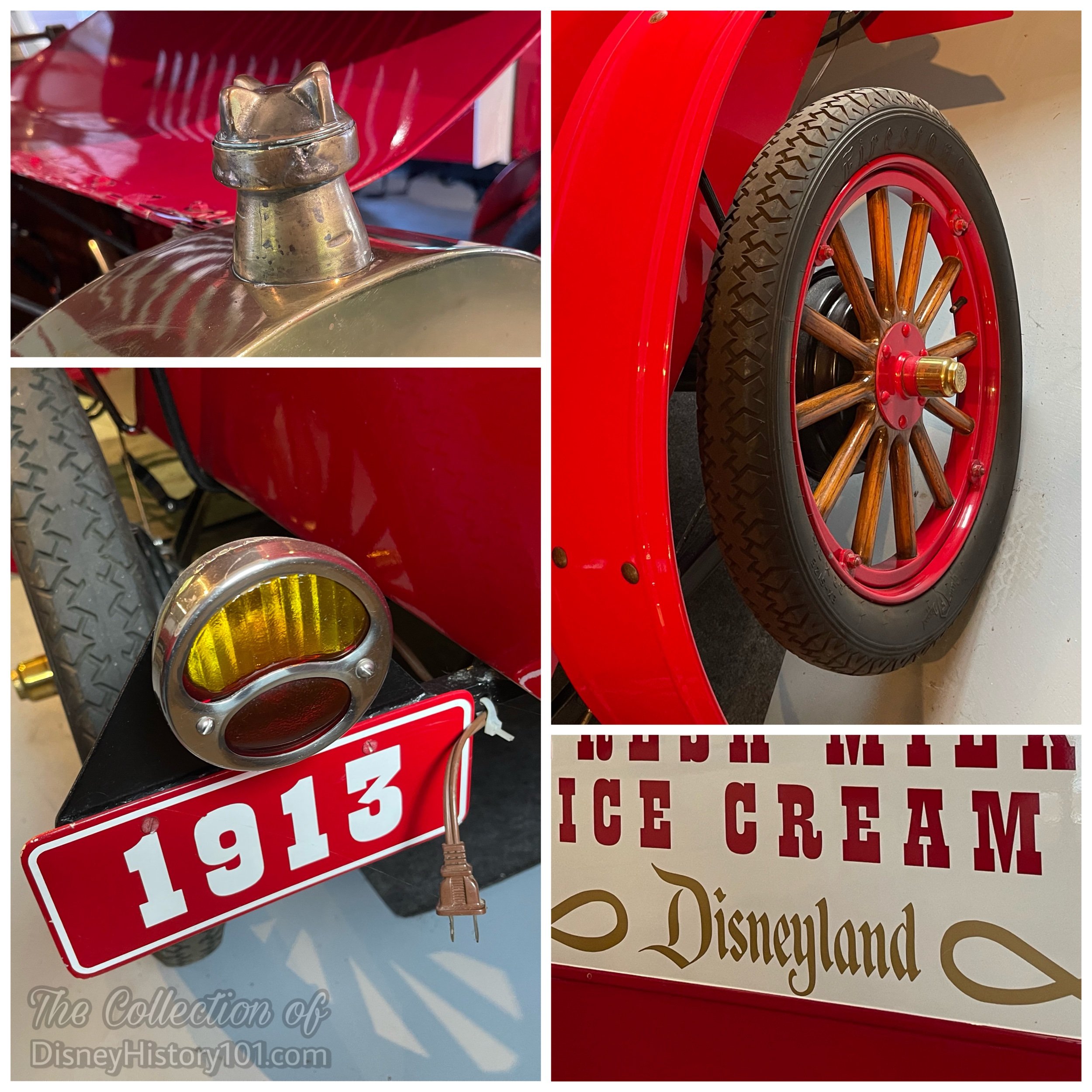
Carnation Company Truck Exhibit, Carnation Farms Carriage Museum
If you ever walked about this exhibit during its Disneyland days, the smallest of details may be impressed upon your memory. You may recall the unique shape of the original radiator filler cap and flange, or the words “Carnation Company Ice Cream Truck - Disneyland” painted on the side. There are however, a few differences in the present.
The old Gurrmobile is currently still outfitted with“narrow high pressure tires,” though these are brand new. Also, the original red wooden spokes have been sanded (during restoration), to reveal the original wood grain underneath. As for the original license plate and number (which read “1639”), as well as the original rear lamps, all have been replaced.
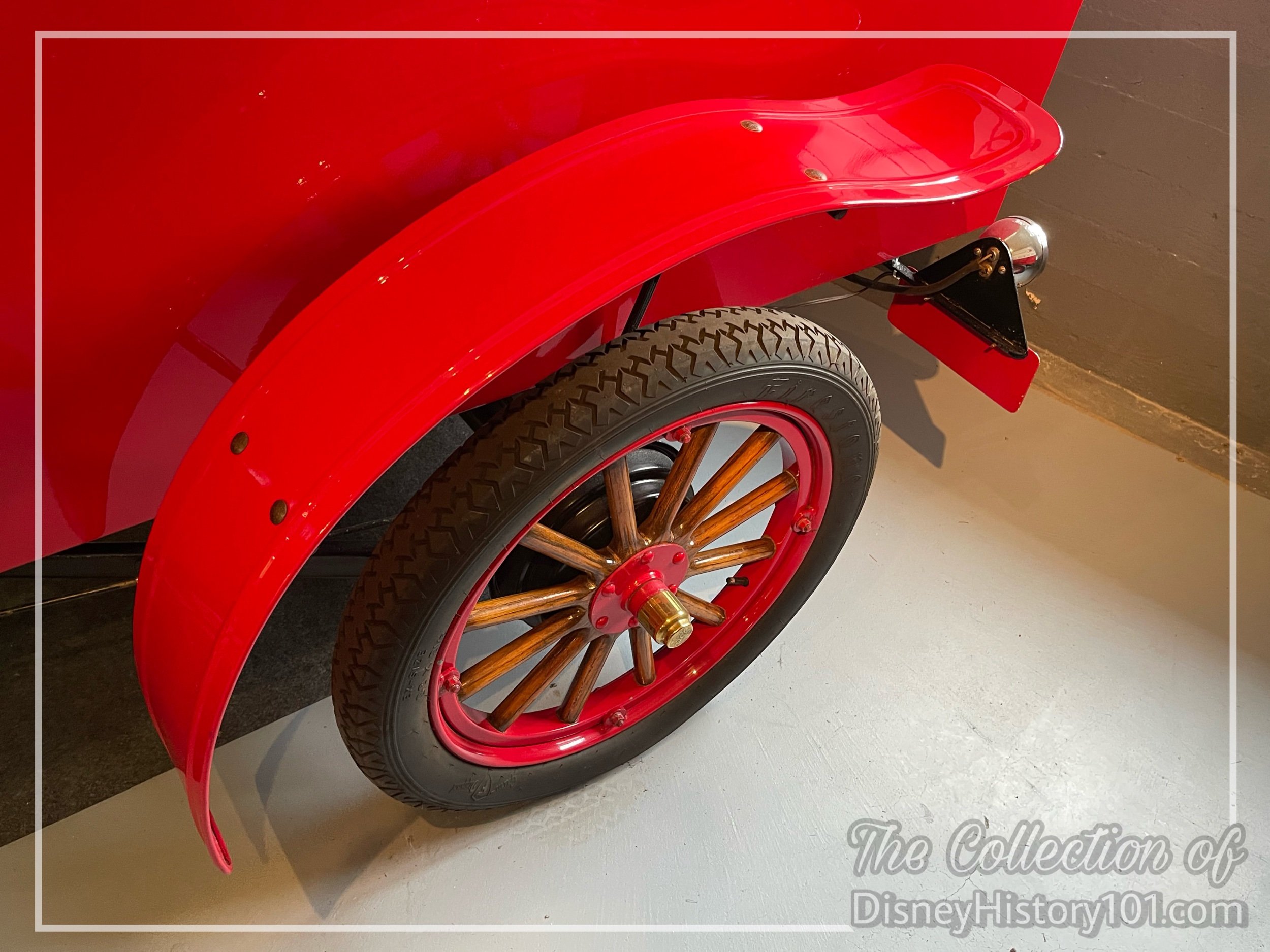
Carnation Company Truck Exhibit, Carnation Farms Carriage Museum
The Carnation-red high fenders (and running board) of this Gurrmobile were designed with a slight upward flair - more so than true-life c.1908 Carnation Ford delivery trucks.
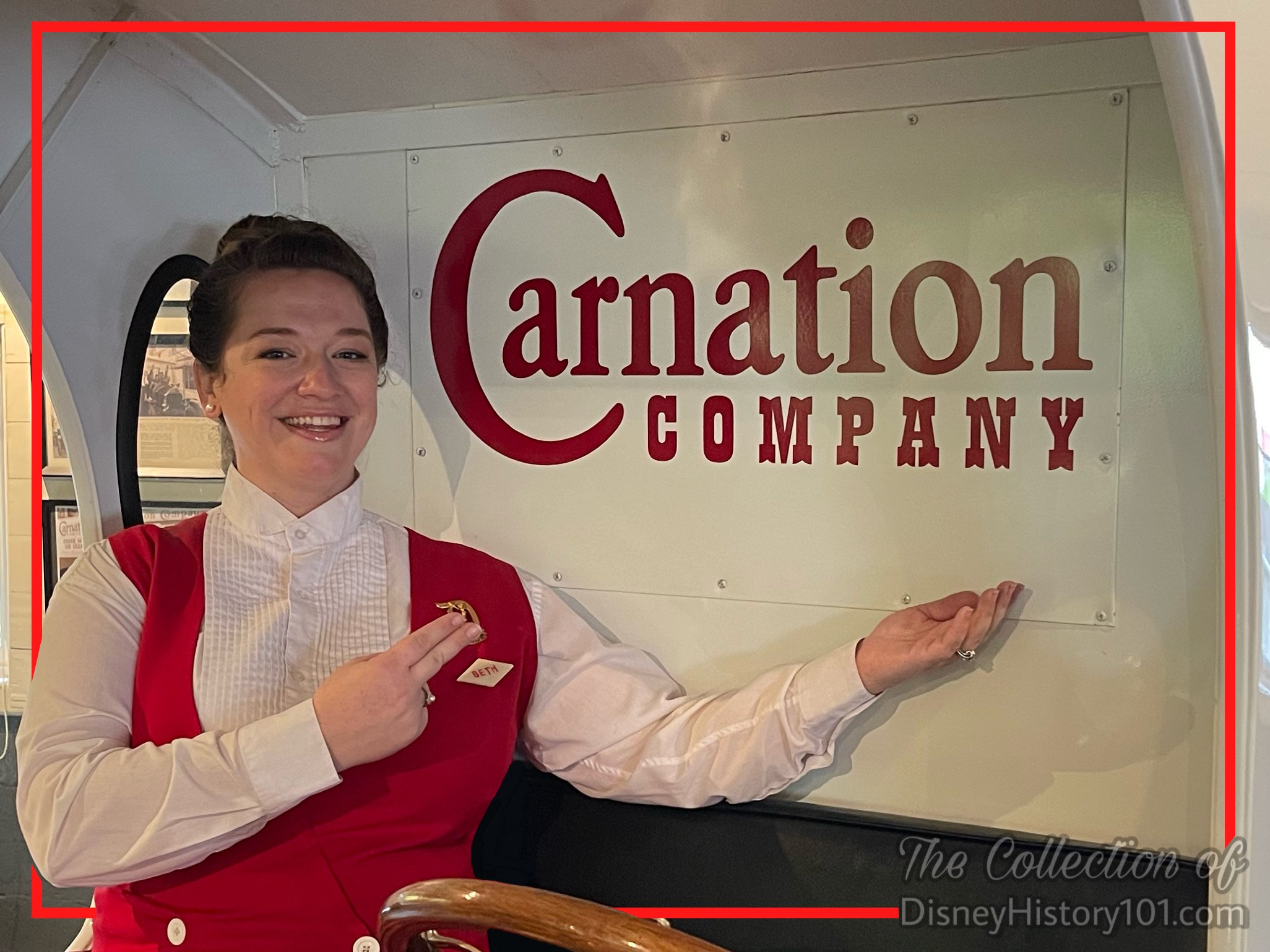
Carnation Company Plaque, Carnation Farms Carriage Museum
When the Carnation Farms Museum Staff restored the Truck Exhibit, it was decided to retain the size of the original Carnation Company Plaque (fastened in the very same rivet holes). Most visitors will not notice, that while the font is also very similar, it was decided to reposition the letters slightly, varying from those of the Disneyland-era.
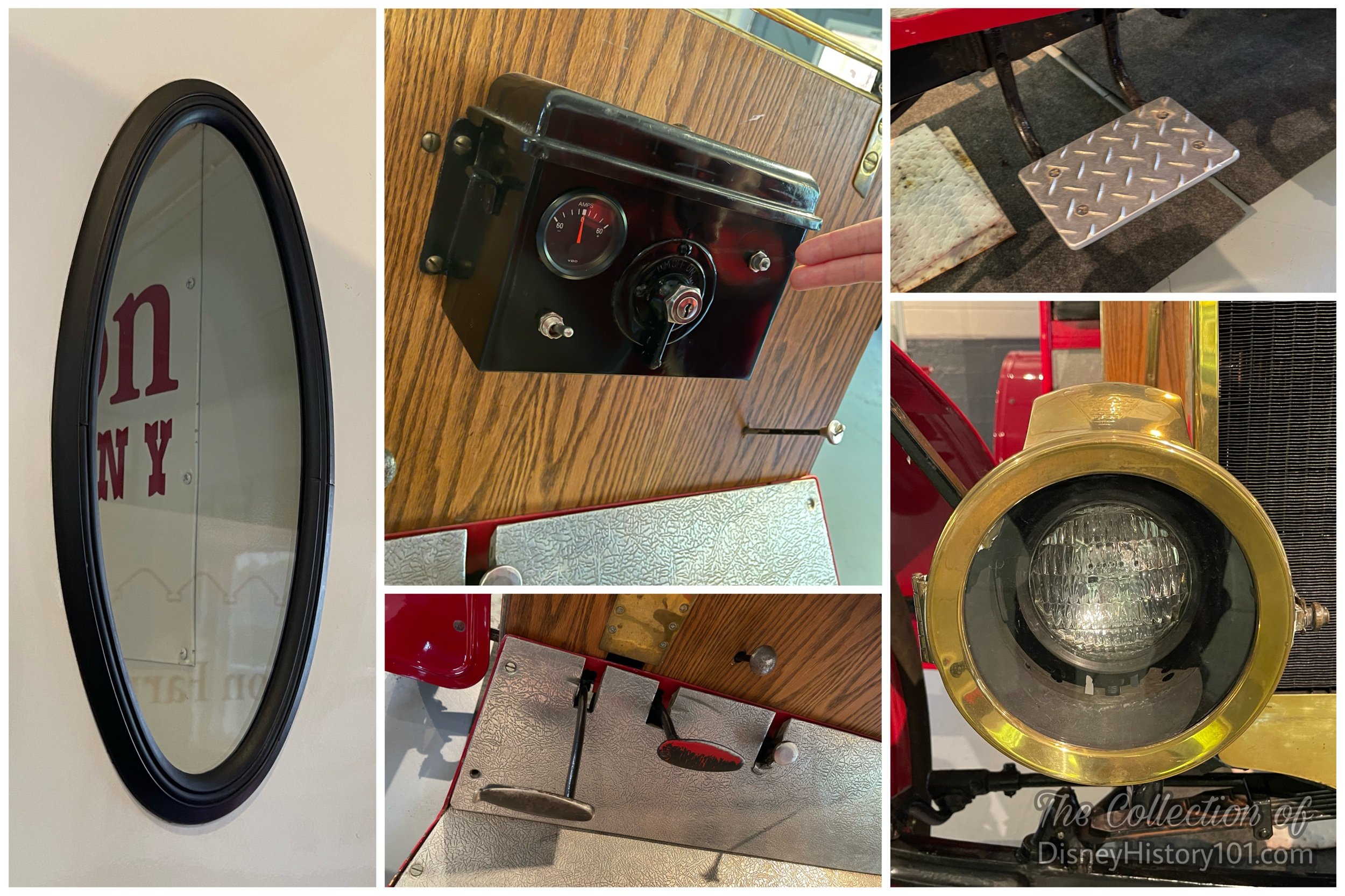
Carnation Company Truck Exhibit, Carnation Farms Carriage Museum
The windows, step plate, as well as clutch and brake pedals look familiar. But gone are the original “resplendent set of brass coal oil head lamps” (which seem to have disappeared sometime after the truck was relocated to the Backstage Disneyland “Boneyard”) as well as the old “bulb-type” horn (which seemed to have vanished similarly).
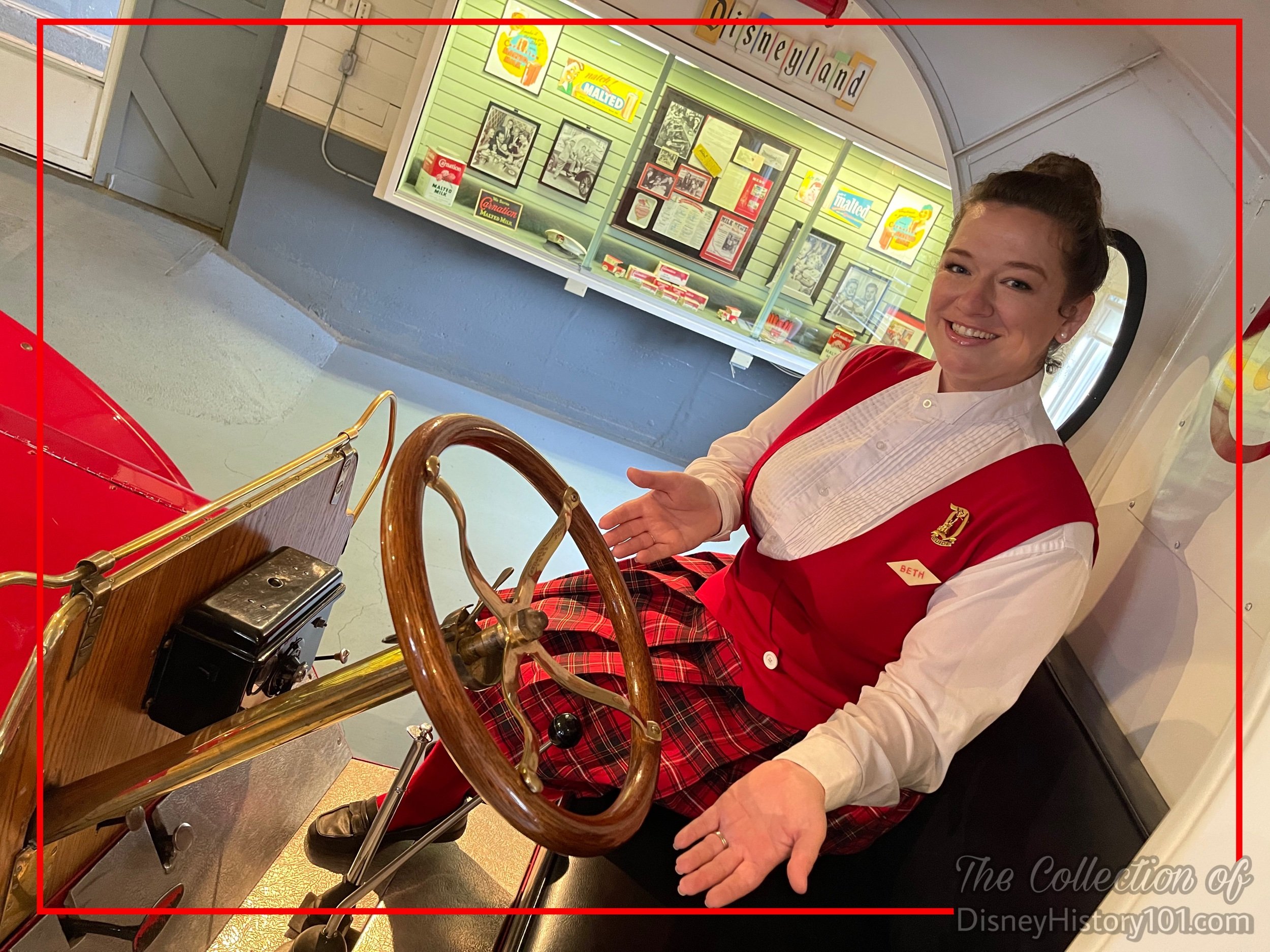
Carnation Company Truck Exhibit Steering Wheel and Column, Carnation Farms Carriage Museum
While the addition of a bulb-type horn was not included in the rehabilitation, the lemon wood steering wheel (as well as brass steering column assembly and spark throttle lever) was restored to its original luster!
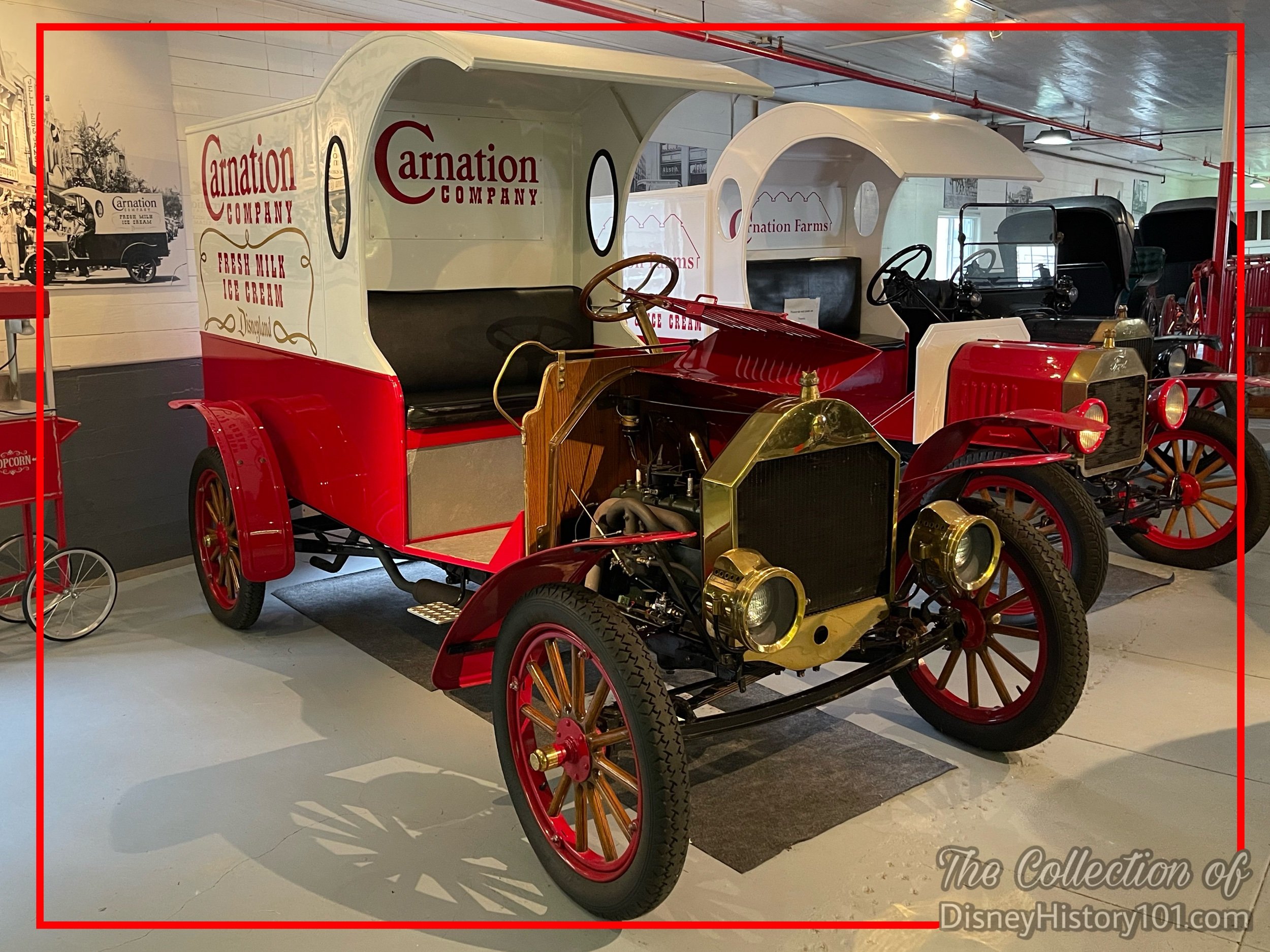
Carnation Company Truck Exhibit, Carnation Farms Carriage Museum
The original brass engine crank handle had also disappeared before the exhibit was acquired by the Carnation Farms Museum Archives. However, the engine (though restored with some new parts) is similar to the original.
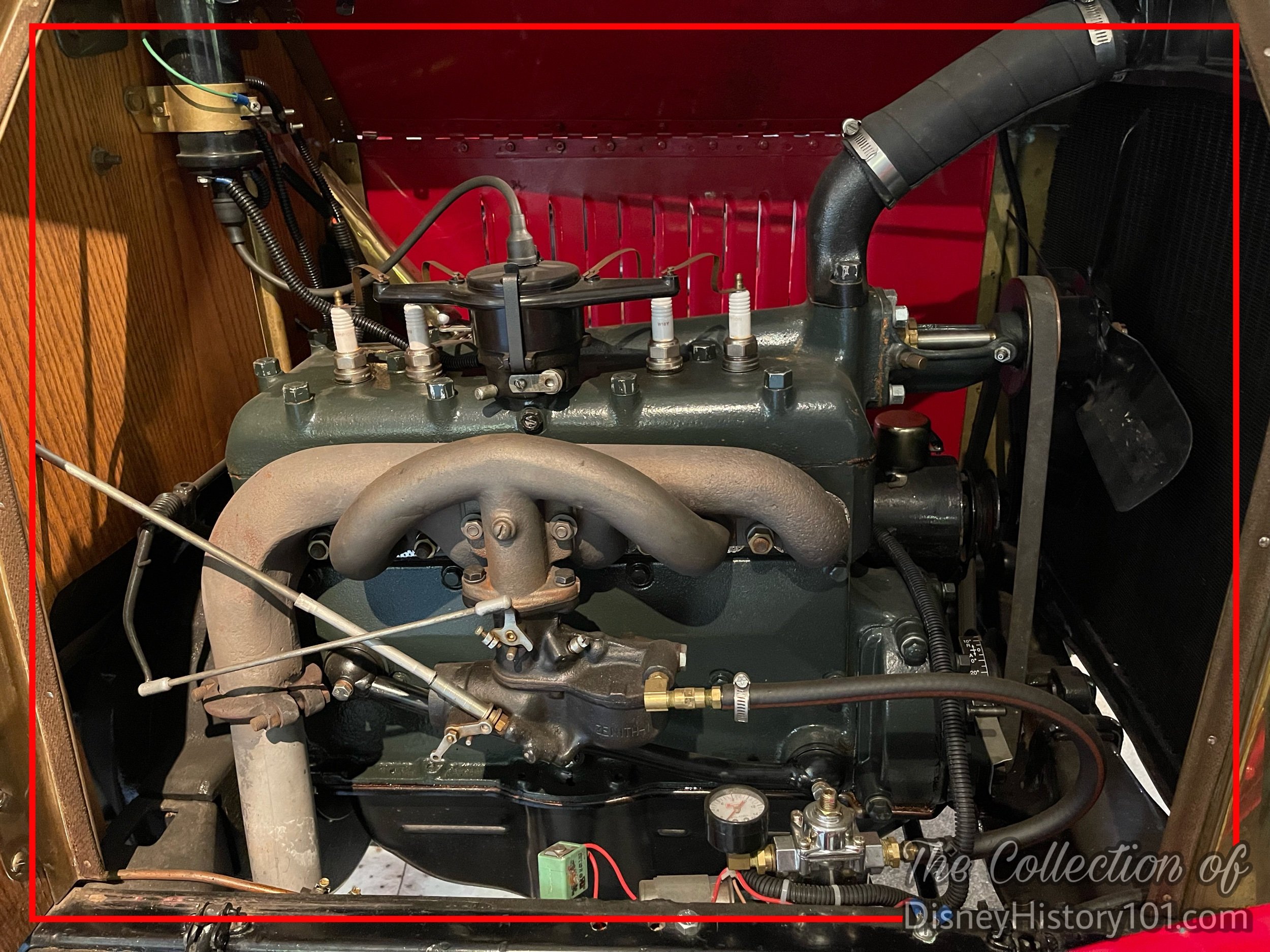
Carnation Company Truck Exhibit Engine, Carnation Farms Carriage Museum
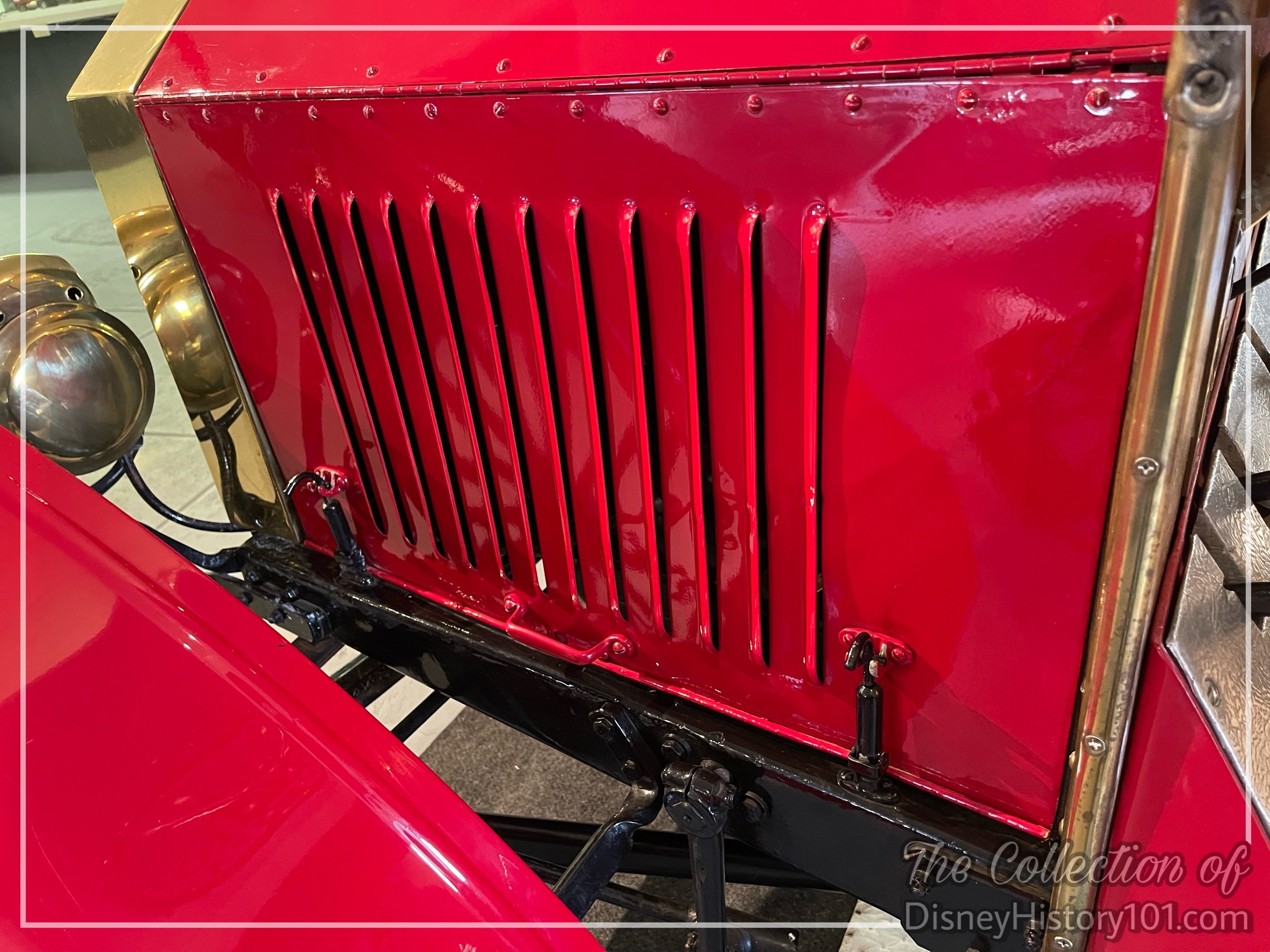
Carnation Farms Carriage Museum
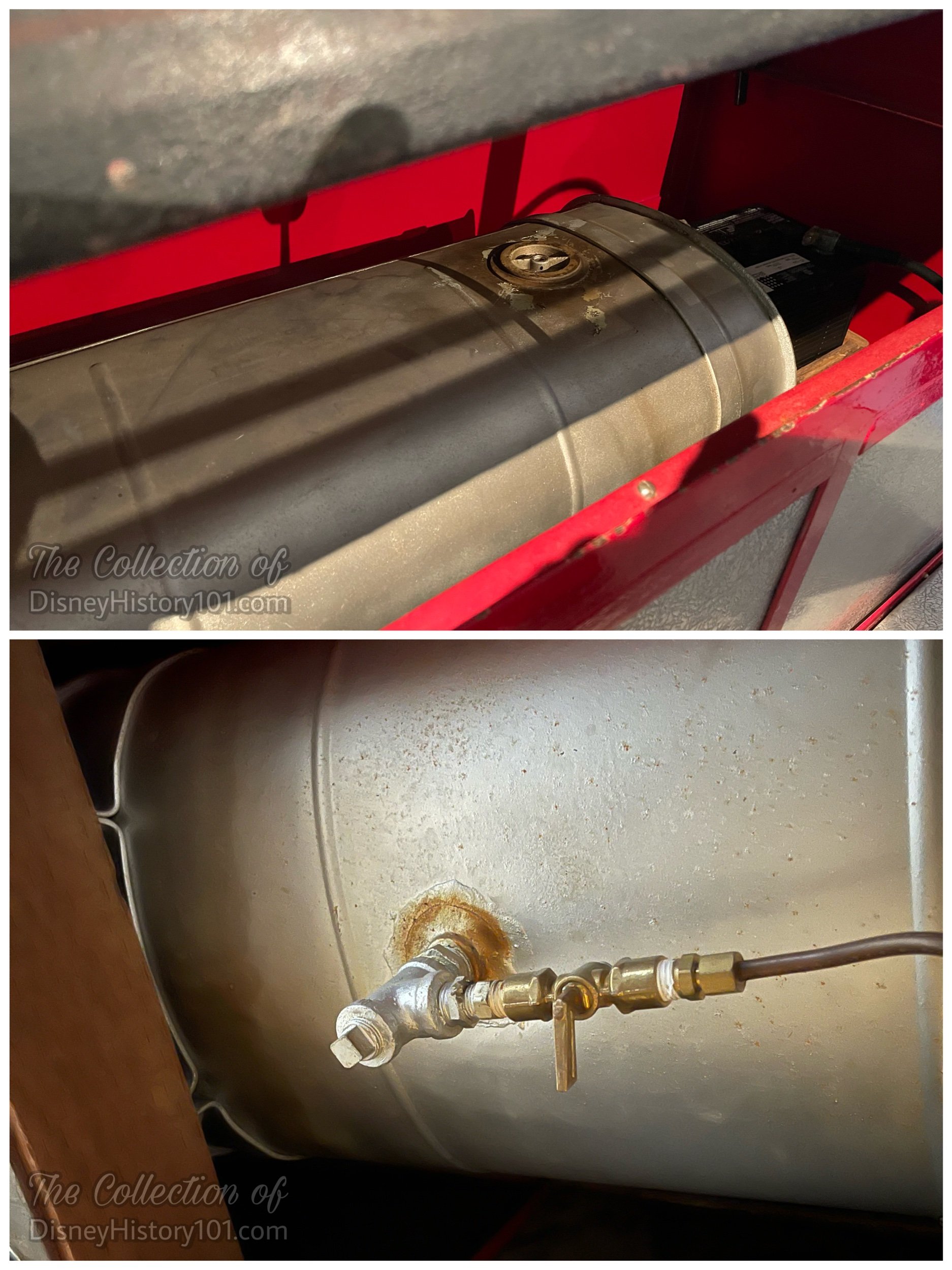
Carnation Company Truck Exhibit, Carnation Farms Carriage Museum
The gasoline tank (seen from the undercarriage in the bottom image) was conveniently accessed by lifting the driver’s bench cushion (seen in the upper image) in early Ford truck models. Bob Gurr and Carnation Shop Staff approved this feature in their designs. A battery is similarly tucked away next to the gasoline tank.
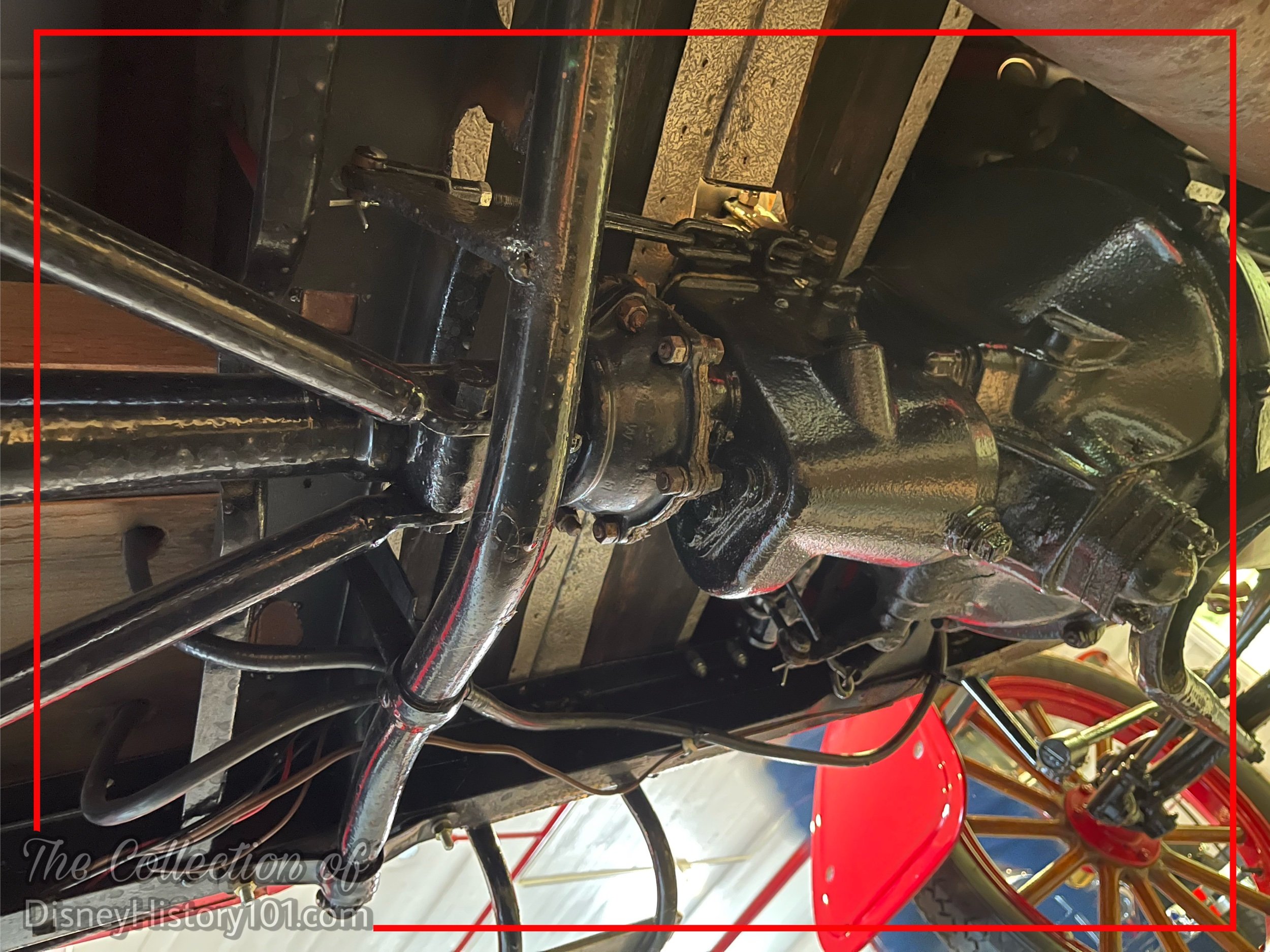
Carnation Company Truck Exhibit Undercarriage, Carnation Farms Carriage Museum
A look at the undercarriage reveals just a glimpse of the original shortened chassis (with axles and frame) as well as all those rarely seen parts - most noticeably, the transmission case, joint and spline, and other moving parts.
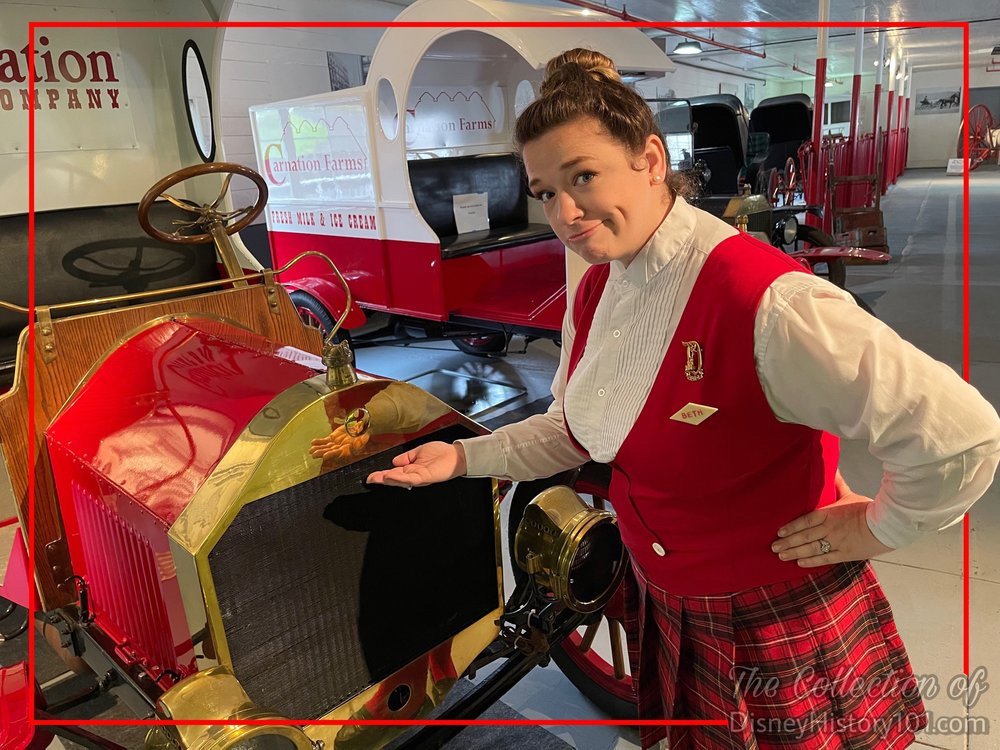
Former Site of the "Gurrmobile" Name on Carnation Company Truck Exhibit, Carnation Farms Carriage Museum
You may remember that the word “Gurrmobile” was once carved on this metal “nameplate” on the front of the Radiator. According to Elbridge Stuart (the son of E. Hadley Stuart, Jr., the truck ornament read “The Gurrmobile Company - Los Angeles.” The official Press Release (prepared by Bob Riverbark of Carnation Company Headquarters, c. 1955), elaborated : “Carnation Company… put a small ‘Gurrmobile’ name plate on the truck to honor Bob Gurr, Walt Disney’s Director of Special Vehicle Development who produced the two inch stack of engineer and artist drawings from which it was built.”
Alas, by the early 1970s, Bob’s name had been polished away by Disneyland Maintenance Department Staff, and in the present, no trace of this one-time homage remains.
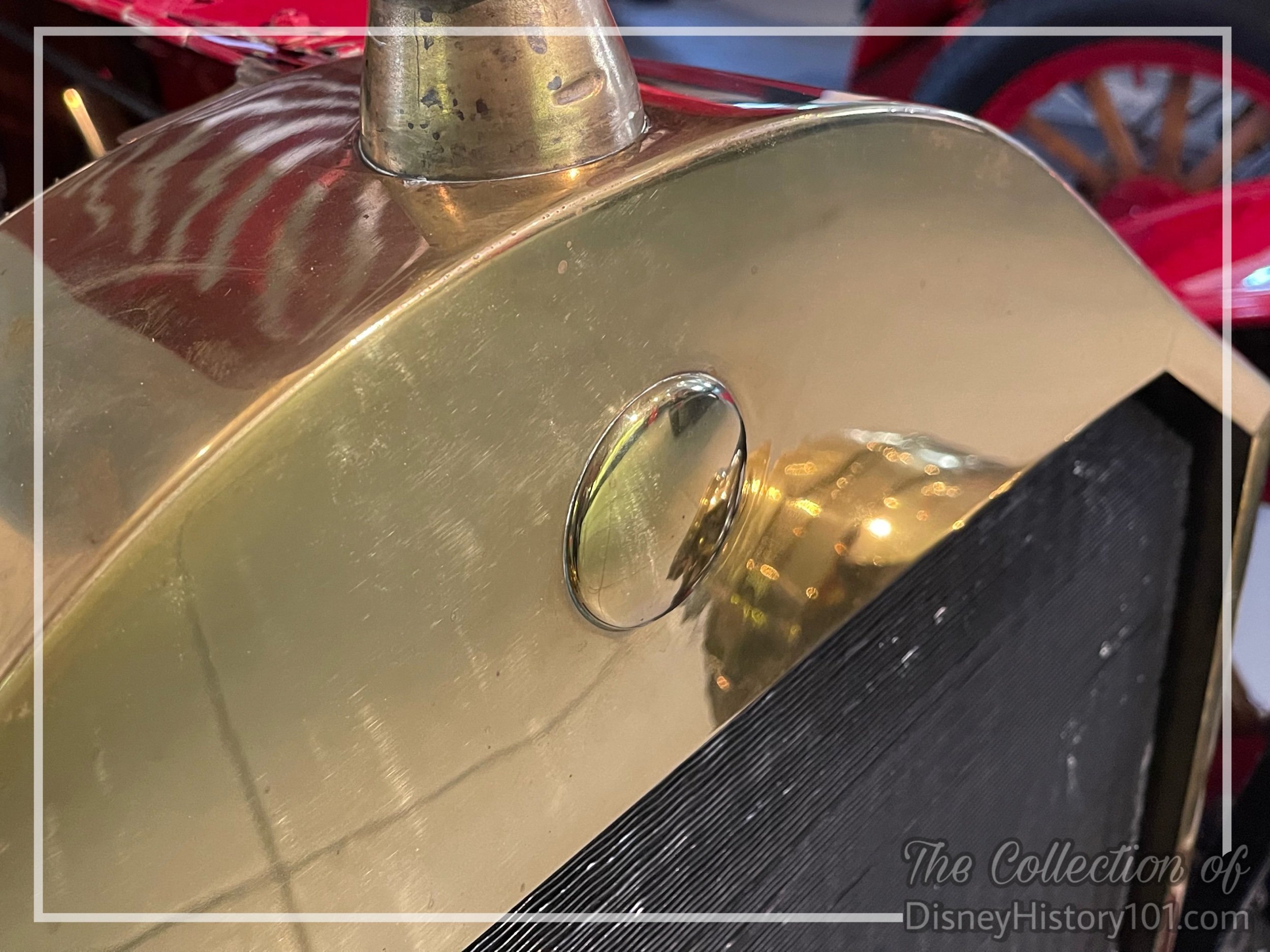
Former Site of the "Gurrmobile" Name on Carnation Company Truck Exhibit, Carnation Farms Carriage Museum
A whole lot of work went into restoring and rehabilitating the Carnation Truck Exhibit to its current state. Much of this was headed by Carnation Farms Museum Volunteer and Archivist Bob Costers.
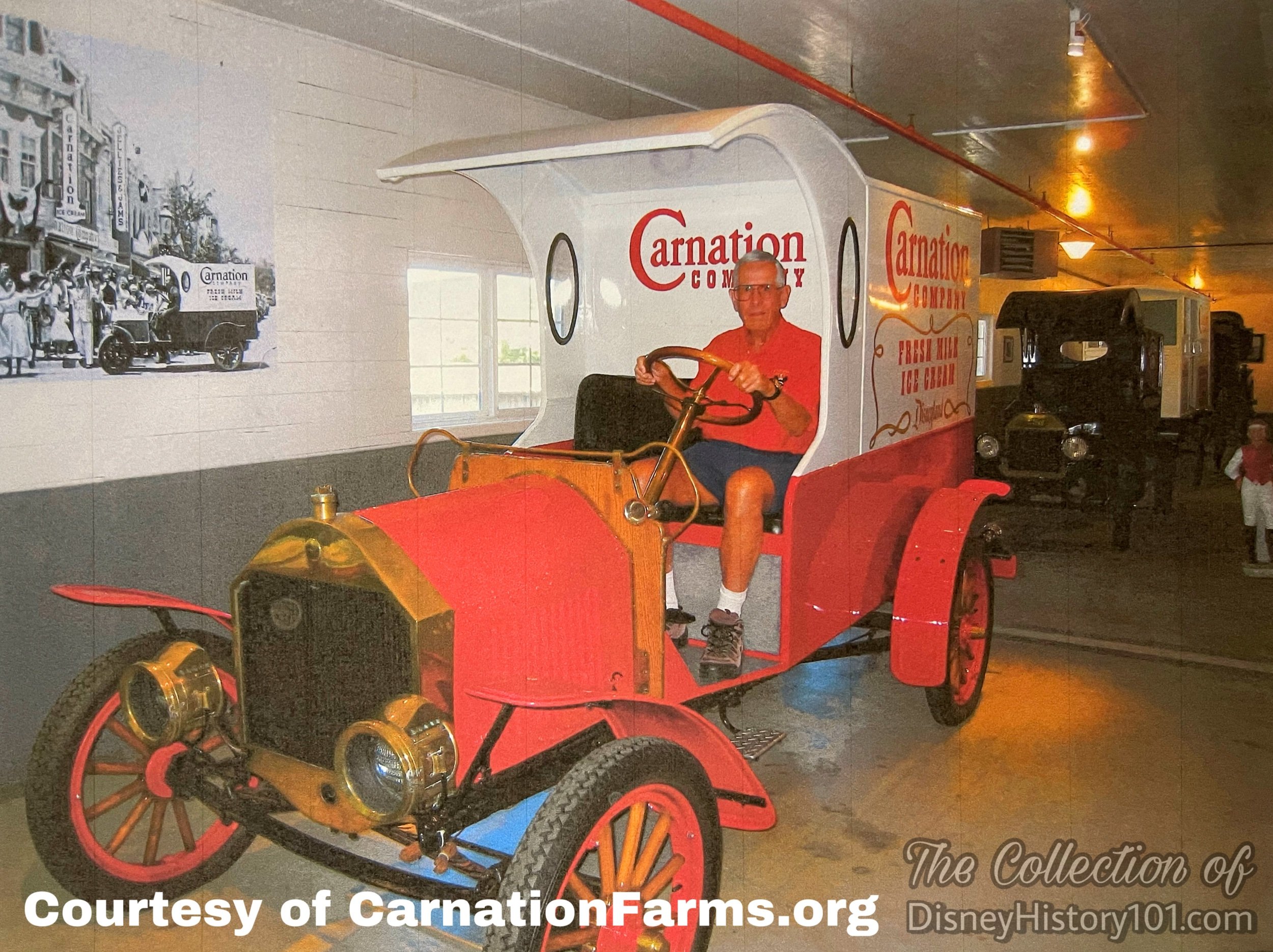
Bob Gurr at the wheel of the Carnation Company Truck Exhibit, Carnation Farms Carriage Museum (2010)
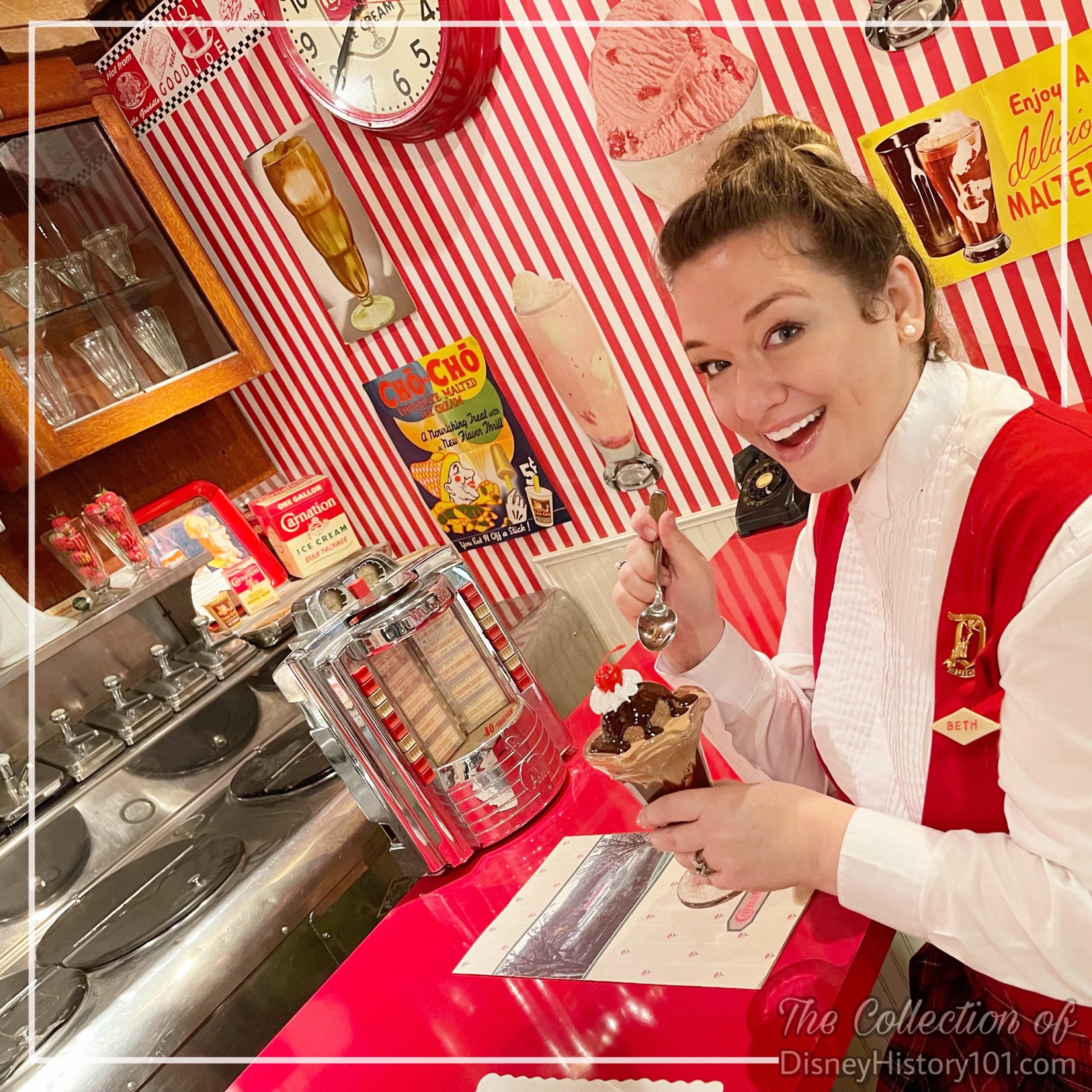
Carnation Farms Museum c.1950s Ice Cream Parlor Diorama
There is so much more to see! Other Carnation Farms Museum exhibits preserve chapters of Elbridge Amos Stuart’s Carnation Farms story through true-life artifacts placed in diorama recreations. If you would like more information about the Carnation Farms Museum, Museum hours of operation, or learn how you can support this wonderful Disneyland-related exhibit, please visit the Carnation Farms Museum official website - CarnationFarms.org!

A Carnation Ice Cream Parlor tip tray by Camtray of Huntington Beach.
The Carnation Cafe would have a legacy through the character elements and menus items of other Ice Cream Parlors at Disney Parks. For instance, when Tokyo Disneyland opened on April 15, 1983, the Ice Cream Parlor would feature desserts like a Sweetheart Sundae and the Victorian Sundae.
By 1991, Carnation sponsored three locations at Disneyland - Carnation Ice Cream Parlor was a table service restaurant that offered Lean beef patties, nutritional sandwiches, soup, salads, beverages, ice cream specialties, in addition to Breakfast. Carnation Plaza Gardens offered lean beef patties, ice cream cones and sundaes. Finally, the Main Street Cone Shop was also hosted by Carnation, offering chocolate, vanilla, and strawberry ice cream, orange sherbet plus the flavor of the day, root beer floats, and other beverages.
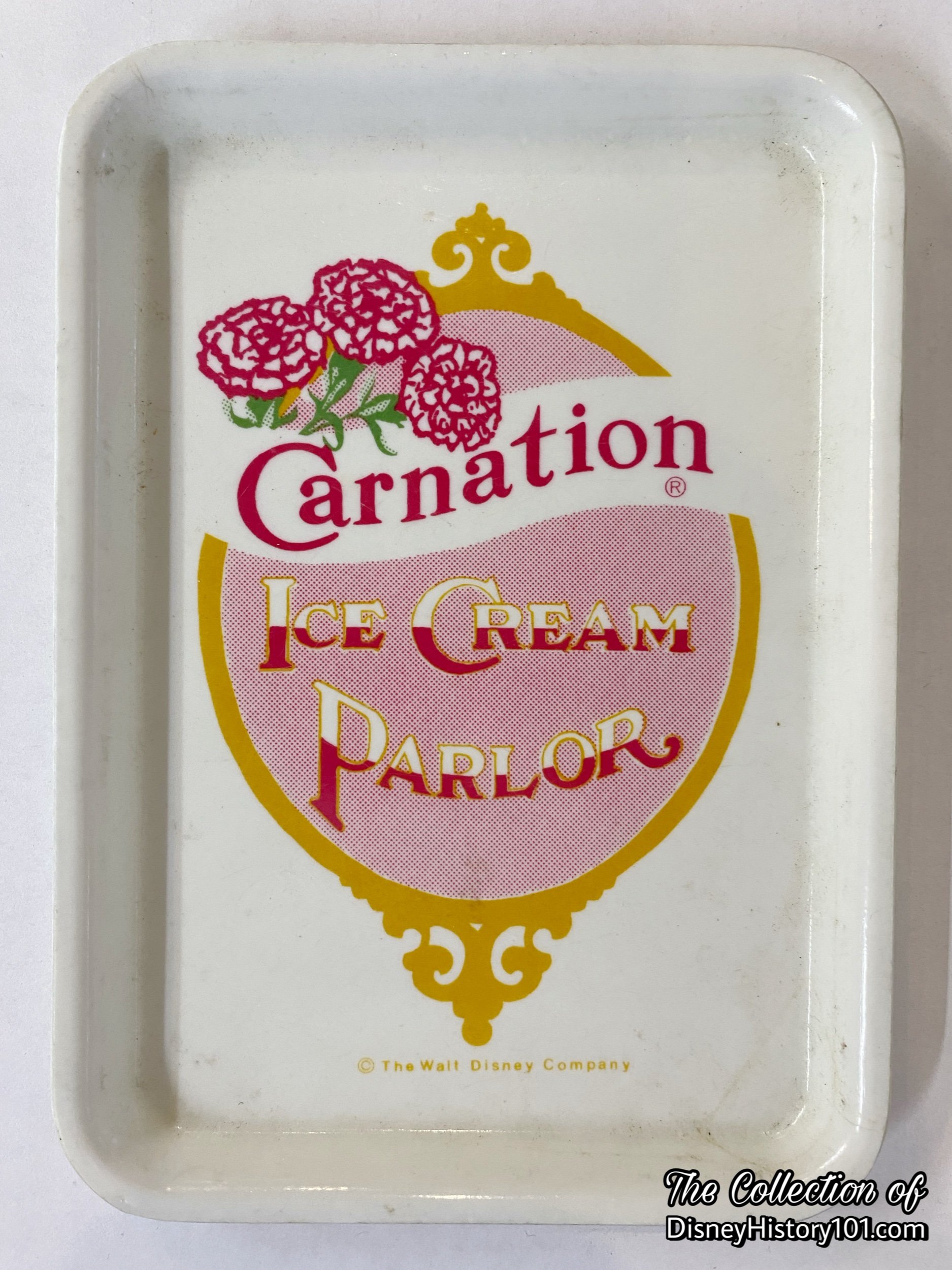
A Carnation Ice Cream Parlor tip tray by Camtray of Huntington Beach.
The Carnation Cafe would have a legacy through the character elements and menus items of other Ice Cream Parlors at Disney Parks. For instance, when Tokyo Disneyland opened on April 15, 1983, the Ice Cream Parlor would feature desserts like a Sweetheart Sundae and the Victorian Sundae.
By 1991, Carnation sponsored three locations at Disneyland - Carnation Ice Cream Parlor was a table service restaurant that offered Lean beef patties, nutritional sandwiches, soup, salads, beverages, ice cream specialties, in addition to Breakfast. Carnation Plaza Gardens offered lean beef patties, ice cream cones and sundaes. Finally, the Main Street Cone Shop was also hosted by Carnation, offering chocolate, vanilla, and strawberry ice cream, orange sherbet plus the flavor of the day, root beer floats, and other beverages.
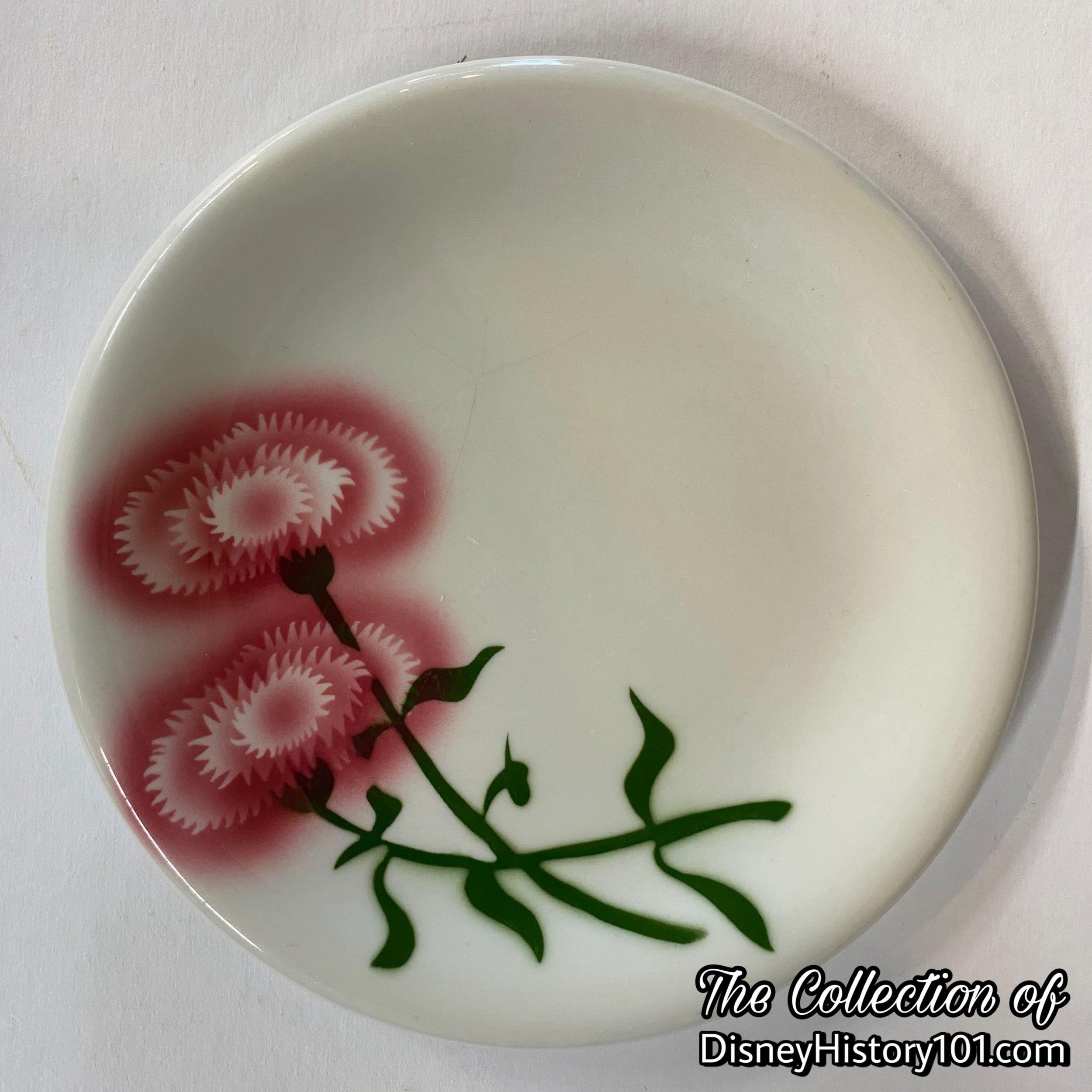

Though the Carnation Ice Cream Parlor closed on January 4, 1997, the name “Carnation” would continue to be affiliated with Disneyland (sort of). The Carnation Cafe (also named after the flower that graces each table) would open on Main Street, March 21, 1997. While the Carnation Company name departed from Disneyland in 1997, a derivative atmosphere and menu inspired in part by those of the previous participant was established in the new Carnation Cafe! Guests could order Mickey-shaped waffles, Sirloin Steak and Eggs, and Classic Eggs Benedict all day long!
During the 2000s, Carnation Cafe was expanded and completely redone, with plenty of seating indoors and on the heated patio. Deep red and biscuit colors, gas lamp-style fixtures, beautifully carved wood details, and framed sepia-toned photos of an early-era Disneyland created a wonderful setting for breakfast, lunch, dinner or dessert treats.
Breakfast options included Apple-Granola Pancakes, Huevos Rancheros, Steel-Cut Oatmeal, Mickey-Shaped Waffles, and more. Lunch & Dinner options included Green Chile Cheeseburgers, Romaine Salad with Shrimp, and more; plus Walt Disney's personal favorites: Homemade Meatloaf, Chicken-Fried Chicken, and the Fresh Catch of the Day. Special Treats included Creamy Milkshakes and Glowing Character Punch.
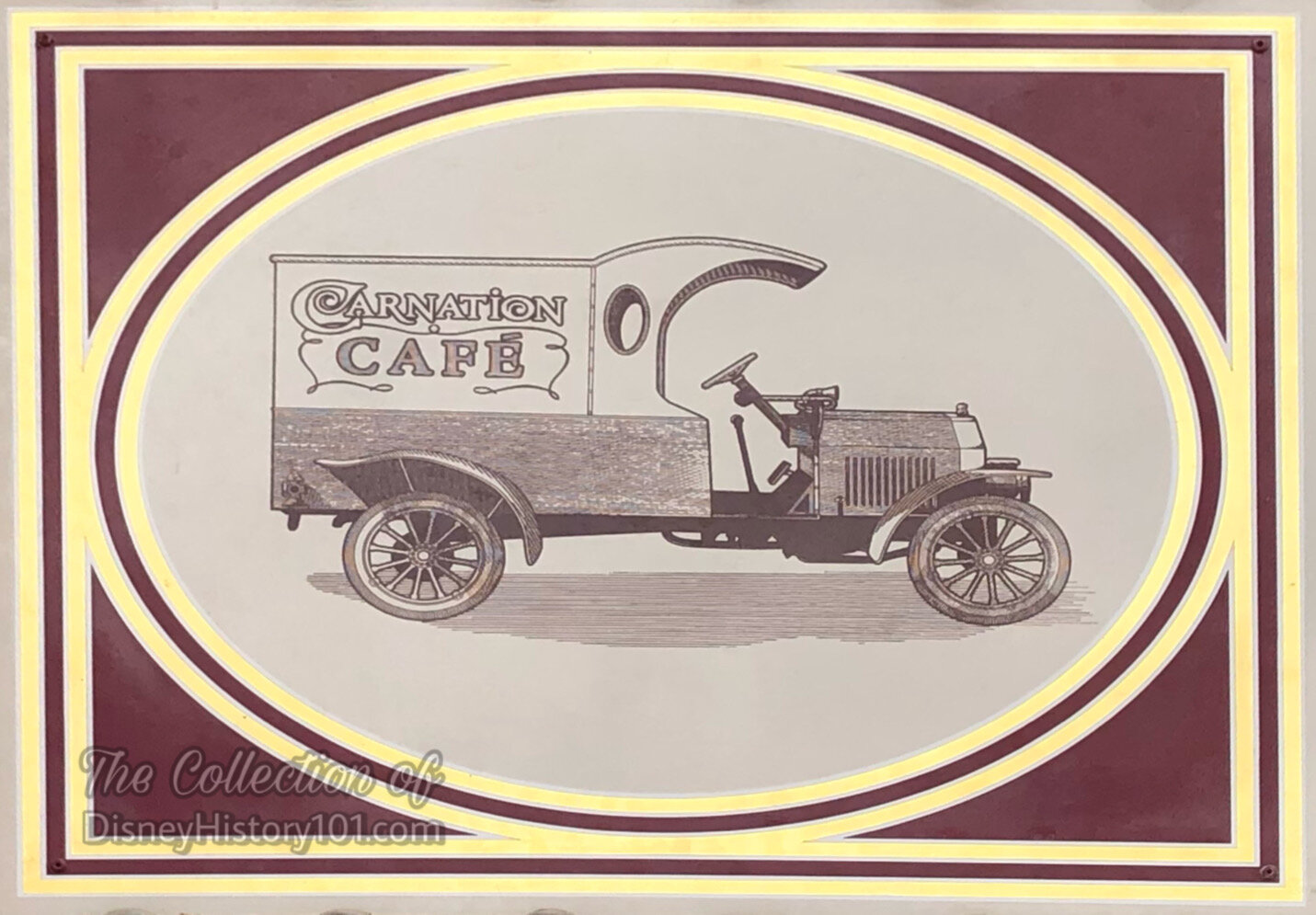
Carnation Cafe Sign Graphic (in the present) pays homage to the old Carnation Truck Exhibit
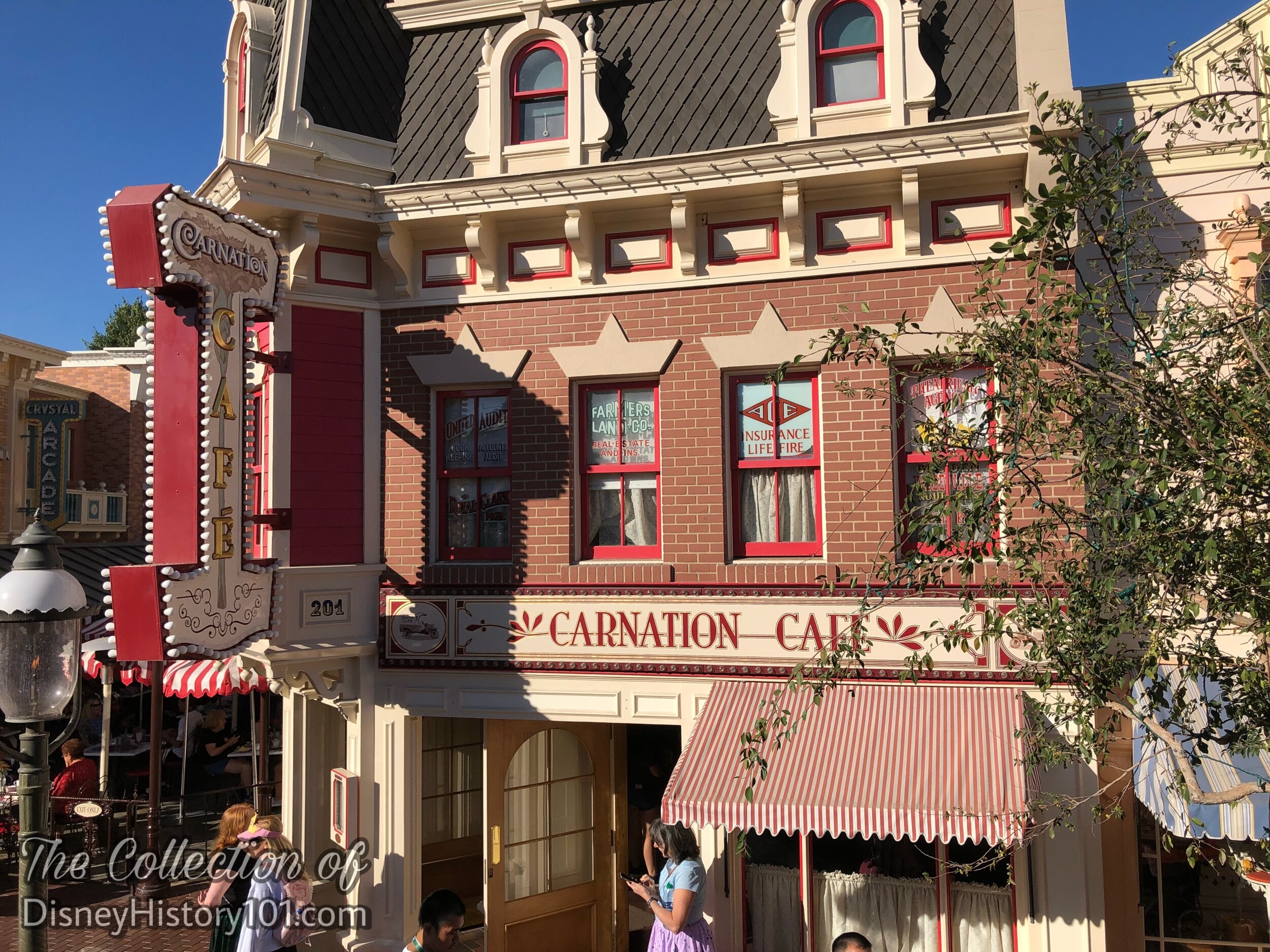
Carnation Cafe Architectural Facade - The Present

Carnation Cafe Architectural Facade - The Present

Carnation Cafe Architectural Facade at twilight in the Present
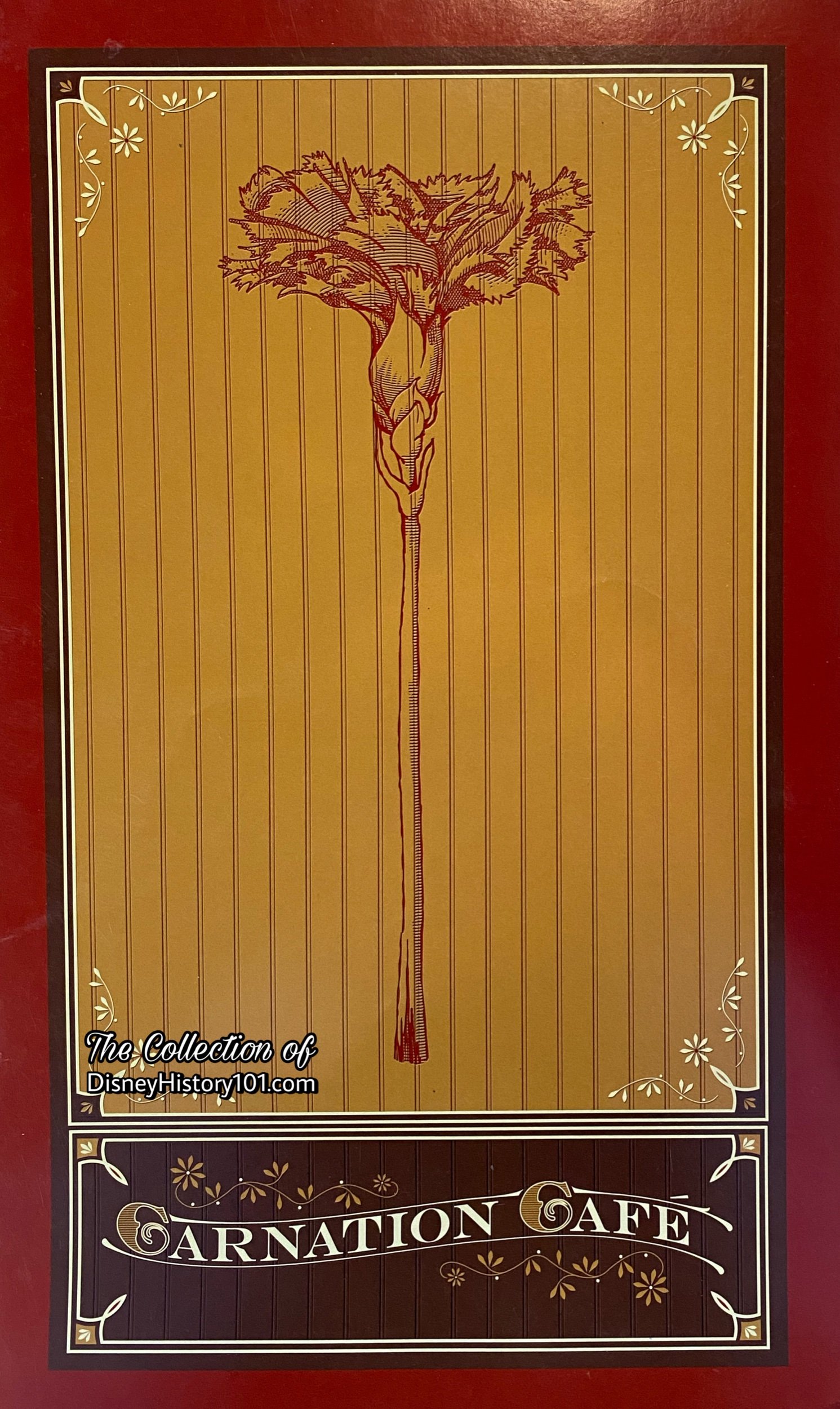
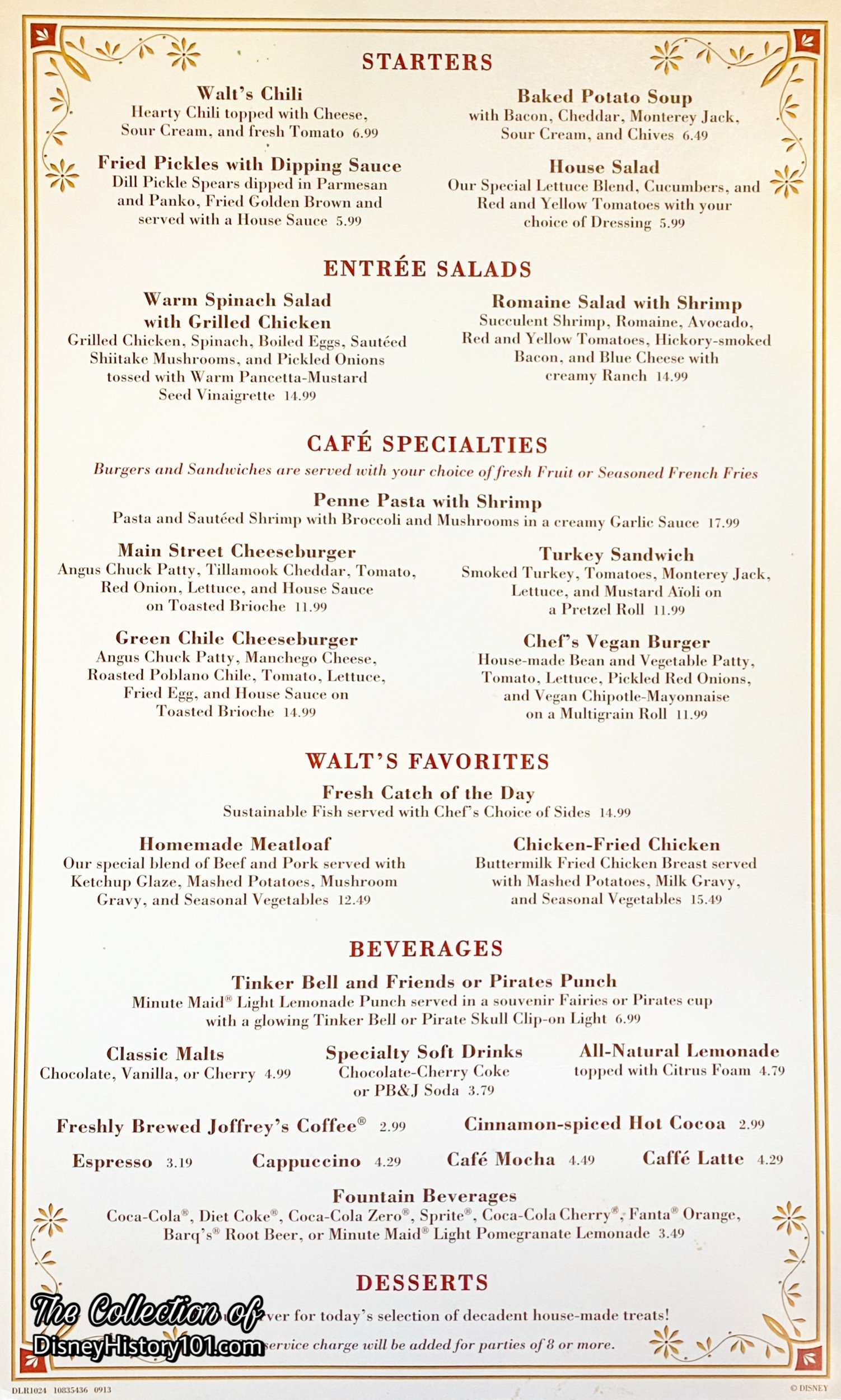
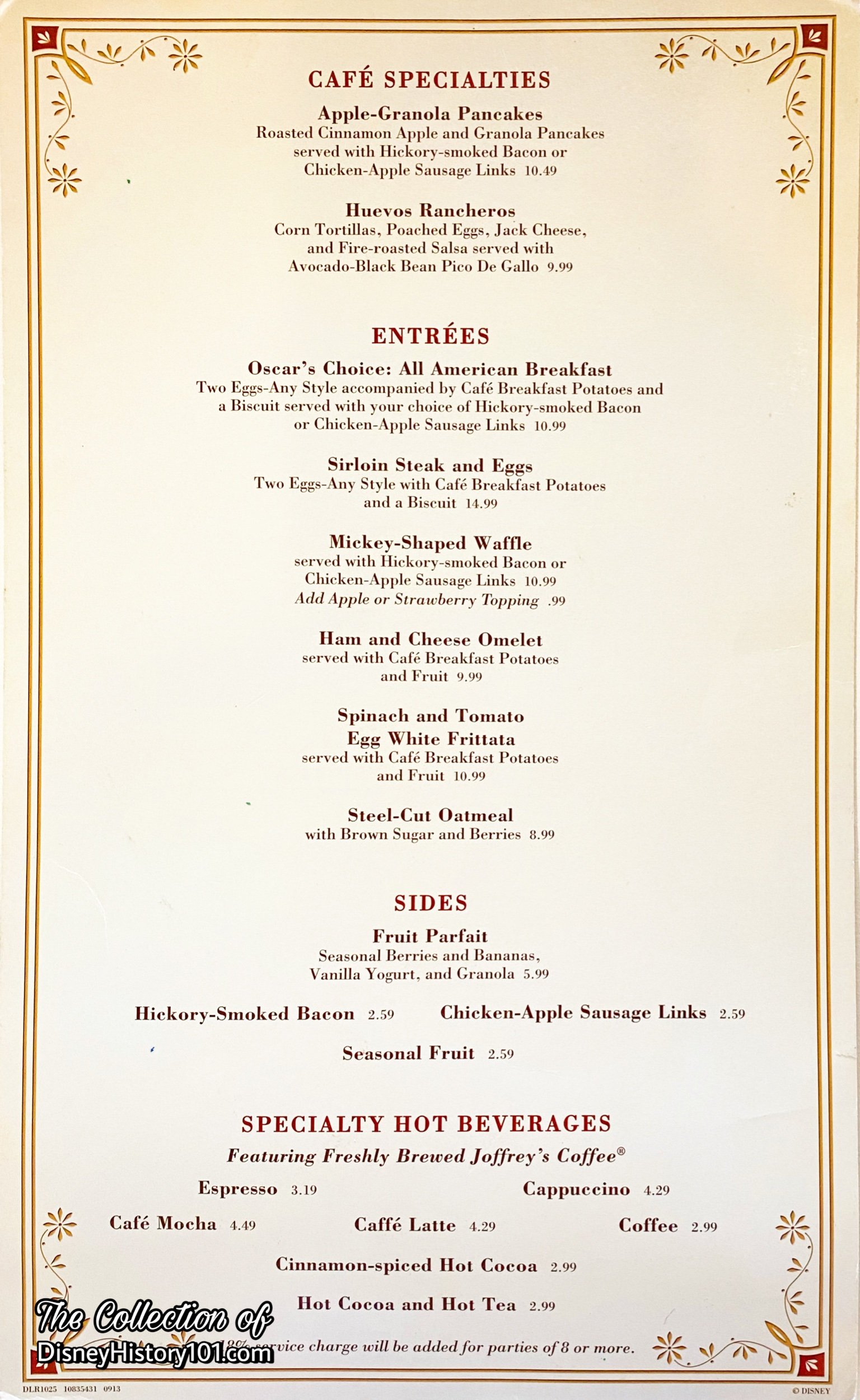
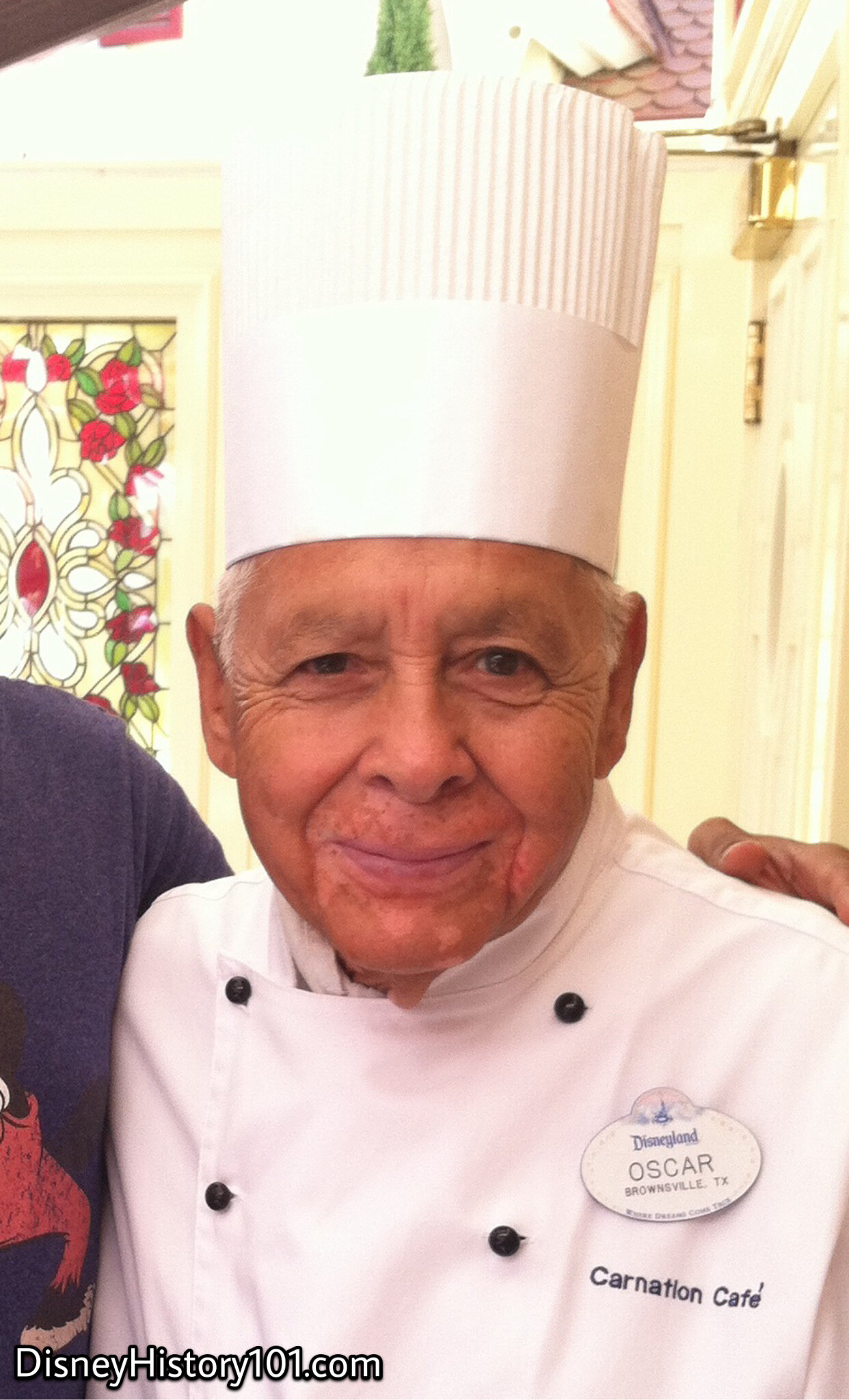
The former Carnation Cafe Chef Oscar Martinez was reknown for extending courtesy, ever ready to display Disney Courtesy with a friendly smile.
Oscar (the namesake chef) of the “Oscar’s Choice : All American Breakfast” (Two eggs any style accompanied by Cafe Breakfast Potatoes served with hickory-smoked bacon or chicken-apple sausage links and your choice of toast)! We’ll be adding Oscar’s story here soon!
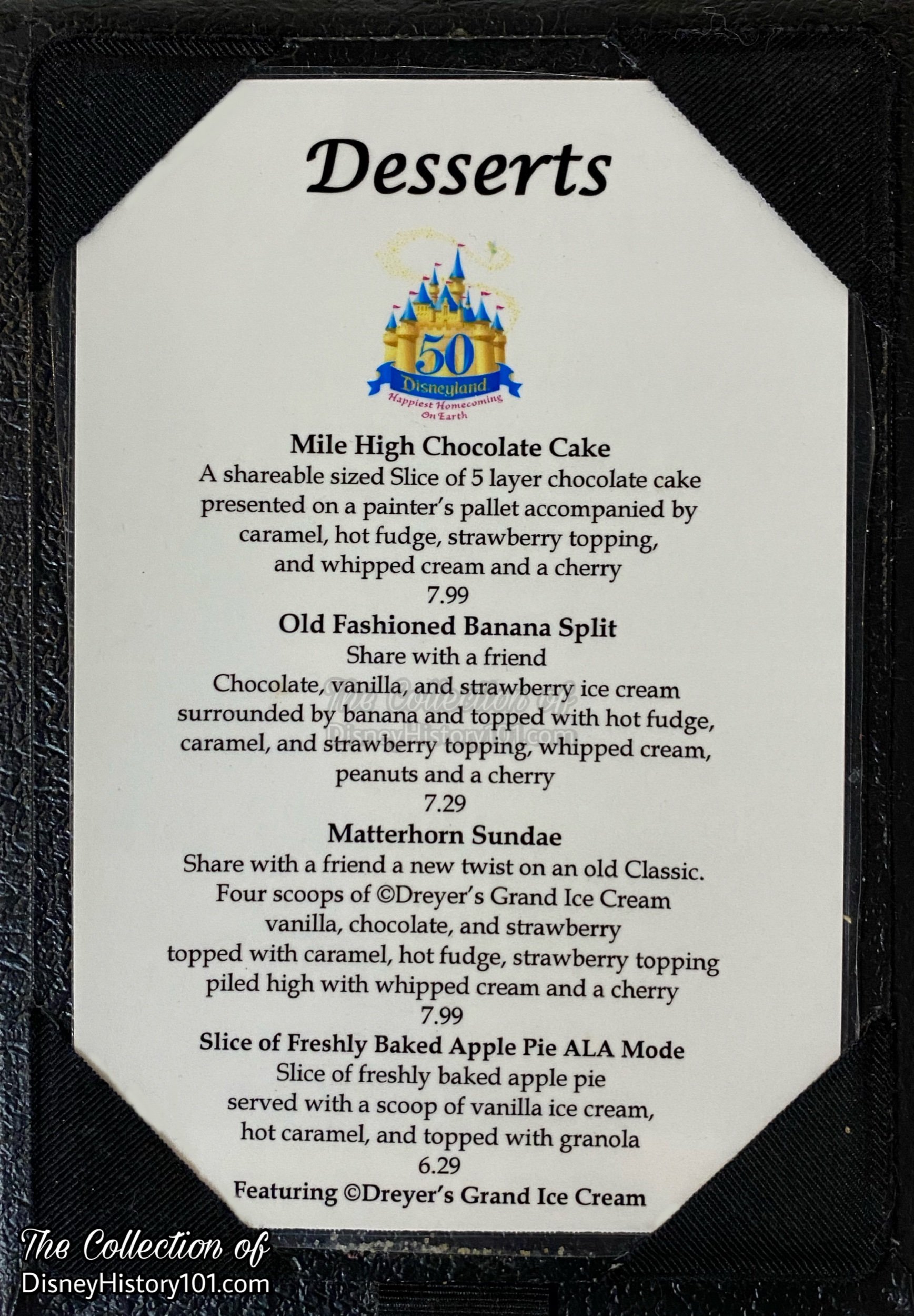
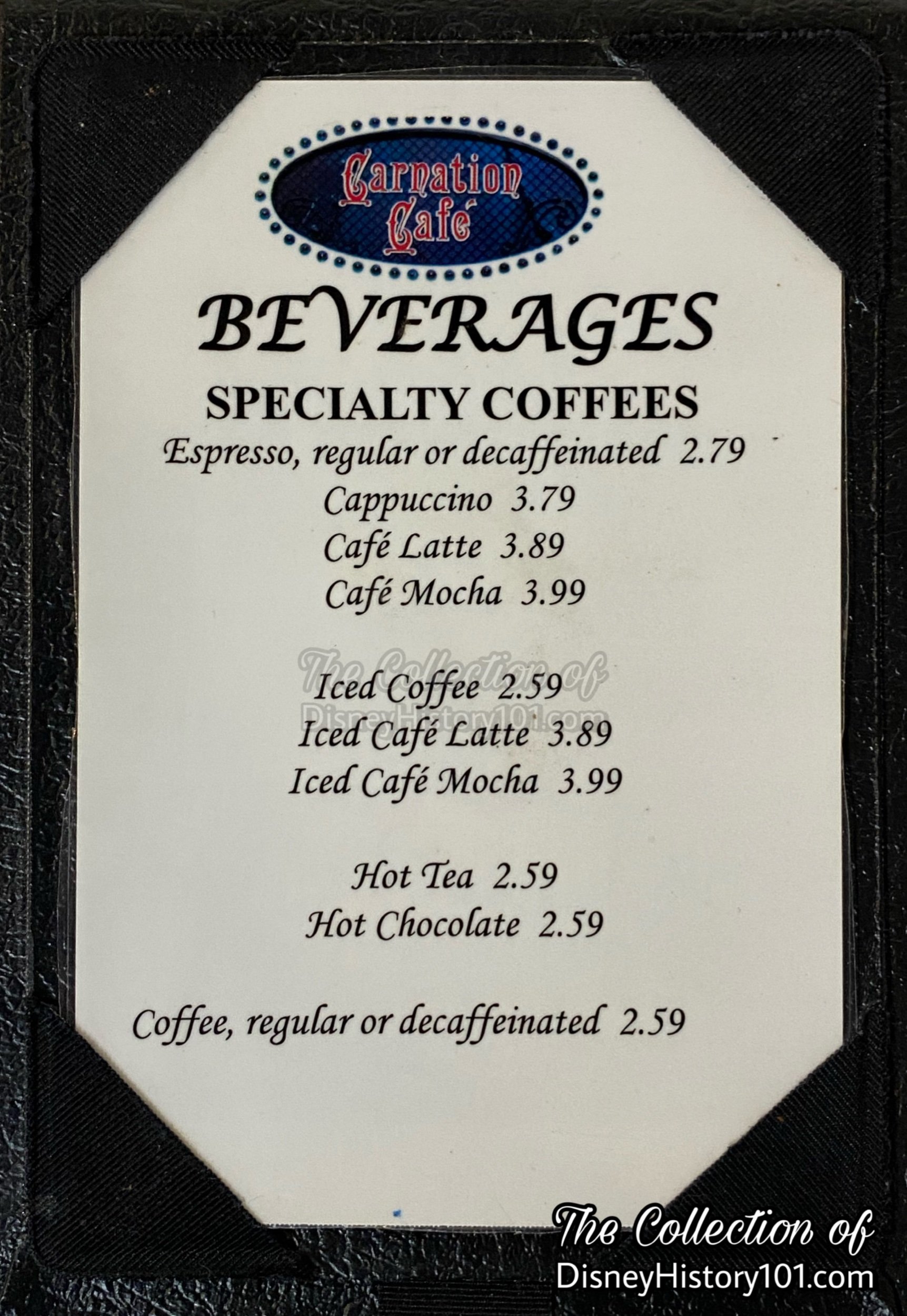
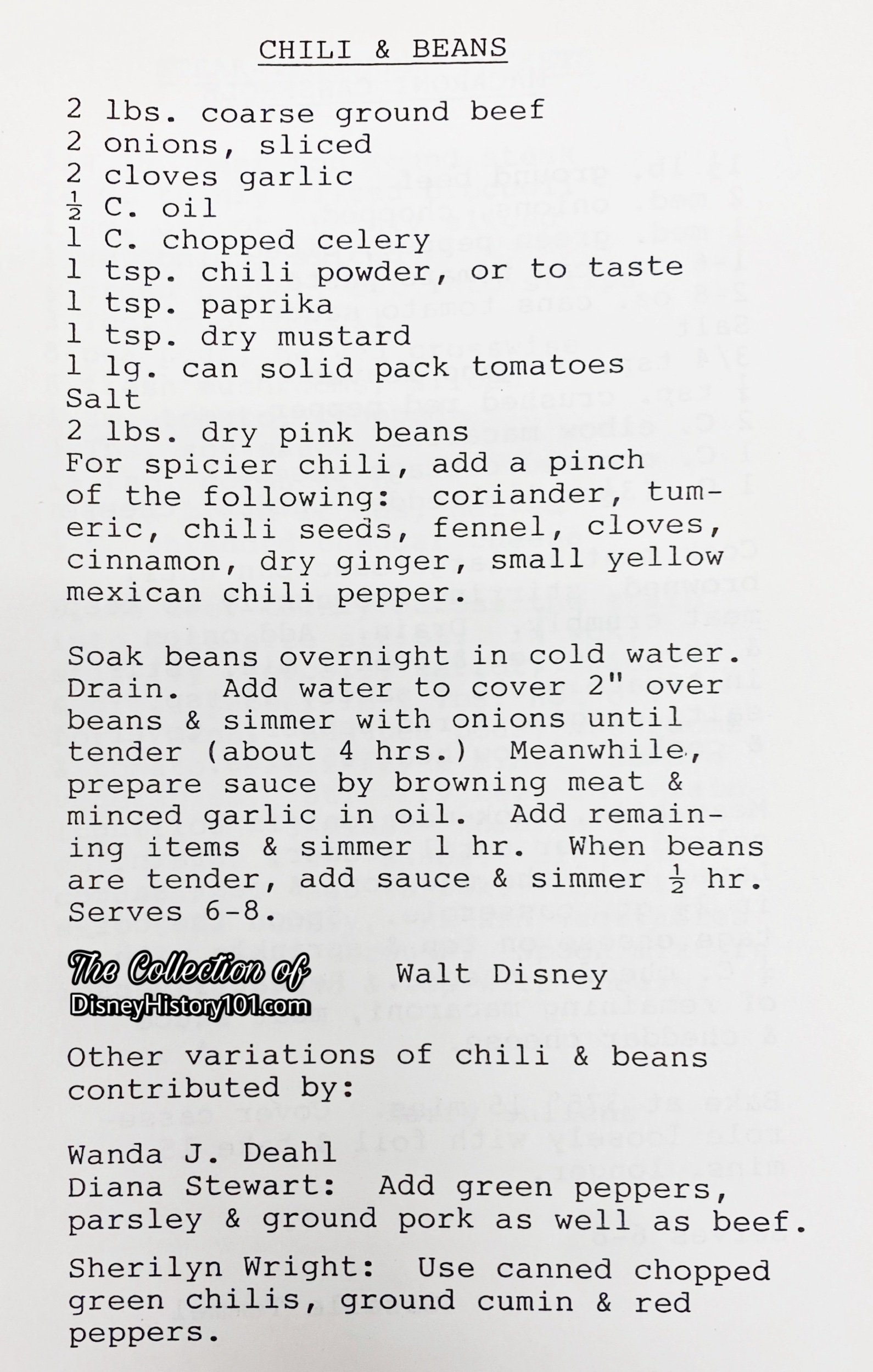
Carnation Café is one of the few places that offers the opportunity to taste Walt’s Chili.
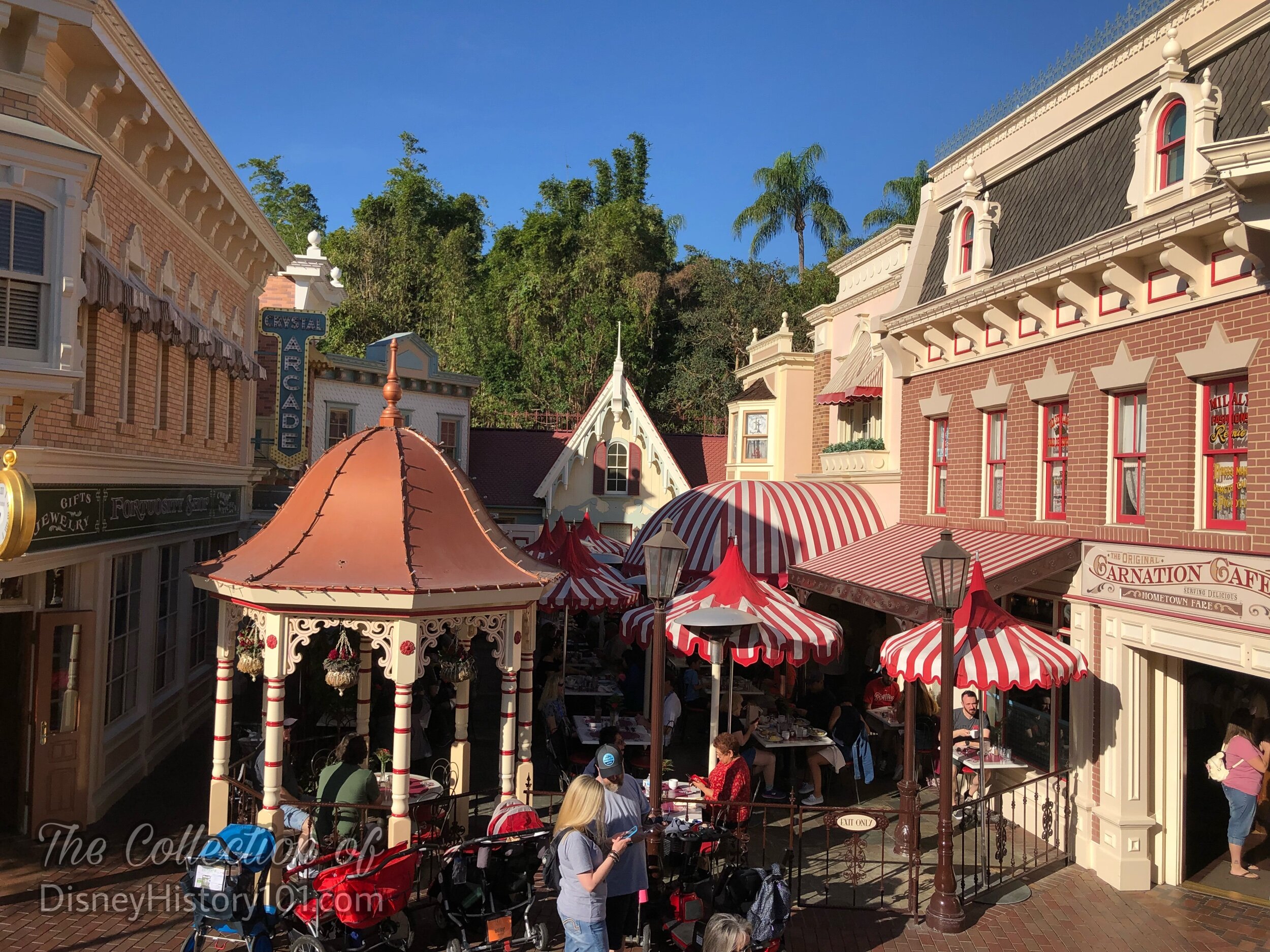
A form of the Outdoor Dining Patio (created during the rehabilitation of 1977) can still be enjoyed today!
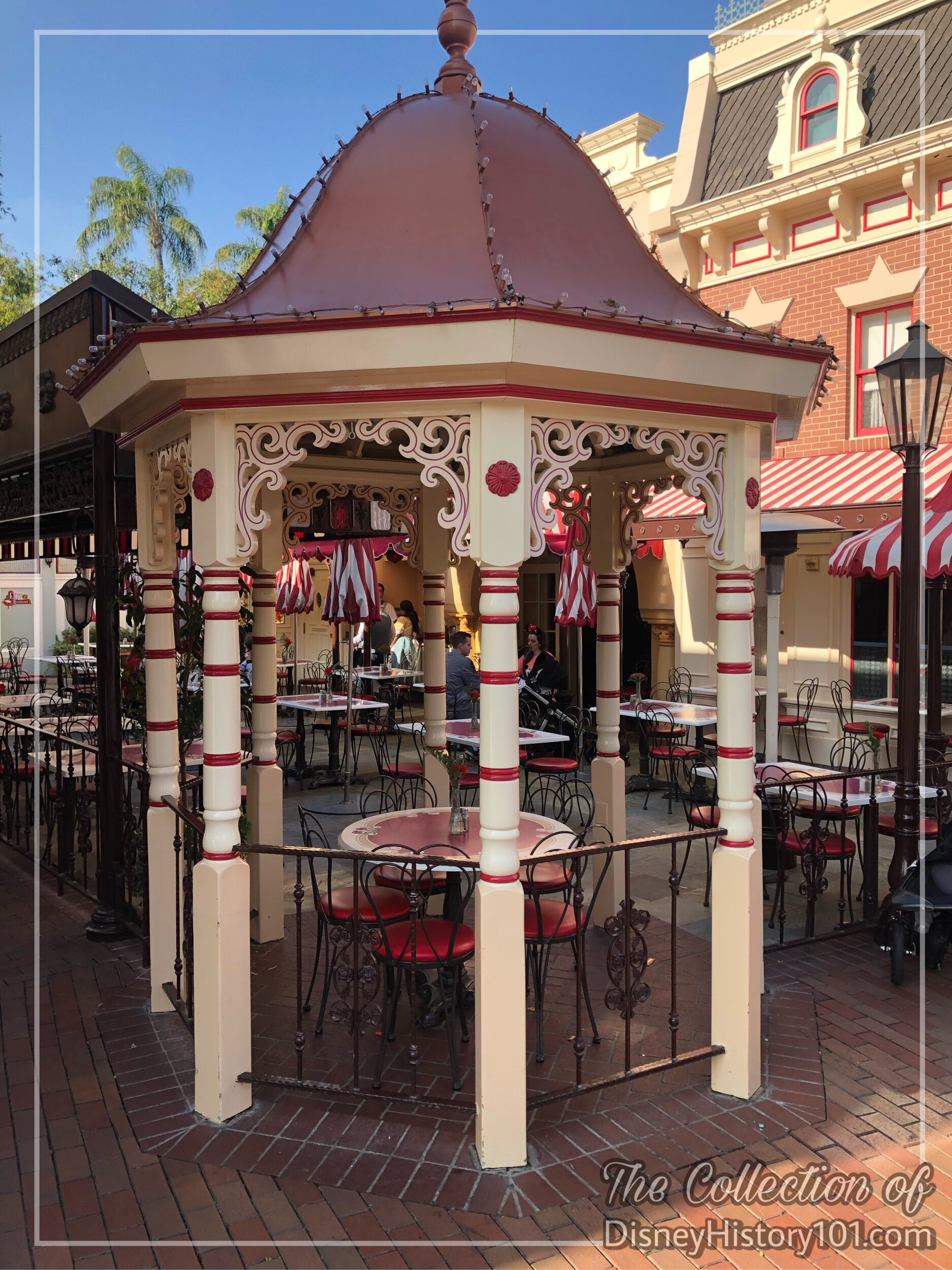
The best seat in the Carnation Cafe Outdoor Dining Patio
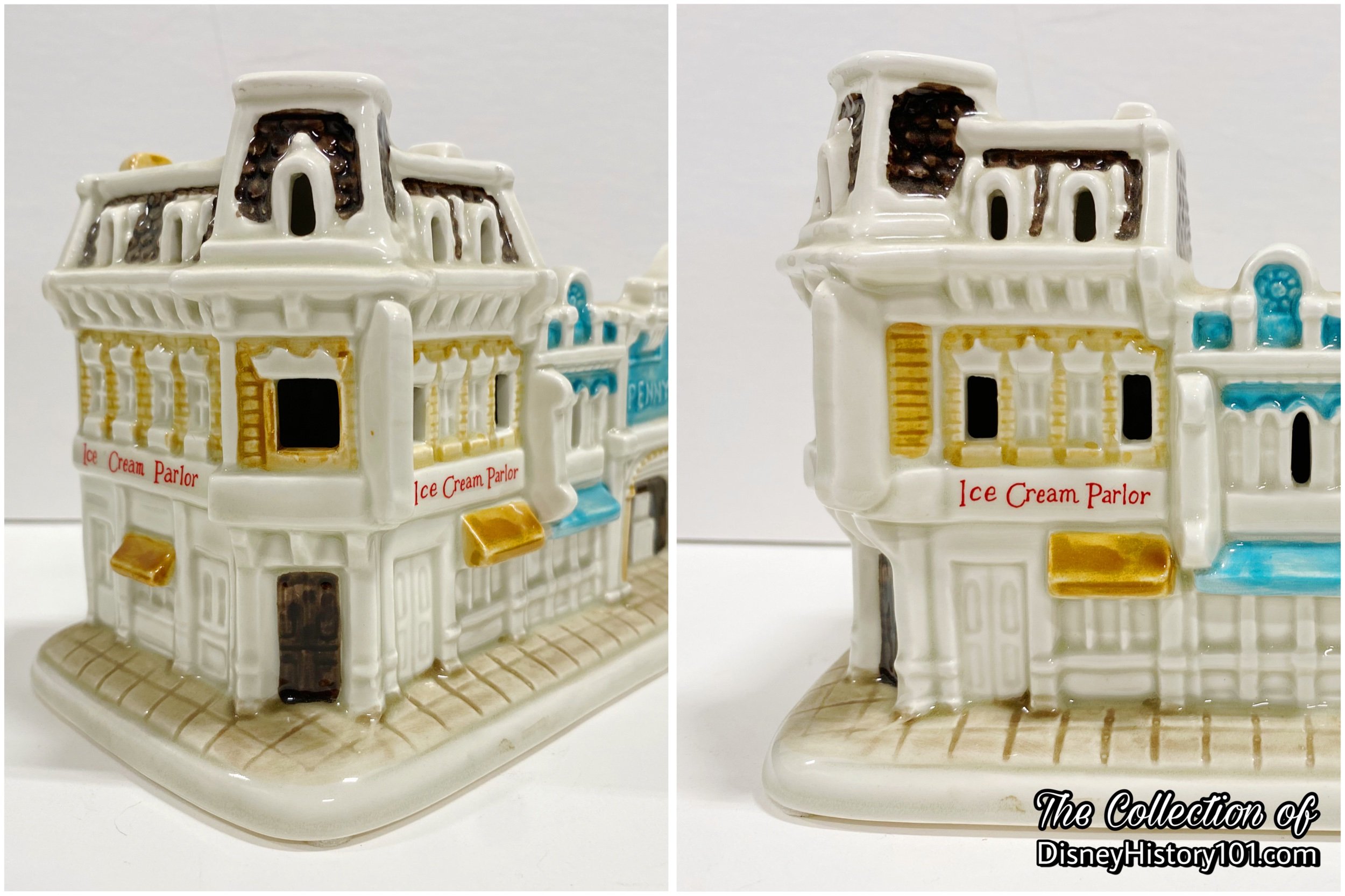
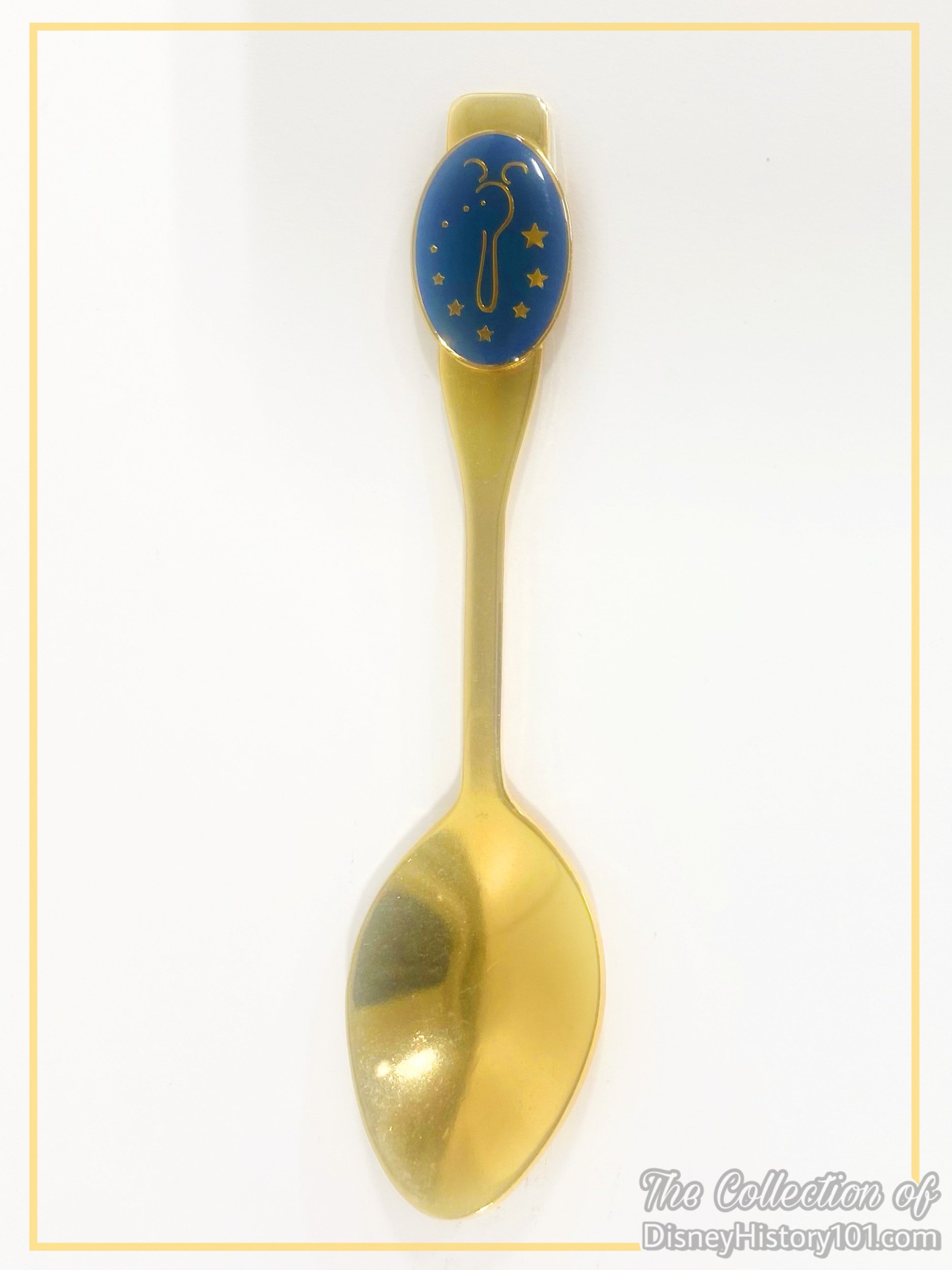
A Disneyland Food Operations Award, c.2000s.
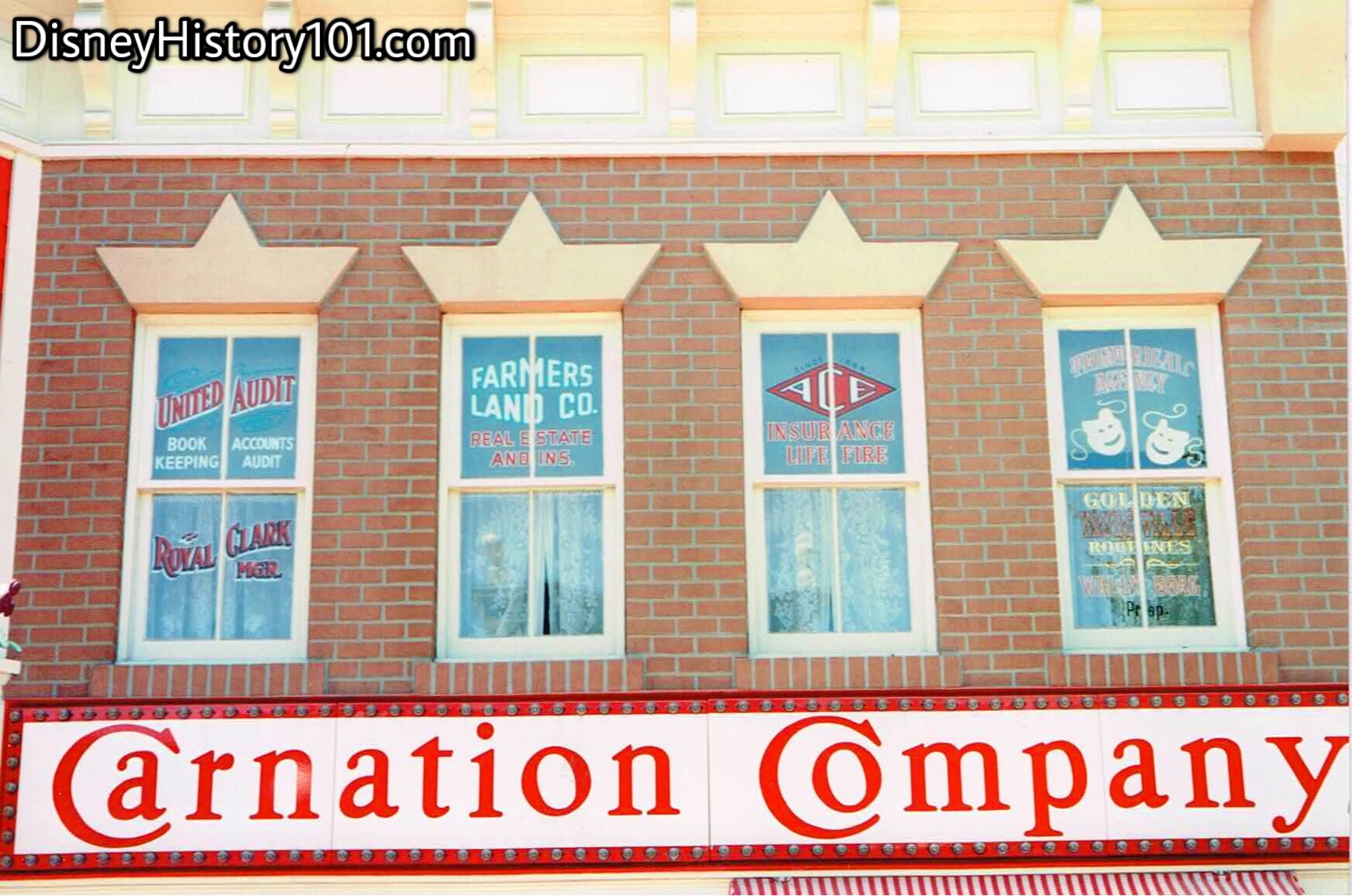
Carnation Company Exhibit Window Honors
“Carnation Company Exhibit Window Honors”
Another highlight about the Carnation Ice Cream Parlor exhibit is the building exterior. Long before Disneylanders of note could only dream of having their likeness commemorated on pressed pennies, Walt began honoring such ones with their names emblazoned in gold leaf paint on Main Street window glass. This tradition has continued to the present.
“We celebrate our people for the memories they created in the past.”
Martin Sklar once said “an individual's contribution can usually be found in the final product if one looks closely enough, but the Disney mind frame is to never point out ‘what I did’ to anyone.” However, a few outstanding individuals have been publicly recognized for their contributions and even ceremoniously honored by the Company.
There are thousands of windows at Disneyland. Here, is exhibited perhaps one of the most important window honors in all of Disneyland (in my personal opinion), that of Royal “Mickey” Clark (whose window can be seen to the left, in the previous Vintage View). Royal Clark was named WED Enterprises, Inc. Treasurer by Walt Disney before later becoming RETLAW Enterprises’ Treasurer, and was most essential to the funding of Walt’s various ongoing projects.
In addition to the window honors, there is another “sidelight” related to the Carnation Ice Cream Parlor Building. The roof of the Carnation Company Building was often utilized to station cameras during parades and other special events held on the Main Street Stage.
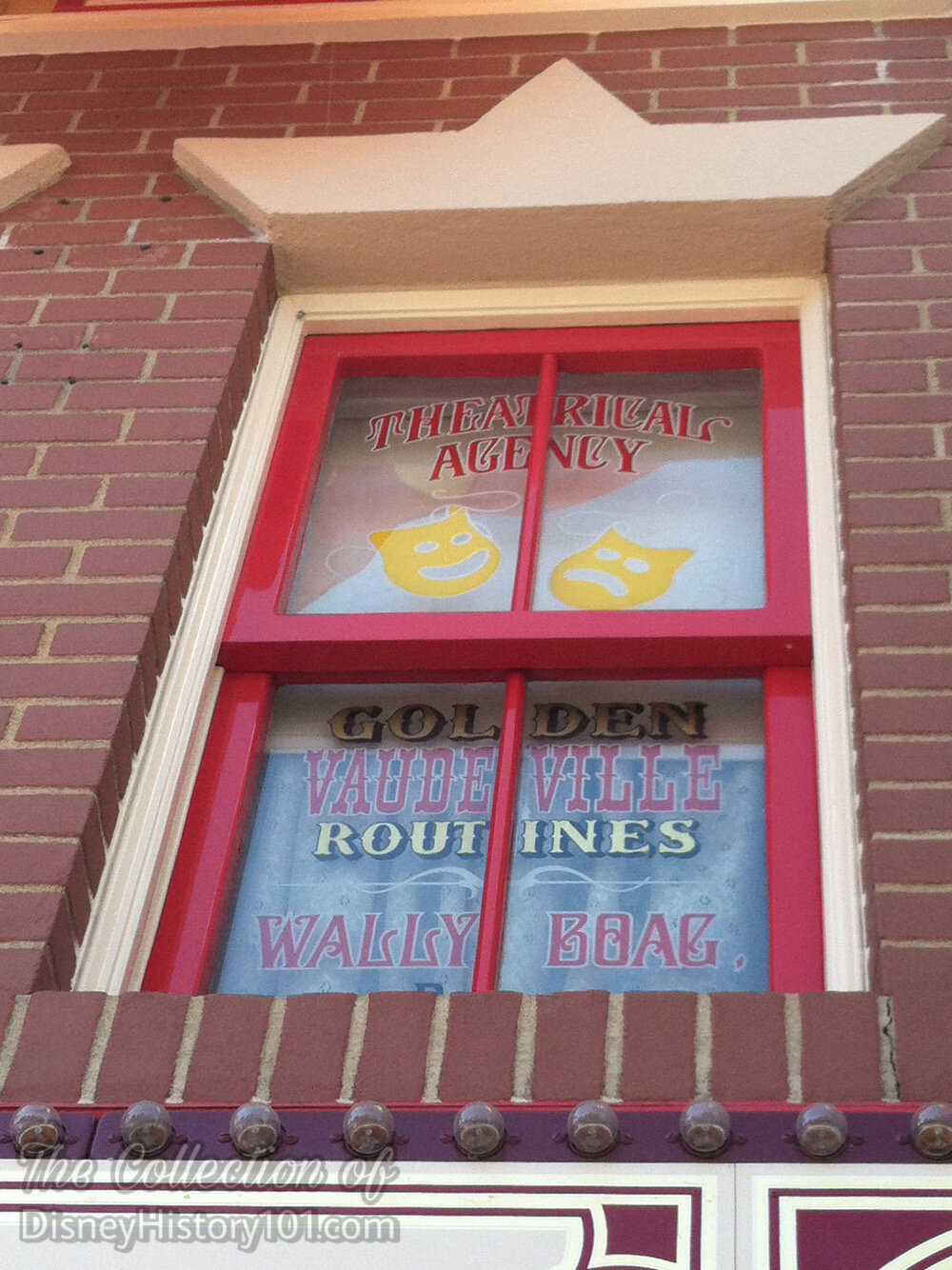
Carnation Company Exhibit Window Honors
“Wally Boag, on elf the former stars of THE GOLDEN HORSESHOE REVUE (the longest-running stage show in the world with over 50,000 performances) is honored with a window: ‘Theatrical Agency. Golden Vaudeville Routines. Wally Boag, Prop.’,” according to “Disneyland - A Treasure Chest of Trivia,” prepared by Walt Disney Productions, 1990.
Speaking of “Golden Vaudeville Routines,” the Carnation Company saw its share of performances, with the Dapper Dans (and the occasional seasonal wandering caroler group) performing from the foyer.

